Regd. No: 175840/074/075, Tourism License No: 2432


Promoted and run by:
Local experts and sherpas of nepal.

- blog article
Mt Everest Base Camp Trek with Hiking Distance
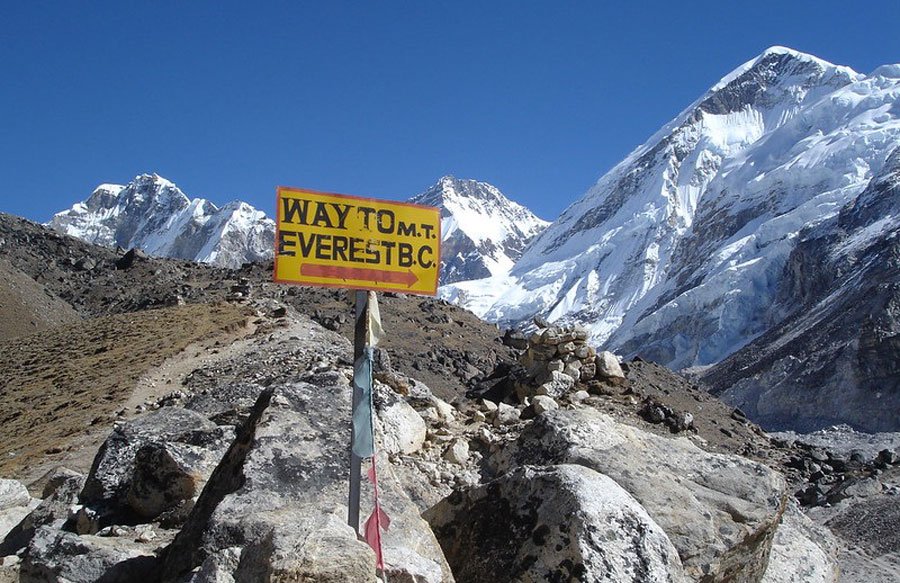
- Trip Overview
Everest base camp trek is the hiking trip to the base of the world’s highest mountain ‘Mount Everest’. Mount Everest is so massive that the local people call it Sagarmatha, meaning Mother of the Universe. Kalapathar at an altitude of 5643 meters is near Everest Base Camp and is the best viewpoint for a 360-degree panoramic view of Mt. Everest, Mt. Lhotse, Mt. Cho Oyu, and other peaks.
Everest Base Camp Trek certainly provides every hiker with the best trekking experience of his/ her lifetime. The major highlight of this epic trek is the magnificent views of the world’s highest peaks including Mt. Everest, Lhotse, Cho-Oyu, Nuptse, Pumori, Amadablam, Island Peak, Thamserku, and mighty of peaks.

Everest Base Camp Trek begins with a scenic flight to Lukla from Kathmandu, the capital city of Nepal. Lukla is the starting point and also the gateway of EBC Trek. From Lukla, you trek to Phakding and continue ahead to reach Namche Bazaar. You will rest at the Namche Bazaar, which is the trade center in the Everest region.
From Namche, the trail goes through beautiful forests of pines and rhododendrons to take you to Tengboche. At Tengboche, the Tengboche Monastery, the largest Buddhist monastery in the Khumbu region, which is located on the lap of Mt. Ama Dablam is another important alluring site. The monastery reflects Tibetan Buddhist art and artifacts.
You will then trek towards Everest Base Camp and ascend to the famous Kala Pathar from where you get panoramic views of Mt. Everest (8,848 m) and other surrounding peaks. It’s a good hike to Kala Pathar to test your endurance level. When you reach the top of Kala Patthar, you will find yourself in the most spectacular place ever imaginable. You will be standing in between the almighty mountains that rise above eight thousand meters and will be celebrating their splendor. The awe-inspiring views of the beautiful mountains swaddled in the glittering white snow take you to a place beyond your imagination.
After climbing Kalapathar, you retrace your journey towards Lukla staying a night at Pheriche and Namche Bazaar. Then with the flight you back to Kathmandu.
The major highlights of the Everest Base Camp Trek are as below:
• Scenic flight to Lukla (Tenzing Hillary Airport) • Explore Namche Bazaar, the trade center of the Everest region and also the gateway to Everest Base Camp • Visit Tengboche Monastery, the largest in the Khumbu region • Trek through Sagarmatha National Park, a UNESCO World Heritage Site • Hike Kala Pathar to enjoy the 360-degree panoramic view of Mount Everest and the nearby snowcapped peaks from Kala Patthar • Visit Everest Base Camp, the foothill of Mount Everest • Pass-through Sherpa villages on the route • Experience Sherpa culture, tradition, and lifestyle
Itinerary of Everest Base Camp Trek with Distance
EVEREST BASE CAMP TREK OFFER PRICE: Excellent Himalaya Trek and Expedition offering Everest Base Camp Trek at USD 1195 for the Silver Package and USD 1275 for the Gold Package . This offer will be valid if you book the trip by the end of Dec 2023. Please email [email protected] or WhatsApp at +977 9851203181 for booking and further information.
Updated News please read: From 1st Oct 2022, according to the instruction of Civil Aviation of Nepal, the Lukla Flights are departing from and to Ramechhap Airport instead of Kathmandu due to ongoing upgrades at Kathmandu Airport & also heavy air traffic. It’s around a 4-hour drive to Ramechhap from Kathmandu. So, to catch the Lukla flight, you need to wake up very early morning and at 1:30 am should take a drive from Kathmandu to Ramechhap Airport. In the same way from Ramechhap Airport to Kathmandu by drive-in sharing. The return drive at the end of the trek is around 6 hours depending on traffic.
Note: The distance may be different according to the various navigation devices. The walking hours mentioned above may also be different according to the pace of trekkers.
When to go for Everest Base Camp Trek?
Everest Base Camp Trek is possible any time and month of the year. The below months have traditionally been used as a guide for preferred times of the year to visit Everest Base Camp.
October-November-till mid-December: This is Nepal’s peak and best time to go trekking. March-April-May: This is the end of the dry season and is also the best time to go trekking. After mid of mid-December to February: The skies are clear but it can get very cold. June-July-August: This is monsoon season and the least popular time to go trekking in Nepal. September: The post-monsoon effect may disturb the views of the Himalayas and Lukla flights.
How much price of Everest Base Camp Trek?
Are you in search of a recommended operator for the everest base camp trek.
Many companies promote the Everest Base Camp Trek package. Excellent Himalaya Trek and Expedition is different from others in the sense that it is based in Nepal and managed by Nepalese tourism experts, local experienced guides, and sherpas. This company is the direct operator of Everest Base Camp Trek, not the middle travel agency . This company is also recommended in Trip Advisor. If you are planning to Everest Base Camp Trek, for any information about this trek, you can freely contact this company by email at [email protected] or WhatsApp at +977 9851203181.
What things are required to pack for Everest Base Camp Trek?
This is a basic checklist of the essential items that you should not forget to bring with you during your Everest Base Camp Trek:
• A sturdy pair of trekking boots with good ankle support • Rucksack or daypack (50 to 65 liters) with waterproof cover • Trekking pants and waterproof trousers • T-shirts or shirts • Down jacket* • Wind/ waterproof light jacket • Fleece jumper or jacket • Inner Thermal (top and trousers) • 4 to 6 pairs of Socks and underwear • Sunglasses, sun hat, woolen cap, or balaclava • Inner and outer gloves • Headlamp, power bank, and extra batteries • Sun protection cream, lip balm, wet wipes, and hand sanitizer • Towel, flip-flop or rubber sandal, toiletries • One-litre water bottle and water purification tablets • 4 Season sleeping bag (good to -20 degrees C or 28 degrees F); * • Hiking poles, if you need • Your daily medicine if any, small personal first aid kit, aspirin, plasters (band-aids), anti-diarrhea pills, anti-headache pills, cough or cold medicine, anti-altitude sickness pills (Diamox or Acetazolamide), etc. • A small daypack/backpack for carrying your valuables
*Down jacket and sleeping bag you can rent/hire from Trekking gear shops in Kathmandu.
The above list is essential for your trekking. The weight limit for your luggage is 15 kg or 33 pounds. Remember that your luggage will be carried by a porter if you choose a package that includes a porter. Even if you have a porter you are required to carry a small day-pack with your valuables or anything important. We advise you to pack only what is necessary.
Why acclimatization days are in the above itinerary?
Acclimatization is really important if you are doing long and high-altitude treks like Everest Base Camp Trek. Each day you will take yourself up to a high altitude thus it is really important to maintain your body’s oxygen level by acclimatizing yourself before gaining high on the next day. Lack of Acclimatization may cause mountain sickness. Thus, in the above itinerary, 2 days are for acclimatization purposes. One day in Namche Bazaar and the next acclimatization day in Dingboche.
How does altitude variation in Everest Base Camp Trek?
EBC Trek starts from the elevation of 2804 meters/ 9199 feet at Lukla. Every day you will receive elevation in the range of 400 meters to 800 meters. As most people’s bodies are not used to these elevations, the trek includes acclimatization days at Namche Bazaar and Dingboche to ensure your safety. The highest altitude of the entire EBC trekking is Kala Patthar, near Everest Base Camp. Its height is 5555 meters/18225 feet. Kala Patthar is the best viewpoint for Mount Everest and its surrounding magnificent peaks.
Why do people choose Excellent Himalaya Trek for Everest Base Camp Trek?
Excellent Himalaya Trek and Expedition Pvt. Ltd. is a leading organizer and also one of the best Everest Base Camp Trek companies in terms of reviews of many trekkers, services, and success rates. This company is run by local tourism experts and Sherpas who have more than eighteen years of experience. Further, we are also authorized by the Tourism Ministry of the Nepal Government, for organizing Everest Base Camp Trek for all people from around the world.
Our salient features are as below by which all the people trust us as the best operator of Everest Base Camp Trek:
Run by Local Experts: As a local travel operator, we know well about the route of Everest Base Camp Trek and its surroundings. We know the best way of trekking to Everest Base Camp here and get you the same way.
Trustworthy: We are a trustworthy Trekking Company for Everest Base Camp in the sense that we are operating all Everest Base Camp Trek based on reality, integrity, and honesty.
Focus on your needs: We highly value all trekkers and are responsive to their needs and preferences. Our Everest Base Camp Trekking packages are customizable according to their interest and plan.
Good Value for money: We provide the value of what you are buying of our services at least equal to the amount you are paying. Our price is always competitive and does not have any middle or hidden fees.
Real Cared Services: Our one travel consultant or our local trekking guide keeps in touch with our clients every time. We make sure their protection is guaranteed so that they will have peace of mind while trekking to Everest Base Camp with us
Ask our experts (Inquiry)
Select Trip Special Puja at Pashupatinath, Abhishek, Cost and Time Annapurna Base Camp Trek with visit to Hot Water Spring Rafting in Pokhara Bisket Jatra in Thimi Motor Bike Tour in Nepal Kathmandu to Manaslu Trek Canyoning in Pokhara Manang Tilicho Lake Trek Kathmandu to Langtang Trek Trek to Kala Patthar Nagarkot Tour from Kathmandu Thorong la Pass Trek: Affordable Cost with Best Services Lukla to Tengboche Trek: Tengboche Monastery Trek Ghandruk Poon Hill Trek Namche Bazaar Trek (Short Everest Trek) Sikles Kapuche Lake Trek Lwang Village Homestay Tour Panchase Trek 2 Days Astam Village Trek Tour Chitwan Sauraha Tour Package Mardi Himal Trek for Nepali and Indian People Australian Camp Trek Nepal Poon Hill Trek Package Besisahar to Jomsom Trek Pokhara to Jomsom Trek Khopra Danda Trek: Cheap Cost with Perfect Itinerary Mohare Danda Trek: Community Lodge Trek in Nepal Pikey Peak Trek: Affordable Cost and Package Pikey Peak Trek Nepal: Itinerary and Price 7 Days Annapurna Base Camp Trek Tamang Heritage Langtang Trek Cost: Cheap Package Price Langtang Tour Package: Hiking Trip Everest Base Camp Trek Booking 12 Days Short Everest Base Camp Trek Kushma Bungee Jump and Swing in Nepal Kathmandu to Ghandruk Tour Package Poon Hill Trek Route, Distance, Itinerary Annapurna Base Camp Trek Distance Tilicho Lake Annapurna Circuit Trek Itinerary with Length Everest Base Camp Gokyo Lake Trek Combine Tilicho Lake Annapurna Circuit Trek Everest Base Camp Trek Nepal Companies Poon Hill Trek Cost Mount Everest for Beginners Annapurna Circuit Trek inclusive Tilicho Lake Everest High Passes Trek Cost Mt Everest Base Camp Trek with Hiking Distance Everest Base Camp Trek Kathmandu Manaslu Tea House Trek Annapurna Circuit Trek Package Manaslu Nar Phu Valley Trek Tsum Valley Manaslu Trek Three Passes Trek Distance Gokyo Lake Trek Distance Mera Peak Climbing Itinerary and Cost Guide Cost for Everest Base Camp Trek Mardi Himal Trek Distance Langtang Trek Distance in Km and Miles How Long Annapurna Circuit Trek Distance in Km and miles Difference between Annapurna Circuit and Annapurna Base Camp Trek Annapurna Base Camp Mardi Himal Trek Mardi Himal vs Annapurna Base Camp Trek Best Company for Mera Peak Climbing Upper Mustang Jeep Tour Package Upper Mustang Trek Package Best Company for Upper Mustang Trek Best Tour Company for Everest Base Camp Trek Nepal Everest Base Camp Trek How Long? Nepal Trek to Everest Base Camp 4 Nights 5 Days Hiking Around Kathmandu 3 Nights 4 Days Hiking Around Kathmandu 2 Night 3 Day Hiking Near Kathmandu 1 Night 2 Day Hiking Around Kathmandu Hiking in Kathmandu Paragliding Kathmandu from Chandragiri: Price & Booking Contact Mardi Himal Trek Nepal One Week Nepal Honeymoon Tour Package Kathmandu Pokhara Honeymoon Tour Kathmandu Honeymoon Tour Package Nepal Honeymoon Tour Packages from India Nepal Tour Package for Couple Solo Poon Hill Trek Solo Three Passes Trek with Everest Base Camp Solo Mardi Himal Trek 7 Days Mardi Himal Trek Kalinchowk Package Langtang Trek with Local Company of Nepal Langtang Trek Nepal Island Peak Climbing: Cheap Cost and Best Package Everest Base Camp Trek: Hiking to Mt. Everest Everest Base Camp Trekking in Nepal Annapurna Base Camp Trek in Nepal Solo Annapurna Base Camp Trek Nepal Mahayana Buddhist Tour in Nepal Gokyo Renjo La Pass Trek: Less Crowded Trekking Route in Everest Trekking Agency to issue Upper Mustang Permit, Guide, Porter Hire Price Shortest Mardi Himal Trek Trekking Agency to issue Manaslu Trek Permit, Guide, Porter, Jeep Hire Poon Hill Trek for Malaysia, Singapore People Mardi Himal Trek with Recommended Agency of Nepal Manaslu Trek with Best Local Company of Nepal Everest Three Passes Trek with Best Recommended Company Everest Base Camp Trek with Local Company Recommended Company for Island Peak Summit Climb Annapurna Base Camp Trek with Recommended Company of Nepal Annapurna Circuit Trek with Recommended Trekking Company of Nepal Best Everest Base Camp Trek Company Mount Everest Tour by Plane Quickest Trek to Everest Base Camp Best Nepal Trek Packages for Christmas and New Year Vacation Best Nepal Tour for Christmas and New Year Vacation Everest Base Camp Trek UK for British Poon Hill Trek by Jeep Drive Tour Everest Base Camp Trek in December Gokyo Lake Renjo La Pass Trek Mardi Himal Trek: Best Cost and Perfect Itinerary Trekking Guide and Porter Hire Cost in Nepal Everest Base Camp Trek from Brazil Everest Base Camp Trek from Philippines Everest Base Camp Trek from Indonesia Greenline Bus Kathmandu Pokhara Everest Mountain Flight for Bangladeshi, Sri Lankan & Others Everest Mountain Flight for Chinese, Thai, Malaysian & Others Three Passes Trek with Everest Base Camp Everest Mountain Flight for Indian Citizen Langtang Trek for Beginners, Seniors and Family Langtang Solo Trek Package Trek to Langtang Langtang Trek Cost- Best Package and Perfect Itinerary Annapurna Circuit Trek for Beginners Annapurna Base Camp Trek for Beginners Everest Base Camp Trek for Seniors Muktinath Tour Package Sarangkot Hiking Everest Base Camp Trek from Singapore Everest Base Camp Trek for People from Australia Everest Base Camp Trek for Beginners: Best Itinerary with Price Recommended Operator of Everest Base Camp Trek Manaslu Circuit Trek: Best Cost and Package Manaslu Trek with Cost Annapurna Base Camp Trek Cost: ABC Trek Package Annapurna Circuit Trek: Affordable Cost and Package Bungee Jump in Pokhara at Affordable Price: 101 meters Height Annapurna Circuit Trek Cost for Single Trekker for 2020/ 2021 Best Price of Annapurna Circuit Trek Annapurna Circuit Trek for Malaysia and Singapore Hikers Everest Base Camp Trek Cost for Single Solo Everest Base Camp Trek in Nepal Everest Base Camp Trek at Hong Kong Dollar HKD Daily Hiking Distance of Everest Base Camp Trek in Kilometers and Miles Everest Base Camp Trek from Malaysia Annapurna Base Camp Trek from Malaysia Annapurna Base Camp Trek for Indian People Everest Base Camp Trek without flight to Lukla (By Road) 7 Days Poon Hill Trek 12 Days Annapurna Circuit Trek Short Annapurna Base Camp Trek Annapurna Base Camp Trek via Ghandruk Everest Base Camp Trek: Affordable Cost and Package Short Everest Base Camp Trek Hot Air Balloon in Pokhara Everest Base Camp Trek Manaslu Expedition: 8163 m/26781 ft Everest Expedition: 8848 m/29029 ft Amadablam Expedition: 6812 m/22349 ft Helambu Trek Tamang Heritage Trek Phaplu Everest Base Camp Trek Gokyo Renjo La Pass Trek Everest Base Camp Gokyo Lake Trek Cost: Perfect Itinerary, Best Package Amadablam Base Camp Trek Naya Kanga Peak Climbing: 5844 m/19168 ft Hinuchuli Peak Climbing: 6441 m/21126 ft Saribung Peak Climbing: 6346 m/20815 ft Dhampus Peak Climbing: 6012 m/19724 ft Tent Peak Climbing: 5663 m/18563 ft Singu Chuli Peak Climbing: 6501 m/21323 ft Mardi Himal Peak Climbing: 5587 m/18330 ft Paldor Peak Climbing: 5896 m/19343 ft Yala Peak Climbing: 5732 m/ 18790 ft Chulu West Peak Climbing: 6419 m/ 21059 ft Chulu East Peak Climbing: 6564 m/ 21005 ft Lobuche Peak Climbing: 6119 m/ 19581 ft Makalu Base Camp Trek Dhaulagiri Base Camp Trek Khopra Danda Trek Pashupatinath Tour Pashupatinath Janakpur Tour Muktinath Overland Tour Muktinath Tour Maratika Tour: Halesi Tour Lumbini Tour Kathmandu Temple Tour 3 Days Nepal Tour: Classic Nepal 4 Days Nepal Tour: Glance of Nepal 5 Days Nepal Tour: Romantic Nepal 5 Days Nepal Travel: Kathmandu World Heritage Tour 6 Days Nepal Tour: Wonderful Nepal 6 Days Nepal Travel: Nepal Jungle Safari Tour 7 Days Nepal Tour: Incredible Nepal 1 Week of Nepal Tour 7 Days Nepal Trip: Discover Nepal Best Selling Nepal Tour: Affordable Package Price Langtang Helicopter Tour 9 Days Nepal Tour: Nepal Vacation Package 10 Days Nepal Tour: Fascinating Nepal 11 Days Nepal Tour: Exploring Nepal 12 Days Nepal Tour: Colorful Nepal Island Peak Climbing: 6189 m/ 20305 ft Mera Peak Climbing: 6461 m/ 211907 ft Pisang Peak Climbing: 6091 m/19980 ft Rara Lake Helicopter Tour Muktinath Damodar Kund Heli Tour Annapurna Base Camp Helicopter Tour Nepal Honeymoon Tour Mardi Himal Trek Druk Path Trek: 10 days Trekking in Bhutan Gangtey Trek: 9 Days Trekking in Bhutan Bhutan Travel 8 days : Paro Thimphu Trongsa Tour Bhutan Travel 7 days : Paro Thimphu Gangtey Tour Kalinchowk Tour Bhutan Travel 6 days : Paro Thimphu Punakha Tour II Bhutan Travel 5 days : Paro Thimphu Punakha Tour I Bhutan Travel 4 days : Paro Thimphu Tour Bhutan Travel 3 days : Paro Tour Everest Base Camp Tour by drive: Nepal Tibet EBC Tour Nepal Tibet Travel: Kathmandu Lhasa Overland Tour II Nepal Tibet Tour: Kathmandu Lhasa Overland Tour I Guge Kingdom Tour Kailash Heli Yatra: Kailash Helicopter Tour Kailash Yatra : Kailash Overland Tour Kailash Tour with Lhasa Everest Base Camp Mount Kailash Tour with Lhasa Tibet Tour 9 days : Lhasa Everest Base Camp Travel Tibet Tour 8 days : Lhasa Everest Base Camp Tour Tibet Tour 7 days : Lhasa Gyantse Shigatse Tour Tibet Travel 6 days : Lhasa Tsedang Tour Tibet Tour 6 days : Lhasa Namtso Lake Tour Hindu Pilgrimage Tour Nepal Buddha Temple Tour Nepal Muktinath Helicopter Tour Everest Base Camp Helicopter Tour Nepal Adventure Tour 9 days Nepal Adventure Tour 6 Days Tibet Tour 5 days : Lhasa Yamdrok Lake Tour Upper Mustang Trek Nepal Family Tour Everest Family Trek Nepal Family Trek Rara Lake Trek Kanchenjunga Base Camp Trek Upper Dolpo Trek Lower Dolpo Trek Tsum Valley Trek Langtang Gosaikunda Lake Trek: Cheap Cost with Perfect Itinerary Everest View Trek Three Passes Trek Everest Cost- 3 Passes Trek Package Gokyo Lake Trek Cost: Affordable Gokyo Lake Trek Package Classic Everest Trek The Last Resort Bungee: Bhotekoshi Bungy Jump Paragliding in Pokhara: Updated Price with Best Services Manaslu Trek Zipline in Pokhara: Classic and Superman Zipline Bhote Koshi Rafting Ultralight Flight in Pokhara: Best Price with Exciting Flight Everest Mountain Flight Everest Helicopter Tour Trishuli Rafting: Affordable Best Price Chitwan Jungle Safari Tibet Tour 4 days: Lhasa Tour Nar Phu Trek Ghandruk Trek Tilicho Lake Trek with Annapurna Circuit Poon Hill Trek Annapurna Circuit Trek Annapurna Base Camp Trek Langtang Valley Trek
Share this trip on
Have you any questions, if this trip doesn't suit you, make your trip happen, why travel with us.
- Run by local experts, guide & Sherpa.
- Focus on your needs.
- Good value for money.
- Real cared services.
- Government recognized company.
- Best reasonable rate.

Quick Navigation
- Trip Reviews
Steps of Contact and Booking with us


Mosaic Adventure
Unleash the trekking bug in you…. experience the Himalayan touch……
Lukla to Everest Base Camp | Everest Base Camp Route from Lukla
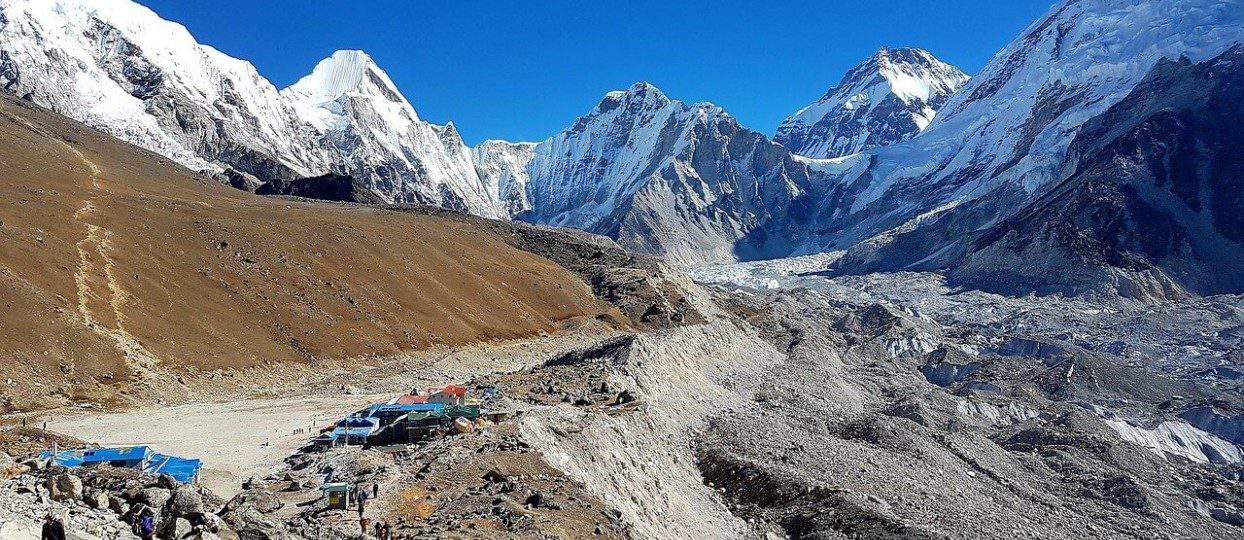
Trekking from Lukla to Everest Base Camp in the Everest region, locally known as Khumbu region , is on the bucket list of every trekking enthusiast.
Trekking to the base of Mount Everest is a dream of every trekker and adventure seeker.
Who wouldn’t want to see the world’s highest peak in front of them?
The Everest Base camp trek takes you to the foothills of the world’s highest mountain, Mount Everest.
Standing at 5,364 meters, the Everest Base Camp offers an up-close view of some of the world’s highest peaks.
Ever since Lukla airport was established in 1964, the Lukla to Everest Base Camp route has been the standard and most popular trekking route in the Everest region.
In the past, the trail from Jiri was the only route to Everest; these days, the trail that starts from Jiri to Everest Base Camp is known as the classic Everest Base Camp Trail.
Everest Base Camp Trek (EBC Trek) will fill your journey with amazing experiences and memories.
You can explore the rich Sherpa culture and witness the astounding biodiversity of Sagarmatha National Park .
Centuries-old monasteries found while going from Lukla to EBC are historic and hold great value among the locals.
En route from Lukla to Everest Base Camp, we spend overnight at Tyangboche. This small Tyangboche village is named after the Tyangboche Monastery, which is also known as Dawa Choling Gompa.
It is the largest monastery in the Everest region and is the Sherpa community’s Tibetan Buddhist monastery.
Mount Everest is gorgeous by itself, and the people living around make the place even better.
The views are incredible, and the overall experience is unforgettable.
So wait no more, pack your bags and begin on your journey from Lukla to EBC.
Table of Contents
Highlights of Lukla to Everest Base Camp:
Lukla to everest base camp brief itinerary:, day 1: take a short flight to lukla, followed by a trek to phakding., day 2: trek to namche bazaar via monjo., day 3: acclimatization day. hike to everest view hotel, explore khumjung and back to namche., day 4: trek to tyangboche, day 5: trek to dingboche., day6: hike to nagartshang peak and back to dingboche., day 7: trek to lobuche., day 8: trek to gorakshep and return trip to everest base camp., day 9: sunrise viewing hike to kala patthar and return to pheriche., day 10: trek back to namche bazaar., day 11: trek to lukla., day 12: flight back to kathmandu., lukla to everest base camp trek map, lukla to everest base camp distance, lukla to everest base camp by car price, lukla to everest base camp helicopter price, lukla to everest base camp elevation, best time to trek from lukla to everest base camp, what are teahouses, head and hands, toiletries and personal hygiene, accessories, additional recommended items, importance of acclimatization on your journey from lukla to ebc:, in conclusion,.
- An exhilarating mountain flight above the great Himalayan range marks the start of this remarkable journey to Everest Base Camp as you fly from Kathmandu to Lukla.
- Experience the historically rich culture of the Sherpas and immerse yourself in the local lifestyle.
- Centuries-old monasteries reflect the richness of art, architecture, and history.
- The views throughout the Everest Base Camp trek are some of the best in the world, with glorious peaks always in sight.
- Green valleys with dense forests add beauty to the landscape, and the biodiversity at this altitude in Sagarmatha National Park is astounding.
- Reaching the Mount Everest Base Camp, at the base of the world’s highest mountain standing at an altitude of 8845 meters, is an achievement in itself.
- Watch the sunrise from the top of Kala Patthar; the beauty during the golden hour will leave you spellbound.
- You will also have a chance to witness the Khumbu Glacier, the world’s highest glacier.
Day 2: Trek to Namche Bazaar.
Day 3: Acclimatization and side trips in Namche.
Day 4: Trek to Tyangboche.
Day 6: Hike to Nagartsang and back to Dingboche.
Day 8: Arrive at Everest Base Camp and trek back to Gorakshep.
Day 9: Hike to Kala Patthar and Pheriche.
Day 10: Trek to Namche Bazaar.
Day 12: Flight back to Kathmandu and onward to your hotel.
Detailed Itinerary of Lukla to EBC:

Maximum altitude: 2,840 meters
Duration: 3-4 hours
The day begins with an exhilarating flight to Lukla, overlooking the grandeur of the Himalayas. It is an adventurous start to this fantastic journey.
After landing in Lukla, you trek for about 3 to 4 hours, mostly downhill through forests of rhododendron and oak trees, crossing traditional Sherpa villages.
The trail is comfortable for walking and is well-maintained.
Overnight in Phakding.

Maximum altitude: 3,440 meters
Duration: 6-7 hours
The walk starts to get a bit tough from this day.
The trail leading to Namche from Phakding is rocky and steep, mostly uphill.
Suspension bridges, including the famous Hillary Bridge on the way to Namche, might give you chills.
The Hillary Bridge, named after Sir Edmund Hillary, is the final suspension bridge that you have to cross while entering the famous town of Namche Bazaar.
Along the way from Phakding to Namche Bazaar, other than these thrilling suspension bridges, the sight of dense forests of rhododendron, fir, and magnolia alongside the Dudh Koshi river will calm your heart and soul.
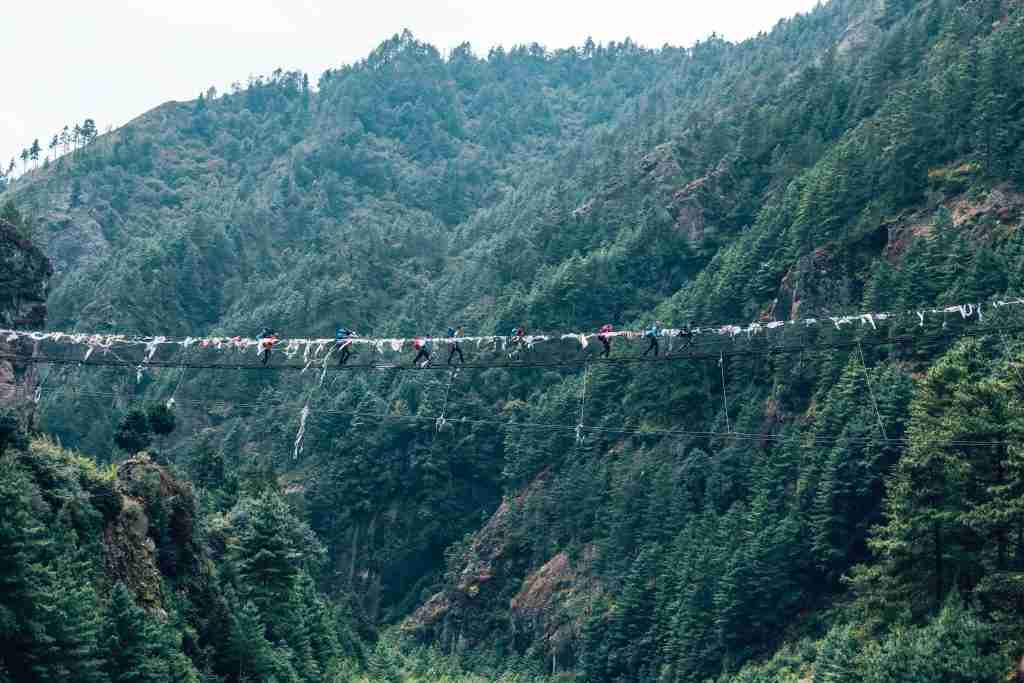
As you get close to Namche Bazaar , the snowy peaks start to appear on the backdrop of this high altitude popular settlement of Namche.
This Sherpa village, with beautiful houses and hotels, is a perfect spot for acclimatization.
Overnight in Namche Bazaar.
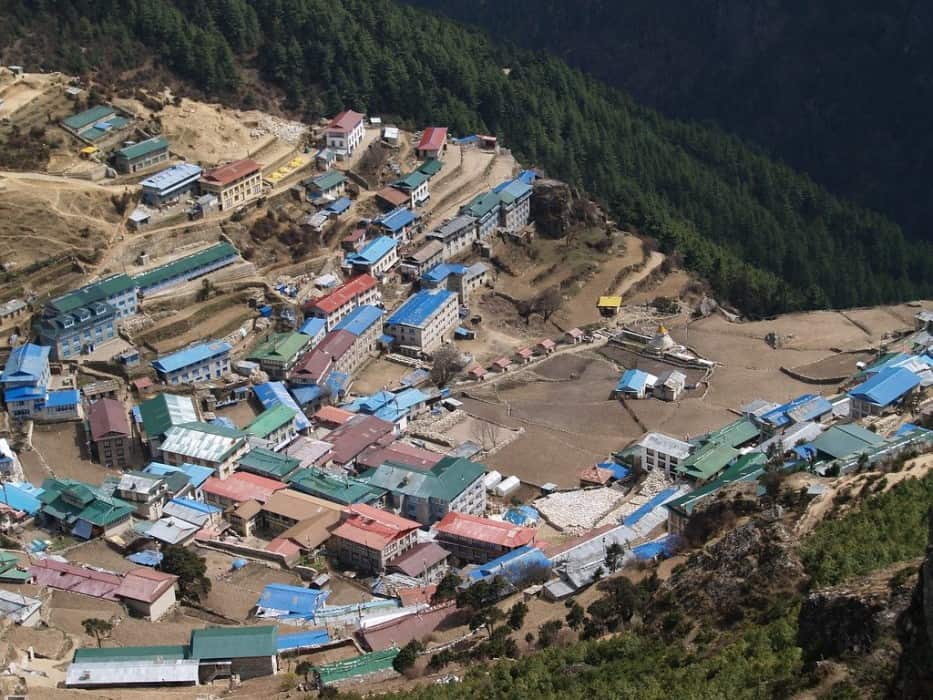
Maximum altitude: 3,962 meters at Everest View Hotel, 3,790 meters at Khumjung
Duration: 4 hours
Since you are at an altitude of 3,440 meters, it’s better to acclimatize.
You hike up to the Everest View Hotel, which is the highest altitude hotel in the world, offering spectacular views of Everest and many other peaks.
The place where the Everest View Hotel is situated is known as Syangboche.
While descending, we explore the Sherpa village of Khumjung.
You can witness the local lifestyle of the people here.
There is a Sherpa cultural museum you can visit to find out more about Sherpas, their culture, and lifestyle.
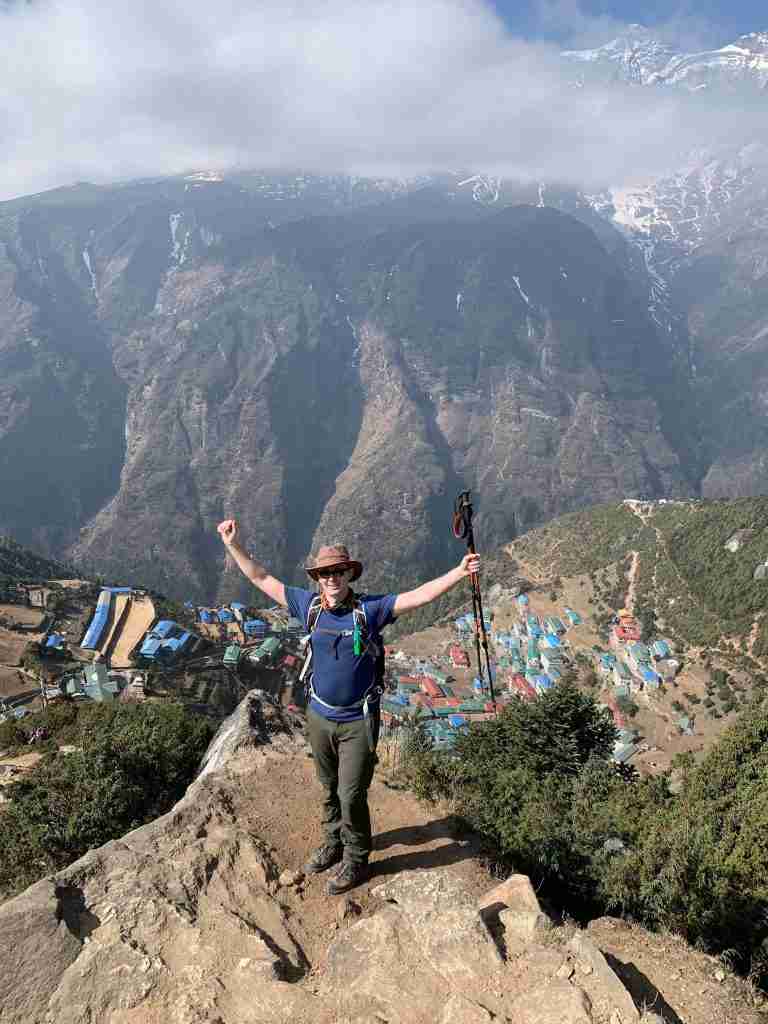
Besides these, Namche offers excellent facilities for teahouses, restaurants, pubs and bars to relax.
Overnight in Namche.
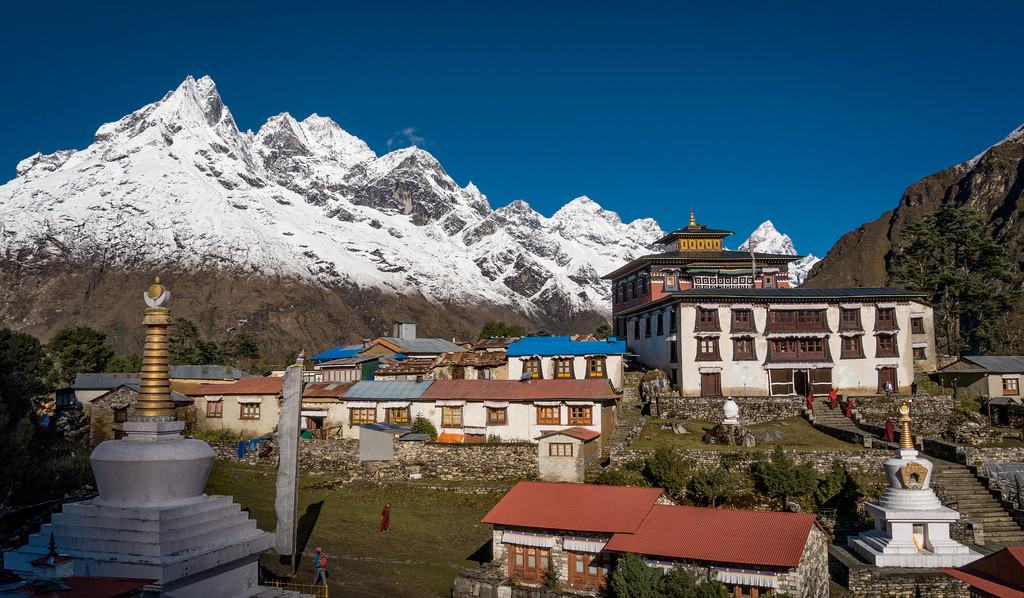
Maximum altitude: 3,860 meters
Duration: 5 hours
On this day, you will walk along the river banks with a few steep inclines.
The vegetation will start to disappear.
The view from Tyangboche is an absolute delight for the eyes.
You will see panoramic views of various mountains such as Kwangde, Nuptse, Lhotse, Ama Dablam, and Mt Everest.
Tyangboche, also known as Tengboche, gets its name from the centuries-old monastery, the Tyangboche monastery, which is of utmost importance in the Khumbu region.
The friendly monks, intricate artwork and blissful aura of this place should not be missed.
Overnight in Tyangboche.
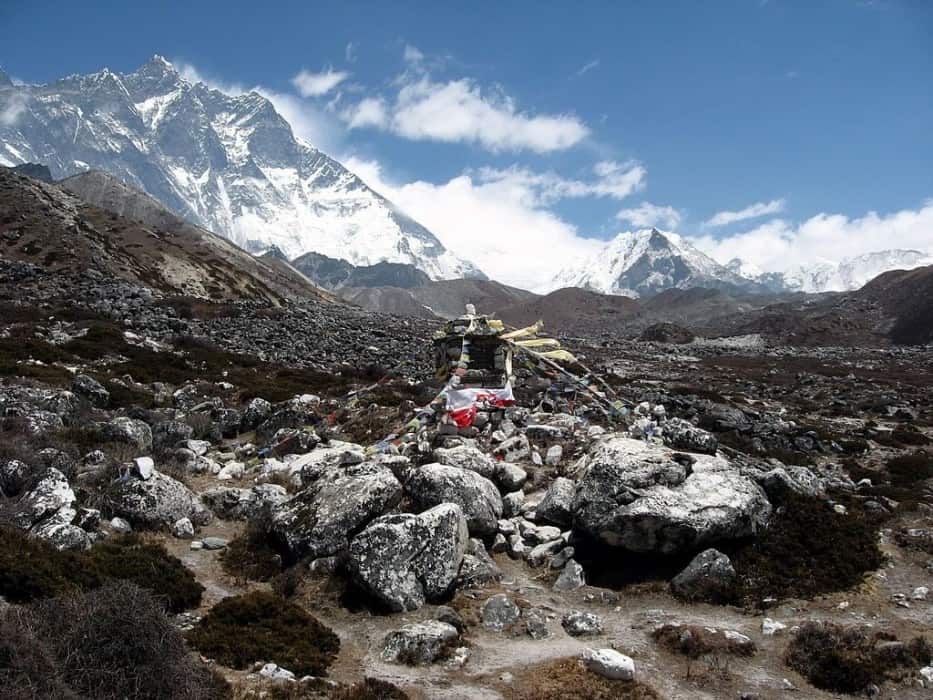
Maximum altitude: 4,360 meters
The section of the Lukla to Everest Base Camp trail on this day is moderately steep.
You will walk through rocky uphill tracks for most of the day. You will cross the 4,000-meter mark today.
As expected, the peaks seem to be getting closer, and amazing views start to appear.
Beautiful mountains such as Lhotse, Island Peak, and Ama Dablam look gorgeous.
You will come across the Pangboche monastery where you can find the allegedly claimed yeti scalp.
The walk follows the trail along Imja Khola. Mani stones and prayer flags add to the beauty of this path.
Overnight at Dingboche.
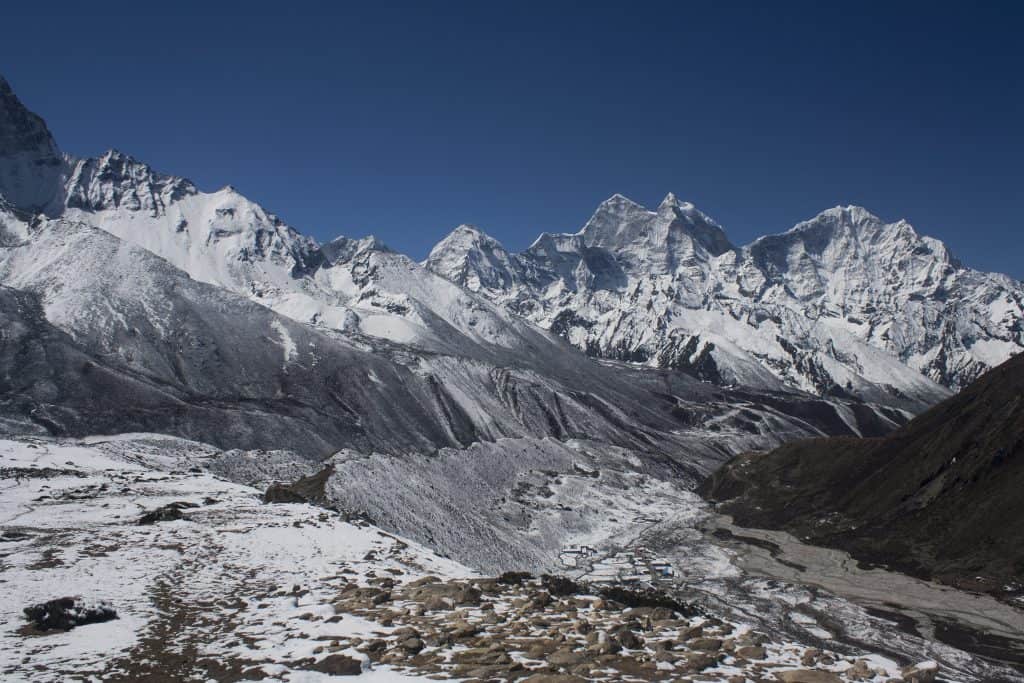
Maximum altitude: 5,080 meters
Duration: 4 hours
Today, you will spend a day acclimatizing in Dingboche.
While in Dingboche, hiking up to Nagartshang (also known as Nagartsang or Nagarjun) peak is a perfect acclimatization hike.
Nagartshang, at an altitude of 5,080 meters, is an uphill ascent on a rocky and steep trail.
This viewpoint offers a mesmerizing view of Makalu and Lhotse.
Hiking up to this altitude and returning to sleep at Dingboche will help your body adapt to the increasing altitude.
Overnight in Dingboche.
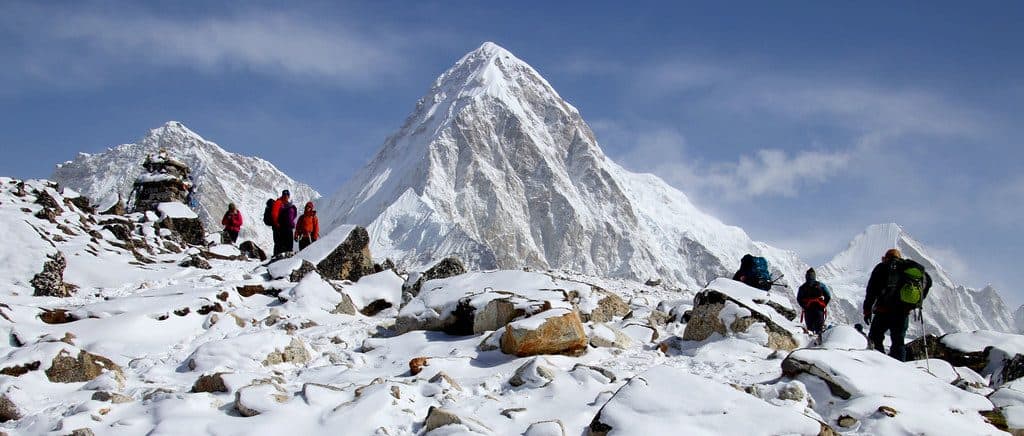
Maximum altitude: 4,940 meters
The trail from Dingboche to Lobuche is rocky with some steep inclines.
It is a tough hike, and the high altitude adds to the adventure.
As you ascend higher, the views of Mount Pumori and Khumbu Icefall are rewarding.
After a long steep climb, the panoramic view from the top is exceptionally satisfying.
There is a memorial in Lobuche in memory of people who lost their lives while attempting to conquer the mountains.
Overnight in Lobuche.
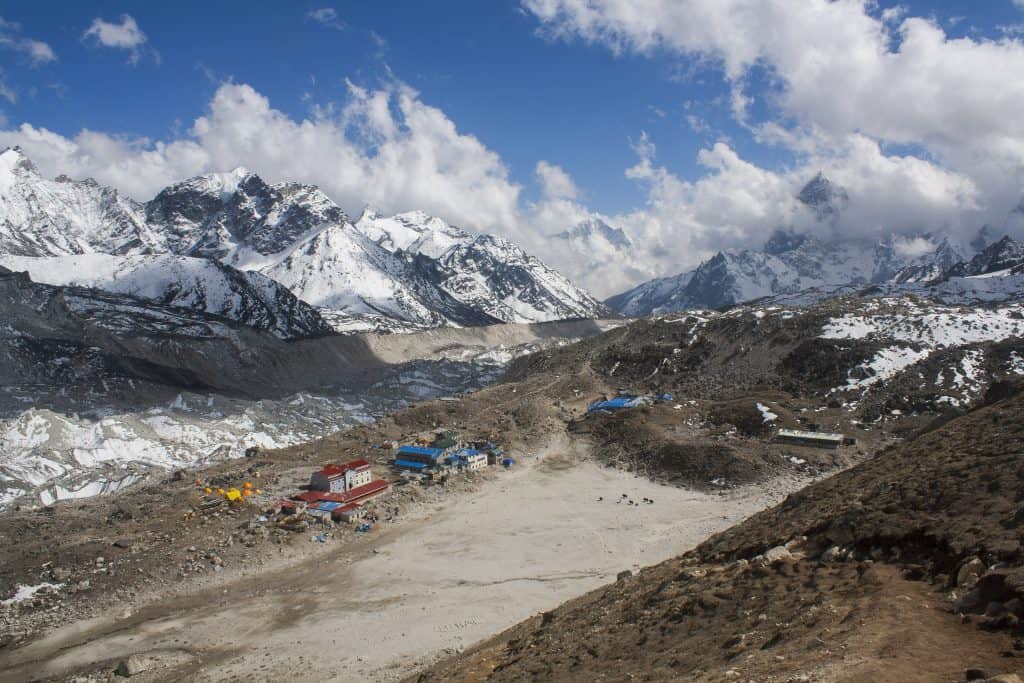
Maximum altitude: 5,364 meters
Duration: 8 hours
This is a significant day of the trek that started from Lukla.
We start our day early, walking through uneven rocky trails towards Everest Base Camp.
The views are stunning with mountains and glaciers surrounding you in all directions.
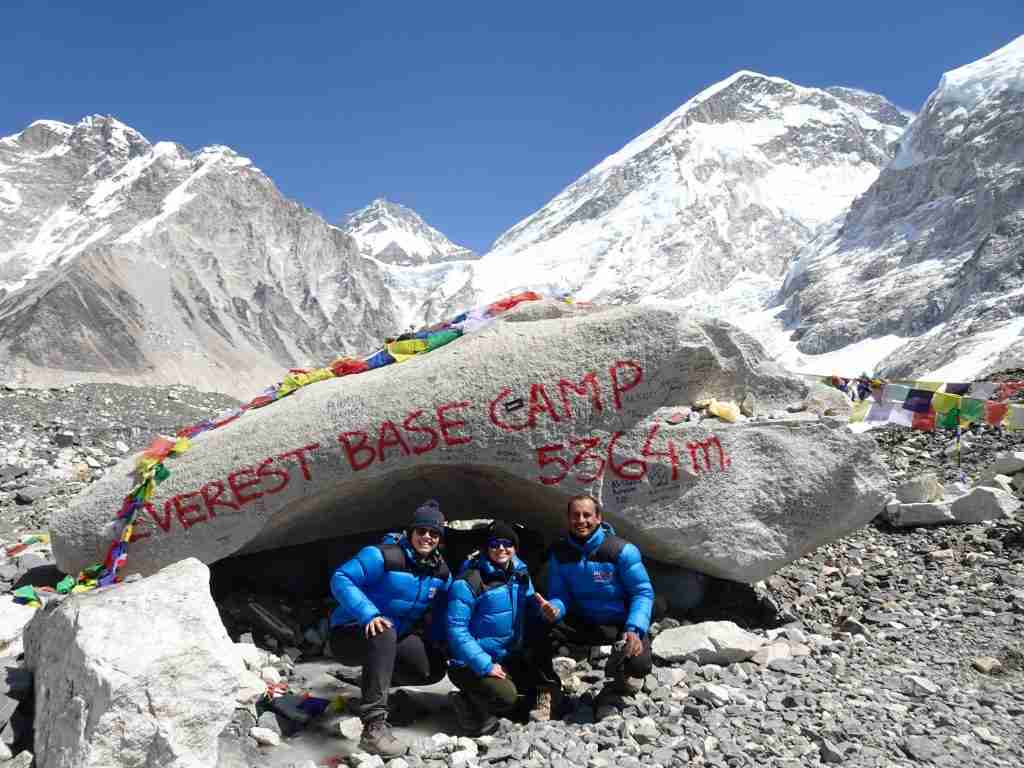
Standing at the Everest Base Camp gives you a sense of accomplishment and satisfaction.
After spending sufficient time at Base Camp for photos, you trek back to Gorakshep for an overnight stay.
Overnight in Gorkashep.
Maximum altitude: 5,545 meters
Duration: 7 hours
Today, you hike up to the most famous viewpoint of Kala Patthar.
Starting your hike at dawn will help you witness the spectacular and unforgettable sunrise view from Kala Patthar.
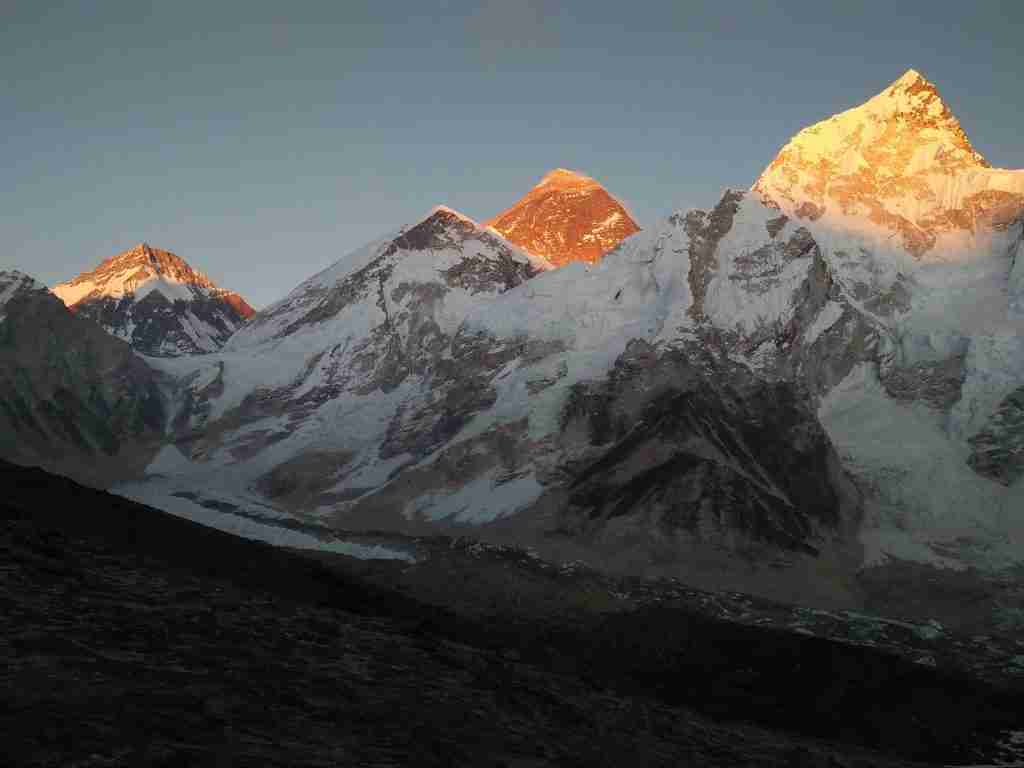
This is the best viewpoint to watch Everest and the surrounding Himalayas.
When the sun hits the glorious snow-capped mountains, the result is simply stunning.
From here, you will trek back to Pheriche for an overnight stay.
Overnight in Pheriche.
The return trek to Namche Bazaar on this day is a steep descent through stone steps, rocky trails and grasslands.
The walk is easy for those who don’t like climbing up.
On reaching Namche Bazaar, you can celebrate the success of your trek.
There are plenty of bars and restaurants for that. You can also explore the local market and get some souvenirs for friends and family.
On the final day of descent, you will enjoy the beautiful view of rivers and snow-covered mountains in the backdrop.
The trail passes through river banks and dense forests. Bird watching is quite popular in Sagarmatha National Park .
The feeling of completing the trek will make your walk easy and pleasant. Overnight in Lukla.
Overnight in Lukla.
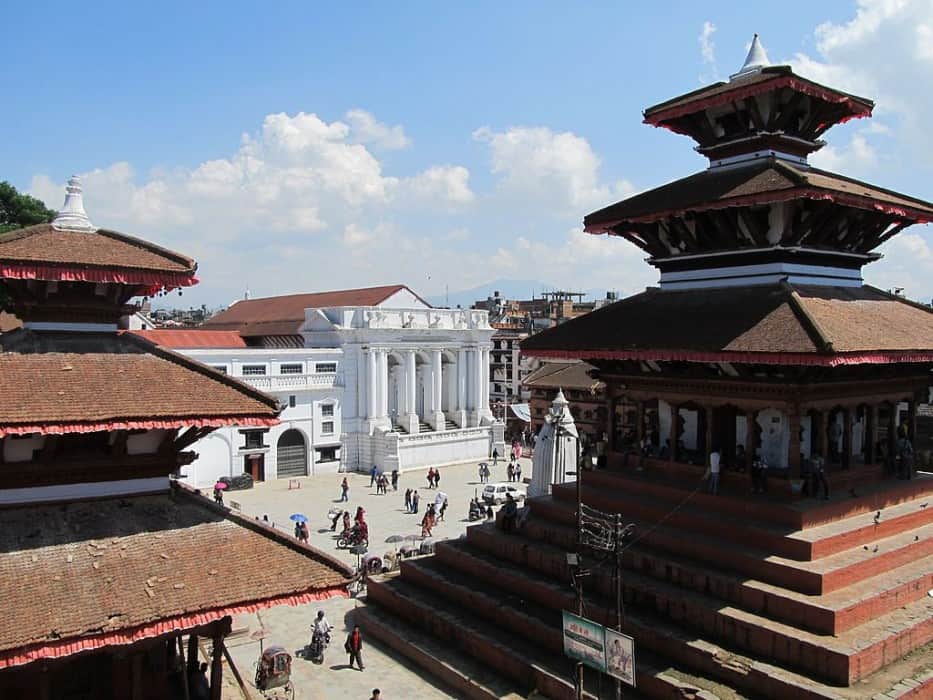
This is the day when you take another exciting flight over the Himalayas.
The 30-minute flight will take you to the capital city of Kathmandu.
Flights might get delayed due to weather conditions, so keeping a flexible schedule is advised.
Our standard 14-day package of the Everest Base Camp Trek includes the above 12 days of the trek.
For those with limited time, you can book this 11-day Everest Base Camp Trek with Helicopter Return .
Below map shows the most visited places on the journey from Lukla to Everest Base Camp.
These are the main places we reach during the 12-day itinerary mentioned above.
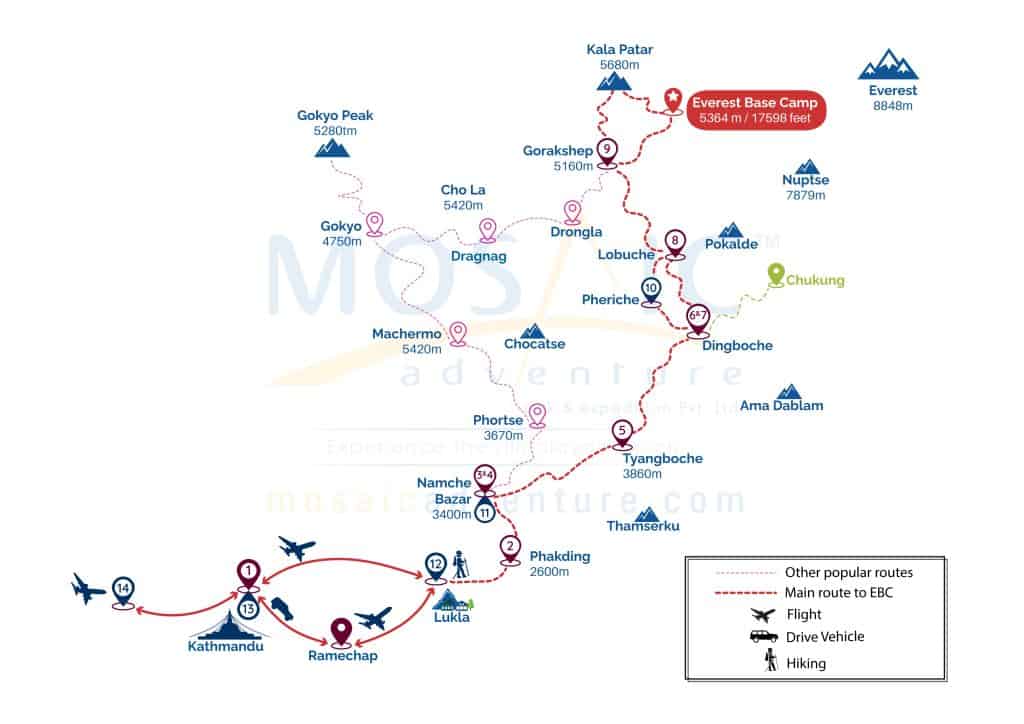
Lukla to Everest Base Camp Cost
When you plan a trek from Lukla to EBC, you must know it will prove an exciting and expensive adventure. The costs of this adventure generally include permits, guide fees, accommodation, and meals along the trekking route.
Moreover, the overall cost mainly depends on various factors like the season of travel and the chosen trekking agency. It is important to budget for a safe and memorable journey, but there are lots of packages and options available that can handle your different financial considerations.
Before covering the camp cost, you must know the total distance and all the resources you can use for camping. Here are some basic information you must know before deciding your budget.
The trek from Lukla to EBC covers approximately 65 kilometres (40 miles) and is an important factor for trekkers planning their Himalayan adventure. This trek offers an immersive experience of the rugged beauty of the Khumbu region, showcasing stunning landscapes, local culture, and high-altitude challenges.
Trekking lovers often take around 12 days to cover this distance, allowing for acclimatization and an unforgettable journey to the foothills of the world’s highest mountain, Mount Everest.
Reaching Everest Base Camp by car may seem like a good option for some adventurers, but the challenging terrain and lack of proper roads in the region make it an unfeasible option.
Traditionally, trekkers fly into Lukla and start their journey on foot, and immers themselves in the unique mountain environment. The captivating beauty and cultural richness along the trekking route make this traditional approach the preferred choice for reaching Everest Base Camp.
Although trekking may take longer, it is undoubtedly the most rewarding way to experience the Khumbu region.
If you want to reach Everest Base Camp quicker and more luxuriously then it is no more difficult as the helicopter service is available from Lukla.
The cost of a helicopter ride varies depending on factors such as the type of helicopter, weather conditions, and demand.
Although this option is more expensive than traditional trekking, it offers a time-efficient and breathtaking aerial view of the Himalayas. The convenience and scenic splendor of this option make it an attractive alternative for those who have a higher budget. You can contact us for more information.
The journey from Lukla to Everest Base Camp is known for its significant change in elevation. The trek begins at Lukla, which is situated at an altitude of approximately 2,800 meters (9,200 feet).
As trekkers start to climb, they face varying elevations and acclimatization challenges. The base camp of Mount Everest is located at a remarkable altitude of 5,364 meters (17,598 feet).
For viewing the world’s highest peaks, the whole trek demands physical preparation and a deep appreciation for the natural wonders of the Himalayas .
Hands down, spring and autumn are the two best seasons to trek in Nepal, and the same goes for the Everest Base Camp trek.
During autumn, the weather is warm, making it easy to trek in such conditions.
Visibility is at its best, making the mountains seem spectacular.
Additionally, autumn is the time for festivals in Nepal, making it the best time for trekking to Everest Base Camp .
Spring is generally much warmer than autumn, and the all-round greenery and blooming flowers make it a delightful time to trek.
There’s a freshness in the air unlike any other time.
Those who hate the cold should plan their trek in the spring season, especially between early May to mid-June.
Winter and monsoon are not among the ideal times to trek, but for avid trekkers, this might be the right time as trails are less crowded.
Thus, the best time depends on the purpose of the trek, time availability and your interests.
Accommodation on Lukla to Everest Base Camp Trek
Accommodation during the Everest Base Camp trek ranges from basic to “luxury” hotels.
In places like Namche Bazaar or below, you can find luxury lodge options like the Yeti Mountain Home.
However, as you go higher from Namche Bazar, the facilities for accommodation become quite basic, and your only option is basic teahouses.
Teahouses are basic lodges built along the trail to provide shelter and accommodation to trekkers.
They are better than tents but nothing fancy. So, keep your expectations low in terms of trek accommodation.
These teahouses offer food services with rooms on a twin or dorm-sharing basis.
The teahouse owner arranges all your requirements for food and shelter.
On these teahouse treks, you do not need to carry food and camping gear.
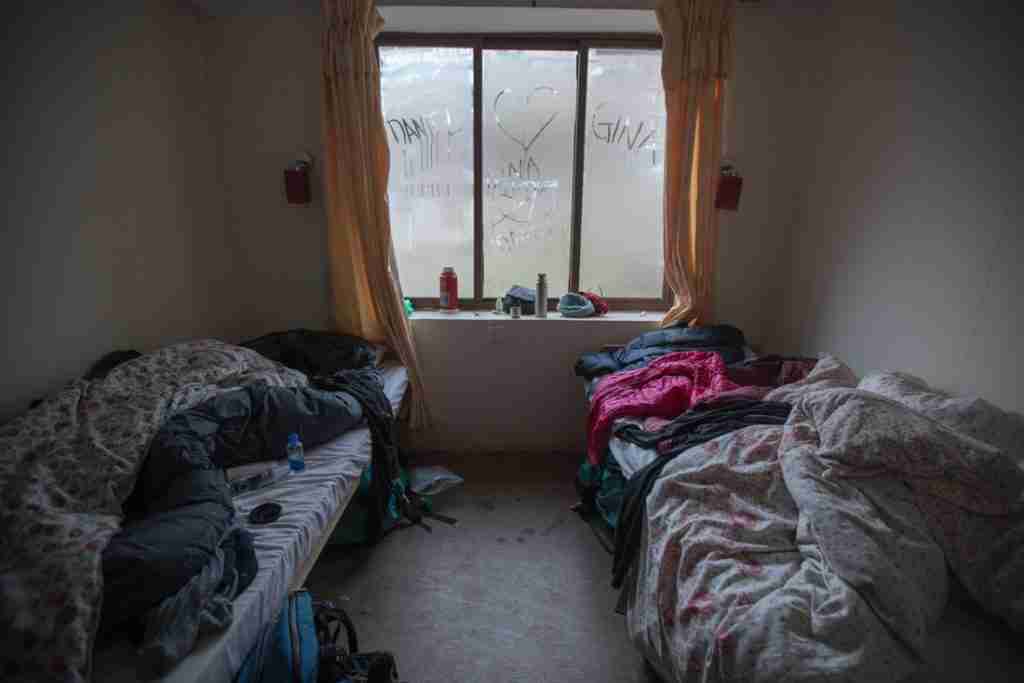
Packing Guideline
- Warm hat (for morning and evening)
- Polarized UV sunglasses
- Bandana or scarf
- Waterproof and windproof gloves
- Waterproof and windproof jacket
- Synthetic insulated jacket
- Down jacket
- Windstopper jacket
- Rain jacket
- Thermal inner wear
- Moisture-wicking tops
- Convertible hiking pants
- Hiking shorts
- Warm hiking undergarments

- Hiking shoes(waterproof recommended)
- Hiking socks
- Hiking sandals
- Antibacterial hand-wash
- Tissue or toilet paper
- Sunscreen and other creams
- Moisturizer
- Toothbrush and toothpaste
- Shampoo and conditioners
- Feminine hygiene products
- Quick-drying towel
- Water bottle
- Trekking Poles
- Headlamps and extra batteries
- Sleeping bag
- First aid kit
- Waist bag for small items
- Extra plastic bags (to keep extra things like dirty laundry and waste)
- Everest Base Camp Trek Map and information on route and mountains
- Binoculars (optional)
- DSLR Camera and extra batteries
- Pillowcase (For better hygienic stay)
- Your documents
Acclimatization is crucial for your journey from Lukla to Everest Base Camp.
It makes trekking more enjoyable and safer.
Unfortunately, many trekkers underestimate the risk of altitude sickness and end up having a bad experience.
Even though time is limited in our busy world, it’s essential not to compromise on safety.
Taking it slow and following the acclimatization guidelines is the key to a successful trip.
Acclimatization means allowing your body to adjust to higher altitudes and lower oxygen levels.
We hike to higher areas during the day and return to sleep at lower altitudes to help our lungs adapt to the thin air of the Everest region.
During the 12-day journey with Mosaic Adventure, we’ve included 2 acclimatization days—one in Namche Bazaar and one in Dingboche.
On these days, our guide will take you to higher elevations and then bring you back to sleep at lower elevations where you spent the previous night.
Apart from the acclimatization days, it’s crucial not to push yourself every day.
Give your body enough time to rest, walk at a slow pace and drink plenty of water to stay hydrated.
A hydrated body will better adjust to the lower oxygen levels.
Make sure to take frequent breaks while climbing from Lukla to EBC.
By walking slowly, using acclimatization days and staying hydrated, you can make this journey a trip of a lifetime.
Join Mosaic Adventure on a thrilling and unforgettable journey from Lukla to Everest Base Camp.
Our team of professional and trained experienced guides and porters ensures a safe and enjoyable trek, while small group sizes and affordable prices make it accessible to all.
Discover the highlighted points mentioned above, including the best time to visit, accommodation options, essential packing tips and other useful information for your adventure.
Most importantly, learn about the importance of acclimatization to ensure a successful and safe trek.
Book with us now for a hassle-free and memorable trekking experience of a lifetime.
Want more information? Send us your query, and our experts will get back to you within 24 hrs.
- Full Name *
- Address Select Country Afghanistan Albania Algeria American Samoa Andorra Angola Anguilla Antarctica Antigua and Barbuda Argentina Armenia Aruba Australia Austria Azerbaijan Bahamas Bahrain Bangladesh Barbados Belarus Belgium Belize Benin Bermuda Bhutan Bolivia Bonaire, Sint Eustatius and Saba Bosnia and Herzegovina Botswana Bouvet Island Brazil British Indian Ocean Territory Brunei Darussalam Bulgaria Burkina Faso Burundi Cabo Verde Cambodia Cameroon Canada Cayman Islands Central African Republic Chad Chile China Christmas Island Cocos Islands Colombia Comoros Congo Congo, Democratic Republic of the Cook Islands Costa Rica Croatia Cuba Curaçao Cyprus Czechia Côte d'Ivoire Denmark Djibouti Dominica Dominican Republic Ecuador Egypt El Salvador Equatorial Guinea Eritrea Estonia Eswatini Ethiopia Falkland Islands Faroe Islands Fiji Finland France French Guiana French Polynesia French Southern Territories Gabon Gambia Georgia Germany Ghana Gibraltar Greece Greenland Grenada Guadeloupe Guam Guatemala Guernsey Guinea Guinea-Bissau Guyana Haiti Heard Island and McDonald Islands Holy See Honduras Hong Kong Hungary Iceland India Indonesia Iran Iraq Ireland Isle of Man Israel Italy Jamaica Japan Jersey Jordan Kazakhstan Kenya Kiribati Korea, Democratic People's Republic of Korea, Republic of Kuwait Kyrgyzstan Lao People's Democratic Republic Latvia Lebanon Lesotho Liberia Libya Liechtenstein Lithuania Luxembourg Macao Madagascar Malawi Malaysia Maldives Mali Malta Marshall Islands Martinique Mauritania Mauritius Mayotte Mexico Micronesia Moldova Monaco Mongolia Montenegro Montserrat Morocco Mozambique Myanmar Namibia Nauru Nepal Netherlands New Caledonia New Zealand Nicaragua Niger Nigeria Niue Norfolk Island North Macedonia Northern Mariana Islands Norway Oman Pakistan Palau Palestine, State of Panama Papua New Guinea Paraguay Peru Philippines Pitcairn Poland Portugal Puerto Rico Qatar Romania Russian Federation Rwanda Réunion Saint Barthélemy Saint Helena, Ascension and Tristan da Cunha Saint Kitts and Nevis Saint Lucia Saint Martin Saint Pierre and Miquelon Saint Vincent and the Grenadines Samoa San Marino Sao Tome and Principe Saudi Arabia Senegal Serbia Seychelles Sierra Leone Singapore Sint Maarten Slovakia Slovenia Solomon Islands Somalia South Africa South Georgia and the South Sandwich Islands South Sudan Spain Sri Lanka Sudan Suriname Svalbard and Jan Mayen Sweden Switzerland Syria Arab Republic Taiwan Tajikistan Tanzania, the United Republic of Thailand Timor-Leste Togo Tokelau Tonga Trinidad and Tobago Tunisia Turkmenistan Turks and Caicos Islands Tuvalu Türkiye US Minor Outlying Islands Uganda Ukraine United Arab Emirates United Kingdom United States Uruguay Uzbekistan Vanuatu Venezuela Viet Nam Virgin Islands, British Virgin Islands, U.S. Wallis and Futuna Western Sahara Yemen Zambia Zimbabwe Åland Islands Country
- Trip Title *
- Number of Days
- Group Size *
- Travel Date Day Month Year
- Contact Number *
- Your Email *
- Describe Your Trip *
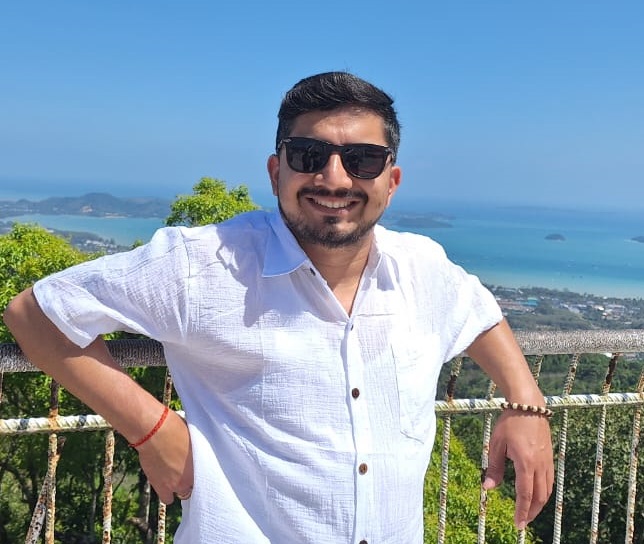
Madhav started working as a porter in 2001 and then moved on to work as a trekking guide. After working in the trekking and tourism industry for eight years, he co-founded Mosaic Adventure in 2009.
Madhav has trekked to most of the trekking destinations in Nepal, including Everest Base Camp Trek, Annapurna Base Camp, Annapurna Circuit Trek, Poon Hill Trek, Jomsom Muktinath Trek, Indigenous Peoples Trek, Langtang Valley Trek, Mardi Himal Trek, and all of the day hikes around Kathmandu.
He has also extensively traveled to other countries such as Australia, the USA, the UK, France, Hong Kong, Japan, China, the Philippines, the UAE, Saudi Arabia, Bahrain, Thailand, Turkey, and India. Madhav is the one who answers most of your questions about trekking and tours and helps to plan your trip by giving a personal touch.
You may also be interested in...
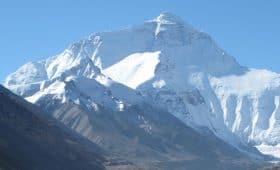
Everest Base Camp Trek in July
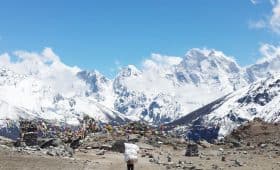
14 Days Everest Base Camp Trek Itinerary
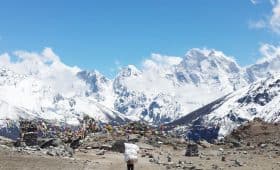
5 Days Everest Base Camp Trek
(1) comment.
Nice info with amazing images ! Thanks for sharing the useful information.
Leave a Reply Cancel reply
Your email address will not be published. Required fields are marked *
Save my name, email, and website in this browser for the next time I comment.
From Lukla To Everest Base Camp: A Guide To The Best Routes And Trails
Trekking from Lukla to Everest Base Camp is often considered one of the best ways to see the area: will you add this journey to your bucket list?
Quick Links
How long is the trek from lukla to everest base camp, where can hikers stay while traveling from lukla to everest base camp, can any level hiker travel from lukla to everest base camp is it safe.
Located in the Himalayas lies the world-renowned trek from Lukla to Everest Base Camp, a journey that draws adventurers from across the globe. This 130 km (77 miles) round trip trek is a challenging but rewarding experience, showcasing the natural beauty of the region and offering a glimpse into the daily lives of the local Sherpa people.
The trek from Lukla to Everest Base Camp typically takes 13 days, starting from Kathmandu. Before embarking on this journey, hikers must train to prepare for the rigorous terrain and high altitude. This is especially important given the risks associated with being at such high altitudes for an extended period.
The trek from Lukla to Everest Base Camp is an unforgettable journey that offers a glimpse into one of the world's most breathtaking regions. With proper training and a sense of adventure, anyone can tackle this challenging but rewarding trek and come away with memories to last a lifetime.
- Lukla to Everest Base Camp is 38.5 miles.
- This entire hike should take people between 11 and 14 days in total.
- Many hikers between these two spots spend 8–9 hours walking daily.
For people wanting to take on Everest Base Camp from Lukla, this will be the journey of a lifetime. This trek between the two spots is approximately 38.5 miles, usually taking hikers 11–14 days. One thing to note, this trek is 38.5 miles either way: totaling 77 miles. According to past hikers, people will begin their eight-day hike from Lukla to the Everest Base Camp and then four days to trek back to Lukla. Some may want to hang out at Everest Base Camp for a couple of days, so that will add time to the entire voyage.
Luckily, the scenery between these notable hiking locations offers unparalleled views of the surrounding landscape, giving adventurers insight into the Sherpa people. Another detail to remember when traveling between Lukla and Everest Base Camp is that most people recommend hiking for 8–9 hours daily to keep the schedule at 11–14 days.
Some people even skydive from Mount Everest : so the adventure doesn't need to stop at the ground.
Related: 10 Stunning Himalayan Hiking Trails That Are Not Everest (Or Even Close)
The Best Trekking Route To Everest Base Camp
When it comes to the best route for those trekking to Everest Base Camp, people want to take The Classic Everest Base Camp trek. This path is the most direct route from Lukla to the 18,192-foot peak of Kalapatar. Hikers will also get the best view of Mount Everest from here, so that's perfect for those wanting to snap a few photos.
However, here are some alternative routes and timelines that one could take to get to the Classic Everest Base Camp Trek:
- Jiri to Everest Base Camp (19–21 days trekking)
- Tumlingtar to Everest Base Camp (21–23 days trekking)
- Gokyo Over Cho La Pass (17–18 days trekking)
- Lukla to Tengboche (around 7 days trekking).
The trek from Lukla to Everest Base Camp is 38.5 miles each way, totaling 77 miles for hikers. Therefore, to finish this trek in 11–14 days, hikers must spend 8–9 hours daily on the move.
- Hikers can stay between Lukla and Everest Base Camp in teahouses, lodges, and campsites.
- Phakding lies between Lukla and Namche Bazaar, making it a great stop along the way.
Trekking from Lukla to Everest Base Camp will have a few lodging opportunities between the two destinations. Generally, past hikers recommend stopping in Phakding, which takes roughly 3 to 4 hours to walk from Lukla. Along this trail, people can stay in lodges or teahouses, which will be primitive and won't be a "typical" experience. The road to Everest may be daunting, so preparing for this journey is crucial .
To explain these teahouses/lodges , they are houses with usually more than two floors but sometimes only one, with dozens of rooms. This could be a fun way to meet other adventure seekers along the way to Everest Base Camp (and back), so don't be afraid to start a conversation.
The trail between Lukla and Everest Base Camp is globally visited, so there will be people from all different cultures and countries to enjoy this with. These ten Everest Base Camp facts may be fun to know before the journey.
Related: Mt Everest: The History & Story Behind The World's Tallest Mountain
In general, if someone is healthy and regularly hikes, they should be able to handle the walk from Lukla to Everest Base Camp. One thing to keep in mind, however, is that this trek isn't easy but isn't nearly as challenging as taking on Mount Everest. The entire region is known for its high elevation and chilly weather, which may be difficult for some hikers.
There are many things to see and experience at the base of Mount Everest , so people don't need to take on the summit to have a memorable experience.
According to trek guides , the Everest Base Camp area is far easier for hikers than other areas, especially when compared to Everest: often considered one of the more dangerous journeys on Earth. It may be helpful to train before heading to Lukla and then to Everest Base Camp, taking on hikes near where someone lives. For example, if there are mountains nearby, that could be a great way to train for this Nepal adventure.
Going to the gym and using machinery at an incline may also help prepare someone for this, although nothing beats getting outdoors. If there is any hesitation with taking on a trek from Lukla to Everest Base Camp, it might be worth consulting a doctor and ensuring people's health is good enough to head to the mountains.
These are ten essential tips for anyone traveling to Everest Base Camp that are worth reading.

Himalaya View Treks
- Trekking in Nepal
- Everest Region Trekking
Everest Base Camp Trek From Lukla
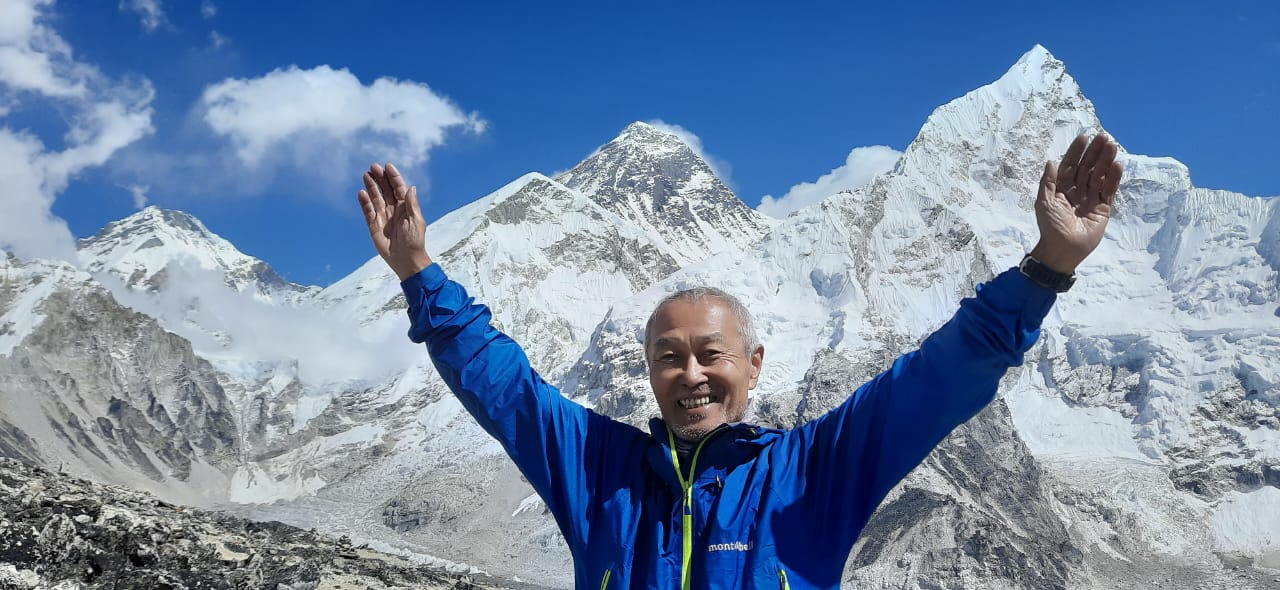
Short Itinerary
- Cost Includes/Excludes
- Cost and Dates
Useful Info
Detailed itinerary.
- Tour Includes/Excludes
Trip overview
Everest base camp trek from lukla – 8 days.
Himalaya View Treks organizes an 8-day Everest Base Camp trek from Lukla. It journeys through legendary trails into pretty hamlets with cultivated fields and treks from Lukla to Everest Base Camp. On the way, we view astonishing landscapes & the king of all peaks – Mt. Everest. This is enough to get the adrenaline racing. Most importantly, we do all of it in only 08 days. Why wait? Put your boots into your rucksack & hit the road. It’s now, or never…
8 days Everest Base camp trek from Lukla is with the inborn local guides and sturdy Sherpa porters. Born into this region, they know the trails better than they know themselves. Therefore, this trip is not only a plan to match your timeframes; it also saves you money. You don’t need to pay for a guide’s flight ticket. After your thrilling flight to Lukla touches down we meet our local crew & get friendly with some handshakes. We then begin our hike along the banks of the milky Dudh Kosi River to Phakding village. And so begins our once-in-a-lifetime journey to stand in the shadows of the highest mountain on earth. The Best season to trek from Lukla to Everest base camp is April / May and October/Nov to Dec. Remember us Top of The World Mt. Everest base campfrom Lukla for 2024 / 2025.
Himalaya View Treks is the first Company to promote & support Local Sherpa guides and Porters From Lukla.
HVT is the first company to promote and support local Sherpa guides/porters for the Everest region from Lukla . Our 08-day Everest Base Camp Trek from the Lukla route takes you into the heart of Sherpa country . Moreover, you get to see awesome alpine landscapes & beyond. Similarly, we walk trails that don’t follow the beaten path, which brings us to friendly villages. Further, the trek takes us to Namche Bazaar where we get good acclimatization. In other words, it’s a steep walk up to the Everest View Hotel.
Meanwhile, by coming this far, we’re now well-acclimatized to hike in the footprints of earlier mountain legends. We’re thoroughly set to climb up to base camp as the excitement grows within us. If it’s a spring trip, we’re likely to see a whole lot of colorful expedition tents set up for a ‘King Everest’’ summit. It’s interesting!
Everest Base Camp Trek in 8 Days
Furthermore, our 8-day Lukla to Everest Base Camp trek itinerary includes the Kalapatthar at 5545m/18,192ft. The mind-blowing views of Mount Everest, Lhotse, Nuptse, and Makalu leave you awestruck. Added to this is a spectacular sunrise with maroon-pink sunrays that seep through the giant mountains. This is an unforgettable moment. Finally, we then walk back to Lukla via Pheriche to celebrate our short EBC trek. If you’re looking for something similar elsewhere, try our ‘ Langtang Valley trek for 8 days, the scenic landscapes here are gripping. The ‘Thorung La Pass trek 10 days’ would be ideal if you’re up for a long-haul vacation. This is a stunning trek in the Annapurna region. Moreover, if you’re experienced enough & want to forget trekking for a while, then try ou r ‘Island peak climb from Chhukung’’. This is a venture where you’ll walk among giants.
Lukla to Everest Base Camp Trek - 8 days Itinerary
Day 1: Fly to Lukla from Kathmandu, meet with guide and porter, and then trek to Phakding walking distance of 6.2 km (2/3 hours) 2610 M / 8,664 feet)
Day 2: Phakding to Namche walking distance is 7.4 km (5-6 Hours) 3,440m/11,283ft
Day 3: Trek From Namche Bazaar to Pangboche walking distance- of 9.1 km (5 to 6 hours) 3930m/12890ft
Day 4: Trek From Pangboche to Dukla walking distance is 7.9 km (7 hours)4,680m/15,435ft
Day 5: Trek From Dukla to Gorakshep walking distance is 6 km (6-8 hours) (Gorekshep) 5180m/16,994ft & Everest Base Camp 5364m/17598
Day 6: Gorakshep to Pheriche walking distance 9.8km (5-6 hours)5,545m/18,192ft (Kalapathar) & 4,320m/14,173ft (Pheriche
Day 7: Trek From Pheriche to Namche Walking Distance 14.2 km (5-6 hours) 3440m/11285ft
Day 8: Trek Namche to Lukla Walking Distance 13.5 km (5-6 hours) 2,800 m 9,100 ft
Day 9: Fly back to Kathmandu, Altitude of Kathmandu (1300m) (35 minutes). We woke up early for our flight back to Kathmandu.
Detailed Itinerary
Day 01: fly to lukla and trek to phakding.
We get ready early in the morning for our flight to Lukla (2,860 meters). We are going to set our foot on the marvelous Everest region. A short and beautiful flight lands us at Lukla Hillary airstrip where incredible mountain views welcome us to the charming mountain region. As soon as we come out of the airport, we get ready to begin the trekking journey. We are trekking to Phakding (2,610 meters) today on a gentle and easy trail that takes us past chhortens, mani walls, prayer flags, etc. to let us know that the region has a big influence of Buddhism. We reach Phakding on the bank of Dudh Koshi River stay overnight at our teahouse lodge. Refresh and dinner- Lukla to Phakding trek distance 6.2 km (3-4 Hours) 2,860 meter/9184ft
Day 02: Trek to Namche bazar from Phagding
We are going to enter Sagarmatha national park on our trek to Namche Bazar today. As we hit the trail from Phakding, we follow the river and cross in some different places over suspension bridges. Once we check at the national park checkpoint at Monjo, we continue walking towards the destination. Although the trail today gives us the pretty tough challenge of traversing uphill trail, we go on a gentle pace to ease the challenge. Stay overnight at our teahouse. Refresh and dinner- Phakding to Namche trek distance is 7.4 km (5-6 Hours) 3,440m/11,283ft
Day 03: Trekking to Pangboche from Namche
You make your way to Pangboche via Namche bazaar. You then make a quick descent to Phunki Tenga and take an upward trail. The trail leading up is covered by a dense forest of pine, birch, and rhododendron. We explore the beautiful settlement of Monjo & Jorsalle before proceeding to Pangboche. These villages display some great Sherpa culture which we learn while interacting with the local folks. Later, we follow the trail to Pangboche, the highest permanent settlement in the Khumbu. Unlike the villagers living in the higher elevations who migrate to the lower reaches during the winter season, most inhabitants of Pangboche choose to live in their village the whole year-round. Overnight bunk out in Pangboche-Namche to Pangboche walking distance- 9.1 km. (5/6 hours trek) 3930m/12890ft
Day 04: Trek to Dukla from Pangboche
After hot and warm breakfast, trekking to Dukla today so we embark on the adventure walk of the day. The trail goes amidst the high towering mountains and passes Pheriche village. We cross a mountain river along the trail to start the uphill challenge. The trail goes pretty much uphill after Pheriche up to Dukla. Overnight at our teahouse lodge, Refresh and dinner – Pangboche to Dukla walking distance is 7.9 km (7 hours)4,680m/15,435ft
Day 05: Trek to Gorakshep & hike to Everest Base Camp
We are going to trek all the way to Everest base camp today. We wake up early in the morning; take our breakfast and quickly get ready for the adventure of the day. With the excitement of reaching the Everest base camp, we set out on the trek of the day. We reach Gorakshep (5,142 meters) and stop for lunch. Gorakshep is also our overnight place for the day so we check into our lodge. Later after lunch, we get ready to trek to the Everest base camp. A gradual ascension through the boulder-strewn path takes us to the epic base camp of the highest mountain in the world. We enjoy our moments there for a while; take pictures and exploit the most out of the time. Later, we trek back to Gorakshep overnight at our teahouse lodge. Refresh and dinner- Dukla to Gorakshep walking distance is 6 km (6-8 hours) (Gorekshep) 5180m/16,994ft & Everest Base Camp 5364m/17598
Day 06: Hike to Kalapatthar & trek back to Pheriche
We have an early morning wake up today as we have to start the hike to Kalapathar before the break of dawn to reach there for sunrise. Early morning challenge of uphill hike brings us such a rewarding view that makes our day. Breathtaking panoramic view of the Mt. Everest and other mountains in the range and sunrise over those mighty peaks make this place a wonderland where we can enjoy the magical mountain marvels. Later we trek back down to our lodge in Gorakshep to have our breakfast and start trekking to Pheriche (4,371 meters) the destination for the day. After enjoying the Everest base camp and Kalapatthar moments, we are now on our return trip down towards Lukla, overnight at our teahouse lodge. Refresh and dinner – Walking distance 9.8 km (5-6 hours)5,545m/18,192ft (Kalapathar) & 4,320m/14,173ft (Pheriche)
Day 07: trek back to Namche from Pheriche
Trek back to Namche Bazar Altitude of Namche (3440m) On our trek along and among the magnificent mountains, we are trekking down to Namche today via Khumjung village. We spend some time at the small and beautiful village, Khumjung that boasts perfect views of mountains including Khumbila peak. We visit a monastery there and head towards Namche overnight at our teahouse lodge. Refresh and dinner- Pheriche to Namche Walking Distance 14.2 km (5-6 hours) 3440m/11285ft
Day 08: Trek back to Lukla from Namche
Trek back to Lukla Altitude of Lukla (2840m) Walking distance 5/6 ) We trek all the way back to Lukla today to finish the trekking journey. We trek past Monjo and Phakding villages; encounter the Dudh Koshi River along the trail and eventually reach Lukla. As the final day of the trek, we can celebrate the beautiful adventure. We see off our trekking potters here today thanking them for all the help they provided to make our trip possible, overnight at our teahouse lodge refresh and dinner- Namche to Lukla Walking Distance 13.5 km (5-6 hours) 2,800 m 9,100 ft
Day 09 fly back to Kathmandu from Lukla
Fly to Kathmandu from Lukla in the morning Altitude of Kathmandu ( 1300m) (35 minutes). We wake up early for our flight back to Kathmandu. We say goodbye to the serene and magnificent mountains and board the flight to come back to the city civilization. The rest of the afternoon in Kathmandu will be at leisure. Walking around the streets of Kathmandu; souvenir shopping; finding a massage or relaxing at the hotel can be easy ways to spend time.
- Both ways Flight Ticket Kathmandu - Lukla - Kathmandu) tickets including airport taxes
- All meals (Breakfast, lunch, and dinner) during your Everest Base Camp Trek
- 8 nights Hotel Accommodation during Everest Base camp Trek
- Government licensed holder, fluent English Speaking, Familiar HVT guide from Lukla
- One assistant guide if Group sizes is more than 10 trekkers)
- Strong local Porters for Carry trekker’s luggage One porter every 2 trekkers
- Guide and porter wages including their meals, accommodation, and Salary
- Staff insurance including medication coverage
- Equipment for the Company staff
- Water purification drop or tablets for safe drinking water
- Sagarmatha National Park entry permit fee
- Khumbu Pashang Lhamu Rural Municipality permits fees
- Seasonal fresh fruits every day during Everest Base Camp trek
- Oximeter to measure Pulse and oxygen level
- Company T-shirt as a Souvenirs, and duffle bag if needed
- Local government, taxes, including official Service Charge
- Trip completion Certificate
Not Included
- Hotel accommodation and meals In Kathmandu
- Personal expense (shopping, snacks, boil bottle water, hot (tea, coffee) and cold drinks, hot shower, alcohol, Wi-Fi, telephone call, battery charge fee during the Everest base camp Trek)
- Personal clothing and trekking gear
- Personal travel insurance including evacuation coverage (compulsory) up to 6000m)
- Additional costs if delays flights and outside the itinerary
- All the costs and expenses which are not mentioned in includes list
- Tips for guide and porters in end of the treks
Join Us Upcoming Trips
Book this trip with us. Here are the upcoming dates. Feel free to share this trip with your friends and family. For custom trips or general inquiries contact us .
Everest Base Camp Trek From Lukla Key Highlights:
- first-rate acclimatization, which gives high success rates and fulfilling enjoyment
- Trek to both Everest Base Camp and Kalapathar. The views leave you breathless
- In addition to immense rugged mountains, witness everything from still alpine lakes and glacial plains to frothy milky rivers and valleys covered in pink blossoms, depending on the season of your trip
- A trek like this gives you the great bonding experience of a lifetime and the genuine friendship formed between members of your small group will stay with you forever.
- Your first views of the mighty Himalayan range on the included flight from Kathmandu to Lukla – the famous airport in the sky, are your welcome warm-up to a great trip.
Is this your ideal trek?
Trekking in the Everest region is all about attitude. By its very nature adventure travel involves that you be prepared for the unexpected. In far-flung and developing countries do not expect the standards you are used to at home. Remote areas are sometimes unpredictable and itineraries may be altered. To enjoy your trip and get the most out of your adventure it is important that you are flexible, positive, and eager to take on all the challenges that arise from your Everest base camp odyssey. If you’re a greenhorn in the wilderness world then this trek would be ideal for you.
To truly enjoy this trip, you should be pretty habituated to walking 4-6 hours each day for several days on the go while some days will be relatively longer. We encourage you to walk at a pace that suits you without any rush whatsoever. This is a key aspect of enjoying such trips in the planet’s most popular region. You ought to be physically fit and an active walker to get the best of this classic mountainous journey to the south side of the mighty Everest.
General information important to this trip:
Difficulty levels
TREKKING AT HIGH ALTITUDES (over 3500m)
This trip includes strenuous trekking at altitudes of over 3500m. For us, altitude is a very serious issue, a result that has kept our records clean making us one of the best adventure operators in Nepal for over 30 years of operating treks in the region. Our trekking guests must be in great health and have high fitness levels to attempt this trip, as well as be committed to training to ensure you are suitably physically prepared for the tough challenges that go above 4500m.
Altitude sickness is a risk for anyone, including on the Annapurna, Langtang, and Everest Base Camp treks. Please make sure you familiarise yourself with signs and symptoms before you depart and monitor your own health during your trek, without letting it worry you.
We advise all our guests to undergo a thorough medical with their personal physician before they embark on this trip.
Participating in a group trip
When you travel with a group you will find much camaraderie and all the fun and also there’s bound to be some of the frustrations of traveling in a group. Your group mates will probably come from all corners of the world and you will come across a range of age groups too. We ask you to be understanding of the various needs and preferences of your group - patience with your fellow travelers is sometimes required for the benefit of everyone's travel experience. Remember too that you have responsibilities to the group. If you are requested to be at a place at a certain time, ensure you’re on time without keeping the rest of the group waiting. Experience has taught us often that the very best trips we operate are those where the chemistry within the group works well - this simply requires a ‘give a little take a little’ attitude effort on your part. For privacy reasons, we are unable to provide you with contact details and any personal information about your fellow travelers booked on your trip prior to departure.
TRAVELLERS who prefer going SOLO:
Our group trips are generally planned for shared accommodation and don't involve single supplements. Single travelers share with people of the same gender in accommodations ranging from twin to multi-share. Some of our itineraries have accommodation booked on a mixed-gender share basis [for couples or trekkers known to each other prior to the trip]. On a selection of our trips, you have the option to pay a single supplement to ensure that you have your own accommodation (where available). Please note that this only applies to accommodation during the trek - pre-trip and post-trip accommodation will be booked on a single-room basis at your hotel in Kathmandu. We also have arrangements for guests who wish to trek completely solo out of the group.
Travel Insurance
when booking with Himalaya View Treks , it’s a condition upon joining any of our trips that all clients must be insured for comprehensive expenses that might incur due to medical issues or accidents (this includes air ambulance, helicopter rescue, and treatment costs). Please note that we don't arrange or sell insurance because such a system is not allowed in our country.
Our Cost versus the Experience
At Himalaya View Treks , we always go the mile to ensure our trekking guests get the best experiences of the trip with maximum comfort and safety on a ratio that goes beyond the cost that we charge for the trip. We provide a ‘no frills’ price with breakdowns to make sure our clients are getting the best for a cost that goes beyond all expectations
Tipping [an expectation on such risky arduous trips]
Tipping is very much part of the culture in Nepal and although entirely at your discretion, it is usually expected. Often people would like to tip in recognition of good service but are unsure how much would be appropriate in a foreign country - for this reason, we have listed guideline amounts below (these are intended as a guideline only and you may see fit to give more or less depending on the service that you have received).
For the tipping of your trek staff and your tour leader, we suggest passing an envelope for each staff member around the group so that everyone can put in what they feel comfortable with anonymously.
The following are guideline amounts received by each staff member from the group as a whole...
- Tour Leader: Rs30,000 - 35,000 (usually tipped on the last night in Kathmandu)
- Your trekking crew (tips are usually given on the last evening of the trek in Lukla):
- Head Trekking Guide and Assistant Guides: Rs20,000 - 25,000 for each guide
- Trek Porters/yak men: Rs10, 000 for each porter or yak man
Acute Mountain Sickness [AMS]
When we ascend above 2500 meters our bodies have to acclimatize to the decreasing amount of oxygen available. So, to allow our bodies to adjust we have designed our treks in ways that help you ascend slowly, allowing acclimatization to occur when you go above the tree lines where the air is thinner. However, during the acclimatization process, you may experience some of the following symptoms.
- Disturbed sleep patterns
- Loss of appetite/nausea
- Shortness of breath
- Palpitation
- Swelling of the hands and face
But if you feel such symptoms don’t let it worry because it’s normal. Individuals acclimatize at different rates. Some may experience symptoms, some may not. Your best strategy is to take your time and drink plenty of water. These symptoms may not indicate the onset of A.M.S. and if you experience them it does not necessarily mean that you should not continue. All our group leaders have extensive first-aid training and we urge you to communicate with the group leader at all times should you believe you have any symptoms in order that we can effectively monitor your symptoms as you go higher. The only cure for Acute Mountain Sickness is to descend. Please note, that your group leader has ultimate responsibility and may ask you to descend if symptoms persist. As a last resort, if matters grow from bad to worse, we always have a helicopter on standby for immediate evacuation.
A Typical Day on the Everest Base Camp Trek
A typical day on the trail begins with a wake-up call at around 6 AM by your guide. Freshen up and get ready. Pack your belongings and head to the dining area for breakfast by 7 AM. Check your luggage for the final time and fill your water bottle before you hit the trail by 8 AM, along with your guide.
To avoid walking in the heat and enjoy clear mountain views, you make an early start. En route, there will be short breaks to enjoy the views and take photographs. You haul up for lunch at a local teahouse around noon or mid-day. After a quick rest of about an hour or 40 minutes, you get back on the trail and continue till you reach your overnight stop.
Upon reaching the stop for the night, you head to your teahouse, check-in, and have some rest. Tea with some light refreshments (cookies or biscuits) will be served at 5 p.m. As the rooms are not insulated, you can warm yourself with the heater or stove in the communal area.
Exchange stories or play cards with other trekkers and sherpas till dinner is served (around 7 PM). After dinner, your guide will brief you about the next day’s trek – the route you will take, the difficulties, where you will stop for lunch, etc. Afterward, retire for the night and have a well-deserved rest.
On average, you may have to walk 6 to 7 hours daily. The trek to Phakding is the shortest and the easiest, while the hike to Everest Base Camp from Dukla on the 5th day could be your toughest. On Day 6, a hike to Kalapathar for the sunrise view is scheduled. So you will have to wake up before 4 AM to reach Kalapathar before sunrise. Your guide will share the details regarding the hike during the after-dinner briefing on Day 5.
Are You Already in Nepal?
If you are already in Kathmandu or Pokhara and seeking to Hire a guide/porter or tour/trekking packages then you can directly contact an expert via WhatsApp at +9779841146306. Or visit our office:- Himalaya View Treks Kaldhara Marg, Kathmandu 44600, in front of the Kathmandu Sport Climbing Center 1st-floor building.
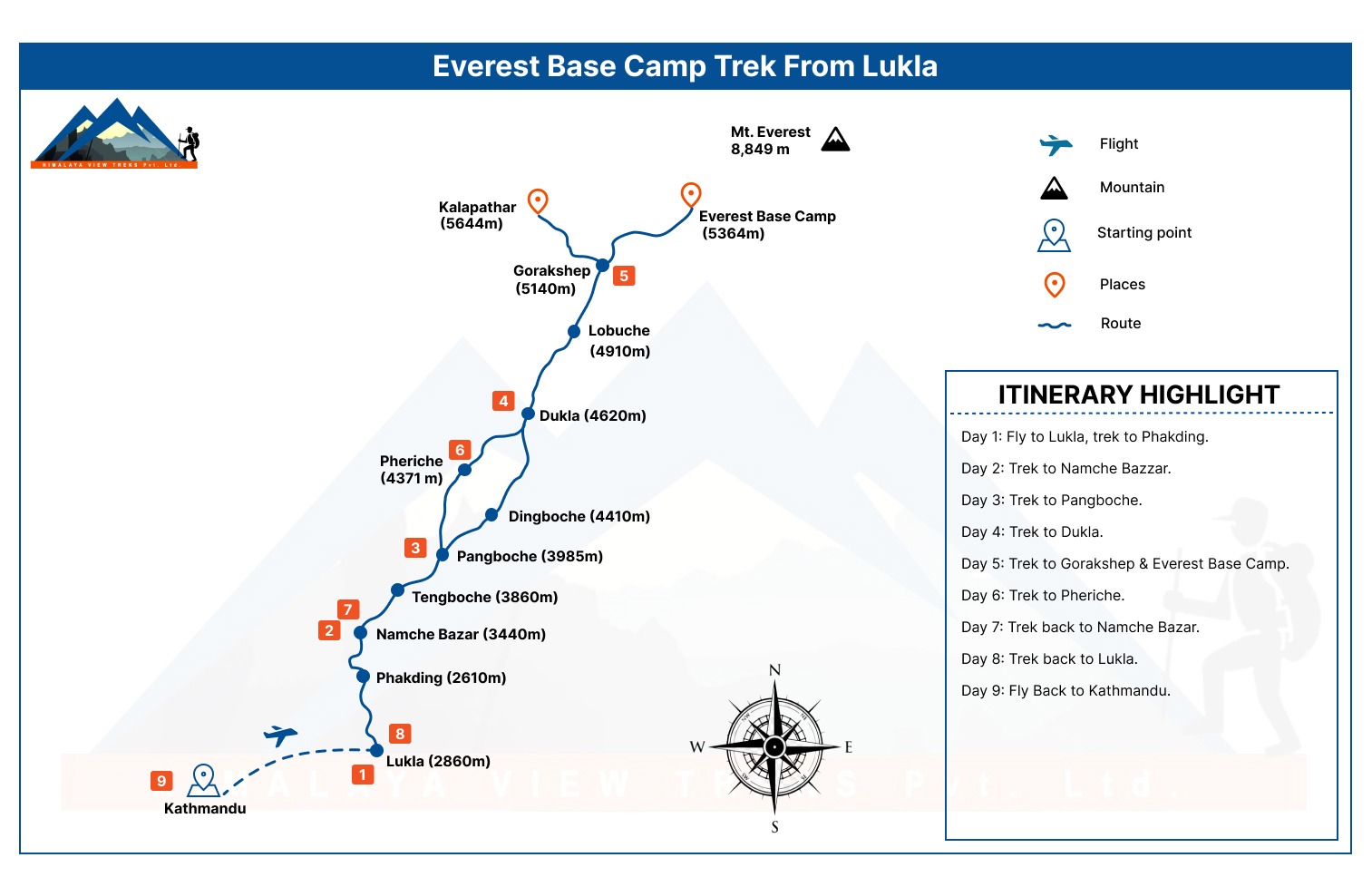
The weather forecast says rain/clouds/snow in Lukla on our Flight Day. Are we in for a rough flight?
When you are up on the mountains in Nepal, we would suggest you be ready for anything. You’re about to trek on some of the most rugged territory on earth, despite its extraordinary beauty. Weather forecasts for Lukla are never correct and different sources will give you different information. If it is a really bad day in terms of weather, the airlines will themselves cancel the flight and you might have to wait till the weather clears. Yes, flying in high altitude is never easy, even on a clear sunny day; the plane might face turbulence because of the wind blowing from the mountains. But overall the flight to Lukla is very exciting and it’s an experience that you will never forget.
What temperatures can you expect at the EBC during spring and autumn?
These are the best months to do this trek, as the weather is mild and the temperatures range from 12 to 15 degrees. The skies generally remain clear and the days are pleasant and warm. You can expect an occasional spring shower and hazy weather during spring. The mountain views are stunning in September, as there is more snow on the mountains. Nights can be freezing as the temperature dips after sun down.
How much do you reckon I will need to spend on the trail per day?
If you have booked a package with us you won’t be spending much as accommodation and 3 meals are already included in your trip price. You may have to personally pay for items like beverages and drinks, extra snacks, hot showers, electronic device charging, wifi etc. USD 20 to 30 (NRS 2000-3000) per day will be more than enough you may need to spend in a day.
What do you recommend for water along the Everest trek?
You can either buy bottled mineral water or fill up a reusable water bottle with boiled or sterilized water. During the trek, the teahouses or lodges serve you bottled and filtered water which is generally safe and has to be paid for. A liter of water would cost anything between 1 to 4 USD. As you go higher the cost of all commodities, including water, increases. But do note there is no dearth or scarcity of drinking water at teahouses. We encourage our guest to use iodine and other purifying agents to treat the water before drinking. You need to drink at least 3-4 liters of water each day to stay hydrated at higher altitudes. Keeping your body hydrated helps you to keep away the symptoms of altitude sickness. Please note, the company doesn’t provide drinking water or any extra drinks or beverages other than the ones that are specified in the trip cost.
How much tips should I give to the guide, porter and driver?
While tipping is not mandatory it is a nice way of showing your appreciation to the people who have helped you enrich your holiday experience. It all depends on how far you are pleased and satisfied with their services. There is no fixed amount, but many of our clients offer 8-10 percent of the total tour price as tips.
Is it hard to climb Everest Base Camp?
You need to be in good shape and have an ability to walk 6–7 hours uphill and downhill per day. This trek is suitable for passionate trekkers. Positive attitude, excellent health, and strong determination are required for be successful on a trip of this kind. Past hiking experience would be an asset but no technical skill is required for this trip. Besides, it is advisable to trek with a highly reputed trek operator who knows what it’s like in this part of the world, with experienced guides who can help you with significant mental preparation to keep you going all the way, as tough as it gets. Regarding the difficulty, the only challenging factor is the altitude. Our Everest Base Camp trek itinerary provides ample time for acclimatization. Neither ropes nor ice picks are needed for this trip and no vertical climbs are involved. Greenhorns in good physical shape, who exercise regularly, has positive attitude and has healthy heart and lungs can easily complete this adventurous trip.
How long do we stay at Everest Base Camp? Can we spend the night at the Base Camp?
As Everest Base Camp is situated at a high altitude of 5,364 metres, you spend only 1 to 2 hours at the camp. Since the base camp lies at the foot of the world’s tallest mountain Mount Everest, the hike to EBC is probably the highlight of your trek. Though one cannot view the summit of Mount Everest from the base camp (as the mountain is too huge) you can get close up views of the massive walls of Everest, Khumbutse, Lingtren and Nuptse. The Khumbu Icefall appears spectacular. Though the icefall lies close to the Base Camp, it is not possible to explore it as you need proper climbing gear to walk on it. But you get to explore the actual base camp of the Everest expedition groups. During climbing season, it is like a mini city of tents and you get to meet mountaineers (sometimes celebrities too!) from different countries attempting to summit Mount Everest. After taking pictures and soaking in the magnificent views you descend down to Gorak Shep again. Please do note the visibility of mountains depends on the weather. If it’s foggy you may not get good views of the mountains. No, we do not spend the night at Everest Base Camp as there are no teahouses or lodges there. Moreover it is advisable and more comfortable to spend the night at a lower elevation. After enjoying the views we trek down to Gorak Shep and stay overnight at a local teahouse.
Can you see the summit of Mount Everest from Everest Base Camp?
No, the summit of Mount Everest is not visible from Everest Base Camp. Rising above 8000 metres, the mountain is just too gigantic to be viewed in its entirety from its base. The summit of Everest can be viewed from Kalapathar and from places en route to EBC. If you want to view Mount Everest without having to trek to Everest region, you can do it by driving to Nagarkot, taking an Everest Mountain Flight and an Everest Base Camp Helicopter Tour. The best views you get of Mount Everest is from Kalapathar. It leaves you breathless, virtually!
What sort of toilet facilities will be available on the Everest Trek?
In all our Everest Treks the teahouses that we use have western toilets. In luxury lodges and teahouses in the lower elevations the rooms come with attached bathrooms and hot showers. At higher elevations the facilities may be a bit basic and you may have to share the bathroom with other travellers. Please do note that in case of extreme cold, the water in the toilet basin may freeze and you may have to use an Asian (also known as ‘squat’) style of toilet that is located outside. Please do carry toilet paper rolls with you at all times. It is important that you carry enough rolls of toilet paper and hand sanitizers while trekking. Can I make payment with my credit card or with my cash while Everest trekking? You need to have local currency to purchase items on the trail. While Lukla and Namche in the Everest Region may have lodges that would accept payment with cards, we strongly advise to carry enough local cash with you to buy essential items en route. You can exchange your currency at any of the money exchange centres in Kathmandu or use your credit or debit card at the local ATMs to get local currency.
Where can I store my extra luggage while trekking?
You can store it at your hotel (most hotels in Kathmandu have storage facilities) or you can leave it at our office.
Is there WIFI available on the Everest Base Camp trail?
Yes, wifi hotspots are available on the Everest Base Camp trail. But please do keep in mind, due to the mountainous terrain the network maybe erratic sometimes. Often times the signal gets lost or the strength is poor.
Trips Reviews
Leave a Review Cancel reply
Your email address will not be published. Required fields are marked *
Save my name, email, and website in this browser for the next time I comment.
Customer's Reviews On

Quick Enquiry

We are associated with

© Copyright 2024 Trekking To Everest - All Right Reserved.
Dave's Travel Pages
Greek Island Hopping | Greece Travel Ideas | Bicycle Touring
Lukla to Everest Base Camp Trek – An Insider’s Guide
The trek from Lukla to Everest Base Camp takes between 11 and 14 days depending on weather conditions and rest days needed. This insider's guide to Everest Base Camp treks has everything you need to know about planning this epic adventure!
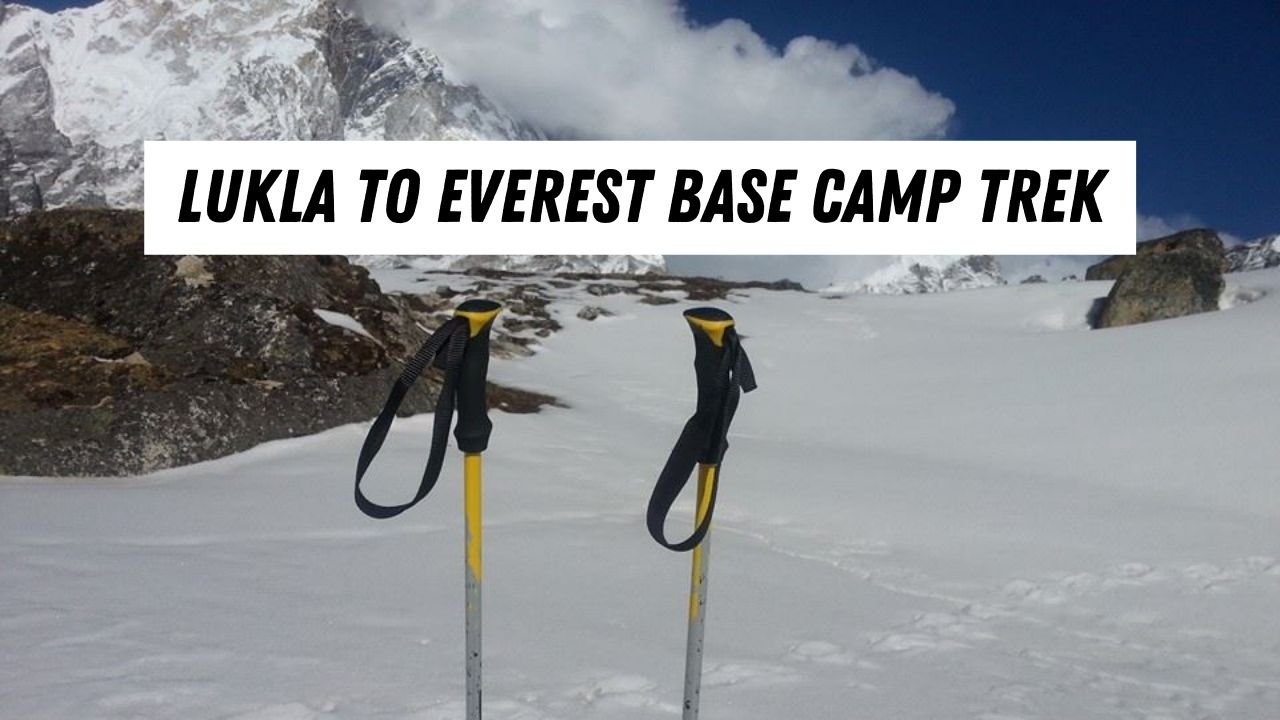
Trekking from Lukla to the world's tallest mountain – Mount Everest – is an adventure of a lifetime! There's a lot of thing you need to know before you go, and so Saugat Adhikari, a seasoned hiker from Nepal and co-founder of a travel company in Kathmandu, shares some inside tips and advice which may prove to be invaluable in your travel planning.
Lukla to Mount Everest Trek
by Saugat Adhikari
I’m an avid trekker and have trekked most of the routes in Nepal and several areas of other countries. But one of my favorite treks is the epic adventure of the Everest Base Camp Trek (EBC Trek often known as the Mount Everest base camp trek) which starts from the high altitude airport at Lukla, situated in the Khumbu Region, as the Everest Region is called by the local residents, the Sherpas.
You may be familiar with this trek through the name ‘Everest’ – the highest mountain in the world. Unfortunately, I haven’t climbed those 8,848 meters above sea level to the top of the world – and I expect most of you reading this will also not be fortunate enough to summit the world’s highest peak. But for almost all of us, it is possible to reach the foot of the magnificent mountain at base camp. Which takes you above an impressive 5,000 meters into the Himalayas.
On route, you will experience the exhilarating flight into Lukla airport, also known as the Tenzing Hillary Airport (and known as one of the most dangerous airports!), visit Sherpa villages, meet the inhabitants of these mountains, and view the rugged, spiritual beauty of this region. And of course, you will be almost close enough to touch Mount Everest!
Make no mistake though, in this rocky terrain one has to go at a slow pace in order to trek safely and reach Everest Base Camp successfully. Sometimes people ask me “how far is the trek from Lukla to Everest Base Camp?” Well in Nepal we do not measure distance by miles, but rather by time. In the case of the trek to Everest Base Camp (also known as the EBC Trek), that is days. Read on!
Lukla Kathmandu Lukla Flight
More often than not this is a very early flight. But, if you are like me, the excitement of the Everest Base Camp Trek makes up for the early morning wake-up call.
And the excitement starts right here! Situated at 9,337ft/ 2,846m flying into Lukla, with its very short runway, is an experience you won’t forget – ever!
On the downside – the weather needs to be perfect for this flight and flights are frequently canceled. Because of this trekking in this region is not done during the monsoon season. And for this reason, I suggest you build in 3 or 4 contingency days before planning your post-trek itinerary. Particularly if you are heading straight for an international flight.
Interestingly you are allowed 10kg of baggage and 5kg of carry-on weight. But I really recommend you pack way lighter than that! Remember someone has to carry your luggage! Of course, there will be a porter and you will be only carrying a day pack, containing water, a camera, daily essentials, a first aid kit, and wearing your, already pre-loved hiking boots. Your companions for the entire trek.
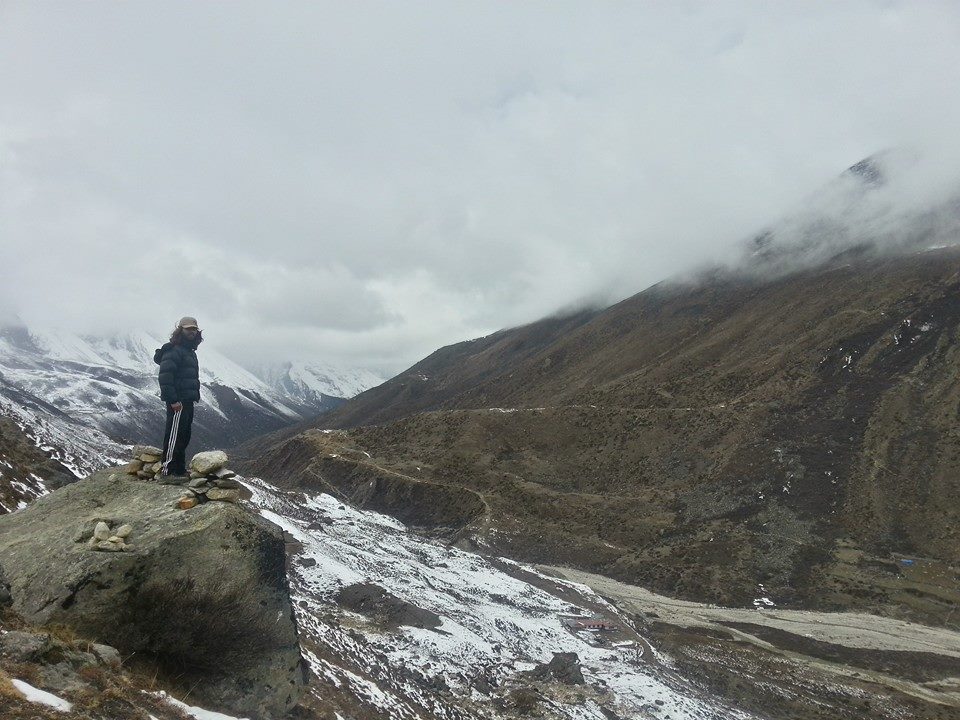
Permits for the Trek
For this trek, you need two permits, as requested by the Nepal Government, namely
Sagarmatha National Park Permit: NPR 3,000 or roughly USD 30
Khumbu Pasang Lhamu Rural Municipality Entrance Permit (a local government fee): NPR 2,000 or roughly USD 20
But what happens if you don’t have time to get the permits before leaving Kathmandu for the Everest Base Camp Trek? Don’t worry, you can now buy both permits on the trail itself.
Photographs are not needed to obtain the permits. TIMS (Trekkers' Information Management System) permits are no longer necessary for the Everest Region. Saves a lot of time and headache!
Best Time to do the Everest Base Camp Trek
I’m often asked when is the best time to do the Lukla to Everest Base Camp Trek. While there are two main ‘trekking’ seasons, I like the winter as there are fewer crowds and you can enjoy the serenity of the region without any distractions from other groups of trekkers. But wrap up warmly, it will be extremely cold.
However, the most popular times and the peak season to visit Everest Base Camp are:
Spring : March to May (May is also the main climbing season for the highest mountain in the world.)
Autumn : September to December (which is post-monsoon)
And of course, comparing experiences on the trails and making new friends in the lodges are a very big part of the overall experience for many people. The best time to meet new friends is in the busy season.
Read: Best time to visit Nepal
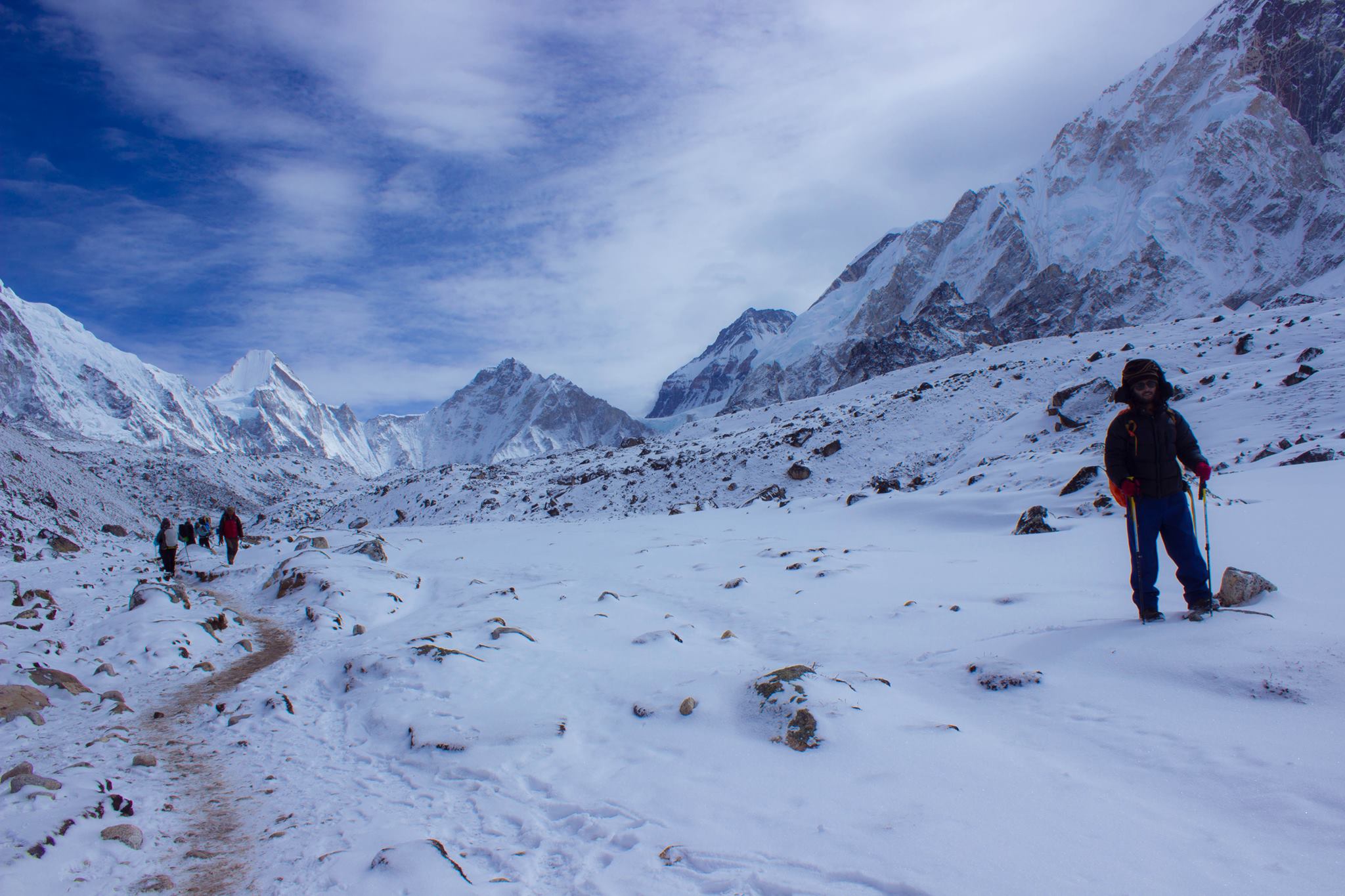
How Much Does it Cost to do the Everest Base Camp Trek?
The cost will depend on how you do the trek.
The cost of the flight is fixed – unless you want to add weeks to your journey and walk all the way from Kathmandu like the mountaineers of old! (Personally, I do not recommend it!) Airfare – $170 one way.
You can do this trek individually or with a trekking company.
With a trekking company or tour operator :
it will cost you approximately USD 1,200 to USD 2,500 with a local Nepali company. With an international company, it will cost you approximately USD 3,000 to USD 6,000.
Individually:
I do not advise you to trek independently unless you have considerable previous hiking experience. This should never be your first trek experience solo.
Remember this is the Himalayas and a slight error could cost you dearly, even if you follow the recommended rules, take a rest day or two and obey the laws of the gradual climb. Accidents do happen. But of course for minor injuries on your packing list should be a first aid kit. If you do decide to go alone, research via a good blog post or complete guide first.
For those who do wish to trek individually in the Everest Region, it will cost approximately USD 35 per day. I have broken this down to give you an idea of where your money will go
- Cost of food per meal: USD 5 to 6
- Cost of non-alcoholic drinks: USD 2 to 5*
- Cost of alcoholic drinks: USD 6 to 10
- Cost of accommodation: USD 5 to USD 150 (from tea houses to luxury lodge)
- Cost of a hot shower (yes you have to pay – it’s expensive to carry gas or firewood to the region): USD 4
- Cost of battery charge (again, electricity is limited, some will use solar): USD 2 to USD 6 for a full charge.
To save money, I recommend you carry your own solar charger or power bank for your phone. You can also reduce expenditure (and save the environment). Do you really need hot showers every day? Save even more by not drinking alcohol! It is not recommended to drink at high altitude anyway, but who can resist one or two evenings of good cheer around the fireplace.
*while food is included with an organized trek, alcoholic drinks will incur an extra cost.
Related: International Travel Packing Checklist
Trek Itinerary
It’s always a good idea to have an idea of what to expect on a day-by-day basis when trekking. So here is my breakdown of the Lukla to Everest Base Camp Trek.
Day 1 Kathmandu to Lukla by flight then trek to Phakding
To access the Everest Base Camp Trek it takes around 40 minutes to fly from Kathmandu to Lukla, then another 3 or 4 hours to trek to Phakding, the first overnight stop.
Please note, there have been some changes to regulations and so it is probable you will fly from Manthali Airport, around 4 hours from Kathmandu. That flight takes around 20 minutes but unfortunately, trekkers need to leave Kathmandu in the very early hours of the morning to catch the morning weather window.
In Lukla, the trekking trail takes us to Phakding. Although only 3 or 4 hours trek from Lukla, with the very early morning start from Kathmandu, that is enough walking on Day 1 for most people!
Day 2 Phakding to Namche
On day 2 the trail reaches the entrance to Sagarmatha National Park. It is here I feel I am really entering Sherpa territory, particularly as I’m trekking through traditional villages and yak pastures. Namche Bazaar is the largest village in this region, inhabited by those hardy Sherpas, and is the starting point for mountaineering expeditions.
Day 3 Acclimatization Day in Namche
Since Namche lies at almost 3,500m and the elevation gain only gets more from here, everyone must acclimatize to avoid altitude sickness. This is a great opportunity to head over to Everest View Hotel where there are great views of Everest! You can also visit the school set up by Sir Edmund Hillary which still educates Sherpa children today. And don’t forget to shop for any last-minute (snack) items before heading into the wilderness. Chocolate is always on my list!
Day 4 Namche to Tengboche
This is one of my favorite days – a day to take stunning photographs, and perhaps do some personal meditation and reflection. Tengboche is home to the highest Buddhist monastery in the region where you can meet some monks. Definitely, you will get great views of the surrounding mountains. The trek itself takes 5 to 6 hours passed Buddhist mani (prayer) walls and under prayer flags.
Day 5 Tengboche to Dingboche
It takes four to five hours of challenging walking to get to Dingboche – the highest Sherpa settlement in the region. Thankfully we reach in time for lunch and the rest of the day is spent relaxing under the gaze of Mount Ama Dablam and other surrounding peaks.
Day 6 Acclimatization Day in Dingboche
While trekkers acclimatize at this (relatively) lower altitude, (it is always wise to use caution and follow the recommendation not to climb high too fast to avoid altitude sickness) there are short hikes that can be enjoyed and which help acclimatize to the higher altitudes yet to come. My personal recommendation is a trip to the base of Nagkar Tshang Peak which takes 3.5 to 5 hours for a round trip. This is a sacred site with good views of Mt Makalu, the fifth highest mountain in the world (8,485m/ 27,838ft).
Day 7 Dingboche to Lobuche
Four to five hours of trekking = a paradise for photographers and nature lovers alike! This day takes me across a valley floor, through alpine scrub and yak pastures, and up through Thokla Pass, which is a bit challenging. There are great views of Ama Dablam and panoramic views of several peaks over 7,000m. And while its true Lobuche is not the most picturesque settlement, the surrounding scenery is extremely dramatic!
Day 8 Lobuche to Gorakshep (Afternoon hike to Kalapatthar)
While this trek is called the Everest Base Camp Trek, for my money, the most exciting part of the hike is that to Kalapatthar. From here (5,545m) the views of Everest are the best possible – much more clear than at Everest Base Camp. And this is the highest point we can trek to in Nepal without getting a climbing permit. Kalapatthar is actually a ridge and provides the best views of the world’s highest mountain! Overall the trail takes 6 or 7 hours to cover.
Day 9 Gorakshep to Pheriche (morning hike to EBC)
Again today’s hike takes 7 or 8 hours. I would like to point out here that the Everest Base Camp on this trek is not exactly the one where mountaineering expeditions set up camp.
The reason behind this is not to disturb the climbers as they prepare for their arduous climb and which may slow them down. But there is a great view of the comings and goings of their preparation from our own base camp, particularly in the busy climbing season.
The Khumbu Glacier is also spectacular in its icy beauty. After visiting Everest Base Camp the trek heads to Pheriche (4 hours away) where there is the Himalayan Rescue Association Clinic. Nice to visit but no one wants to have to call them out on a rescue mission!
Day 10 Pheriche to Namche
Leaving behind the rugged landscape of the mountains, forests, and greenery return as we get closer to Namche Bazaar. This is a hard 6 or 7 hours walk and definitely an evening to allow yourself that alcoholic drink or two! Wi-Fi is also available, which means I can let people know I have finished the trek and am on the way back to Kathmandu.
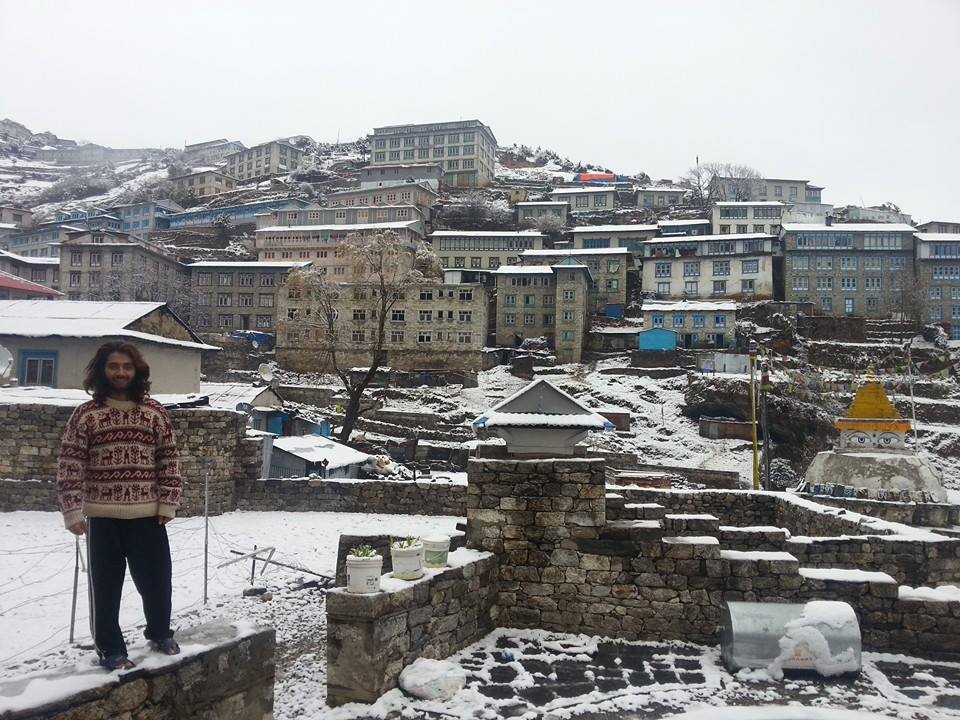
Day 11 Namche to Lukla
This is a sad day – heading on out of Namche and down to Lukla where it is necessary to overnight in order to make the early morning flight on to Kathmandu. Until the next time Mt Everest!
Accommodation on the Everest Base Camp Trek
The world is your oyster (sometimes) as far as accommodation on this trek is concerned. For the budget-conscious, there is lots of accommodation at the lower end of the price scale. Even for as little as USD 5 per night in some guest houses or tea houses.
If you prefer something more comfortable, there is the Everest View Hotel between Namche Bazaar and Tengboche (which I recommend you visit even for just a cup of coffee as the views are spectacular from here). Other comfortable hotels, mainly found at lower altitudes, include the Yeti Mountain Home group of hotels at Phakding and Lukla.
Lukla Hotels
- Yeti Mountain Home, Lukla Lukla
- Lama Hotel, Lama's Rooftop Cafe Lukla
- Lukla Airport Resort Lukla Chaurikharka
As far as availability is concerned, accommodation at Lukla can become difficult if (or more likely, when) flights are delayed and there are many trekkers waiting in Lukla and seeking rooms. In Namche Bazaar there are around 50 rooms to suit every budget.
As you can imagine, it gets pretty busy here in the peak seasons as it is the jumping-off spot for many expeditions and treks. In other towns, accommodation is on the simpler side and sometimes more difficult to obtain.
For example, at Tengboche, there are only a handful of hotels and with people wanting to attend morning prayers (thus having to stay overnight beforehand) it might be better to trek downhill to Deboche, only 15 minutes away.
If you are going on an organized Everest Base Camp Trek you shouldn’t have to worry about accommodation as the company will do that for you. If trekking individually, be prepared to have to share with another trekker or sleep in the dining room if it's busy or flights are delayed. It simply adds to the experience!
Regardless of whether going with one of the many trekking companies or going independently, a sleeping bag is handy. In even the most comfortable of hotels you might be glad for just a little more warmth!
Food on the Mountain
I think you will be surprised at how tasty and varied the food is on the Everest Base Camp Trek. You may also be surprised at how hungry you are while hiking for hours every day. This is where stocking up on easy-to-carry and eat snacks at Kathmandu or Namche Bazaar comes in handy!
Meantime breakfast at all lodges, guest houses, and hotels along the route take on a similarity. Porridge, noodles, bread, and a hot drink such as tea and coffee. For your evening meal, you might be surprised by a whole menu of Western and Nepali items from pizza (with yak cheese) and soups to curry and rice.
Dal Bhat Power 24 Hour!
Lunches are mostly taken at a tea house along the trail and are somewhat more simple. Dal Bhat (a Nepali staple) will feature heavily. Each cook (or household) prepares it a little differently so it’s never boring.
I would suggest you avoid meat on the menu as most places above Namche do not have fridges and so you never can be too sure how fresh the meat is. To stay healthy on any trek is the number one way to enjoy your trip!
Regarding the price – above I have said to budget between USD 5 to 6 per meal. That is for the basics only. Remember that most items have to be brought in from Lukla airport via porter or yak. If you want to add a dessert to your evening meal, that will cost you more! Note there are bakeries at Lukla, Namche and Tenboche. Particularly nice on the way back from base camp and a change from Dal Bhat and porridge!
Over all, it’s up to you how much you want to spend on food on the Everest Base Camp Trek. Alcoholic drinks are extremely expensive as they are brought in by yak and porter!
In Conclusion: Is Trekking to Everest Base Camp Worth it?
In a word – yes. The Everest Base Camp Trek is well worth the effort!
And as I said, the Everest Base Camp Trek is one of my favorite trekking routes and the best trekking experience. Seeing the highest mountain – Mount Everest – in the world is truly awesome!
Don’t forget there are many other treks around the Everest Region. This is just the most popular and normal route. Other trails also include a trek to Everest Base camp, all of which involve awesome scenery, snow, and ice. And equally as awesome Sherpa hospitality.
Related: Snow quotes for Instagram
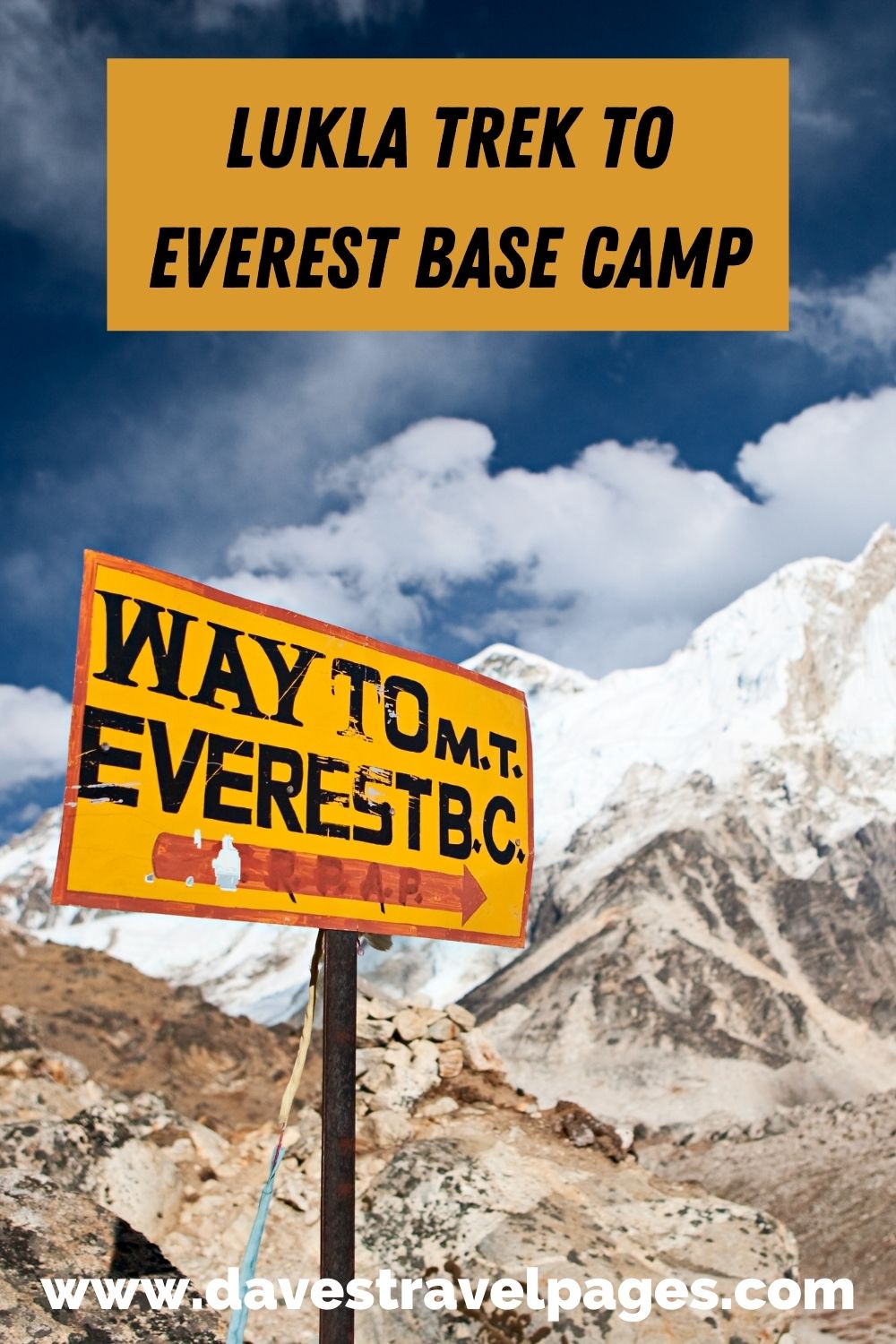
Lukla trek to Everest Base Camp FAQ
Some of the most frequently asked questions readers have about the EBC hike include:
How long is the trek from Lukla to Everest Base Camp?
While the distance from Lukla to base Camp at Everest is about 38.5 miles or 62 kilometers one-way, it is better to think of the trek in terms of the days needed which can vary between 11 and 14 days depending on circumstances.
How far is the walk from Lukla airport to Everest?
The walk from Lukla airport to Everest Base Camp is about 38.5 miles or 62 kilometers one-way.
How much does it cost to trek to Everest Base Camp?
International tour companies charge somewhere between 2000 and 3000 USD for the experience, which normally includes flights. A local company will probably charge half that amount.
Is trekking to Everest Base Camp worth it?
The trek to Everest Base Camp is definitely worth it if you're looking for an adventure. The views along the way are stunning, and you'll get to see Mount Everest up close. Plus, the experience of trekking in the Himalayas is unforgettable.
You might also want to read:
How to Stay Comfortable and Warm Sleeping Outdoors
50 Trekking Quotes To Inspire You To Enjoy The Great Outdoors
50 Best Hiking Quotes To Inspire You To Get Outdoors!
Over 200 Of The Best Mountain Instagram Captions You’ll Find Anywhere
200 + Camping Captions For Instagram
Leave a Comment Cancel reply
+977 9841319155
Lukla to Everest Base Camp – A Complete Guide
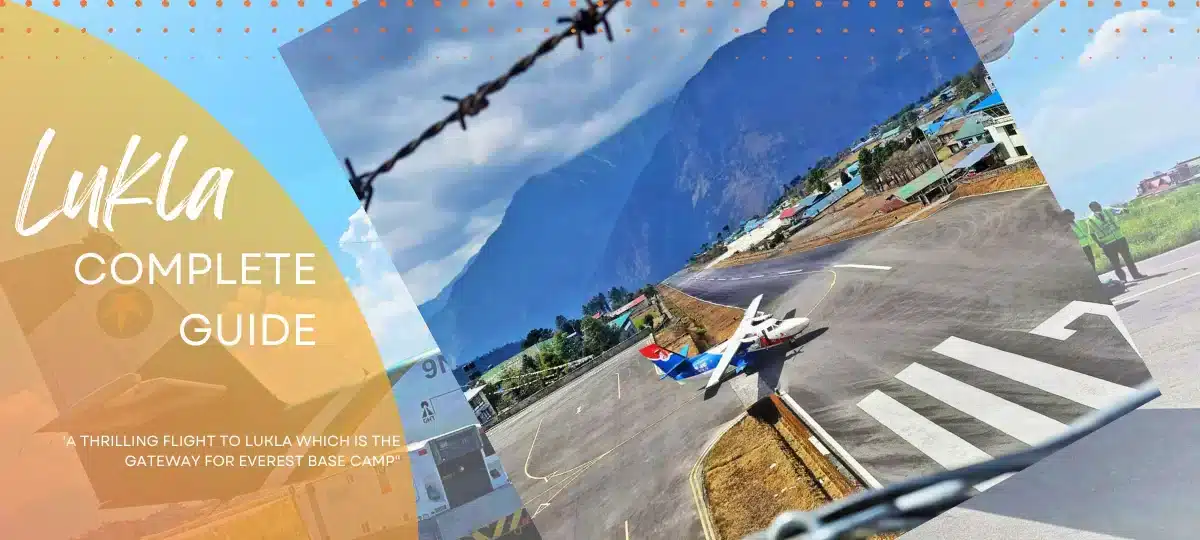
It wouldn’t be wrong to say that the Everest Base Camp is a special treat to all the hikers and adventure seekers gifted by mother nature. It is an iconic destination located in the Khumbu region of Nepal. Considered to be the highest base camp in the world at 5,364m above sea level, the Everest Base Camp trek is a full-packed adventure tour.
The Everest trek takes you through a series of diverse geography from the lush green forests of oaks, pines, and juniper in lower elevations to the rocky and desert terrains in the higher altitudes. Throughout the whole trekking trail you will be accompanied by the stunning Himalayas. The pleasure you get in doing the EBC trek is absolutely immeasurable.
The journey to the EBC starts with the short 30 mins flight from Kathmandu to Lukla to Everest Base Camp.
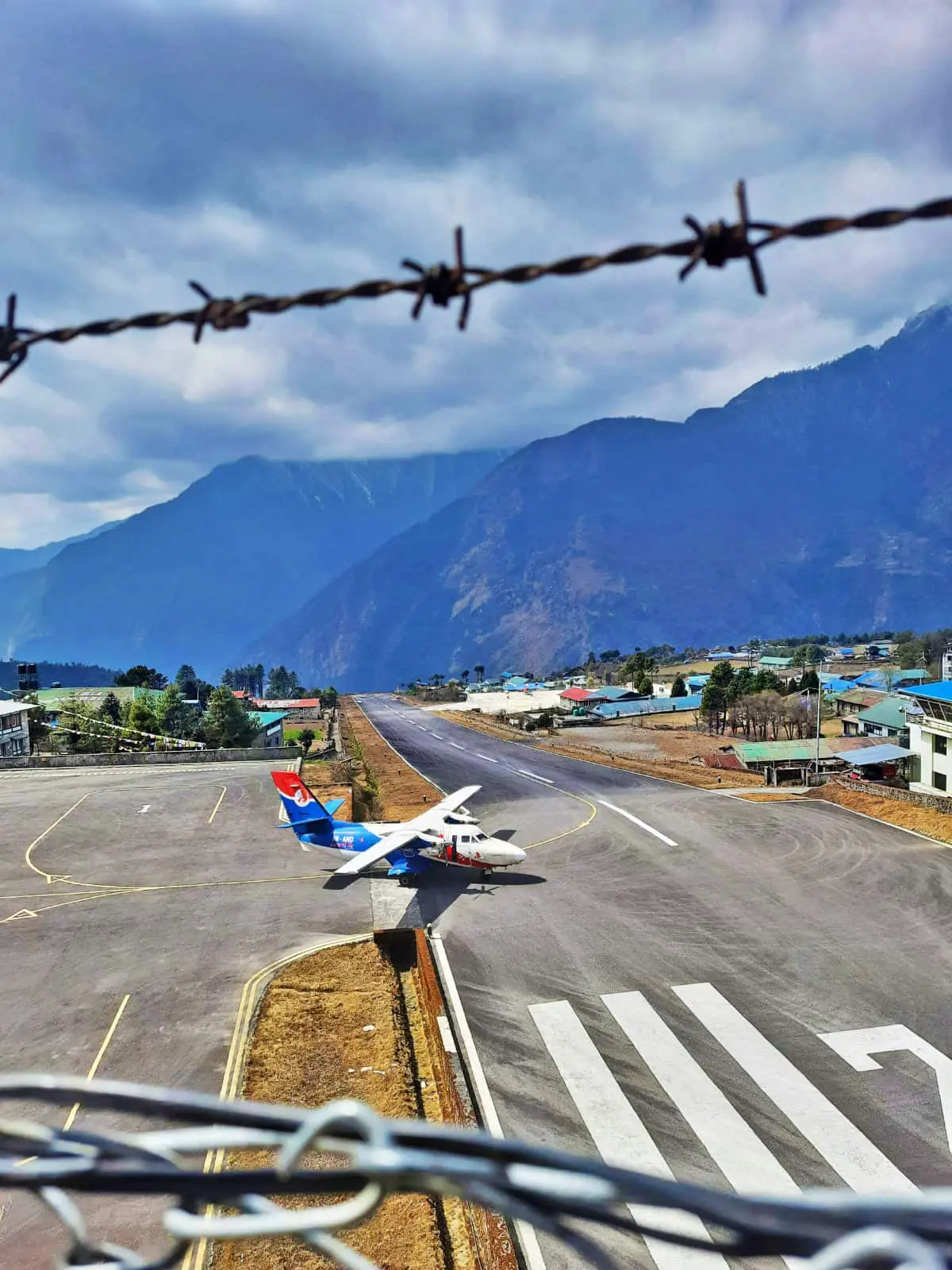
How to start your trek from Lukla to Everest Base Camp?
Starting your trek from Lukla to Everest Base Camp is a popular route for many trekkers.
Firstly, you have to get to Lukla from Kathmandu either by taking a Lukla flight or traveling by ground transportation via Salleri. Most trekkers tend to take a Lukla flight which is by far the best way to get to Lukla.
Upon reaching the Lukla your trekking journey officially begins full of energy and expectations that lie ahead. Generally, the standard Lukla to Everest Base Camp trek requires 12 days of the walking itinerary which will be provided below.
From Lukla, on your first day, you will trek to Phakding, a major stop-place for all the trekkers. It is 3-4 hours of pleasant walking from Lukla village for the first day of the trek. Further, the trek then continues to take you through numerous Sherpa settlements onwards (Namche, Tyangboche, Pangboche, Dingboche). The heartwarming hospitality of the Sherpa and locals, stunning landscapes, flora, and fauna among many others will steal your heart over and over again.
Following the route, after approximately 10-12 days of trekking, you will reach the long-awaited destination Everest Base Camp. Such a proud and exciting moment to stand at the world’s highest base camp. Live the moment, take photos, and just enjoy.
Gorakshep will be the last stop on this lifetime trekking experience from Lukla to Everest Base Camp and back. On this entire journey, you will ascend to a max altitude of 5,545m above sea level at Kalapatthar, a huge achievement to be mentioned.
Multiple days of hiking and walking at such a higher altitude in the Nepal Himalayas will be worth the time and hard-earn money.
Also, check our “Everything To Know About Lukla Flight”
What is the trekking distance from Lukla to Everest Base Camp?
The trekking distance from Lukla to Everest Base Camp covers a total distance of approximately 130km -65km each way. However, the distance varies depending on the specific route taken and any side treks are done.
Also, the distance covered on each day varies too. The first phase of hiking to EBC requires a daily average walking hour of 5-7 hours whereas returning back adds an additional extra hour.
Make yourself comfortable during the trek by walking at a slower pace and hydrating your body. It is also essential to keep your body acclimatize properly at such higher altitudes.
How many days of the trek from Lukla to Everest Base Camp?
Basically, it takes 12 days of total duration trek from Lukla to Everest Base Camp including the two days of acclimatization in between. Here’s the standard outline itinerary.
- Day 1: Fly from Kathmandu to Lukla (2,860m) and trek to Phakding (2,610m)
- Day 2 : Trek from Phakding to Namche Bazaar (3,440m)
- Day 3 : Rest day in Namche Bazaar for acclimatization
- Day 4 : Trek from Namche Bazaar to Tengboche (3,860m)
- Day 5: Trek from Tengboche to Dingboche (4,410m)
- Day 6 : Rest day in Dingboche for acclimatization
- Day 7: Trek from Dingboche to Lobuche (4,910m)
- Day 8 : Trek from Lobuche to Gorak Shep (5,140m) and visit Everest Base Camp (5,364m) and back to Gorakshep
- Day 9: Hike to Kala Patthar (5,545m) for sunrise views of Mount Everest, then descend to Pheriche (4,240m)
- Day 10: Trek from Pheriche to Namche Bazaar
- Day 11: Trek from Namche Bazaar to Lukla
- Day 12: Fly from Lukla to Kathmandu
Before leaving for the trek, make sure that you have all the necessary equipment, documents, and Everest Base Camp Trek Insurance with you.
What should I expect on the Everest Base Camp trail?
Nothing more than an absolute adventure. The whole journey completes on rugged trails with varied terrains from lush forests and rivers to rocky terrain and steep inclines. Crossing the suspension bridges over the raging rivers and encountering the yaks and horses will be something very common to you.
As the trail passes through several Sherpa settlements, you will experience the unique culture and traditions of the local Sherpa people. Their warm and welcoming atmosphere makes the trek more memorable and fun.
Also, you’ll visit the oldest Tyangboche monastery, and several other rhumbas, chortens, and prayer flags along the way.
Additionally, the EBC trail offers breathtaking views of the stunning mountains including Mount Everest, Lhotse, Nuptse, and Ama Dablam among many others. You’ll also see beautiful glaciers, rivers, and valleys.
You will find teahouses at every major stop that provides trekkers with basic accommodations and meals.
Plan Your Trek!
Your email address will not be published. Required fields are marked *
Nepal Peak Adventure
Nepal Peak Adventure stands as a premier trekking and travel agency dedicated to curating exceptional and memorable journeys in the heart of the Himalayas.

Trekking & Climbing
- Everest Region
- Annapurna Region
- Langtang Region
- Manaslu Region
- Dolpo Region
- Short Treks
- Beginner's Level Climbing
- Intermediate Level Climbing
- Challening Level Climbing
- Legal Documents
- Trekking Guides
- Climbing Guides
- Celebration
Bhagwan Bahal Street, Thamel, Kathmandu- Nepal
What’s App: +977 9841319155
+(977) 9841319155

- Terms & Conditions
- Privacy Policy
Govt. Regd. No: 27161/060/61
Whatsapp +977 9841353904.

Everest Base Camp Trek - 16 Days
The Everest Base Camp trek is one of the most popular treks in the world, and for good reason. It offers stunning Himalayan scenery, a chance to experience Sherpa culture, and the opportunity to stand at the foot of the world's highest mountain, Mount Everest.
Mount Everest has two base camps, the South Face Base Camp in Nepal and the North Face Base Camp in Tibet (China). The South Face Base Camp (on the Nepalese side) is more popular for trekking and hiking holidays. Known as the route followed by the famous climbers Sir Edmund Hillary and Tenzing Norgay Sherpa, the Everest Region has become a popular destination for adventure tourism since famous climbers have trekked through it.
Everest Base Camp Trekking is an unforgettable journey that will leave you with lasting memories. Reaching the base (5,364 meters) of Mount Everest is an incredible feat, and climbing Kala Patthar (5,545 meters) adds an extra level of awe and beauty to the experience.
The panoramic views of the surrounding peaks, including Mount Everest, from Kala Patthar are truly breathtaking. Watching the sunrise and sunset over the mountains from this viewpoint is a highlight of the trek and shouldn't be missed. Many trekkers consider it an essential part of their Everest Base Camp trekking.
Everest Base Camp Trek Difficulty
The Everest Base Camp Trek is considered a moderately difficult to challenging trek due to its high altitude and the stamina required for long daily hikes. The trek covers a total distance of approximately 130 kilometers (80 miles). Depending on the itinerary, you can expect to walk for 6 to 7 hours per day on average.
It is important to have a good level of physical fitness and strength to hike up and down hills and endure long hours of walking. Additionally, proper altitude acclimatization is crucial to ensure a safe and enjoyable trek. This involves gradually ascending to higher altitudes and allowing your body time to adapt to the reduced oxygen levels. Adequate rest days and steady progression in altitude are typically built into the trek's itinerary to facilitate acclimatization.
Having a knowledgeable guide or joining a reputable trekking company is recommended to ensure you have good guidance throughout the trek. They will provide important information, help you navigate the route, and assist with any challenges that may arise during the journey. It's essential to be prepared physically, mentally, and logistically to make the most of this incredible adventure.
Route – Trekking from Lukla to Everest Base Camp
The Everest Base Camp trek usually begins with a flight from either Kathmandu or Ramechhap to Lukla. Lukla Airport is a small mountain airstrip located to the south of Sagarmatha National Park. It is the usual starting point for trekkers embarking on the Everest Base Camp trek.
During peak trekking seasons, flights to Lukla are more likely to operate from Ramechhap due to high air traffic at Kathmandu Airport. The drive from Kathmandu to Ramechhap (Manthali Airport) takes around 4–5 hours, covering a distance of approximately 135 kilometers.
Sagarmatha (Nepalese name of Everest) National Park is home to diverse flora and fauna. It was established in 1976 and designated as a Natural World Heritage Site by UNESCO in 1979. The park boasts a remarkable level of biological diversity and is part of the highest and youngest mountain system in the world.
The trek from Lukla to Everest Base Camp is a popular route, and as a result, it has become somewhat congested and overdeveloped in recent years. However, it still offers incredible opportunities to immerse yourself in the local culture and experience the natural beauty of the region.
The trek from Lukla follows the Dudh Koshi valley, passing through small Sherpa villages, dense forests, ancient Buddhist monasteries, and stunning alpine landscapes. Along the way, you'll have the chance to interact with the local Sherpa community, learn about their traditions and way of life in the high Himalayas.
The trek route involves a gradual ascent each day, with some sections being steep. Therefore, it is important to be well-prepared physically and mentally to reach your goal of reaching Everest Base Camp and Kala Patthar. Adequate preparation and acclimatization are key to ensuring a safe and enjoyable trekking experience.
After visiting Everest Base Camp and Kala Patthar, you will retrace your steps back to Lukla to complete the trek. The return journey is mainly downhill, making it a little faster compared to the ascent. Upon arriving in Lukla, you will take a short domestic flight back to either Kathmandu or Ramechhap airport. From there, you will have a comfortable drive back to the center of Kathmandu, allowing for a smooth transition from the trekking experience to the bustling city.
Overall, the Everest Base Camp trek offers a balanced mix of air travel and road trips, providing a pleasant end to your trekking adventure before returning to the comforts of your hotel in Kathmandu.
16 days Everest Base Camp Trek includes 11 days trekking (12 days from Kathmandu), one day sightseeing and one day rest in Kathmandu, two days for arrival and departure from Kathmandu.
Customizing the trip itinerary and package
We can definitely customize the trip itinerary and package according to your preferences. Regarding the hotel in Kathmandu, you have the option to book it yourself, or we can assist you in finding suitable accommodation based on your requirements.
If you prefer not to hire a porter and carry the luggage yourself, that is certainly possible. However, please note that for full board trekking packages, a guide is mandatory for safety and logistical reasons.
Please let us know your specific preferences and any other details you would like to include in your itinerary, and we will be happy to assist you further in creating a personalized trip package.
Everest Base Camp Trek Highlights
- Embark on a journey to the foot of the mighty Mt. Everest — Everest Base Camp.
- Captivating aerial views of the Himalayas on the way to Lukla.
- Immerse yourself in the vibrant culture and traditions of the Sherpa community.
- Experience diverse flora and fauna, forests, Himalayan tahr, pheasants and perhaps even the elusive snow leopard.
- Namche Bazaar is the entrance and cultural hub of the Everest region.
- Magnificent view of the mountain range from the high-altitude luxury hotel — Hotel Everest View.
- The serene atmosphere inside the enchanting Tengboche monastery.
- Get a glimpse of the Khumbu glacier and Khumbu icefall.
- Picturesque hike to Kala Patthar to watch the stunning sunrise over the mountains.
- Spectacular views of Mt. Everest, Ama Dablam, Lhotse, Nuptse, Thamserku and many more.
- Staying in teahouses along the route offers the opportunity to socialize with other hikers, swap stories and enjoy the local cuisine.
Everest Base Camp Trek Cost
The cost of the Everest Base Camp (EBC) trekking package depends on various factors. These include the duration of the trek, the size of the group (Larger groups might be able to negotiate better rates, while solo trekkers or small groups may pay a premium for personalized services), the level of services included (budget, standard, luxury) and the reputation and standard of the trekking company you choose.
The Alpine Adventure Club announces the cost and some fixed departure dates for the Everest Base Camp Trek for groups joining in 2024 and 2025, the cost includes the standard service. If you wish to participate in a private trek, the cost will be different.
Everest Base Camp Trek 16 Days Itinerary
Day 01: Arrive at Kathmandu Airport and transfer to your hotel Day 02: Kathmandu Sightseeing and trek Preparation Day 03: Flight to Lukla trek to Phakding (2,610 m) Day 04: Phakding trek to Namche Bazaar (3,440 m) Day 05: Acclimatization day at Namche Bazaar (3,440 m) Day 06: Namche Bazaar trek to Tengboche (3,867 m) Day 07: Tengboche trek to Dingboche (4,410 m) Day 08: Acclimatization and exploration day at Dingboche (4,410 m) Day 09: Dingboche trek to Lobuche (4,910 m) Day 10: Lobuche trek to Gorak Shep (5,140 m) and visit Everest Base Camp (5,364 m) Day 11: Gorak Shep hike to Kala Patthar (5,545 m) and trek to Pheriche (4,260 m) Day 12: Pheriche trek to Namche Bazaar (3,440 m) Day 13: Namche Bazaar trek to Lukla (2,840 m) Day 14: Flight to Kathmandu (1,350 m) Day 15: Reserve Day in Kathmandu Day 16: Depart Kathmandu
- Private Trek Price
- Price Includes/Excludes
- Details Itinerary
- Group Joining
- Tailor Made Holiday
Destination: Nepal Trekking Region: Everest Trek Start Point: Lukla Trek End Point: Lukla Trekking Accommodation: Teahouses / Mountain Lodges Trekking Grade : Medium-Hard Best Season: March - June / September-November Max Elevation: 5,545 meters Duration: 16 Days
The price of a private trek can fluctuate due to several factors, such as the trekking agency selected, the trek's duration, the group size, the level of services desired, and the preferred category of accommodation (deluxe, standard, or budget) in the city and during the trek, the choice between normal (simple) teahouses or the best available teahouses can also impact the overall price. Therefore, it is recommended that you click here: Price request form and fill in the required information and submit the same to get the exact price of your preferred trek and service.
PRICE INCLUDES:-
- Airport pick up and airport drop by private transportation including before and after the trek
- Accommodation in Kathmandu with breakfast (2 and above participants get twin sharing room in 3-star standard hotel)
- Historical monument city sightseeing with a tour guide
- Historical monuments city sightseeing transportation by Non A/C Comfortable Vehicle
- Kathmandu sightseeing/monument visits Entrance fees
- Domestic air tickets from Kathmandu to Lukla, Lukla to Kathmandu for guests and guide
- Trekking accommodation in normal Trekkers Lodge/Teahouse (2 and above participants get twin sharing room)
- Three time meals a day during the trekking Breakfast, Lunch and Dinner/Main course
- Dessert (Fresh Fruits/Chocolate) after dinner on behalf of the company
- One Experienced English-speaking, government licensed and ministry of tourism trained trekking guide and his food, accommodation, and salary
- Porters from Lukla to carry your luggage while trekking (Two guests get one porter carrying a maximum of 25 kg of luggage)
- Everest / Sagarmatha National park entry fee
- Khumbu Pasang Lhamu Rural Municipality entry fee
- Insurance for Nepalese staff (Trekking guide and Porters)
- Nepal Government taxes and office service charge
PRICE EXCLUDES:-
- Lunch and Dinner during the stay in Kathmandu
- Extra night accommodation in Kathmandu because of early arrival, late departure, early return from mountain (due to any reason) than the scheduled itinerary
- International air tickets and airport taxes
- Nepal visa fee
- Personal trekking equipment and Clothing
- Wire Transfer charge or Credit card service charge as company rule
- Alcoholic beverages, laundry, Telephone calls and all types of hot drinks in Trekking
- Soft drinks such as cola, mineral water etc
- Hot water, battery charge and hot shower charge during the trek (If need to pay)
- Personal nature expenses and Tipping (Tips)
- High risk medical / travel insurance and First aid kit
- Expenses resulting from delays beyond our control in case of weather, flight cancellations, or natural calamities
- Emergency rescue evacuation (if needed)
- Any other things not mentioned
Day 01: Arrive at Kathmandu airport and transfer to Hotel Arrive at Tribhuvan International Airport in Kathmandu, Nepal. Transfer to your hotel and a short travel briefing will be given at the hotel/office, and you will be requested to pay the travel dues. Overnight in Kathmandu. Day 02: Kathmandu Sightseeing and trek Preparation After breakfast, Kathmandu visits Durbar Square, Pashupatinath Temple, Swayambhunath Stupa, and Boudhanath Stupa which are all World Heritage Sites. Durbar Square throws light on the life of the royals in ancient times. Pashupatinath Temple is one of the most important pilgrimage places for all Hindus. Swayambhunath is also known as Monkey Temple and Boudhanath Stupa is one of the largest stupas in the world. Late in the afternoon, we introduced you to your mountain/trek guide. overnight in Kathmandu. Day 03: Kathmandu flight to Lukla and trek to Phakding (2,610 m) Your guide arrives early in the morning to pick you up and drive you to the domestic airport. You will take a short and scenic flight from Kathmandu to Lukla, where the trek begins. From Lukla, you will trek to Phakding, a small village located at an altitude of 2,610 meters. The trail offers beautiful views of the Dudh Koshi River. Overnight at Phakding. Day 04: Phakding trek to Namche Bazaar (3,440 m) You will continue trekking along the Dudh Koshi River and cross several suspension bridges. After a challenging climb, you will reach Namche Bazaar, the main trading center of the Khumbu region. Overnight at Namche Bazaar. Day 05: Acclimatization in Namche Bazaar (3,440 m) This day is reserved for acclimatization to the high altitude. You will take a short hike to higher elevations and then return to Namche Bazaar for rest and exploration. You can visit the local market, museums, and monasteries. Overnight at Namche Bazaar Day 06: Namche Bazaar trek to Tengboche (3,867 m) The trail leads you through beautiful forests and offers stunning views of the Himalayas. You will reach Tengboche, a village famous for its monastery, which provides a panoramic view of Everest, Ama Dablam, and other peaks. Overnight at Tengboche. Day 07: Tengboche trek to Dingboche (4,410 m) The trek continues through rhododendron forests and open valleys. You will cross the Imja Khola River and ascend to Dingboche, a picturesque village with stone-walled fields and great views of the surrounding mountains. Overnight at Dingboche. Day 08: Acclimatization in Dingboche (4,410 m) Another acclimatization day is scheduled in Dingboche to help your body adjust to the increasing altitude. You can hike to Nangkartshang Peak (5083 m) locally known as Nagarjun Hill for breathtaking views of Makalu, Lhotse, and other peaks. Overnight at Dingboche. Day 09: Dingboche trek to Lobuche (4,930 m) The trail ascends gradually as you pass through Dughla (Thokla) and then climb up to Lobuche. The landscape becomes more rugged and barren, providing a sense of being in the high Himalayas. Overnight at Lobuche. Day 10: Lobuche trek to Gorak Shep (5,140 m) and visit Everest Base Camp (5,364 m) Trek to Gorak Shep, the last settlement before Everest Base Camp. After a short rest, hike to Everest Base Camp where climbers gather for their ascent to the summit, and soak in the incredible surroundings. Return to Gorak Shep for overnight stay. Overnight at Gorak Shep. Day 11: Gorakshep hike to Kala Patthar (5,545 m) and trek to Pheriche (4,260 m) Early in the morning, you will hike to Kala Patthar, the highest point of the trek, to witness the sunrise over Mount Everest. Afterward, you will descend to Pheriche, passing through Lobuche. Overnight at Pheriche. Day 12: Pheriche trek to Namche Bazaar (3,440 m) The trail descends through forests and crosses several suspension bridges over the Dudh Koshi River. You will retrace your steps back to Namche Bazaar, enjoying the familiar surroundings. Overnight at Namche Bazaar. Day 13: Namche Bazaar trek to Lukla (2,840 m) You will continue descending, passing through Phakding, until you reach Lukla. This is your final day of trekking, and you can celebrate the completion of your journey with your fellow trekkers. Overnight at Lukla. Day 14: Lukla Fly to Kathmandu (1,350 m) You will take a scenic flight from Lukla to Kathmandu, where you can rest, relax, and reflect on your incredible adventure. Overnight in Kathmandu. Day 15: Reserve Day in Kathmandu Lukla gets occasional flight delays during the main season. This may cause missing your international flights as well, so we recommend you to prepare accordingly. Lukla suffers from quick weather changes and that may affect inbound and outbound flights. We reserved this day for possible flight delays. If we have a timely flight on DAY 03 or 14, we can use this day for rest in Kathmandu. You can shop around local markets and walk around the city. Overnight at Hotel. Day 16: Depart Kathmandu or extend your trip We will drop you at the airport by our private vehicle according to your airport time. It is recommended to reach the airport at least two hours prior to departure.
Join Our Scheduled Departures at a Group Price !
If above trip itinerary that doesn't suit to your holiday schedule or you wish to modify the itinerary or combines with any travel plans, then please let us know and we'll be happy to create a tailor made itinerary, designed and departure the trip any date that suitable to your holiday schedule especially for you. Please Tailor Made Request Form for tailor made trip.
Choose Everest Trekking


- Trek map of Lukla to Everest Base Camp
Lukla to Everest Base Camp Trekking Route Map for the Year 2023 & 2024 with 15 days Guided Trek Itinerary at Inclusive price US dollar 1499 per person
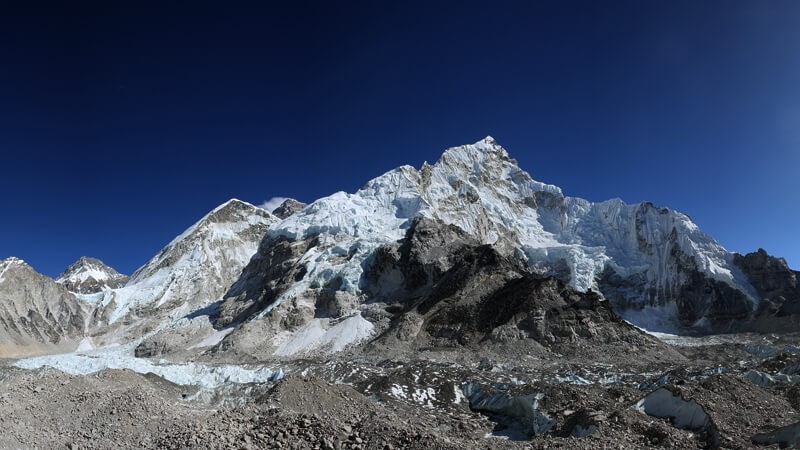
Everest Base Camp Trip Fact
Trip Duration in Nepal: 15 Days
Trekking Walking Duration: 12 Days
Mode of Trip : Guided Hiking Trekking Tours for 2022 and 2023 with Experienced Local Sherpa Guide
Destination : Everest Base camp & Kalapather
Maximum Altitude : 5545M
Best Time to Trek : March to May and October /November
Trip Starting Point: Kathmandu
Trip Ending Point : Kathmandu
Trek Walking start Point: Lukla
Trek walking Ending Point: Lukla
The trekking route in the Everest region in the Himalayas is the highest trek routes in the world. Here we present Mount Everest Base Camp Trek Route Map, Cost, and Tips for going on a trek to the Everest region. This also presents a different situation in which one has to be well prepared. Any trekker has to prepare oneself for high-altitude walking since this is a high-altitude trek route with a low Oxygen level. The many obstacles faced during the hike to the Base Camp is what makes the trek more adventurous
Highlights of the Everest Base Camp Trek
- Stand at the base of Mt Everest in awe of its majesty and size.
- Witness the sun setting over Everest from Kalapatthar, known as the Everest viewpoint.
- Fly into the high altitude Hilary Tenzing Airport at Lukla, an experience in itself.
- Visit Sherpa villages with their Tibetan like peoples and yak herders.
- Stay in Namche Bazaar, the starting point for all Everest expeditions.
- Visit Tengboche Monastery with its strong spiritual connection and the surrounding panorama of mountains –what views!
- Be stunned by the chilling beauty of the Khumbu Glacier and Khumbu Icefalls.
- Use the essential acclimatization days to learn something of the lifestyle of the Sherpas.
- Pass through Sagarmatha National Park with its unique flora and fauna.
- Follow the footsteps of Sir Edmund Hillary and many other famous mountaineers.
- Simply absorb the atmosphere of the Khumbu Valley and recognise the power of ‘Goddess Mother of Mountains’ (English translation of Chomolungma, Tibetan for Everest)
Click For more Everest Base Camp Trekking Package's Itinerary And Price
Nepal Everest Himalaya Hiking - A Nepal Trekking Company is Female Sherpa Trekking Guide Owned and Operated Registered Trekking Organizer Company based in Nepal & Official member of Trekking Agencies' Association of Nepal (TAAN) that works together for woman empowerment providing employment opportunities to female trekking guide to make their better life in Himalaya. We team of experienced Sherpa Guides from Everest Himalaya are dedicated in providing with you Best Trekking for the year 2023 and 2024. Copyright ©2023- Nepal Everest Himalaya Hiking -A Nepal Trekking Company

- Classic EBC Trek
- EBC + Gokyo Trek
- Jiri to EBC
- 3 Passes Trek to EBC
- Island Peak and EBC
- Acclimatisation
- Packing List
- Get a Trek Quote
Everest Base Camp Trek Distance, Length and Elevation
The Everest Base Camp Trek is the most popular trek in the Nepal region and one of the most iconic and well-known treks in the world.
After a nerve-racking flight into Lukla airport that is sure to get you pumped up, you will retrace the footsteps of Sir Edmund Hillary, Tenzing Norgay and the countless other brave men and women who have summited Everest after them.
The route takes you through the beautiful Sagarmatha National Park and eventually ends up at Everest Base Camp, where you will feel the buzz and excitement of potential summiteers of the world’s tallest mountain (the main climbing season kicks off in April and culminates in the 3rd or 4th week of May).
Popular questions asked about the Everest Base Camp Trek always seems to follow the similar pattern of ‘how hard?’, ‘how long?’ and ‘how high?’.
This article will cover the raw data behind the trek to answer all those burning question about distance, length and elevation.
To get a better understanding of how challenging the trek is, read our in-depth article on the difficulty of the Everest Base Camp Trek .
[adinserter block=”2″]
The classic Everest Base Camp trek from Lukla to EBC and back is 130km long – 65km each way – which may sound like a lot of trekking!
Fear not, because the typical round trip to Everest Base Camp takes around 12 days, the actual distance you will be covering each day will be about 15km – a much more reasonable and achievable number.
Furthermore, the average walking pace is about 5km/hour, so 15km per day does not sound too bad anymore.
Obviously, you will not be trekking at that pace because of the rocky terrain, gradual ascent and high altitude gains that have to be made.
The point being made is that the distance is very attainable for all people of all ages, shapes and sizes!
If you book through a tour operator , you will likely have the luxury of having your large bags carried for you by porters or by yak / mules. This should further take the strain off your body and allow you to focus on getting yourself safely up and back down the trail.
[adinserter block=”3″]
The typical length, in terms of time, of the Everest Base Camp trek is around 12 days. There are variations of standard route, like Jiri to Everest Base Camp and Gokyo Lakes trek , which take longer.
The outward route from Lukla to Everest Base Camp is significantly longer, in terms of time, than the return route to allow for proper acclimatization and to minimize the risks of Acute Mountain Sickness and related illnesses.
It should take around 9 days of trekking to reach base camp and just 3 days to return to Lukla.
To get a better idea of the distances and day-by-day break down of the typical Everest Base Camp Trek we have posted a sample itinerary below:
- Day 1: Arrive in Kathmandu where you will spend the night.
- Day 2: Fly from Kathmandu to Lukla, then walk to Phakding – 9 km (4 hours)
- Day 3: Trek from Phakding to Namchee Bazaar – 12 km (6 hours)
- Day 4: Acclimatization day. No walking except maybe a quick hike up to the Everest View Hotel.
- Day 5: Trek from Namchee Bazaar to Tengboche – 10 km (6 hours)
- Day 6: Hike from Tengboche to Dingboche – 12 km (6 hours)
- Day 7: Acclimatization day in Dingboche. Explore the area.
- Day 8: Trek from Dingboche to Lobuche – 12 km (7 hours)
- Day 9: Hike from Lobuche to Gorak Shep to EBC and back to Gorak Shep – 15 km (8 hours)
- Day 10: Hike from Gorak Shep up Kala Pathar and then to Pheriche – 13 km (7 hours)
- Day 11: Trek from Pheriche back to Namchee Bazaar – 14 km (8 hours)
- Day 12: Hike from Namchee Bazaar to the airstrip at Lukla – 15 km (8 hours)
- Day 13: Fly back to Kathmandu
- Day 14: Leave Kathmandu
[adinserter block=”4″]
The most challenging element of the trek is probably elevation . Even at the start of the trek at Lukla airport you will be at an altitude of over 2,600m. As most people’s bodies are not used to these altitudes, the trek involves acclimatization days and the ascent to Everest Base Camp will occur at a much slower pace than the descent to allow for acclimatization and to ensure safety.
Typical elevation gains will be in the range of 400-800m each day. Days when the gain is large and the altitude is significantly high will usually be followed by an acclimatization day that doubles up as time for some sightseeing and exploration of the surrounding areas.
Here is an Everest Base Camp trek elevation and altitude profile for the standard trek.
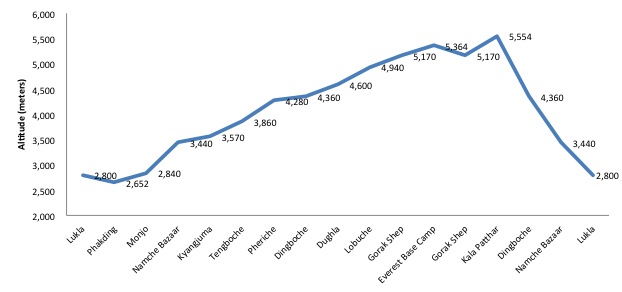
The highest point on most Everest Base Camp Treks tends to be the Kala Patthar viewing point where you will be blessed with some of the best views of Everest and the nearby peaks. Kala Patthar stands at just over 5500m, but not too much time is spent at that altitude as the trek then descends back down to Pheriche and eventually back to Lukla Airport.
Hopefully these facts and figures have convinced you set out on your own trek to Everest Base Camp – if so, happy trekking!
Tags: Everest Base Camp Trek Distance, How long is the Everest Base Camp Trek? Length of the Everest Base Camp trek, Everest Base Camp trek altitude, Everest Base Camp Trek elevation
Mark Whitman
Hi, I'm Mark! Welcome to EBC Trek Guide - the Web's No.1 Trekking Guide to Everest Base Camp. I have trekked all over Nepal, but the Everest region remains my favourite. I hope you find all the answers you are looking for on this site. If you have any questions don't hesitate to drop a comment below! Happy Trekking!
Leave a Reply
Your email address will not be published. Required fields are marked
Really useful post to reflect the daily walking distance , gain elevation and length of track regarding EBC treks thanks for sharing
Hi Mark, just wondering if Island Peak (in November) is do-able for my son who will be 17 years old. We’re both pretty fit but we don’t have any climbing experience. I did EBC in 2014. Cheers.
Hi Anthony, thanks for getting in touch. It is possible to climb Island Peak in November. The hike to Island Peak usually includes a visit to EBC before to help with acclimatisation. The climb itself is a real challenge and not for the faint-hearted. I would highly recommend doing some winter mountaineering courses before embarking on the adventure. You will need to be comfortable using crampons, crossing a glacier with ladder crevasse sections and ascending a tough headwall with a fixed rope jumar. You can read more about Island Peak here: https://www.mountainiq.com/guides/trekking-in-nepal/routes/island-peak/
Thanks Mark, your info was very helpful = )
Thanks for info. It needs to write per day max hgt of destination
on the clair ridge oil platform we climb 17km per day.8.5 up and 8.5 down….how many times do we climb the equivolent of everest per week ?
Hi Donald, I’m not sure the answer to your question. I would estimate that on the average day on the EBC trek, you gain about 800-1500m in altitude and lose about 400-800m. The average elevation gain is about 400-800m per day. Hope this helps.
Hellow ! My name is Jaak, my friends name is Andras and we are from Estonia. We wish to make a little trek, max 10-11 days for max alt. 5500/5600m and to stay overnight 5000+ meters few nights. It mast be an acclimatization trek, because my friend are going to K2 summit expedition in july. My friend have gone earlier on Mount Everest summit .Could You please think about it and say, is it possible to organize trek like this between 08.05 – 21.05. We do not need a guide service and accomondation can be easy. Thanks in adavance, Jaak and Andras
Hi Jaak, we are not a tour oeprator so unfortunately we cannot help organise your trek. For a tour operator recommendation go here: https://ebctrekguide.com/go
Looking over the Everest Trek itinerary (which is similar to other organized Everest treks), it seems a little ambitious for the uninitiated. What I mean (and I’ve done the trek independently as well as extensive mountain climbing and backpacking in the Cdn. Rockies) is that while each day’s trek is reasonable, the day-after-day grind will wear down some people. I would recommend anyone attempting this pace first do some multi-day backpacking in the mountains to see how he or she reacts to what is a fairly relentless pace. A Stairmaster is a poor substitute. Also, people who’ve not trekked high up (above 12,000 feet) should know that altitude brings new challenges.
I love to try EBC from Lukla
please tell distance between first base camp to everest summit
Hi Murali, the distance from EBC on the south side (Nepal side) to the summit is approx. 20 kilometres. The altitude gain is nearly 3,300 meters though.
Thanks for all the information… Inshalah I will be there on the last August
Hi, I would like to do EBC on my own since having a porter or a guide with me all the time does not work for me. I am wondering how safe it is to hike alone for a female. I am also wondering if getting accommodation can be a problem if you dont book in advance. Finally, is the path well marked. Many thanks!
Hi, it is possible to trek solo and if you go during the high seasons (March-May or September-November) then there will be quite a few people on the trail. Getting accommodation each day should not be a problem but you might not get your pick of teahouses. Generally porters run ahead of trekkers to secure the best teahouses. The standard EBC path is not well marked but maps of the region are very detailed and easy to follow. All the best!
I am Ram and 40 year old i would like to know more about Everest trekking , i would like to do and what is the process
Hi Ram, I recommend browsing our site – it provides all the information you need. Start here: https://ebctrekguide.com/
Why is there so little time spent at EBC?
Hi Laurie, There are a few reasons why the time at EBC is limited. Firstly, trekkers cannot actually get all the way into the camp. The stop point is just before the camp, and there isn’t a huge amount to see. 10-20 minutes there is more than enough. Secondly, EBC is a good two hour hike from the last tea house at Gorak Shep. So to hike there and back means hanging around EBC is not recommended. Finally, the best views of Everest, the surrounding mountains and EBC is from Kala Pattar, which is right next to Gorak Shep and if you move fast can be hiked on the same day that you visit EBC. Hope this helps!
I’m planning to trek solo in December – January. I read is the low season, with probably a lot of snow. You consider this dangerous? Which equipment would you consider? Your info it’s very clear thank you very much!
Hi Mariano, yes, there is more snow in December. As long as you are trekking the standard route to EBC there is no additional danger. If you plan to cross some big passes, like those on the Gokyo route or Three Passes Trek, I would caution against that. Most passes will be closed in December anyway. In terms of gear, here is what you need: https://ebctrekguide.com/everest-base-camp-trek-packing-list
Thank you for sharing all this information in your blog . Very useful information, it opened my eyes to things i wasn’t aware about. Great way to start preparing for next years climb
Thanks Ebby!
Thanks for the info Mark, helps a lot. Planning to do the trek in December. Would appreciate any pointers to make it comfortable as I am told the Climate is extremely cold.
Hey Ismail, yes, December is pretty cold. Make sure to bring a four season sleeping bag and warm winter jacket / gloves / beanie etc. Layers will be important too, check out our packing list for advice: https://ebctrekguide.com/everest-base-camp-trek-packing-list
Hi, we are a family of 4 and interested in doing EBC in July 2019. Wanted to check what the minimum age is. My two sons are 12 and 10 years old and are physically fit. Thanks
Hi Jeet, there is no official minimum age for the EBC trek, although I wouldn’t take a child younger than 10. In terms of timings I would avoid July – this is the middle of the monsoon season and a terrible time to trek. The best time to go is either Feb-May or Sept-November. Hope this helps.
My other is a smoker and we would like to trek to EBC. Please give her some words of wisdom from your experience with smoking trekkers.
Hi William, words of wisdom… stop smoking. No in all seriousness, one can trek to EBC and smoke but I wouldn’t recommend it. If at all possible, I would encourage your ‘other’ to abstain from smoking, especially on the upper reaches of the trek.
Hello we are 3 friends and want to do EBC, want to know the formalities. Preferable date is 23rd march
We are planning to trekk to Everest base camp in next month . What is your advice for me
Hey, little mistakes on the altitude, Lukla is 2850m and the Kala Patthar is 5643m. 😉 btw I recommend to not hire any porter, that’s too easy with them and you won’t have the same satisfaction. I did it by myself without help and I was so proud to carry my bag in front of all this groups of tired people (but with no bags 😉 ) you’re going for a challenge or not ?
can you hire poter and guide at lukla. how is the chance if you trek to phaking and try to get a tea house without prior booking
Yes it is possible to hire a guide / porter in Lukla. If you ask at one of the many teahouses they should be able to assist. In terms of teahouse availability, this varies by season and time you arrive. Ideally it is best to send a porter ahead early in the day to make a booking for you, but generally if you arrive at a reasonable time it is usually possible to find a free room in one of the teahouses.
Great informative stuff, I’m Planning on 4 old guys 60 +62 to EBC In Nov 2020 Let you know how it goes
can I see everest from namchee bazaar?
Technically you need to hike up to the Everest View Hotel which is just above Namche. But it is only a 20 minute walk away so yes you can.
Is it possible to take a helicopter from Lukla to EBC and then hike back to Lukla with a group? I have taken a bus to EBC and that would be an option too. We would be staying the week before at a 10,000' elevation to help with acclimatization. Thanks,. Tom
Hi Thomas, it is possible to get a helicopter to EBC, but it’s pretty expensive and due to the high altitude weight is usually limited to one passenger (maybe two).
How far from base camp 4 to the peak and back?
Hi Albert, just to be clear this website is about hiking to Everest Base Camp, not climbing Mount Everest. But to answer your question, Camp 4 is on Everest is located on the South Col at just over 8000m. It’s about 1-mile climb to the summit and takes about 7-8 hours.
All of these guides have been so helpful! I leave for EBC in a week and have been panic googling to try to be as prepared as possible. Thank you for the info!
Sure thing Megan!
Hi! What clothing do you recommend for doing the EBC trek first couple weeks of November? Thanks!! Great article
Hi Jackie, I recommend checking out this packing list: https://ebctrekguide.com/everest-base-camp-trek-packing-list
very informative mark thank you. i will be doing this in october 2023
Thanks Tony!
Hi Mark, is there scope to buy all the kit you need in Kathmandu as I’m traveling light at the moment. Im in the far east in shorts and flip flops and my gear is back in the uk. If so how much would I be looking at?
Yes, there are loads of gear stores in Thamel.
Very informative, intresting and nicely articulated! Loved it.
Get a quote from the best local trek operator in Nepal!
Get my recommendations on the Best EBC trek operators

Alpha Adventure Treks
Your Perfect Trekking Partner

Lukla To Everest Base Camp Trek

Last Updated on May 3, 2022 by Alpha Adventure Treks
Everest Base Camp Trek from Lukla is one of the world’s most popular mountain treks. Thousands of trekkers visit the Khumbu region in Nepal every year, and visitors come from all over the world to see the world’s highest summit, Mt Everest (8848m), and its adjacent peaks. The region’s natural splendor inspires some incredible pictures, and the views along the trip, as well as at the EBC, are breathtaking. Beautiful, century-old monasteries may be visited, and the walk provides an opportunity to learn about the Sherpa people’s unique culture. A trek from Lukla to Everest Base Camp is a once-in-a-lifetime expedition for individuals whose ambitions soar as high as the clouds that surround the beautiful peak. You can soak your spirit with the natural beauty of the region and stretch your endurance beyond what you believed was possible when you’re miles away from cars, home comforts, and the regular everyday amenities.
Table of Contents
Walking Distance from Lukla to Everest Base Camp:
The distance between Lukla and EBC is 38.58 miles (62.08 kilometers), which takes 7 to 8 days to hike and 3 to 4 days to descend. The overall distance traveled round way from Lukla to Everest base camp is 130 kilometers, although the trek takes 11 to 12 days. You hike 10 to 11 kilometers each day, which is a pleasant amount to walk between Lukla and Everest base camp. There are many aspects about the Lukla to Everest base camp trek that no one tells you about. The Lukla to EBC trip is a thrilling adventure that takes you to one of the Khumbu Valley’s most fascinating trekking sites.
Everest Base Camp Trek from Lukla: Highlights:
- Flying from Kathmandu to Lukla begins this incredible adventure to Everest Base Camp with a thrilling alpine flight above the huge Himalayan range.
- Discover Sherpas’ historically rich culture and immerse yourself in the indigenous way of life.
- Art, architecture, and history abound in centuries-old monasteries.
- The Everest Base Camp journey offers the greatest views in the world, with magnificent peaks visible at all times. The landscape is enhanced by green valleys with lush trees.
- From the peak of Kala Patthar, you can watch the sunrise. The magnificence of the golden hour will take your breath away.
- A chance to see the world’s highest glacier, the Khumbu Glacier.
Best Time for the Everest Base Camp Trek from Lukla:
Spring and autumn are without a doubt the greatest seasons for trekking in Nepal. The same is valid for the Everest Base Camp trek.
The weather is warm in Autumn. It is simple to trek in such situations. The visibility is excellent. As a result, the mountains appear beautiful. Autumn is also a festival season in Nepal. Simply put, the best time to trek to Everest Base Camp is in the autumn. In general, spring is substantially warmer than autumn. Spring is a wonderful time of year because of the abundance of greenery and blooming flowers. There’s a fineness in the air that you won’t find at any other time. Those who dislike the cold should go on a hike in the spring, especially between early May and mid-June.
Everest Base Camp Trek from Lukla: Accommodation:
During the Everest Base Camp trek, hotels range from basic to “luxury.” Luxury lodge options such as Yeti Mountain Home can be found in Namche Bazaar or below. However, as you ascend from Namche Bazar, the accommodations grow more primitive, and your only alternative is to stay in relatively basic teahouses.
Everest Base Camp Trek from Lukla: Brief Itinerary:
Day 1: Take a short flight to Lukla, followed by a trek to Phakding
Day 2: Trek to Namche Bazaar
Day 3: Acclimatization and side trips in Namche
Day 4: Trek to Tyangboche
Day 5: Trek to Dingboche
Day 6: Hike to Nagartsang and back to Dingboche.
Day 7: Trek to Lobuche
Day 8: Arrive at Everest Base Camp and return trek to Gorakshep
Day 9: Hike to Kala Patthar and Pheriche
Day 10: Trek to Namche Bazaar
Day 11: Trek to Lukla
Everest Base Camp Trek from Lukla: Required Permits and Documents:
A couple of permits are required for the trek. It does not, however, require a Trekker’s Information Management System (TIMS) permission, as do other trekking trails.
- Sagarmatha National Park Permit: the permit can be obtained from the Nepal Tourism Board office (Kathmandu) as well as from Monjo (Khumbu)at the entry of the park. It cost NPR 3,000 ($30).
- Khumbu Pasang Lhamu Municipality Entrance Permit: It can be only obtained from Lukla or Monjo. It cost NPR 2,000 ($20) per foreign traveler. It is a substitute for a TIMS card.
Note that following the classic trail from Jiri to Everest base camp necessitates obtaining a separate permit from the Gaurishankar Conservation Area. It’s available at the Nepal Tourism Board office in Kathmandu.
Everest Base Camp Trek from Lukla: FAQ’s:
Everest’s safety concerns are based on a number of factors. Everest Base Camp Trek is, nonetheless, extremely safe in comparison to Everest Climbing. However, because of the high altitude, it still offers some concerns, as stated above.
Basic hiking equipment, such as walking poles, hiking boots (preferably shoes), lightweight t-shirts, hiking pants, a down jacket, sleeping bags, and so on, is usually required.
An interpretative local guide will help you make the most of your stay in the mountains. They’re well-versed in mountain conditions, weather, avalanches, and other potential dangers. They will be enthusiastic about sharing their knowledge of your surroundings in order to keep you safe on the mountain.
You must have travel insurance for Everest Base Camp Trek to protect your investment; it should cover helicopter evacuation and medical repatriation. Despite being a moderate trip, it reaches a height of 5545 meters above sea level. Some trekkers may get high altitude sickness, which can be life-threatening in such circumstances. Trekkers may require helicopter assistance. As a result, having travel insurance can save you money.
The cost of an EBC trek is determined by the trip type, hiking trails, and the trekker’s own actions. However, the most affordable Everest Base Camp Trek costs between $1400 and $1600. This amount can cover all of your food, lodging, guides and porters, permits, and Lukla domestic flights.
Everest Base Camp has harsh weather and temperatures. The temperature in the daylight varies from 20 degrees Celsius in the summer to -5 degrees Celsius in the winter. However, it can go down to -20 degrees in the winter and 4 degrees in the summer at night.
The trek to Everest Base Camp takes between 11 and 14 days’ round trip on average. The majority of people will complete it in 12 days: 8 days hiking from Lukla to Everest Base Camp, followed by 4 days trekking back to Lukla.
The one-way trek from Lukla (9,200 feet) to Mount Everest Base Camp (17,500 feet) is around 38.5 miles (62 kilometers).
Yes, we can see the view of Everest and other surrounding peaks from Lukla.
Feel Free To Contact Us.
Share this:.
- Click to share on Twitter (Opens in new window)
- Click to share on Facebook (Opens in new window)
- Click to share on WhatsApp (Opens in new window)
Related Post
Author: Alpha Adventure Treks
You might want to explore the highest and coolest Himalayas of Nepal, explore Nepali cultures, and visit many beautiful places of Nepal. We are here to make your travel dream come true. There are so many thing you can do in Nepal. You can enroll in trekking, mountaineering, hiking, rafting, and jungle safari. We create best itinerary for our customers according to their travel plans. Our agents are very cooperative and they will contact you beforehand so that you can tell what to include in your travel itinerary. We have highly experienced and very professional team in our Company. They make sure about your safety and other travel things. With us, it will be easy for you to travel to your favorite destination. View all posts by Alpha Adventure Treks

Lukla to Phakding | Everest Base Camp Trek Day 1
By: Author Charles
Posted on May 8, 2023
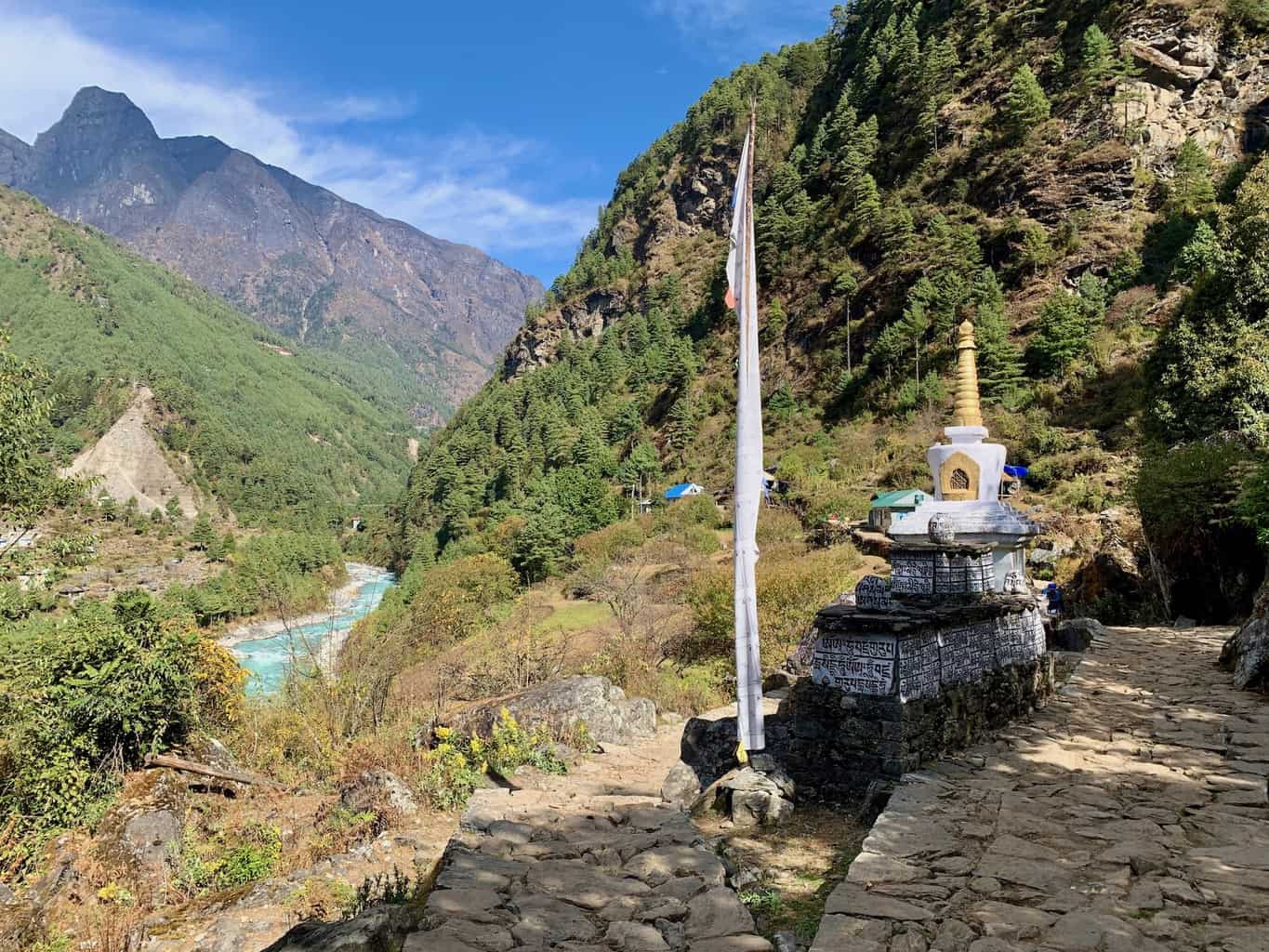
The Everest Base Camp trek is one of the most iconic multi day treks in the world. This 11 day trek from the small town of Lukla to Everest Base Camp and back will have you hiking next to valleys, rivers, villages, mountainsides, glaciers and more.
I am putting together day by day guides for the trek so you will have a better understanding of what to expect on a daily basis and how to best prepare for your time in the Himalayas. The following guide will walk you through the first day of the Everest Base Camp trek.
Out of the 11 day Everest Base Camp trek, this will be your easiest and one of the shortest days of trekking. But it is a perfect way to begin getting used to the altitude and the trail terrain in general. Read on to learn more!
* Affiliate Disclosure : This post may contain affiliate links, which means I may receive a commission if you make a purchase through the links provided, at no additional cost to you. Thanks for supporting the work I put into TripTins!
1) Lukla to Phakding Overview
After flying out from Kathmandu, you will soon arrive at the Tenzing Hillary Airport in the mountain town of Lukla (note that flights sometimes only depart from Ramechhap, a 5-6 hour drive from Kathmandu).
Once you arrive, it is time for your first day of hiking as you make your way from Lukla to Phakding.
Below are some quick stats about the Lukla to Phakding trekking experience:
Everest Base Camp Trek Day 1: Lukla to Phakding
Starting Point : Lukla
Lukla Elevation : 9,318 feet / 2,840 meters
Ending Point : Phakding
Phakding Elevation : 8,563 feet / 2,610 meters
Distance : 5.1 miles / 8.2 kilometers
Duration : 3 hours
Elevation Gain : 909 feet / 277 meters
Net Elevation Gain : -755 feet / -230 meters
» Elevation gain is the true amount of elevation gained for the portion of the trail. Net elevation is just the difference in elevation between Lukla and Phakding.
» Learn more about the day by day distances, elevations, and durations of the Everest Base Camp Trek .
» Read more about the Kathmandu to Lukla Flight experience before heading out
2) Lukla to Phakding Elevation Profile
As you can see, although there will be an elevation loss on the first day (since Phakding is lower than Lukla), you still will still be gaining 909 feet of elevation during day 1 of the trek.
Below is the elevation profile of the Lukla to Phakding hiking trail:
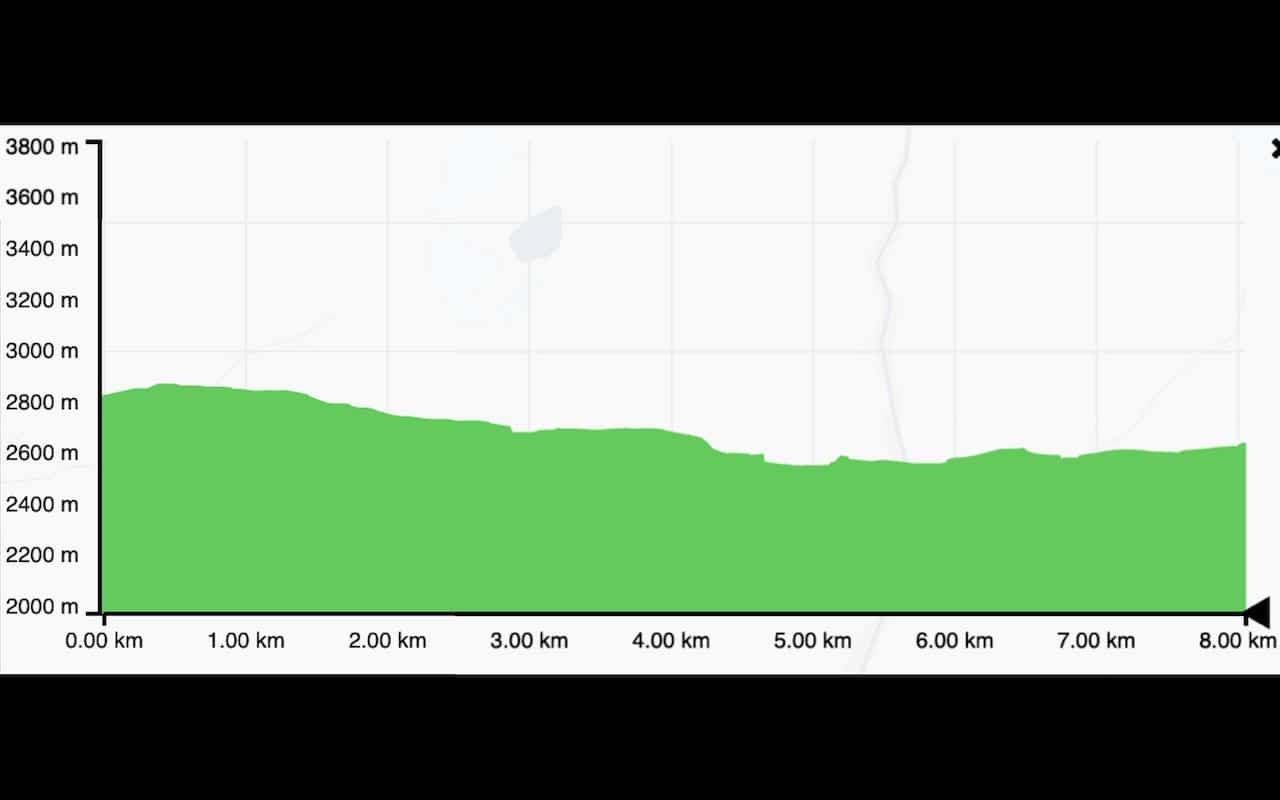
3) Everest Base Camp Trek Day 1 Map
Below is a satellite map view of the route from Lukla to Phakding to give you a bit better idea of what the route will look like.
You will start down below in Lukla before heading into the valley up above and along the river as you make your way to Phakding.
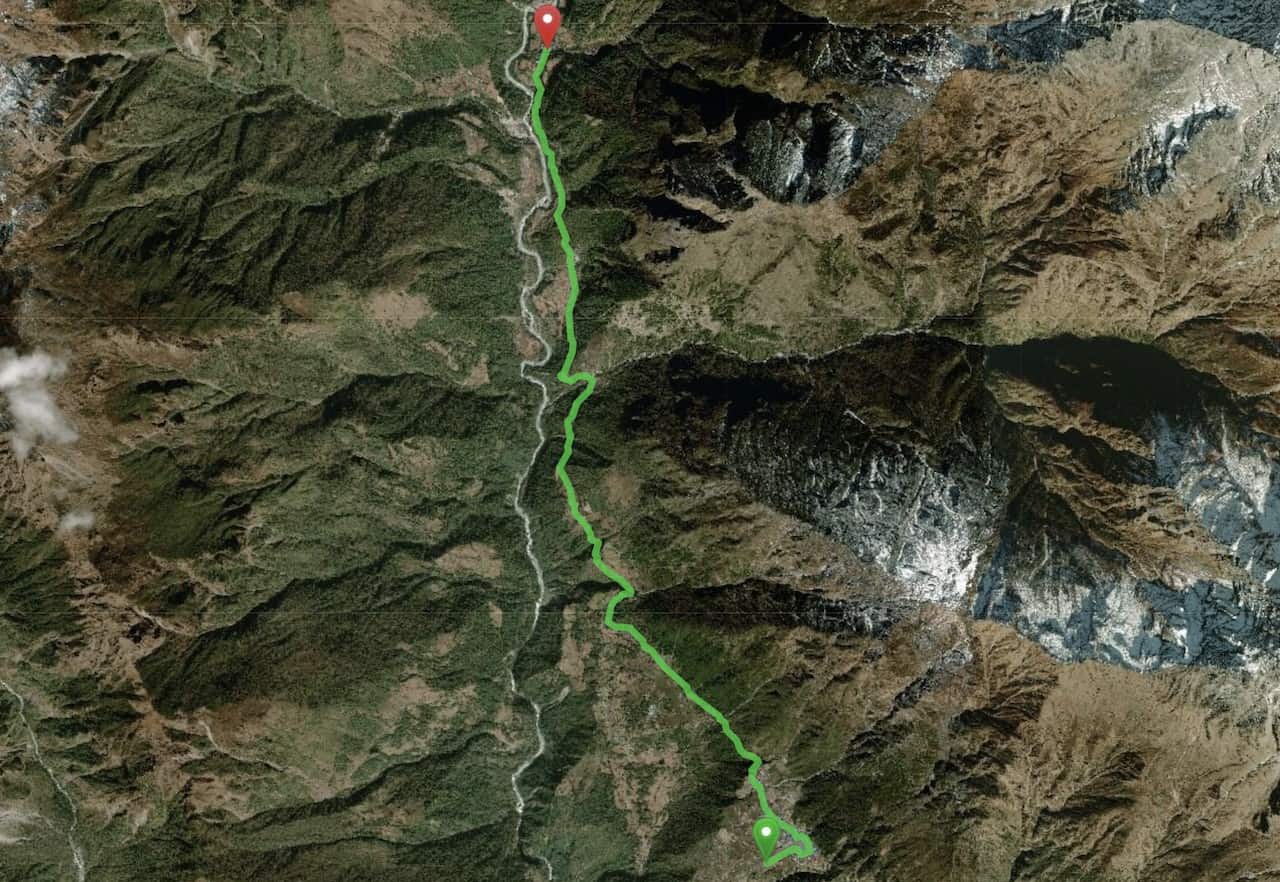

4) Everest Base Camp Trek Packing List
You will want to pack accordingly for this 11 day trek in the Himalayas. I put together a complete Everest Base Camp Packing List that goes over every single item I brought along on the trail.
On the first day on the trail, I started early in the AM right after I landed, when it was still a bit chilly. But soon enough I was just in a t-shirt and shorts (even in November!). Believe me though, you will need those layers very soon!
- Hiking Socks: Darn Tough Merino Wool Crew Mens | Darn Tough Merino Wool Crew Womens
- Hiking Pants: Eddie Bauer Men’s Guide Pro Pants | Eddie Bauer Women’s Guide Pro Pants
- Fleece: Columbia Men’s Ascender Softshell | Columbia Women’s Kruser Ridge II Softshell
- Rain Jacket: Columbia Men’s Watertight II | Columbia Women’s Arcadia II
- Hiking Shoes: KEEN Men’s Targhee III | KEEN Women’s Targhee III
- Hiking Backpack: Osprey Atmos 65 | Osprey Renn 65
- Trekking Map | NatGeo Waterproof Map
- Solar Power Bank | Anker 20,000mAh Solar Power Bank
- Deodorizing Body Wipes | Alcala Bamboo Deodorizing Body Wipes
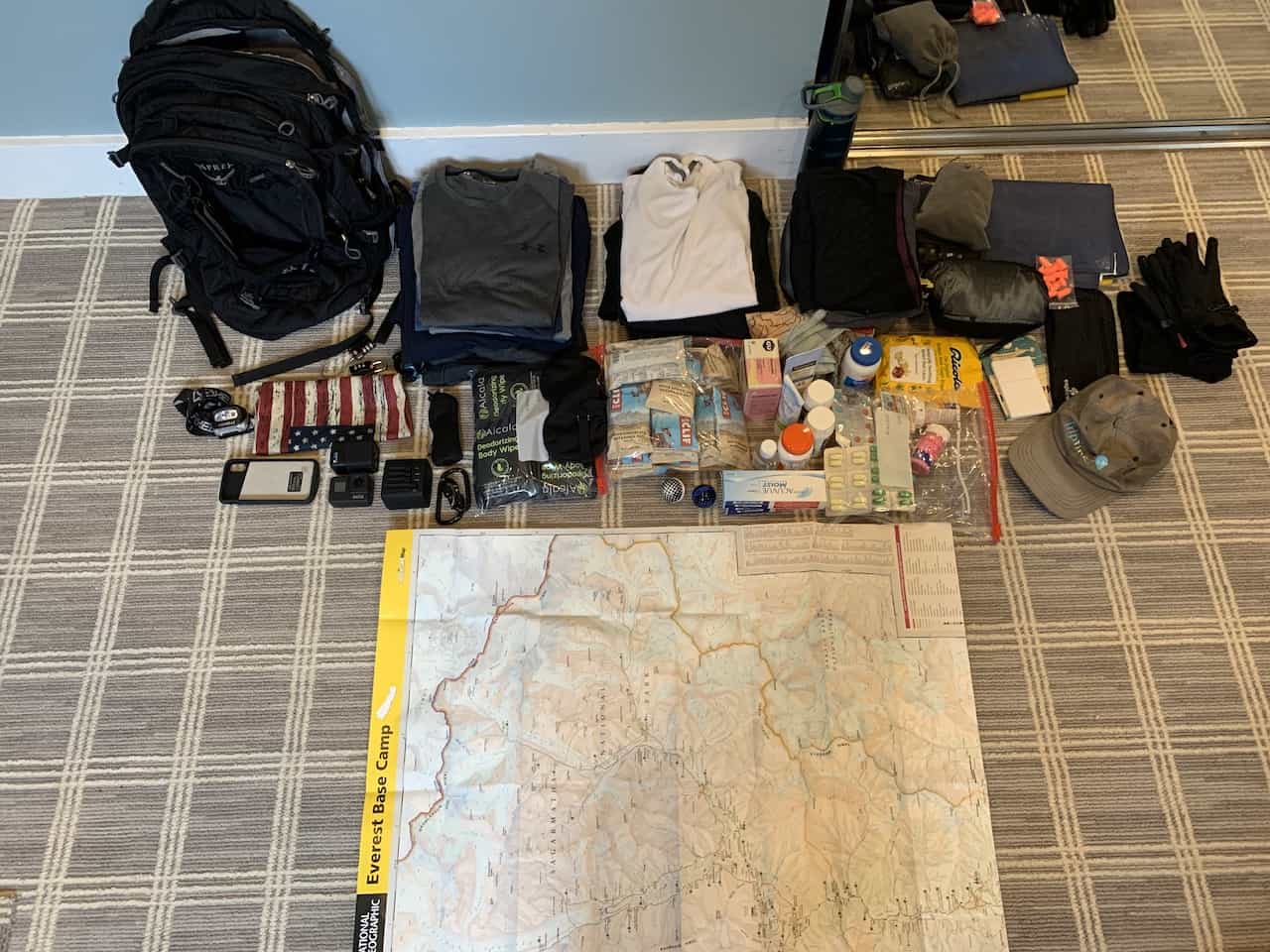
5) Arriving in Lukla
Once you arrive in Lukla, you can head down the main street, past the airport viewing area, and then grab some food at one of the restaurants / teahouses if you haven’t eaten already.
From there, as you continue down the main street you will come by the Khumbu Pasanglhamu Rural Municipality Office. Here you will need to purchase the first out of your two permits for the region.
The permit fee is Rs 2000 or about $17 USD. All you need to show here is your passport, and they will fill out the permit, which you must hold onto for the duration of the trek.
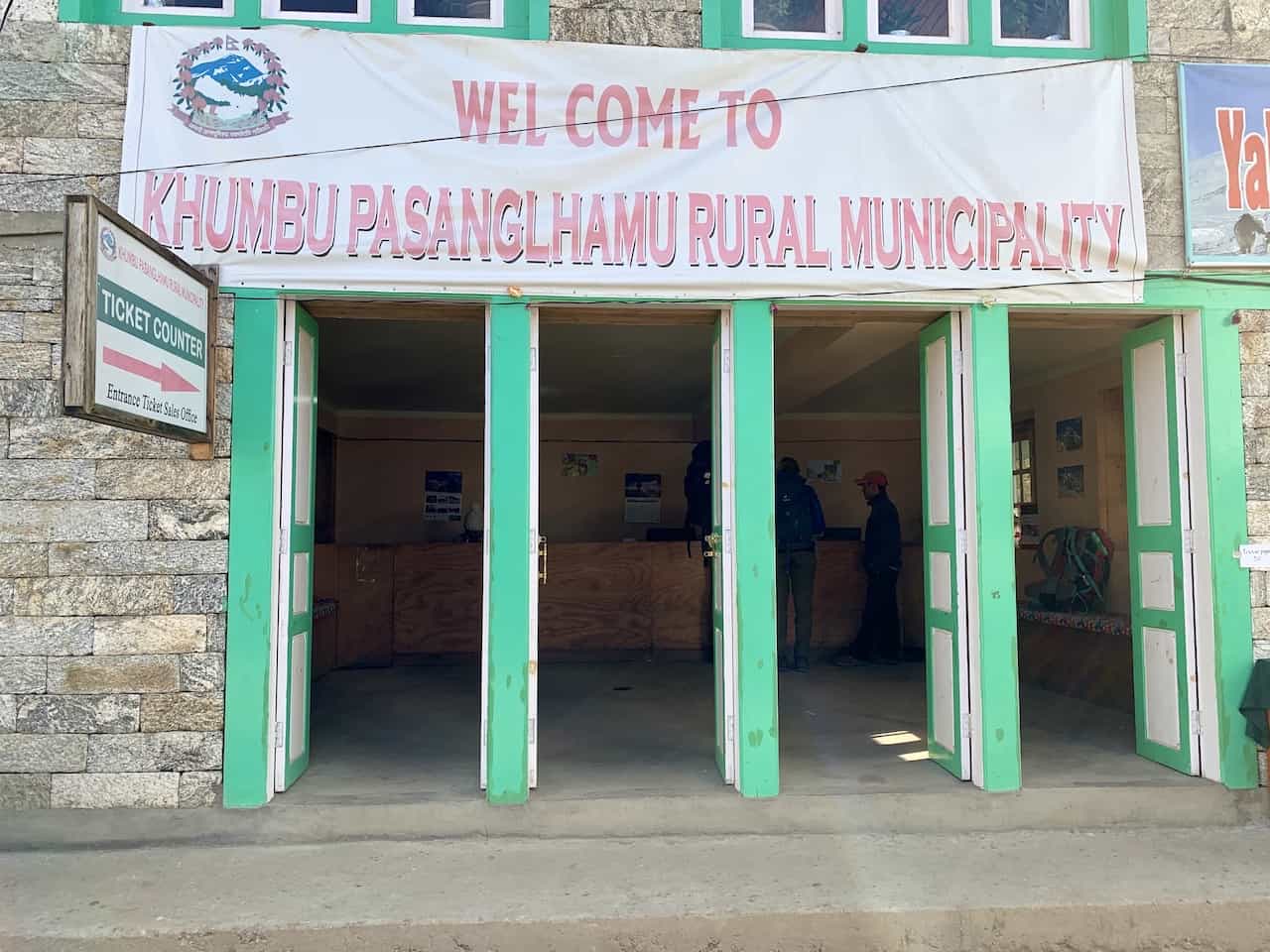
Considering travel insurance for the Everest Base Camp Trek? World Nomads offers coverage for more than 150 adventure activities as well as emergency medical, lost luggage, trip cancellation and more. For years, World Nomads has been protecting, connecting & inspiring independent travelers, offering travel insurance & safety advice to help you travel confidently. Their mission is to support and encourage travelers to explore their boundaries . World Nomads has simple and flexible travel insurance that has been designed by travelers for travelers. Even if you leave home without travel insurance or your policy runs out, you can buy or extend out on the road. Get a quote for a World Nomads travel insurance policy today!
6) Lukla to Phakding Trekking
As you can see from the elevation profile above, most of this portion of trail will be downhill, however you will come across some short uphill sections sprawled throughout the trail too.
The trail will be a mix between dirt, stone pathways, and some rocky sections as well. From a technical standpoint though it is a pretty easy portion of trail to maneuver and. you should have no trouble getting yourself along.
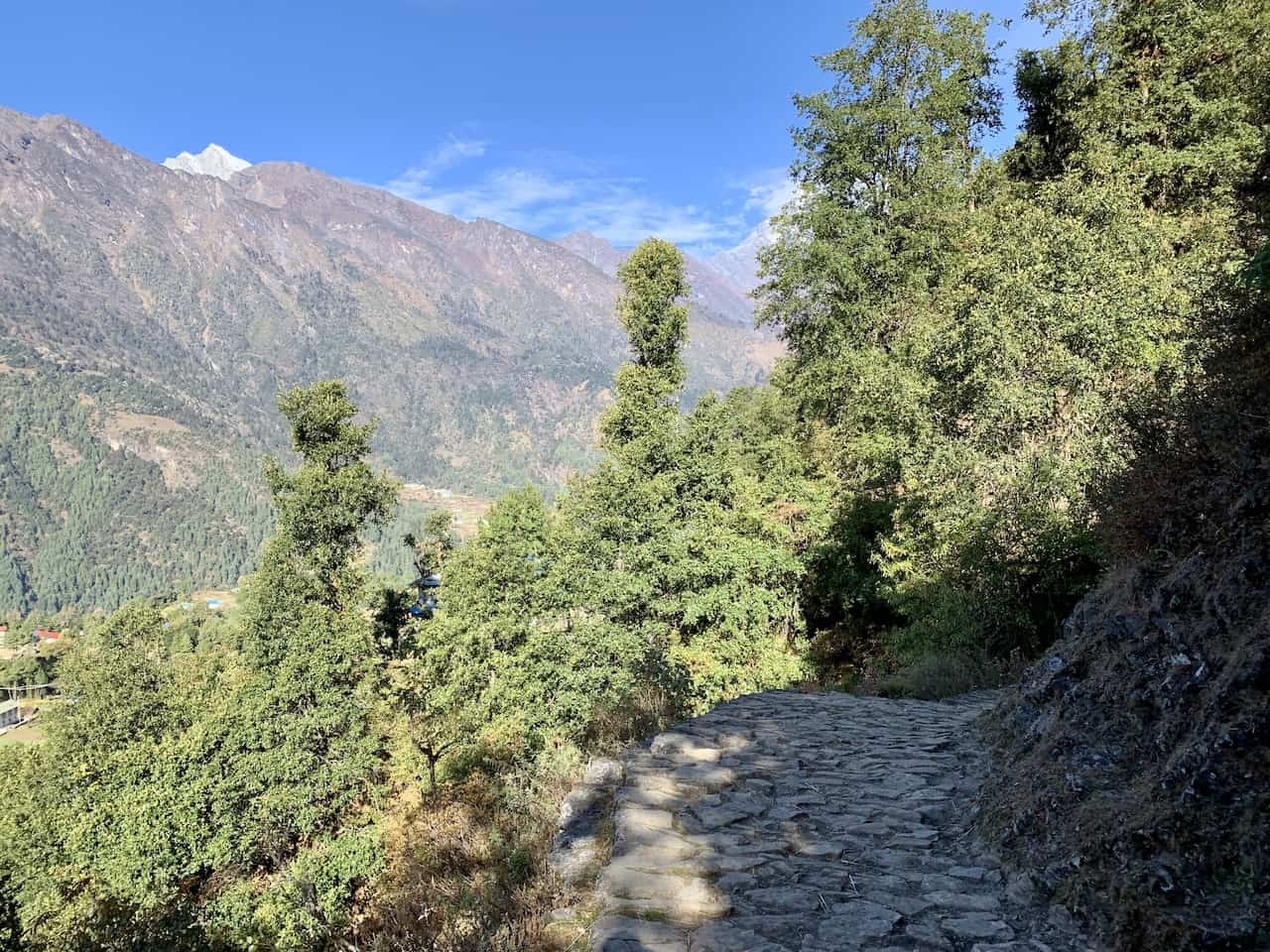
What I loved about the trek in general is although you will be staying in some of the more well known villages during the duration of your time in the region, you will also be passing by countless smaller villages as well.
These villages will just be made up of a few buildings here and there but it is always great to see and interact with the locals throughout the trail.
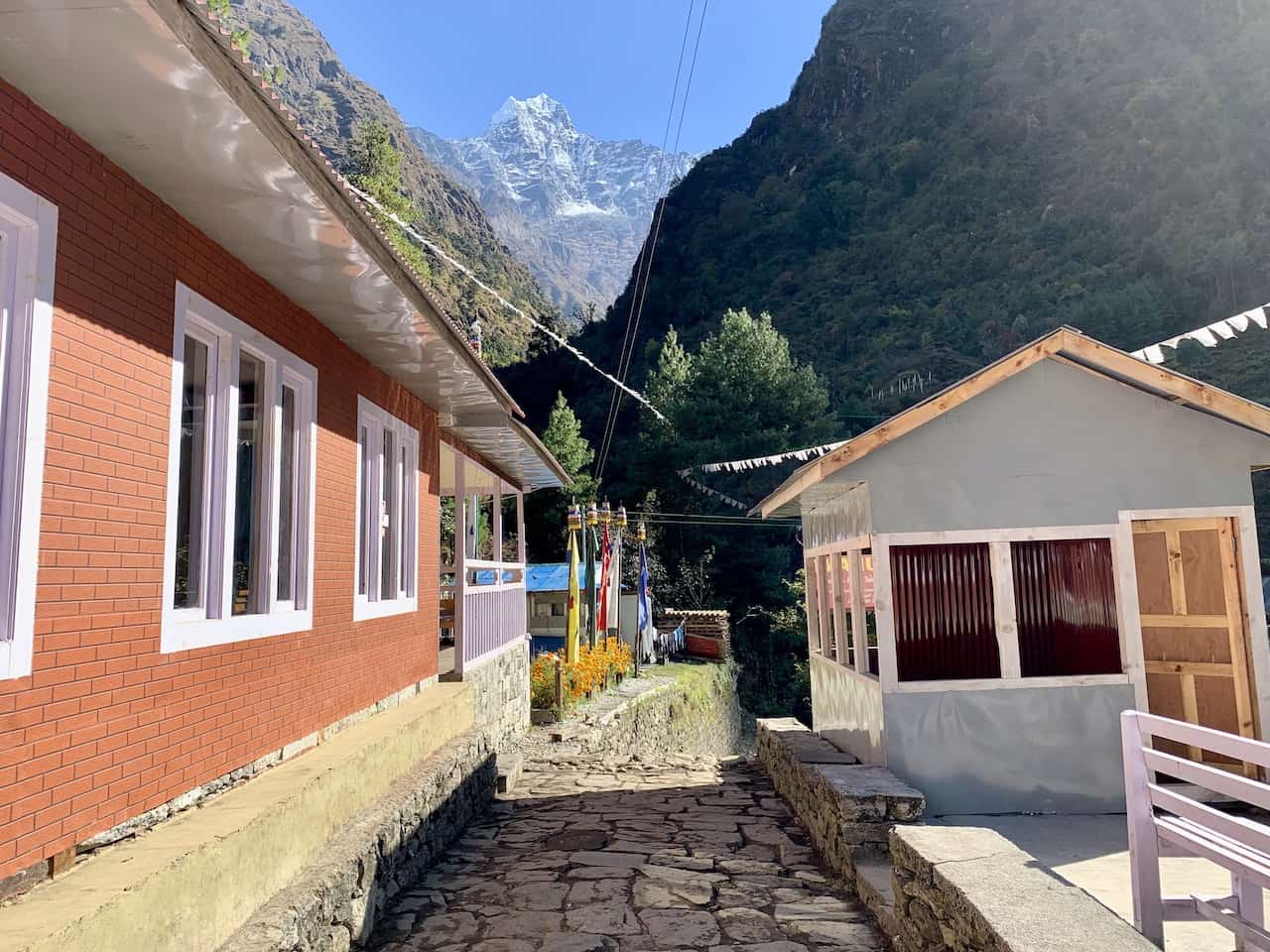
Since Lukla to Phakding is on the lower portion of the trail, you will see way more greenery all around you. There will be plenty of trees and fauna with some mountains peeking out in the distance.
Also, be sure to look out for all the various animals that will be carrying supplies out and back from Lukla. This is true for the entirety of the trail but you will see plenty of yak, donkeys, horses, and more.
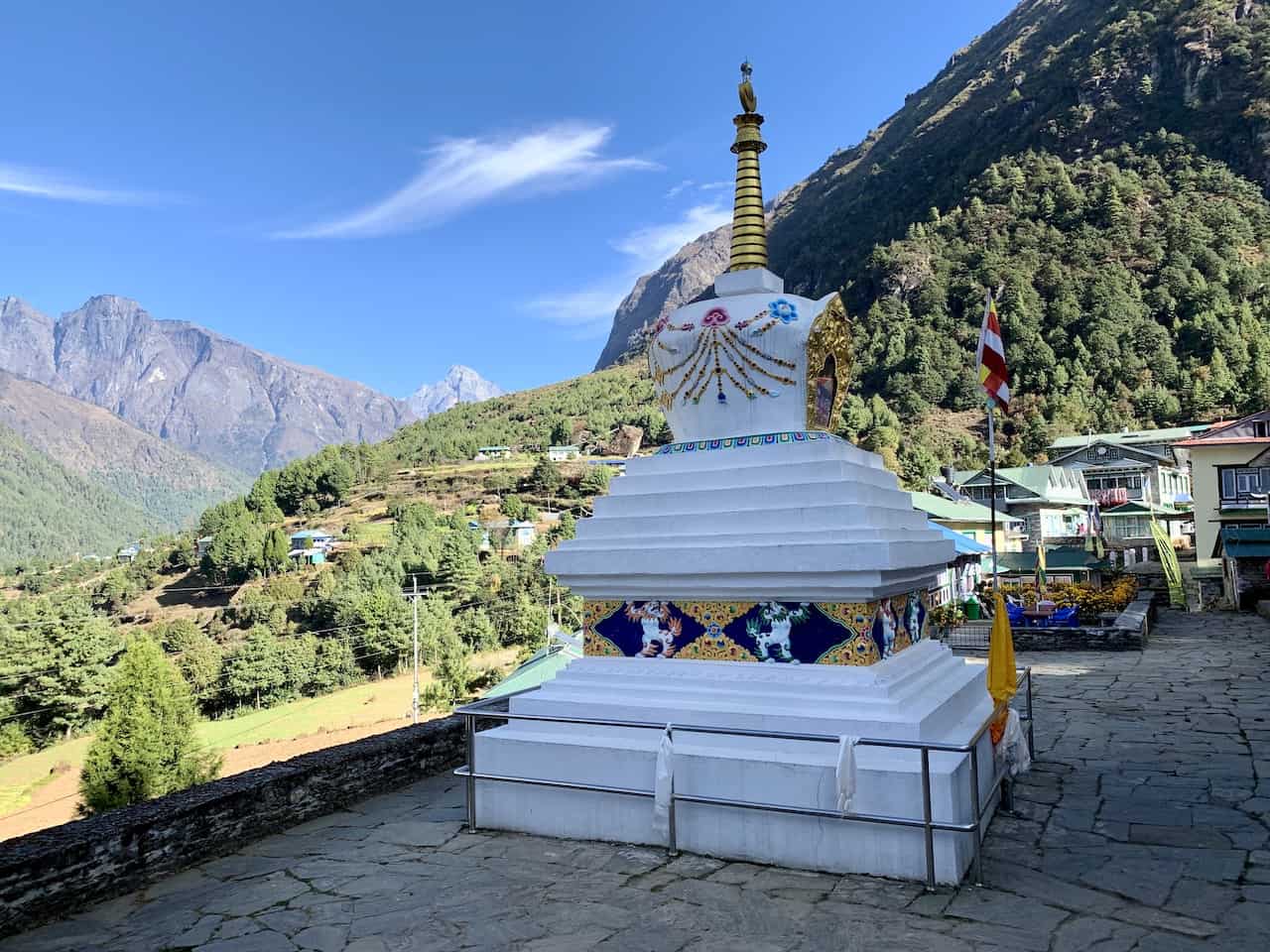
Lastly, you will also come across a few shorter suspension bridges from time to time (with plenty more to come on day 2).
As you approach Phakding you will get some great views of the Dhudh Kosi River as well before making it into the main town area.
Once you arrive go find a place to stay, have some lunch, and just relax for the remainder of the afternoon. You will have a big day 2 ahead!
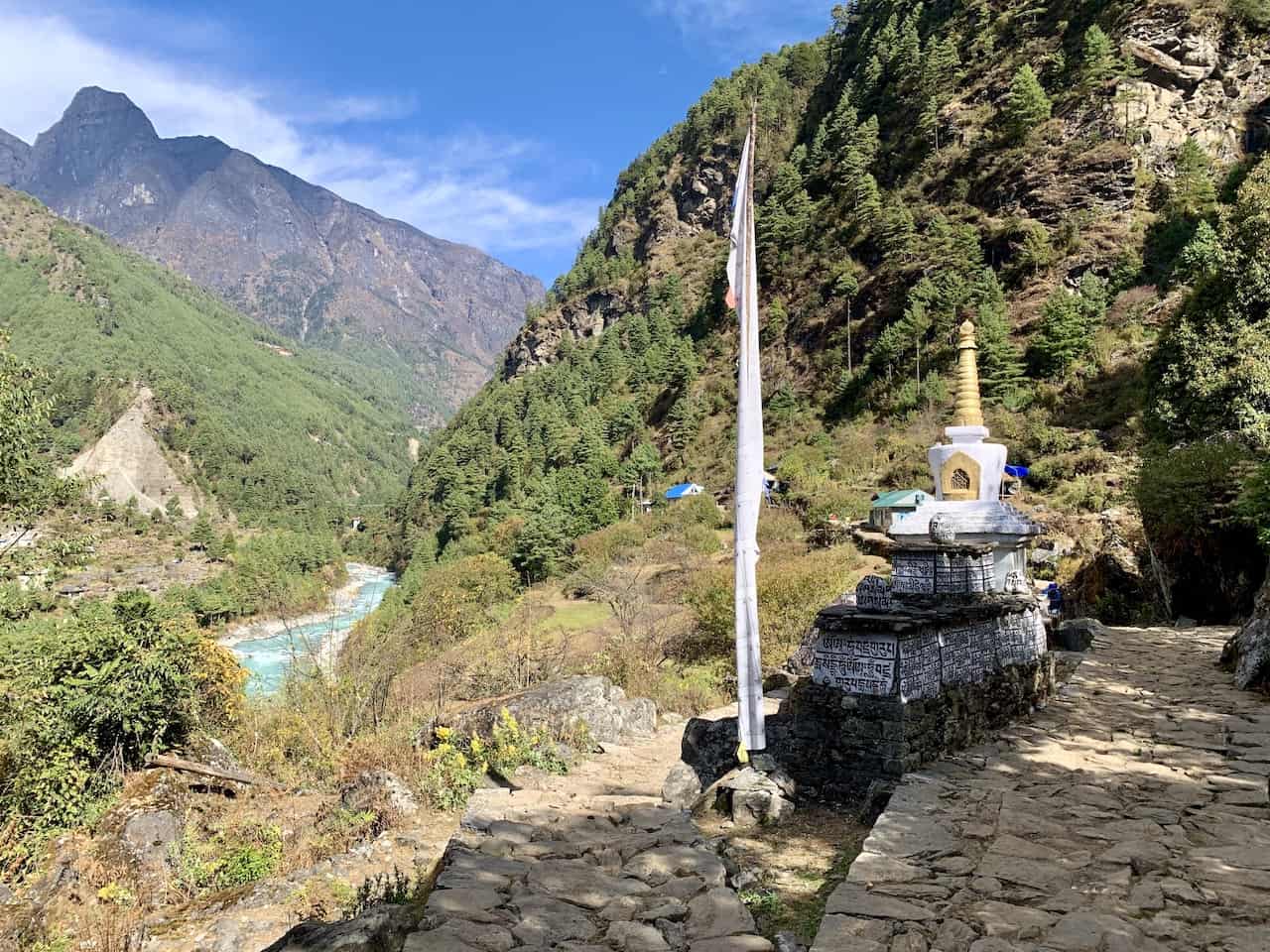
7) Phakding Teahouse / Accommodation
I wouldn’t overthink your accommodation choices too much on the trail in general. I found all the places I stayed at pretty much the same give or take.
Essentially, rooms will cost Rs 500 (less than $5 USD) for the most part, given you eat your meals at the teahouse as well.
In Phakding I stayed at the Trekker’s Lodge & Restaurant located in the middle of town. Some other options to choose from include Shangri-La, Green Village Guest House, and Royal Sherpa Resort, among several others.
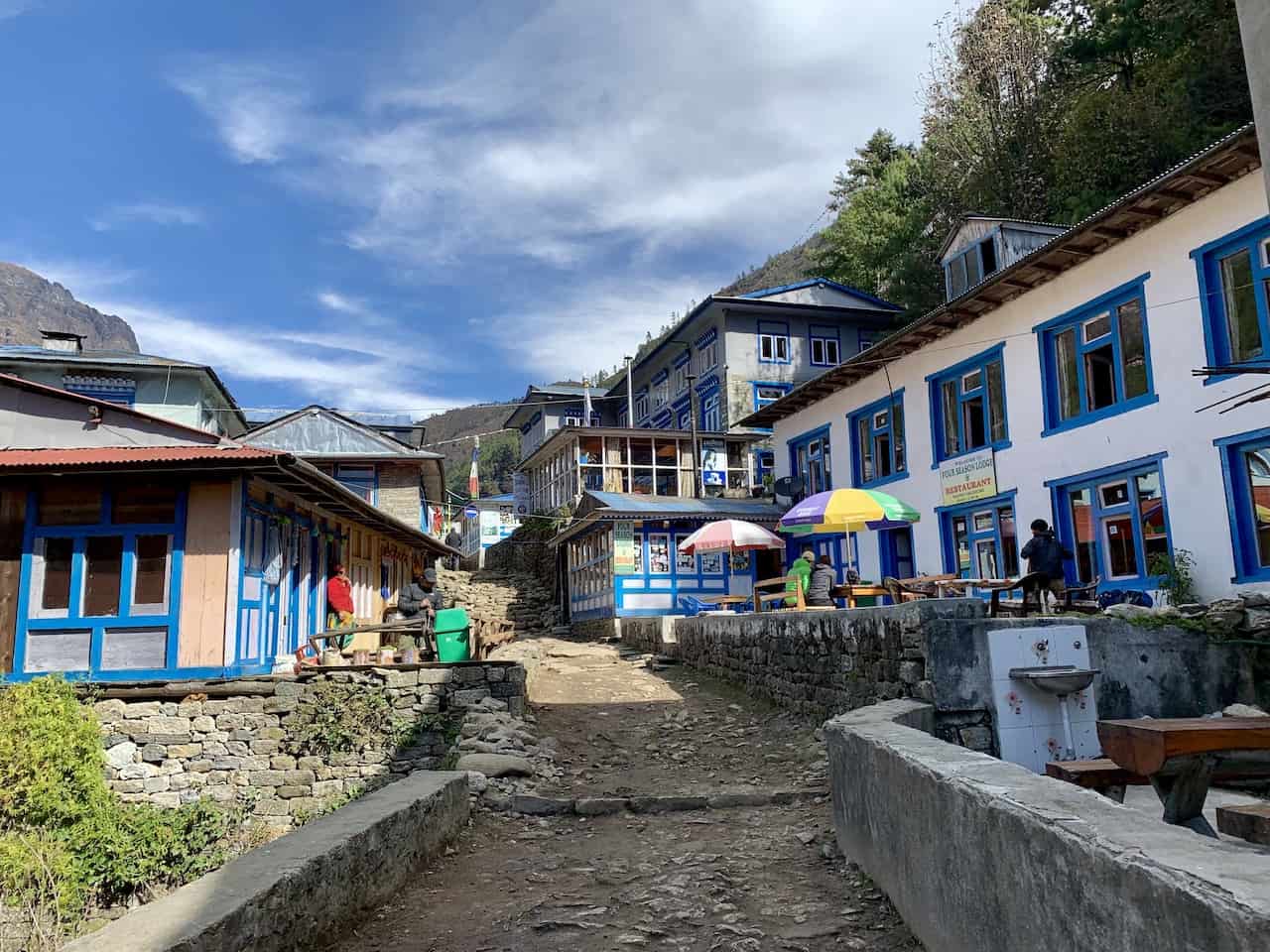
Take a look at this in depth overview of the Everest Base Camp Trek as well as the below guides I put together for each day of the journey:
Day 1 – Lukla to Phakding
Day 2 – Phakding to Namche Bazaar
Day 3 – Hotel Everest View Acclimatization
Day 4 – Namche Bazaar to Tengboche
Day 5 – Tengboche to Dingboche
Day 6 – Nangkartshang Acclimatization
Day 7 – Dingboche to Lobuche
Day 8 – Lobuche to Gorak Shep & Everest Base Camp
Day 9 – Kalapathar & Gorak Shep to Pheriche
Day 10 – Pheriche to Namche Bazaar
Day 11 – Namche Bazaar to Lukla
That about does it for day 1 of the Everest Base Camp trek. If you have any questions about the day or the trail in general, write them in below.
Be sure to check out the other Nepal itineraries and guides up on the site (like why I would recommend an Everest Base Camp Trek in November ). Have fun out there and safe travels.
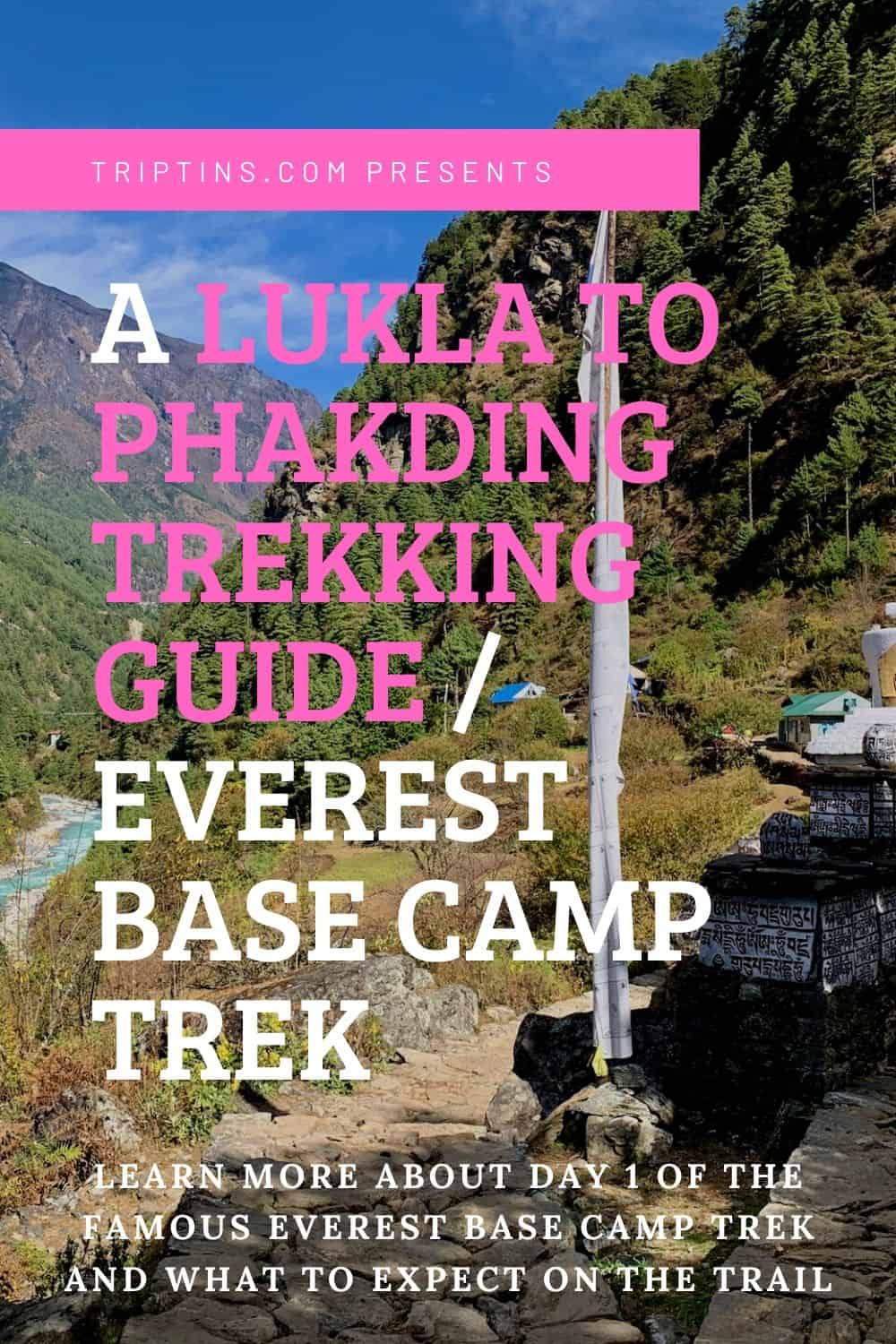
Related posts:
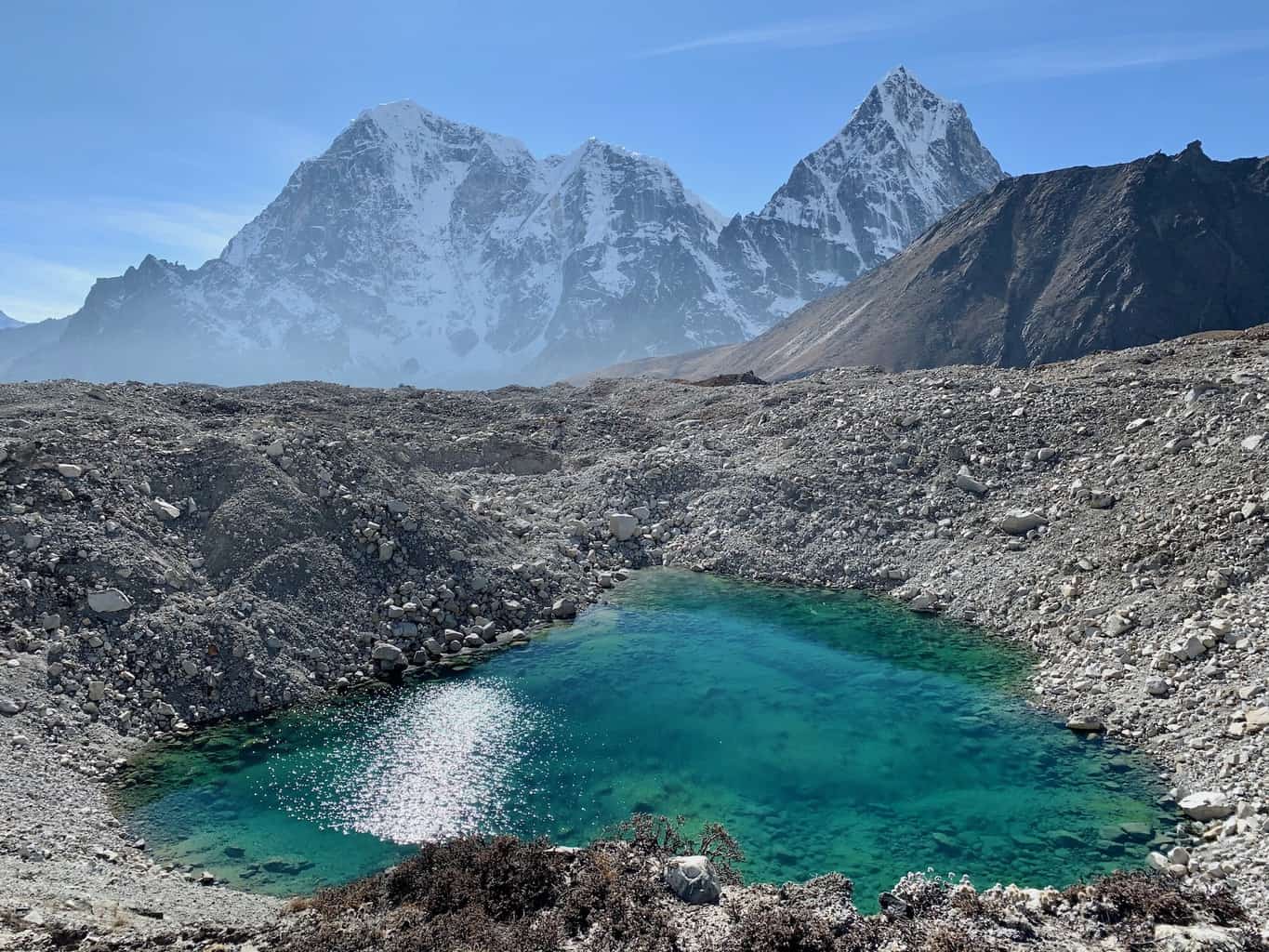
Sharing is caring!
Thursday 24th of November 2022
I think what you also need to communicate to people planning on flying from Kathmandu-Lukla in peak trekking seasons - the flights DO NOT depart from Kathmandu! The flights actually depart from Ramechamp airport about a 4.5hour drive from Kathmandu - due to air traffic congestion at Kathamndu airport. This has been the case for a few years now. So departure by minibus from Thamel/Kathmandu along rough roads is at 2:00am to arrive at Ramechamp at about 6:30am. Many trekkers are still unaware of this until they first arrive in Kathamndu!
Saturday 7th of January 2023
@Charles, I just got back from EBC in Dec and we flew from Ramechapp as this person described. So it's still happening.
Sunday 27th of November 2022
Hi Stew - this was the case at one point and then the flights once again returned to Kathmandu. Good to know that may not still be the case today. Hope you enjoy your trip!

The Ultimate Everest Base Camp Trek Itinerary: How to Get from Lukla to Everest Base Camp
Are you planning a trip to Everest Base Camp? Sitting at 5 380 m, the EBC trek in Nepal is one of the most iconic hikes in the world and tops any adventurer’s bucket list!
But walking over 130 km from Lukla to Everest Base Camp is tough! Mentally, physically and emotionally. Every day of your expedition will push you to your limits.
The reality is that no matter how intense your preparation is, it’s not your fitness levels or even your age that will determine whether you reach Everest Base Camp. It’s about how your body adjusts to a higher altitude.
Some people struggle, others don’t. This is why the acclimatization schedule in your Everest Base Camp trek itinerary is so crucial.
After successfully reaching base camp, I put together this comprehensive guide which includes step-by-step details of the best Everest Base Camp route to take, including the trekking time, the highlights, the best tea houses, how to deal with altitude sickness and so much more!
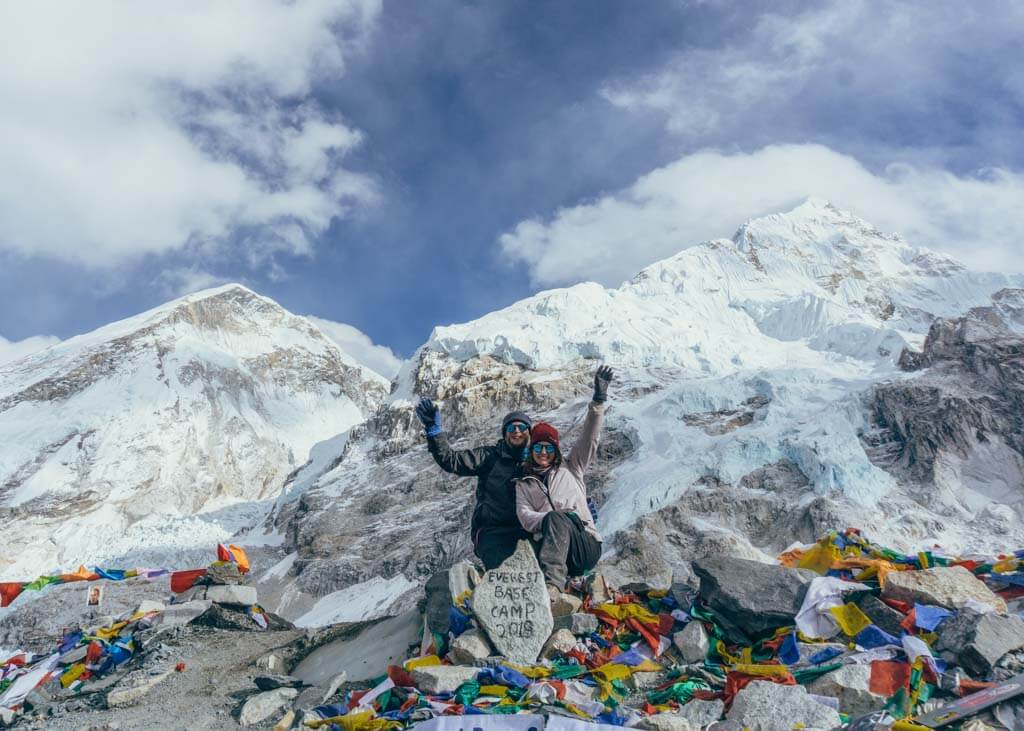
Quick Navigation
When to plan your Everest Base Camp Trek itinerary
April to May (Spring) and October to November (Autumn) are the most popular hiking months in Nepal offering perfect conditions for your Everest Base Camp trek.
But these months also attract scores of travelers looking to take on the Himalaya mountain ranges and so the trail does get busy.

Everest Base Camp Trek Route
If you follow my Everest Base Camp trek itinerary, you’ll need 12 days to start and return to Lukla. You will reach Everest Base Camp on day 9 which is enough time for your body to adjust to the higher altitude.
Day 1: Kathmandu to Lukla to Phakding
Day 2: phakding to namche bazaar, day 3: namche bazaar (acclimatization day), day 4: namche bazaar to khumjung, day 5: khumjung to phortse, day 6: phortse to dingboche, day 7: dingboche (acclimatization day), day 8: dingboche to lobuche, day 9: lobuche to gorak shep to everest base camp to gorak shep, day 10: gorak shep to kala patthar to pheriche, day 11: pheriche to namche bazaar, day 12: namche bazaar to lukla.
I did not take altitude sickness medication such as Diamox but I walked slowly, extremely slowly – probably the slowest anyone’s ever walked to EBC. This Everest Base Camp trek itinerary offers the best acclimatizing schedule to allow your body to naturally adjust to a higher altitude.
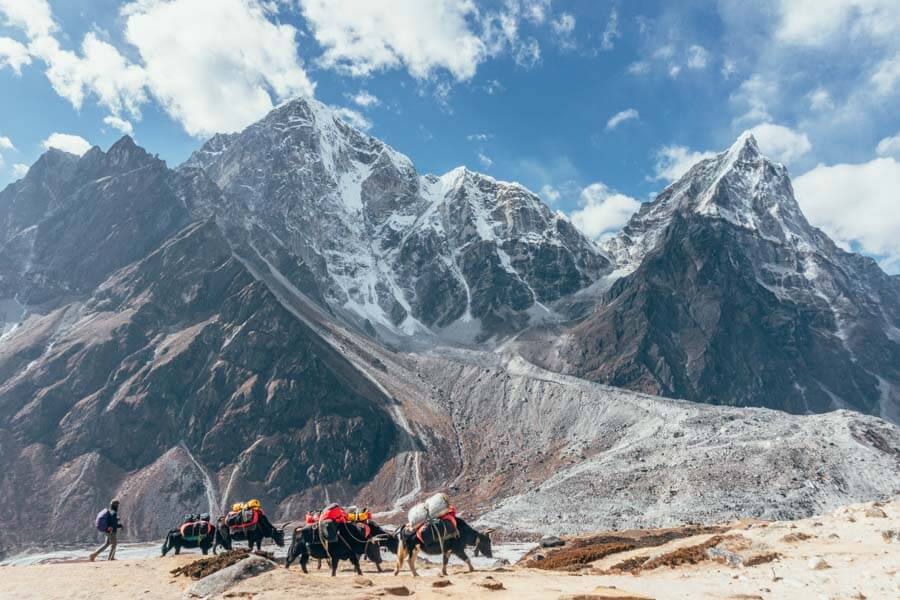
The start of your Everest Base Camp itinerary: Kathmandu
Your first few days in Nepal will be in the capital city, Kathmandu. Sitting at 1 400m above sea level, it’s recommended to spend at least 2 days here.
This allows your body to get used to the higher elevation, especially if you’re coming from sea level.
Kathmandu is a dynamic city with a rich culture and tradition, and you can easily spend a few extra days exploring if you have the time. Most tour operators include a day excursion to the nearby sights and temples within the city.
Make sure you stay in Thamel. It’s the hiking hub of Kathmandu with lots of eager trekkers choosing to base themselves here.
You can buy all your Everest Base Camp hiking gear in Thamel so don’t worry if you’ve forgotten something behind. Or if, like me , you arrived in Nepal with no hiking gear – only a pair of hiking boots! Thamel has got you covered.
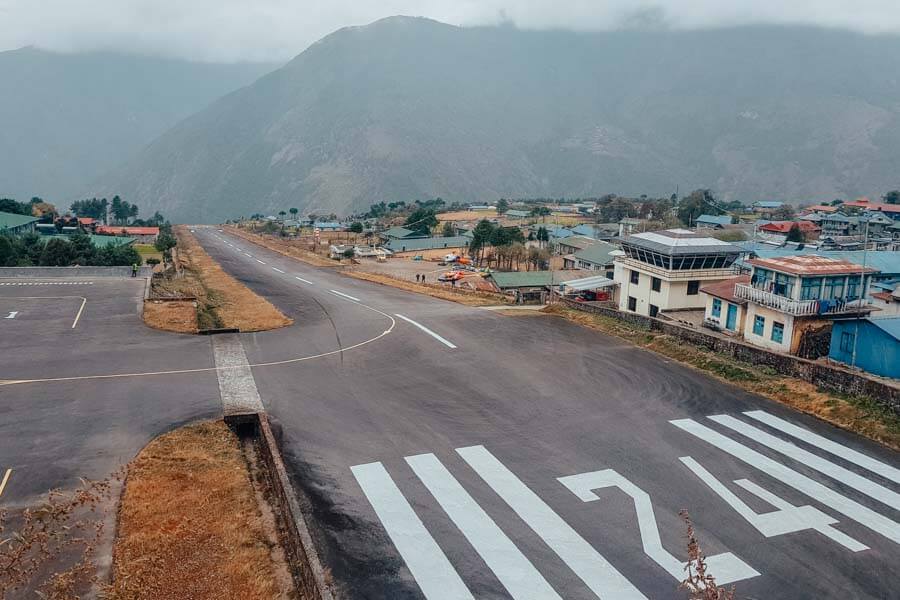
Altitude: Kathmandu (1 400m) – Lukla (2 860m) – Phakding (2 610m).
Trekking time: 3-4 hours | 7,4 km.
Difficulty: Easy with only a few uphill sections.
Highlight: Flight into Lukla.
Overview: The first day of your Everest Base Camp trek itinerary will start bright and early with a flight out of Kathmandu to the infamous Tenzing Hillary Airport in Lukla. From there, you’ll hit the ground running and hike just over 3 hours to Phakding, your stop for the night.
Tea house: Royal Sherpa Resort.
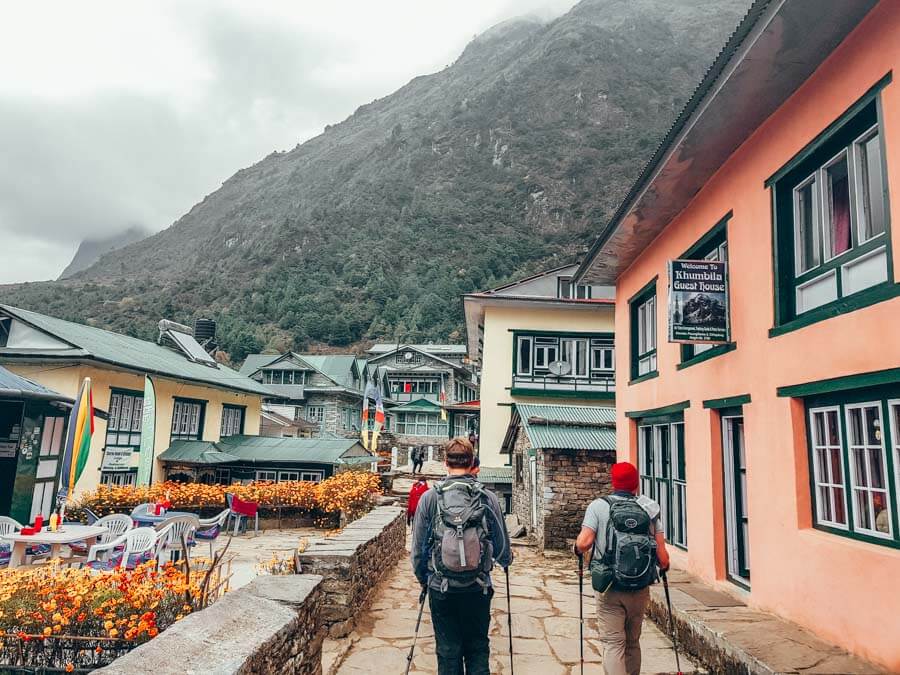
The day has finally arrived – The first day of your Everest Base Camp itinerary!
The flight from Kathmandu to Lukla is only 36 minutes but it relies heavily on the weather. Even if there’s slight cloud cover, the flights are delayed or worse, canceled. Lukla Airport is one of the most dangerous airports in the world after all.
My flight with Summit Air was due to leave at 9 am, but we only left after 3 pm due to the weather conditions. The planes are tiny, and you’re allowed no more than 15kg of luggage – in total!
The flight itself was thrilling but not as frightening as I anticipated. Although I did freak out every few minutes when there was a slight bump.
Lukla to Phakding
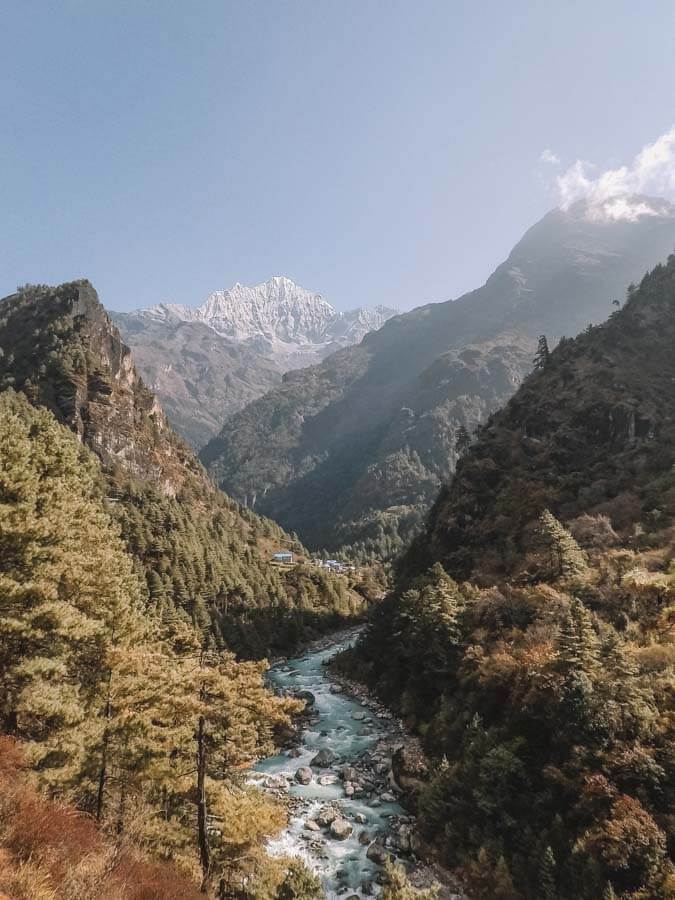
Once you’ve arrived in Lukla, grab a quick bite to eat before starting the afternoon trek to Phakding.
This section from Lukla to Phakding is an easy one and it’s the perfect introduction to the Himilaya mountain range. It’s an incredibly scenic trail that hugs the mountain and runs alongside a stream.
You’ll pass through several villages and will set your sights on the first yaks and mules of your Everest Base Camp trek.
Before you know it, you’ll have reached Phakding where you’ll spend the night in your first tea house. Don’t get too used to these comfortable conditions though. The further up you go from Lukla to Everest Base Camp, the more basic the amenities become!
Tip: There are ATM’s in Lukla (and Namche) but draw cash in Kathmandu as a back-up.
Tip: There’s cell reception (NCell) in Phakding and most tea houses offer free power to charge up your phone or camera here.
Tip: Try to eat well during the first few days as you’ll start losing your appetite from day 3 of your Everest Base Camp itinerary. Remember: “Dal Bhat Power – 24 Hour”

Altitude: Phakding (2 610m) – Namche Bazaar (3 440m).
Trekking time: 7-9 hours | 10,4 km.
Difficulty: Easy for the first section, steep and difficult for the second half.
Highlight: The views from the suspension bridges.
Overview: Day 2 is when the real hiking starts! You’ll begin with a slow hike before climbing a steep section leading to Namche Bazaar, one of the most iconic stops on your Everest Base Camp trek itinerary.
Tea house: AD Friendship Lodge.
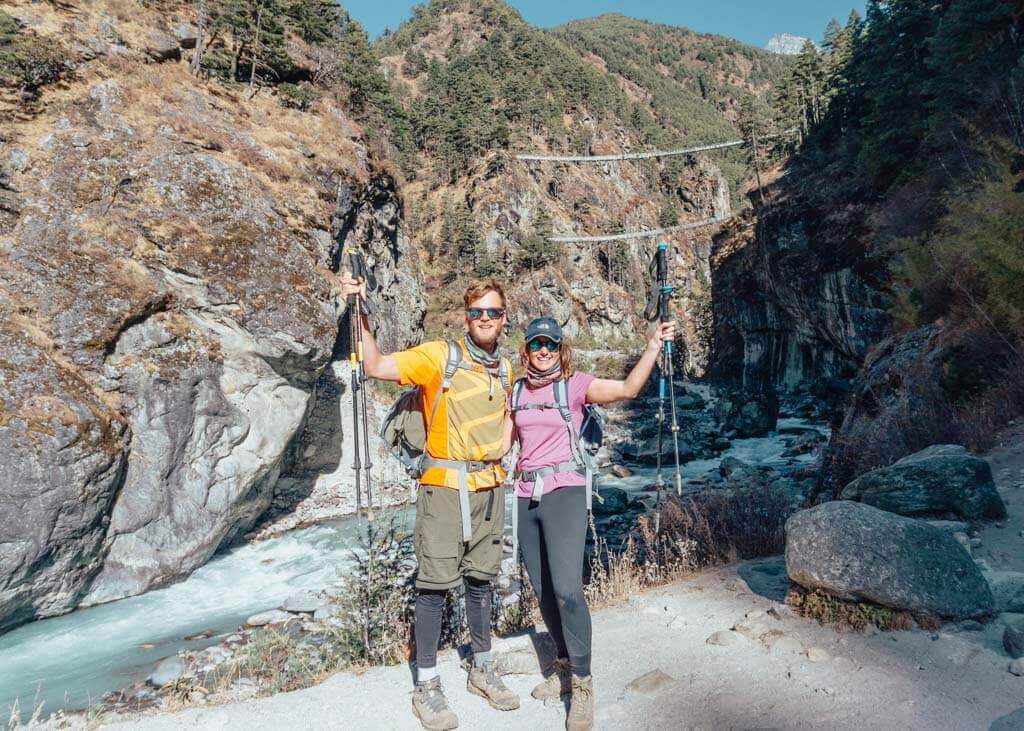
Day 2 is one of the most picturesque days of your Everest Base Camp trek itinerary. But you have a long day of hiking ahead of you so try to leave Phakding by 08:00 am.
The first part is an easy trek alongside pine forests and the excitement will begin to set in as you pass fellow trekkers making their way back down from Everest Base Camp to Lukla.
The glacial rivers are an impressive sight and you’ll cross several suspension bridges throughout the course of the day. These offer gorgeous views but they’re also terrifyingly high! Take in these beautiful surroundings as the landscape changes dramatically over the week.
After lunch, there is a sharp gain in elevation and the easy path suddenly becomes steeper. Take it slow to allow your body to adjust to this higher altitude.
En route to Namche Bazaar, you’ll also get your first glimpse of Mount Everest (If the weather conditions are on your side). You’ll also need to sign in at a checkpoint.
Namche Bazaar
Namche Bazaar is a picturesque village with a lively atmosphere. It’s the main trading center of the Khumbu region and a sherpa village. From Namche Bazaar it starts to get chilly but luckily there are plenty of tea houses with fireplaces to warm you up.
Tip: After you’ve arrived in Namche, pop into Hermann Helmers for their chocolate carrot cake. It’s life-changing!
Tip: Take a warm shower in Namche ($5) as it’s the cheapest you’ll find for the next 10 days!
Tip: Avoid eating meat after Namche Bazaar. Just think of it being carried up the mountain, during the heat of the day with no refrigeration. Don’t do it!
Day 3 of your EBC trek itinerary is your acclimatization day, a supposedly “rest day” to allow your body to slowly adjust to the high altitude. But that doesn’t mean you’ll get to sit inside and relax all day. Today, you’ll do an acclimatization hike to Everest View Hotel.
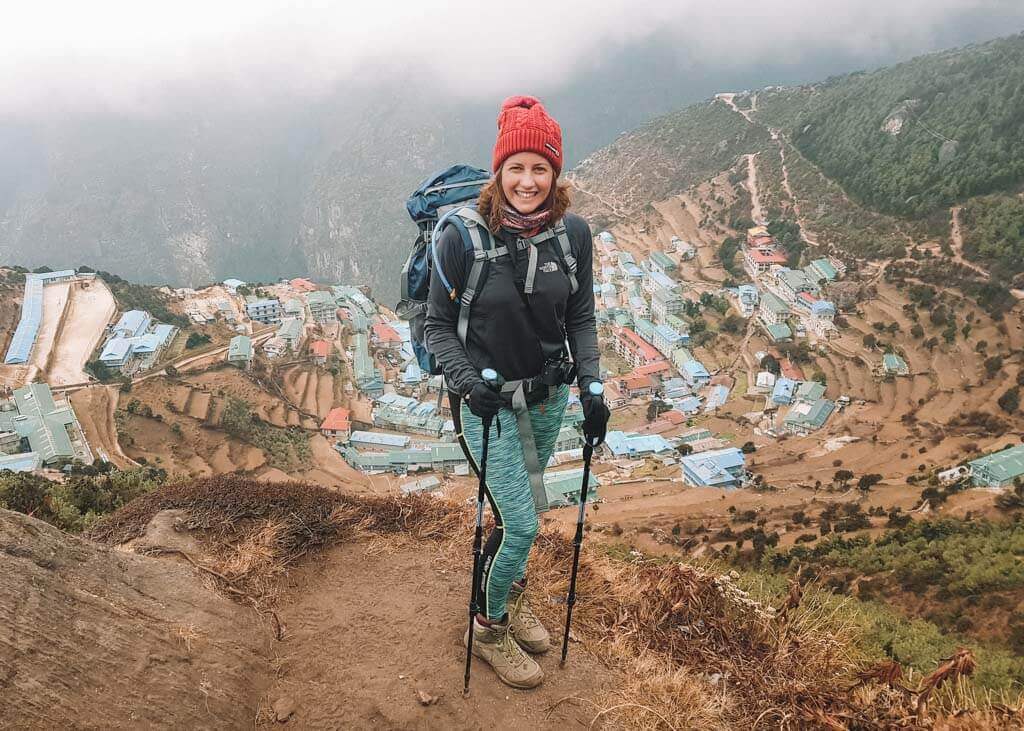
Altitude: Namche Bazaar (3 440m) – Everest View Hotel (3 880m) – Namche Bazaar (3 440m).
Trekking Time: 3 hours | 2.5 km.
Difficulty: The path itself isn’t too difficult, but with the elevation gain, you’ll begin losing your breath quickly.
Highlight: Watching Everest documentaries at Liquid Bar in Namche Bazaar (3 pm or 7:30 pm).
Overview: A short hiking day to Everest View Hotel and back, followed by free time to explore Namche Bazaar.
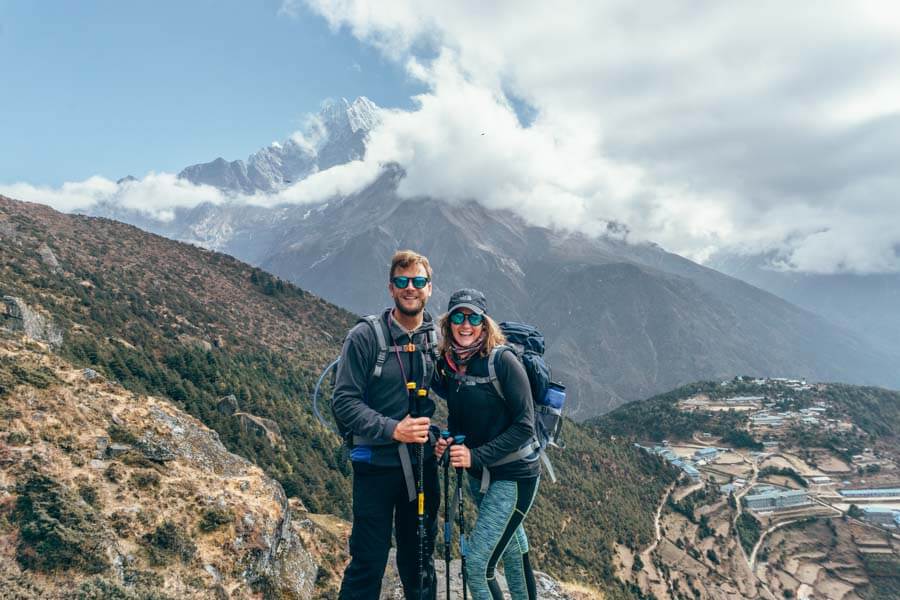
Even if you’re not feeling up to it, it’s important to get out and hike to a higher point, before coming back down to sleep at a lower altitude.
Today is also your second chance to get a glimpse of Mount Everest if you didn’t the day before. The trek is a tough one, and if you have not yet felt any symptoms of the higher altitude, you’ll soon begin to experience them.
Tip: There are many pubs and bars which show Everest documentaries. Make sure you watch one during your time in Namche Bazaar (But don’t drink alcohol on your way up – save that for when you return).
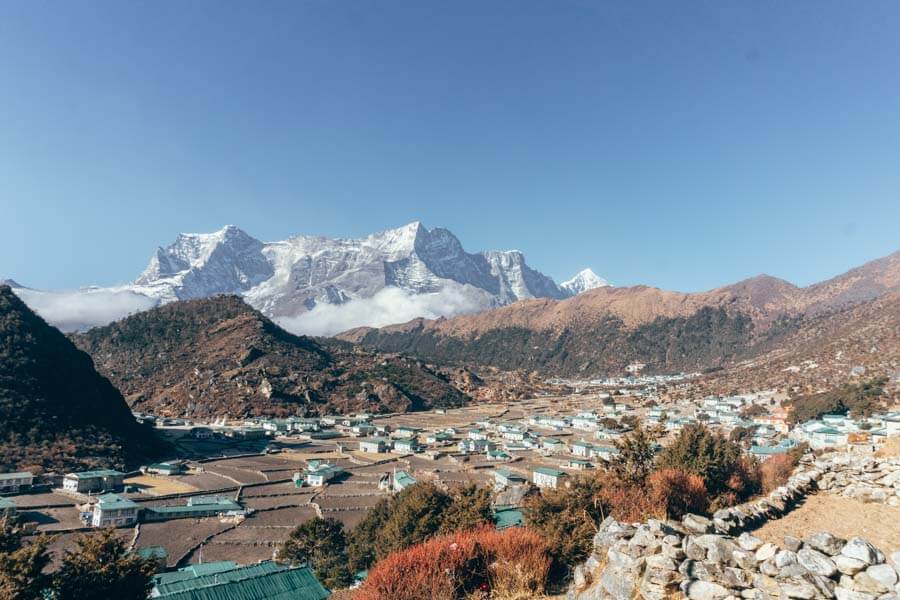
Route: Namche Bazaar (3 440m) – Khumjung (3 780m).
Trekking time: 4 hours | 4 km.
Difficulty: Moderately easy as it’s a short trekking day but from today the cold sets in.
Highlights: Playing card games in front of the fire, wrapped up in my sleeping bag because it was so cold.
Overview: You’ll go off the standard trekking route from Namche to Khumjung.
Tea House: Hill Top Lodge.
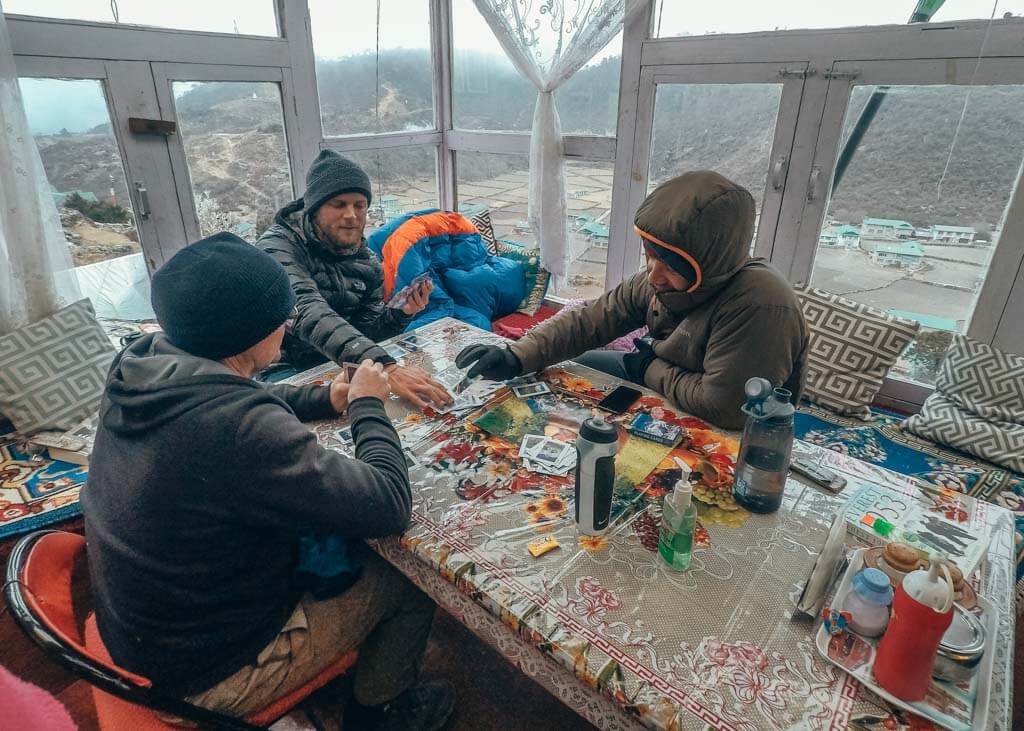
This is where most Everest Base Camp trek itineraries differ. From Namche Bazaar, there are two routes you can take both of which link up again in Dingboche on day 6 of your trek.
The first option (and most popular) is from Namche to Tengboche, before reaching Dingboche .
The second option (and my chosen route) is from Namche to Khumjung and Phortse which are on the other side of the river.
I chose the Khumjung route as it’s the less popular option. As a result, the hike isn’t as crowded, yet it offers the same sweeping views of the valleys below. But don’t worry, you’ll still get to experience the Tengboche route on your way back down from Everest Base Camp to Lukla.
Today was the first day that I layered up as it did get quite cold. You’ll pass a small local hospital as well as the famous Sir Edmund Hilary School before arriving in the small village of Khumjung.
When you get to Khumjung you’ll notice the change in the landscape. It’s far more arid and drier, with very few green luscious trees.
Tip: Ensure you have a pack of playing cards and a book with you. They’ll come in handy on short trekking days like today.
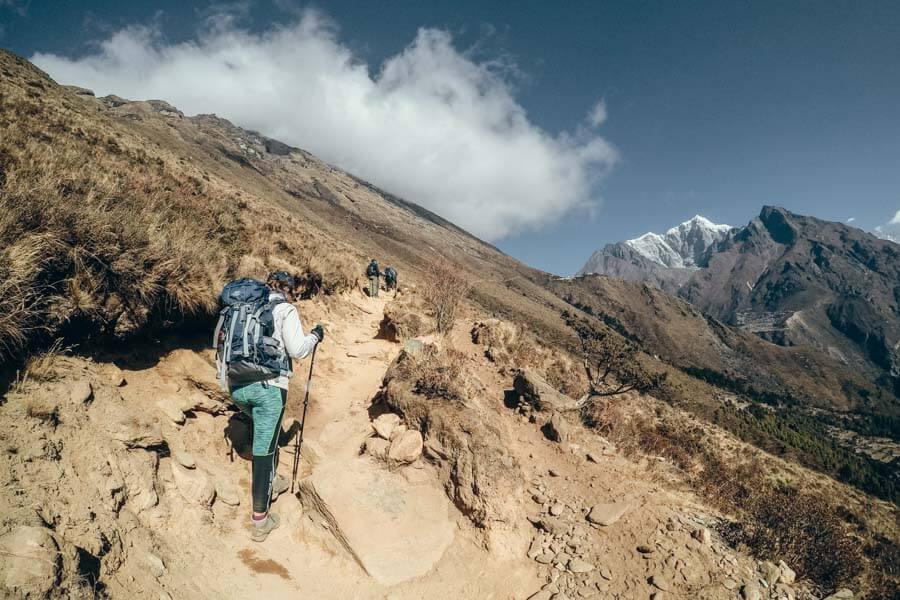
Route: Khumjung (3 780m) – Phortse (3 900m).
Trekking time: 6 hours | 7 km.
Difficulty: Although there isn’t much altitude gain today, there are still many sections where you walk downhill, before climbing back uphill so this constant up/down is strenuous.
Highlights: Today was the first day I began to feel the effects of the high altitude and I lost my appetite.
Overview: The trail from Khumjung to Phortse is incredibly scenic and you’ll walk alongside all the Himalaya giants.
Tea house: Phortse Resort.
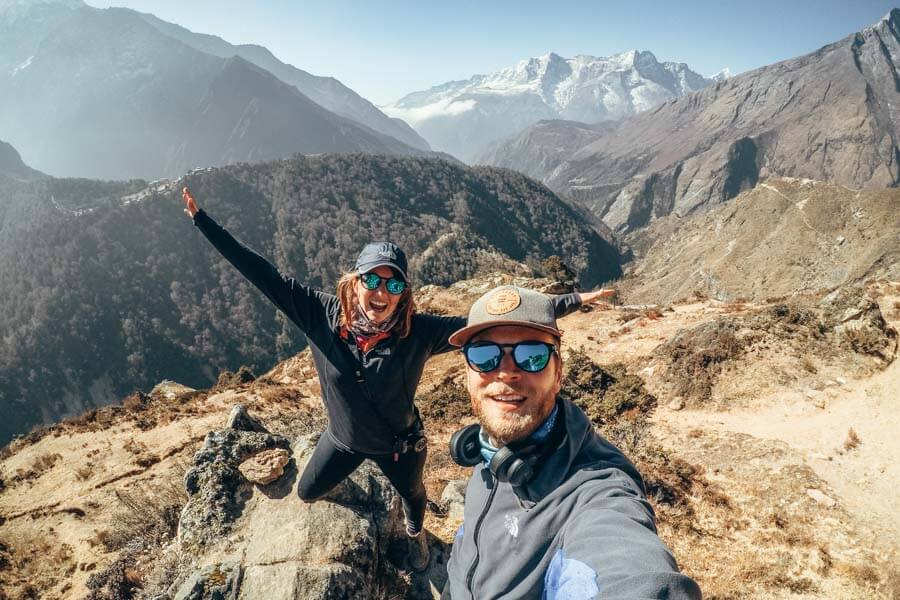
Day 5 of your Everest Base Camp trek itinerary will start with a 2-hour climb to Mongla (3 975m). You’ll then go back down to 3 800m which is the elevation of your next stop, Phortse.
You’re still on the “quieter” route so enjoy this path as it gets busier from tomorrow when you head to Dingboche.
Today is the day I started to feel the effects of altitude sickness and by the time I reached our lunch stop, I had lost my appetite and a terrible headache was setting in. I wrote this detailed guide to how hard Everest Base Camp is and it includes these moments where i felt horrible!
There is also a considerable drop in temperature – It was 4 degrees celsius when we started walking today. The pipes in Phortse were frozen and the guides start to give you hot water in the evening which will be your drinking water from here on out.
Tip: When you’re given hot water in your drinking bottles, put one inside your sleeping bag to act as a hot water bottle.
Tip: I took a headache tablet at lunchtime and after a good night’s rest, I was feeling much better. If you’re not feeling well, don’t be afraid to take a pain killer but make sure you communicate with your guide so that he knows to keep an eye on you.
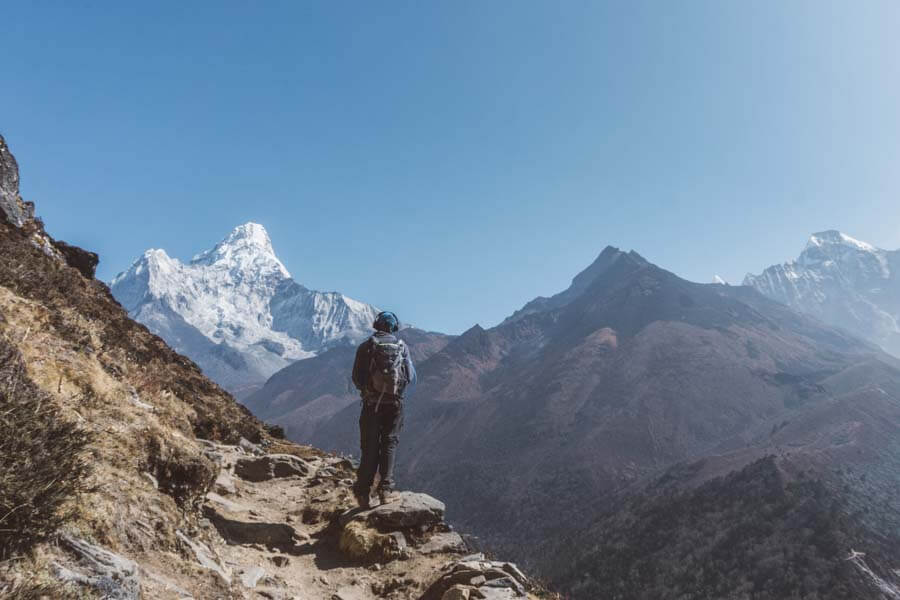
Altitude: Phortse (3 800m) – Dingboche (4 360m).
Trekking time: 8 hours | 9 km.
Difficulty: Today is a long, tiring day and breathing is difficult. The first few hours are tough, followed by an easier trek as you get closer to Dingboche.
Highlights: Arriving in Dingboche – today was a hectic day and I was so happy when it was over!
Overview: You’ll trek the entire day with a constant gradual incline until you arrive in Dingboche, where our EBC itinerary will meet up with the others who are coming from Tengboche.
Tea house: Sonam Friendship Lodge.
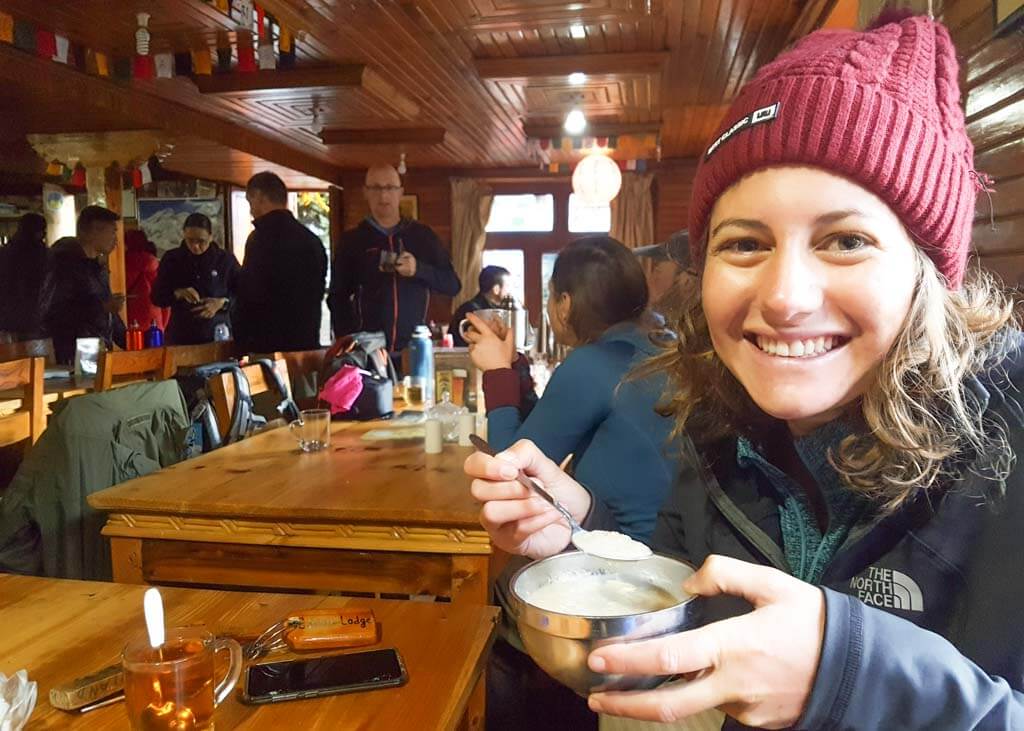
Today is a long trekking day!
When I woke up on day 6, I was feeling fit and strong (unlike the afternoon before) . I was extremely aware of how sick I had felt yesterday and despite feeling better, I took precautionary measures and walked extra slow with many breaks.
The first 5 hours involve constant uphill climbs, followed by downhill treks, before going uphill again! You’ll eventually pass the tree line, and the entire landscape becomes bare and rocky and resembles a desert.
Today you’ll be surrounded by all the Himilayan giants: Ama Dablam, Nuptse, and Cholatse, with unspoiled views of Mount Everest.
Throughout the day you’ll hear the sounds of helicopters making emergency rescues as trekkers begin struggling with the higher altitude and need to be taken back down to Namche Bazaar from Everest Base Camp. It’s quite scary to see how frequently people require this emergency assistance!
Luckily, the final stretch to Dingboche after lunch isn’t as tough as the section before.
Tip: There’s no cell reception as you get closer to Dingboche so enjoy the next few days going off the grid.
Tip: On day 6 of our Everest Base Camp itinerary, a few trekkers started taking altitude sickness medication as a precautionary measure. I didn’t take Diamox but my guide had in case I needed it. As always, be cautious of the altitude.
Tip: You’ll lose your appetite, but order boiled potatoes to get some food into your stomach.
Today is the last of your acclimatization days so you’ll spend a second night in Dingboche. Again, it’s important to do an acclimatization hike from Dingboche .
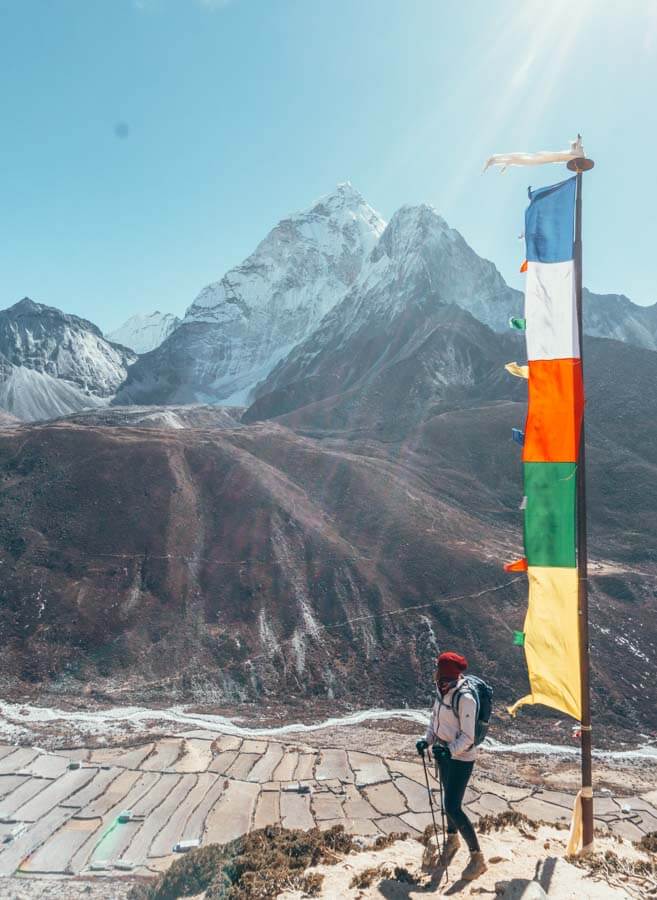
Altitude: Dingboche (4 360m) – viewpoint (4 900m) – Dingboche (4 360m).
Hike time: 3 – 5 hours | 3 km.
Difficulty: Short, but steep climb so take it slow and steady.
Overview: Today is a short acclimatization hike to a viewpoint and back.
Highlight: Views of the Chukhung Valley and Island Peak.
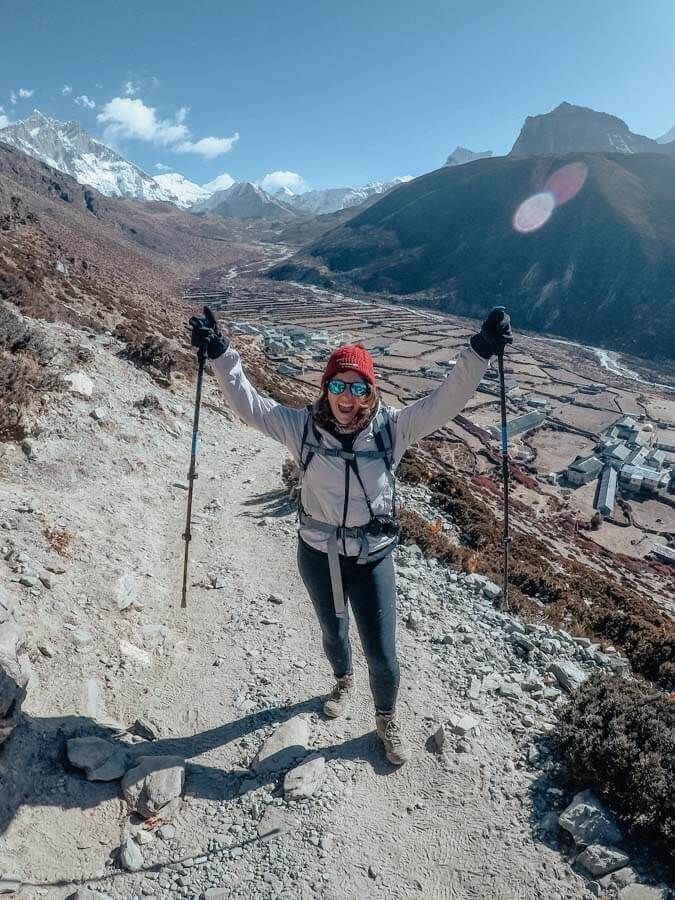
I woke up on day 7 of my EBC trek and I was feeling terrible. The Khumbu cough had really set in, I was freezing cold, my nose was constantly running and I was beginning to lose my voice.
When you reach Dingboche, the luxuries of warm water, comfortable beds, and flushing toilets are long gone, and this is when the mental challenge begins. But listen to your body and be honest with your guides about how you’re feeling.
During my time in Dingboche, a porter from a different tour group (who had hiked to EBC many times before) had gotten sick and had to be airlifted back to Lukla. This was a harsh reality of the effects of high altitude climbing and how it can happen to anyone, no matter your experience, fitness level, or age.
Dingboche Acclimatization Hike
Today you’ll go on an acclimatization hike to a viewpoint overlooking the Chukhung Valley. Going to this higher altitude, and then returning to Dingboche will make you feel so much better (as it did for me). So, gear up, pack your day bag, and head outside for a few hours.
The acclimatization hike from Dingboche to the viewpoint is pretty steep and rocky, but you’ll be hiking at a much slower pace than the previous days. All around you, you’re surrounded by towering mountains and peaks, and it’s a sight you won’t easily forget!
Once at the viewpoint, you’ll have the best views of Ama Dablam and Island Peak, as well as the symbolic prayer flags.
I added Island Peak to my Everest Base Camp itinerary (and I HIGHLY recommend you do the same). It’s 4 extra days of trekking after you’ve reached Everest Base Camp, and it was one of the best and most thrilling experiences of my life!
Tip: After returning from your acclimatization hike pop into Cafe Himalaya Bakery to watch their daily Everest movie.
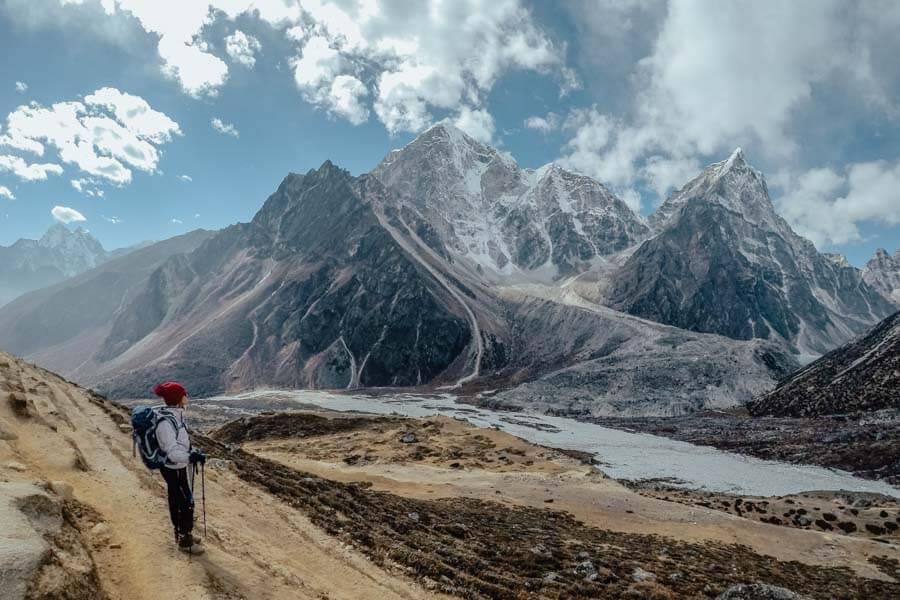
Altitude: Dingboche (4 360m) – Lobuche (4 930m).
Trekking time: 7 hours | 10.7km.
Difficulty: Hard! The section from the bottom of the icefall to the Everest memorial is brutal. It’s steep, and it’s far.
Highlight: The climb to the Everest memorial. It’s painfully steep and I struggled!
Overview: As you leave Dingboche, the first part of your trek is relatively easy. Until you reach Dukla! This is where the trail becomes steep. From there it’s an excruciating 2-hour climb before the path becomes flat again. You’ll walk alongside the Khumbu Glacier, the longest glacier in Nepal.
Tea house: Sherpa Lodge.
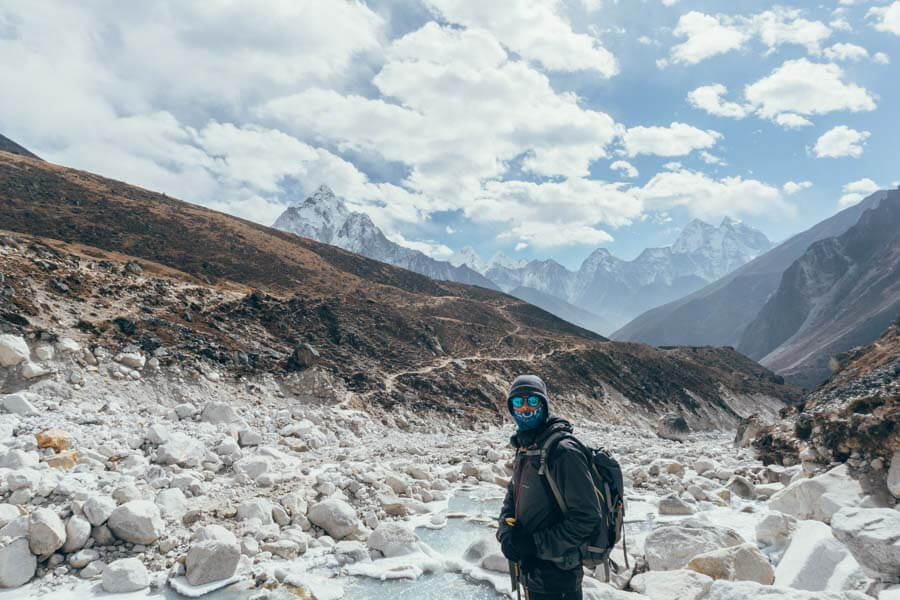
I kept a day-to-day journal of my Everest Base Camp trek itinerary, and in it, day 8 is highlighted (in capital letters with several exclamation marks) “ The hardest day EVER! ”
And thinking back to this day, it really was!
The first 3 hours include a gradual incline before crossing to Dukla which will be your lunch stop for the day. Enjoy the break, because you are going to be hating life for the next 2 hours – it’s a killer of a climb. Breathing at an altitude of over 4 500m doesn’t make it any easier!
You’ll pass many trekkers who are making their way back from Everest Base Camp. I was shocked to see the condition most of them were in. Many people were even getting carried down by mules! They looked like they had really taken strain – coughing, no voice, chapped lips, and no energy.
I was hoping and praying that wouldn’t be me in a few days (but unfortunately, it was – except I didn’t need to be carried down!)
Everest Memorial
At the top, you’ll reach the Everest Memorial for climbers who’ve lost their lives in their attempt to reach the summit of Mount Everest. There is a somber mood, and I get goosebumps thinking about all those climbers and their families.
From the memorial, it’s about a 1-hour trek alongside the Khumbu Glacier to Lobuche. This last section is far easier than the previous one. Again, take it slowly!
Tip: At this stage, everyone is feeling the effects of the altitude and the cold. You’re not alone! Just keep pushing through, it’s nearly over! (says me who wanted to turn back countless times) .
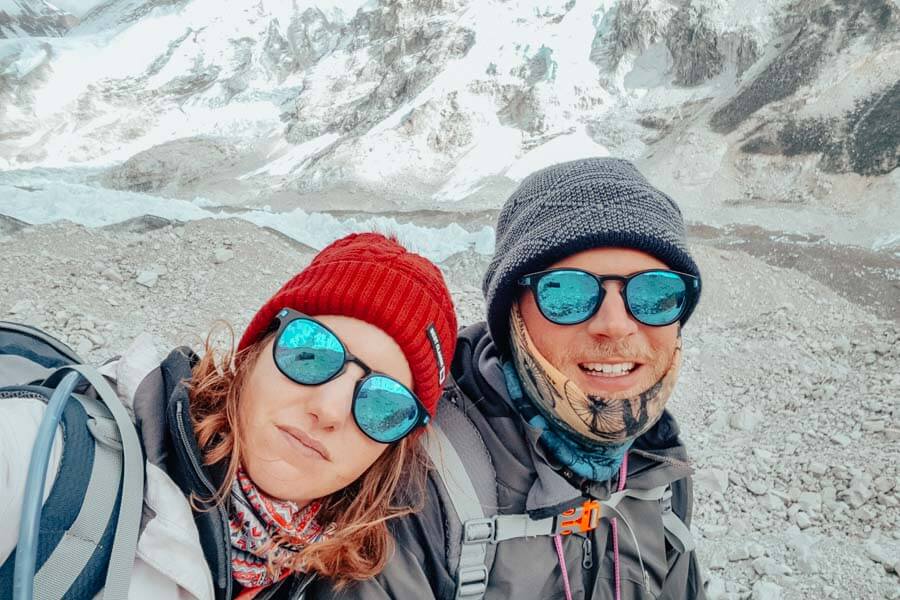
Altitude: Lobuche (4 930m) – Gorak Shep (5 160m) – Everest Base Camp (5 360m) – Gorak Shep (5 160m)
Time: 10 hours | 12 km.
Difficulty: Moderate with a steep climb towards Gorak Shep and an easy trail to Everest Base Camp. The difficulty lies in hiking time and the high altitude.
Overview: Today is the day you reach Everest Base Camp! You’ll arrive in Gorak Shep, drop off your bags and have lunch before departing north along the Khumbu Glacier to Everest Base Camp.
Highlight: It should be reaching Everest Base Camp, right?
Tea house: Buddha Lodge
Whilst the previous day’s hike from Dingboche to Lobuche was certainly the toughest and most physical section, getting to Gorak Shep, and then on to EBC and Kala Pattar were the most emotionally and mentally challenging sections of my entire Everest Base Camp trek itinerary.
Your day will start with a moderate hike leading to Gorak Shep from Lobuche. After about an hour into your hike, the path becomes steep with numerous boulders to pass. Whilst it isn’t a strenuous climb, the altitude will affect you and you’ll be walking very slowly.
Gorak Shep and Everest Base Camp
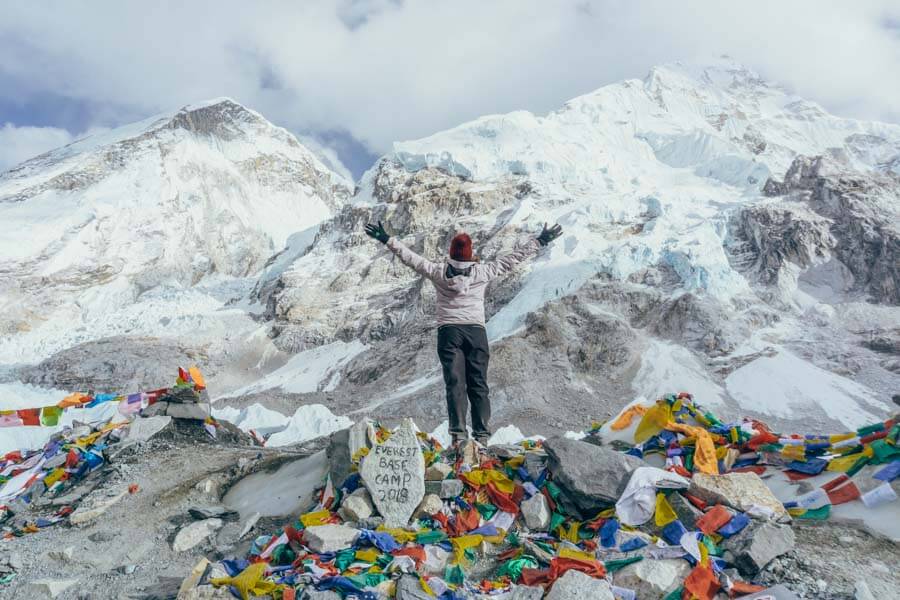
You’ll reach Gorak Shep at lunchtime where you’ll drop off your bags and prepare for the afternoon hike to EBC.
You don’t actually stay at Everest Base Camp. Gorak Shep is your base with the closest tea house to EBC.
After lunch, you’ll trek to Everest Base Camp. The path is made of rocky sections and loose stones. You’ll be exhausted at this point. But the adrenalin rush will keep you going. The excitement to finally reach Everest Base Camp will get you to the end.
Arriving at base camp is surreal. You can see the Khumbu Icefall in the distance, one of the most notorious sections leading up to the Everest summit.
It’s an eerie feeling reaching Everest Base Camp but absolutely gorgeous standing at the foot of the highest mountain in the world.
You’ll then make your way back to Gorak Shep which is where you’ll spend the night.
The reality
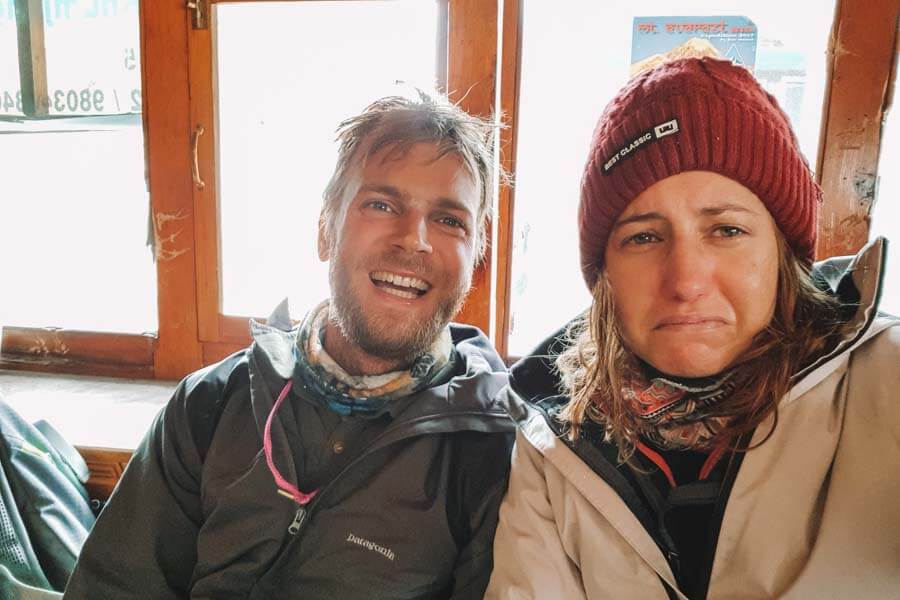
The most vivid memory I have of my entire Everest Base Camp trek is sitting in the tea house in Gorak Shep after returning from Base Camp.
The communal area of more than 60 people was quiet. You could only hear the sounds of loud coughing. There were no celebrations by those who had made it to Everest Base Camp and the atmosphere was not jovial.
Everyone was feeling sick and looking worse for wear. People were being helivaced from Gorak Shep to Lukla, others were on oxygen. You could see trekkers struggling to take a bite of their food.
I was so emotional because I was just so incredibly exhausted. You could sense that everyone was at their breaking point and had been pushed to their limits. Including me.
Tip: Don’t rush! Remember that you’re breathing in air with 50% oxygen. Many trekkers get excited as they’re so close to Everest Base Camp, but you still need to be careful. From what I saw, several people got sick and had to be put on oxygen AFTER they’d successfully reached EBC, perhaps this is because they’d taken it too fast.
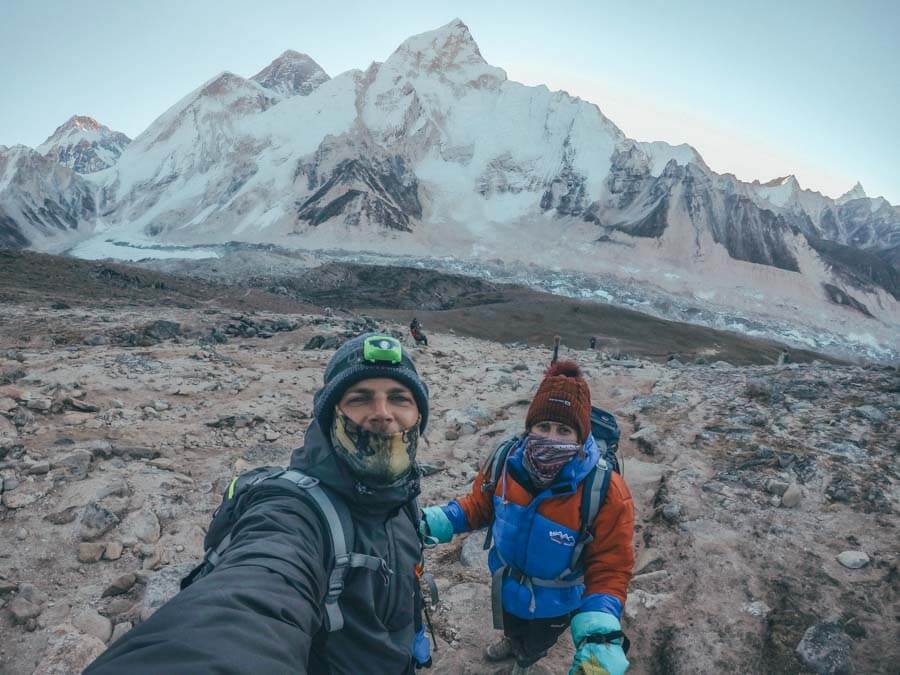
Altitude: Gorak Shep (5 160m) – Kala Patar (5 643m) – Pheriche (4 370m).
Trekking time: 7 hours | 13 km.
Difficulty: This day is difficult, only because of Kala Patthar! The rest is easy as you’ll be going down the mountain to a lower altitude.
Highlight: Everything about the trek up to Kala Patthar. The 5 am wake-up call, the ice-cold temperatures, the steep trail, the incredible view!
Overview: The day starts with an early morning trek to Kala Patthar for the best views of Mount Everest. After returning to Gorak Shep, you’ll head back down to Pheriche.
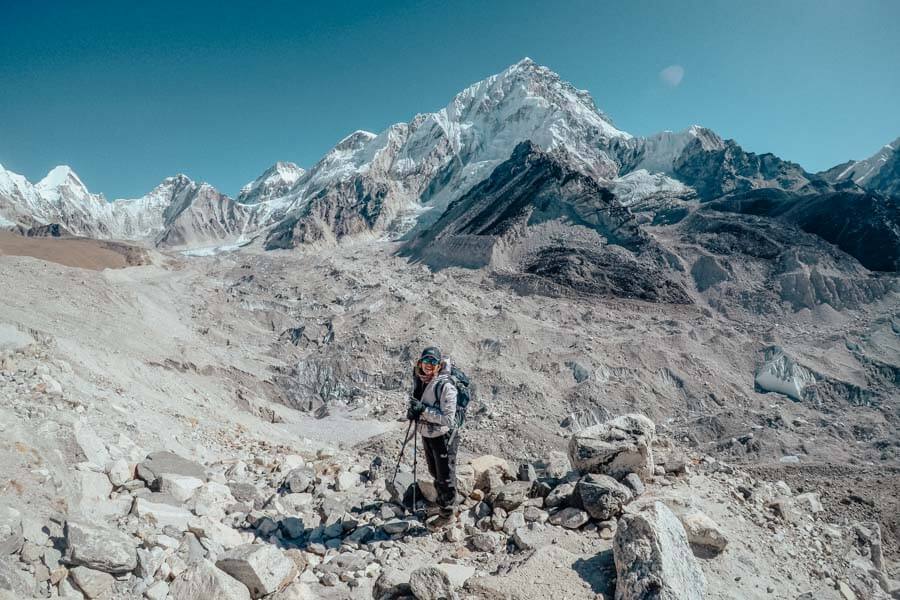
You can’t actually see Mount Everest from Everest Base Camp or Gorak Shep as Lhotse sits in front of it and blocks the view.
This is why people trek to Kala Patthar, which is a nearby viewpoint next to Gorak Shep.
Be prepared for a long and tiring day! Just when you thought it couldn’t get any tougher, day 10 of your Everest Base Camp trek will really push you to your limits.
Sitting at 5 643m, Kala Patthar is a small, rocky peak with a rewarding view of Mount Everest, Changtse, Lhotse, and Nuptse.
Your morning starts with a 5 am wake-up call as you prepare to hike to Kala Patthar. Some trekkers choose to skip this part of the itinerary because they’re too sick and just do not have the energy to make it to the top.
The main goal is Everest Base Camp, right? You’ve made it!
You don’t have to climb Kala Patthar. Listen to your body and if you’re not feeling well, don’t do it! I was incredibly slow, fatigued, and sluggish and only got about ¾ of the way to the top before our guide advised that we turn back.
If we didn’t, we’d fall behind on the day’s schedule.
After climbing Kalla Patthar, we arrived back at our tea house at Gorak Shep at about 9 am, had a quick breakfast then began our long trek past Lobuche and on to Pheriche.
My day hadn’t got off to a good start and I was feeling very weak hiking Kala Patthar, but as soon as we began our downhill climb, I regained my strength and felt like a different person!
Tip: If you’re feeling sick at Gorak Shep, make sure you monitor this but the moment you go to a lower altitude, you will feel stronger.
Tip: If you’re continuing to Island Peak, you can check out my Island Peak guide. To sum it up, from Gorak Shep, you’ll go to Dingboche ( and not Pheriche as this route goes) . After spending the night in Dingboche, you’ll go in a different direction to Chukhung and Island Peak Base Camp.
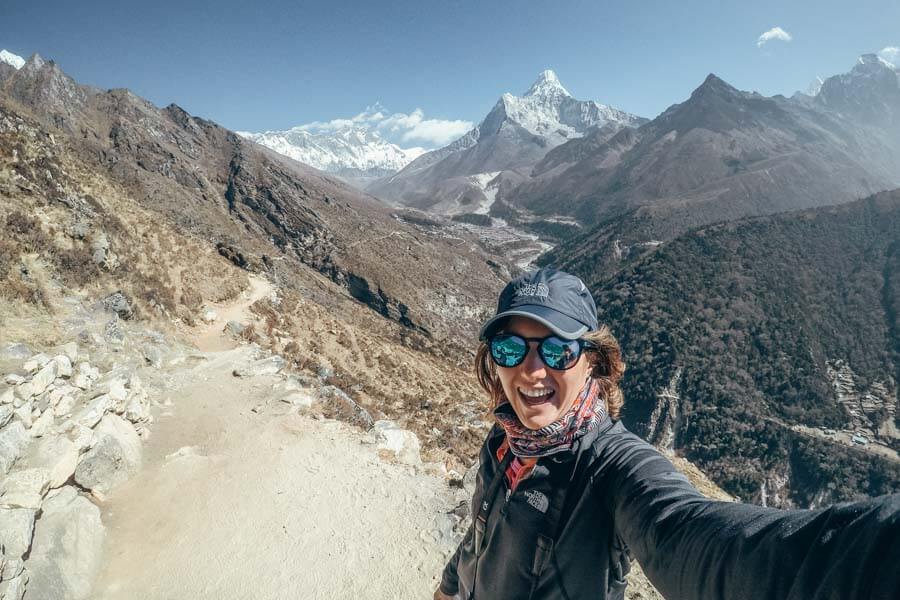
Altitude: Pheriche (4 280m) to Namche Bazaar (3 440m).
Trekking time: 14km | 8 hours.
Difficulty: Easy but a long day of hiking.
This day (and the next) are particularly long and you’ll want to get off the mountain ASAP!
You’ll be running down from Pheriche to Namche Bazaar as it’s so much easier to breathe as the elevation decreases. You’ll also be craving a hot shower, clean clothes, a proper meal, and a warm bed.
Soon, you’ll hit the tree line once again, cross over suspension bridges, and pass scores of mules.
After every corner, you’ll think you’ve reached Namche Bazaar, but it’s further than you expect, and the trail seems to go on forever. On your way down you still have sections where you climb up and down (yes, more climbing), but there’s no altitude gain so who’s complaining!
You’ll pass Tengboche, which is home to the largest monastery in the Khumbu region and the village where most trekkers stop on their way up the mountain (But we chose a different route on this Everest Base Camp trek itinerary).
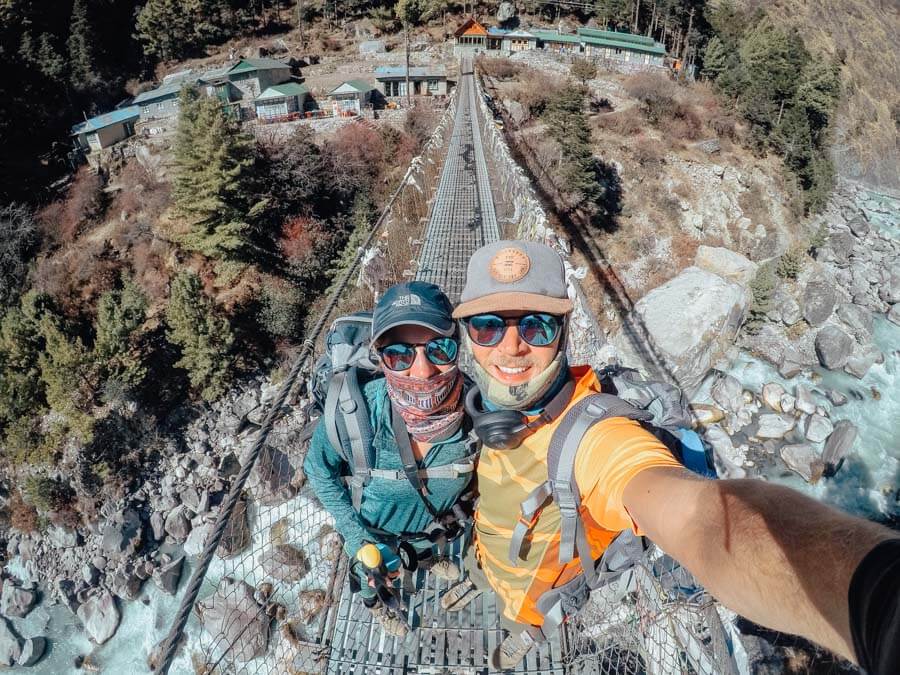
Altitude: Namche Bazaar (3 440m) – Lukla (2 860m).
Trekking time: 18 km | 8 hours.
Difficulty: Same as yesterday! A long day of hiking.
You’ve made it to the last day of your Everest Base Camp trek itinerary! Today you’ll retrace your steps from Day 1 and 2 (except this time you’ll cover the same distance in 1 day, and not 2!)
You’ll also see other trekkers ascending to EBC looking bright-eyed and bushy-tailed. If only they knew what was in store for them over the next few days! You’ll smile at them, and offer words of encouragement, but deep inside, you’ll just thanking your lucky stars that it’s them going up, and not you!
Enjoy your last lunch on the mountains in the village of Phakding before taking on the last section to Lukla. Spend the night in Lukla where you’ll celebrate with a delicious meal and a few cold beers!
Last day of your Everest Base Camp itinerary: Lukla to Kathmandu
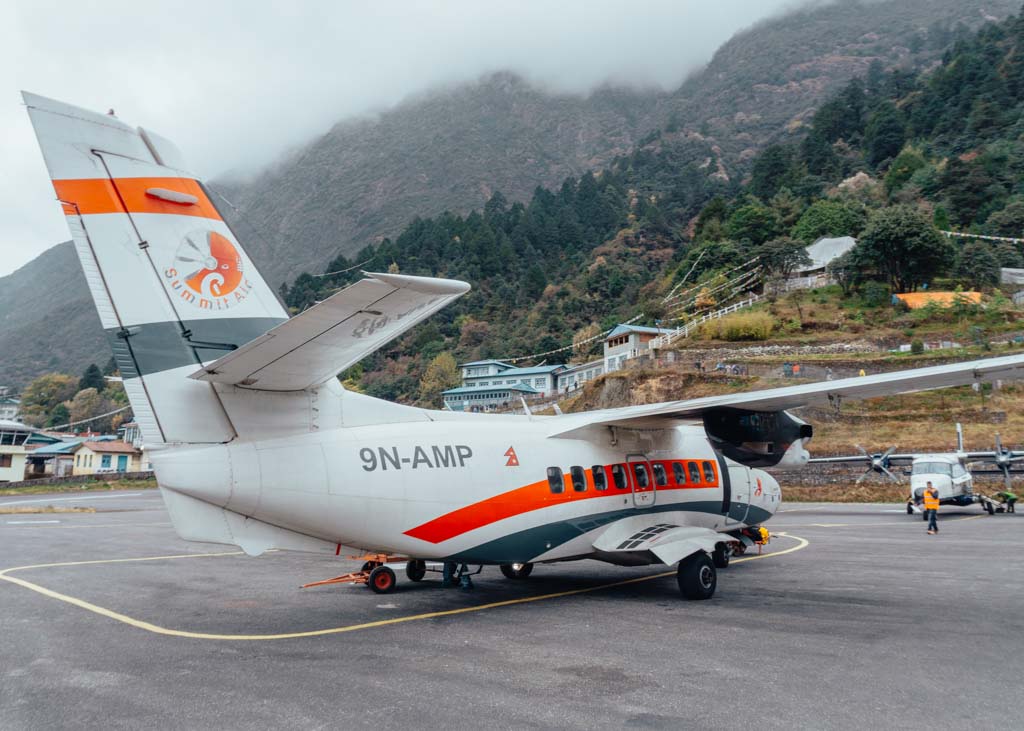
On the last day, you’ll be ready to say goodbye to the mountains! Once again your flight isn’t guaranteed to leave on schedule so one last bit of patience is required.
After I landed in Kathmandu, I went straight to my hotel, had the best hot shower EVER, ordered takeaways, hopped into bed, and didn’t leave my room for 24 hours! Those 24 hours of doing nothing were absolutely incredible!
Pictures speak a thousand words! After going through my EBC trek itinerary, check out my photo diary with includes all the highlights of my trek to Everest Base Camp.
Is Everest Base Camp trek worth it
Absolutely – But it’s not easy! From the terrifying flight into Lukla to the long trekking days, freezing cold tea houses, weeks with no showers, dealing with altitude sickness, and all the aches and pains that come along with it – It’s brutal.
But the experience is incredible and you’ll gain memories that will last a lifetime!
Should you plan your Everest Base Camp Itinerary with a tour or not
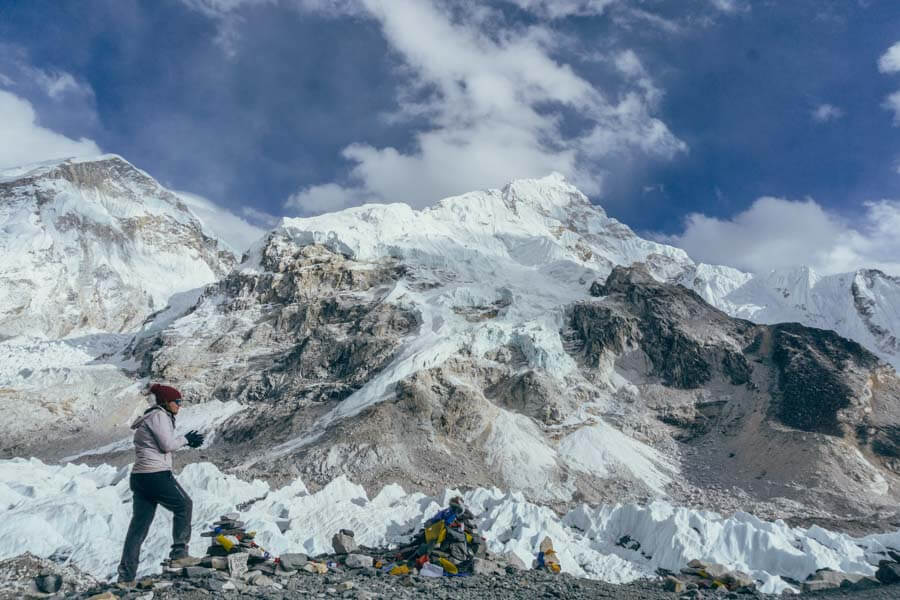
This one’s debatable!
In 2014 I summited the highest mountain in Africa, Mount Kilimanjaro . For this trek, you have to book a tour through an organized trekking company. I thought the same would apply to Everest Base Camp and wrongly assumed that attempting to conquer EBC independently was only for broke backpackers or highly experienced hikers.
I was wrong! You can definitely navigate the Everest region without a guide and many people do so.
However, I don’t regret booking through a trekking company, Mountain Monarch . Here’s why.
Why I booked my EBC trek with a tour group

Firstly, I added Island Peak to my Everest Base Camp itinerary. For this extra section of the trek, a guide is required. Whilst Everest Base Camp requires no technical climbing, Island Peak does and it’s intense.
If you’re up for the challenge, I highly recommend you add Island Peak to your Everest Base Camp tour. You can read about my climb to Island Peak here!
Secondly, I had previous experience with high altitude climbing and if it wasn’t for my skilled guide, I wouldn’t have made it to the summit of Mount Kilimanjaro. As with Kili, getting to Everest Base Camp is tough and reality is that it can be fatal. You need to pace yourself. Many people are put on oxygen and need assistance and those who trek independently don’t have immediate access to these emergency services.
And lastly, the fellow trekkers that I met on my Everest Base Camp tour were the best teammates anyone could ask for. I loved the support, the humor, the motivation, and having a small group of people who were there for me through thick and thin. As you get to the end of your Everest Base Camp trek, you’re going to need all the support you can get.
Final thoughts on how to plan a trek to Everest Base Camp
Trekking to Everest Base Camp is tough. Looking back, there are so many moments where I was thinking “ Why the F$%# did I sign up for this ” and “ With this money, I could’ve spent an extra 3 months backpacking instead of putting myself through this torture “.
But, challenging myself, my mind, my body – and crushing my goal and STILL going on to summit Island Peak – man, you cannot beat that feeling!
Are you planning a trip to Everest Base Camp? Looking for more information on how to get from Lukla to Everest Base Camp? Drop me a question in the comments section below!
Psst… Looking for epic adventures to add to your bucket list? Check out my other posts!
- Complete Guide To Island Peak Climbing in Nepal
- The Perfect Everest Base Camp Packing List
- 10 Things You Need To Know For Your Kilimanjaro Trek
- Everest Base Camp Trek Difficulty: 11 Key Things You Need To Know
- Everest Base Camp Trek with Island Peak Climbing: My Highlights and Photo Diary
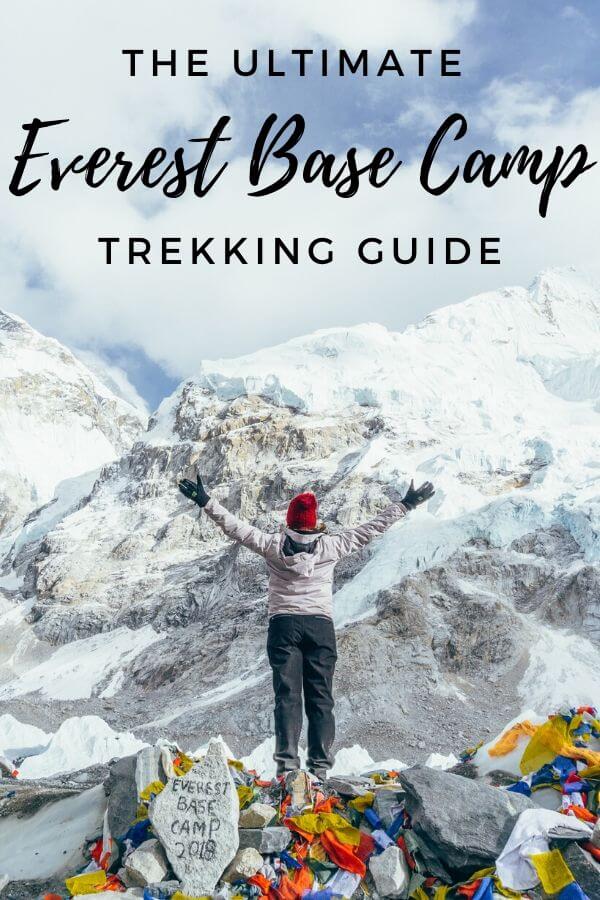
Hi, I'm Carryn. I’m an adventure travel blogger trying to figure out my way through life by traveling and exploring. Join me as I share my travel guides and tips for life abroad. Find out more about me here .
Backpacking Indonesia: 26 Things I Wish I Knew
Everest base camp trek difficulty: 12 key things you need to know, 24 thoughts on “the ultimate everest base camp trek itinerary: how to get from lukla to everest base camp”.
Wow! Sounds like such an adventure. I loved reading your in depth post about your Everest base camp itinerary. It sounds like there is so much that goes into preparing but definitely sounds like you had the adventure of a lifetime.
Thanks Ann. It sure was an adventure I’ll never forget!
Ok, this post was epic – so much information I have to save it. Thanks for sharing!
Thanks Laura! Glad you found it helpful.
this is absolutely breathtaking! i honestly don’t know if I would ever be prepared to do this myself, but your day by day break down was really helpful!
Thanks Claire! Looking back at the photos I’m still in shock that I managed to get to Everest Base Camp!
Amazing. What a trek and journey for your mind, body and soul!
It was indeed!
This is epic! Im going in April and I’m so excited. Ive done Annapurna base Camp and loved it so I’m sure ill love this too!
Hi Emma, Good luck for your trek! I’d love to hear how EBC compares to Annapurna.
So interesting to read about your experience! I’m going to Nepal soon to do the Annapurna base camp and mardi Himal. They have a lower altitude but I’m still a bit nervous because of the altitude sickness 🙆🏼♀️
Hi Nina, I’m sure you’ll love it. Just take your time and don’t be afraid to walk super slow (like I did)!
WoW! This sounds like one amazing trip and one I’m sure that you will never forget! Really inspiring
Thanks Lori. EBC tops my bucket list so now I’m looking for the next adventure to conquer!
Wow! This sounded so intense! What an experience to say that you’ve done it.
It was tough, but everyone goes through a different experience. I thought about turning back so many times, but I’m so glad I stayed strong and kept going!
Wow! What an incredible experience, I don’t know if I’m ready for it but you definitely gave me some things to think about, thanks for sharing!!
Thanks Meghan!
Amazing!!! Wonderful recap! EBC isn’t easy! That was my first dance with altitude! Need to get back to do Island Peak!!!
Hey Bridget, Island Peak is incredible and I’m so glad I added it to my Everest Base Camp itinerary. Congrats on making it to base camp!
BADASS! I love that you mentioned a longer itinerary to acclimatize (is that the right word? lol) naturally and a way to get off the beaten path for this popular trek! I hope to make the Everest Base Camp Trek in the coming years and this is definitely a guide I will come back to help plan (: AND CONGRATS on killing it on this hike! So epic!
Hay Aaren, thanks for the kind message! I’m so stoked that I made it to base camp. And you can to! If you ever decided to trek to EBC, let me know!
Congrats on choosing the High Scenic Trail via Mong La and Phortse instead of the crowded Tengpoche route 95% of trekkers use. The best kept secret in Khumbu is finally leaking out!
About helicopter traffic: Google [helicopter rescue scam Nepal] and be educated. Multimillion dollar business now, thousands of EBC trips destroyed every year with this insurance fraud.
Hi Petrus, Agree – the less crowded route is far better!
Leave a Comment Cancel reply
Ace the Himalaya
Trekking in Nepal, Peak Climbing, Mt Biking and Tours in Nepal, Bhutan and Tibet
- Everest Base Camp Trek - 14 Days
- EBC Trek with Helicopter Return - 12 Days
- Everest Base Camp Luxury Trek - 14 Days
- Everest Base Camp with Island Peak - 19 Days
- Everest Three Passes Trek - 20 Days
- Annapurna Base Camp Trek - 13 Days
- Annapurna Circuit Trek - 19 Days
- Ghorepani Poon Hill Trek - 9 Days
- Manaslu Circuit Trek - 15 Days
- Gokyo to Everest Base Camp Trek - 17 Days

Everest Base Camp Trek Distance
Ever wondered about the distances that shape the Everest Base Camp trek? Our blog unravels the mystery, offering a step-by-step breakdown of the path to Everest's doorstep.
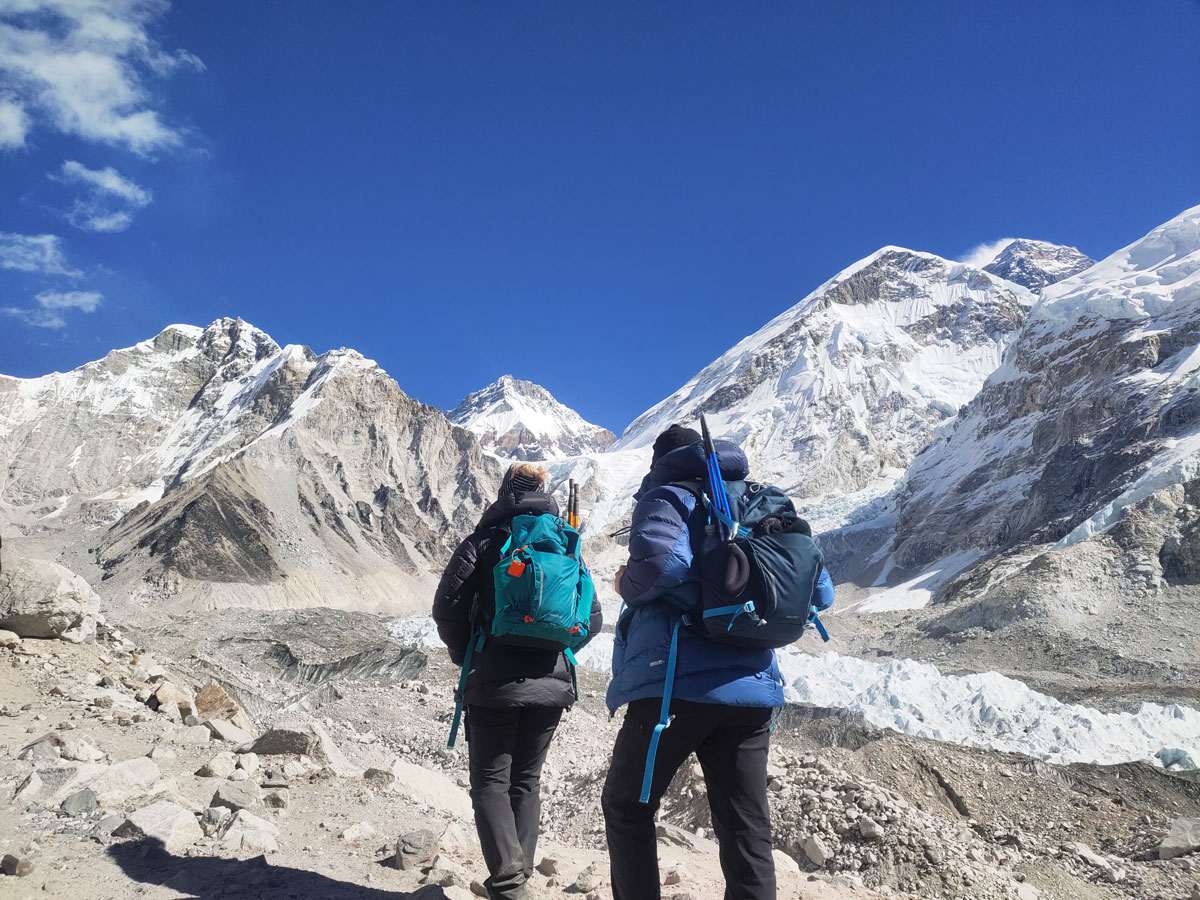
The Everest Base Camp trek is a remarkable adventure that offers a rare opportunity to explore the heart of the Himalayas.
Likely due to its monumental reputation, a commonly posed inquiry among enthusiasts bidding to make it to EBC revolves around the distance and duration of the trek.
As trekkers traverse the same paths once treaded by predecessors on their journey to the summit , they run across elaborate landscapes and ingrained cultural sentiments that defy expectations.
How long is the trek to Everest Base Camp?
Covering approximately 130 kilometers or 80 miles from Lukla to the Everest Base Camp and back, the EBC trek experiences a substantial altitude gain along the 14-day trek, its elevations emphasized both as a challenge and thrill.
Commencing with a scenic flight from Kathmandu to Lukla , which sets the stage for an exciting journey ahead, the trail unfolds with stops at captivating destinations such as Namche Bazaar, Phakding, Tengboche, Gorakshep, Dingboche and many more.
Throughout these destinations trekkers are treated to a visual feast of beautiful mountains, diverse vegetation and landscapes that shift with each step.
Beyond the physical adventure and natural beauty, the EBC trek is also a cultural pilgrimage. The rich tapestry of Sherpa heritage, their unique traditions and the Himalayan way of life encourages a deeper connection between the locals and the trekkers.
The Everest Base Camp trekking is an experience etched in the memory of those fortunate enough to have walked the magnificent trail.
Among various highlights, the pinnacle of the trek unfolds at the arrival at EBC, surrounded by towering peaks and the awe-inspiring Khumbu icefall, it is a moment of triumph and profound serenity.
Overview of the daily distances on the Everest base camp trek
Below is a tabulated outline of the distances between various locations along the Everest Base Camp trail, alongside the corresponding duration required to reach each destination:
Day 2: Lukla to Phakding (3 to 4 hours, 8.2 Km)
The trek officially begins after a scenic flight that lands at Lukla (2,840m) from Kathmandu, the capital city of Nepal.
Trekkers begin with a gentle descent to Chheplung from Lukla accompanied by the Dudhkoshi river to their left. Along the way, the captivating sight of Mount Kusum Kanguru (6,367m) unfolds at Thado Koshigaon, further leading to Ghat.
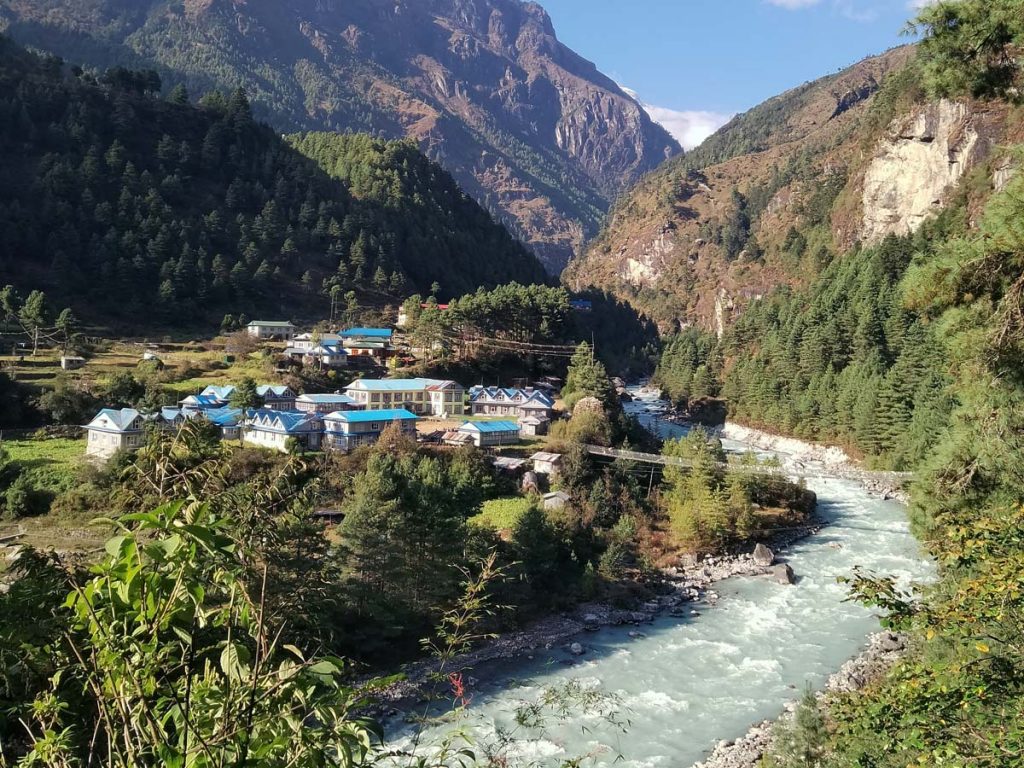
Unlike the initial portion of the trail, the concluding stretch from Ghat presents a gentle ascent, culminating at an altitude of 2,610m at Phakding.
Covering 8.2 kilometers, the trek from Lukla to Phakding is an approximately three-hour expedition through various suspension bridges and picturesque sherpa villages.
Day 3: Phakding to Namche Bazaar (6 to 7 hours, 12 Km)
On the 3rd day of the trek, through a slightly undulating trail, trekkers eventually get from Phakding to Monjo.
The path continues along the Dudhkoshi river and sets through a series of suspension bridges, and charming little villages to get to Bengkar where the majestic Thamserku (6,608m) looms into view.
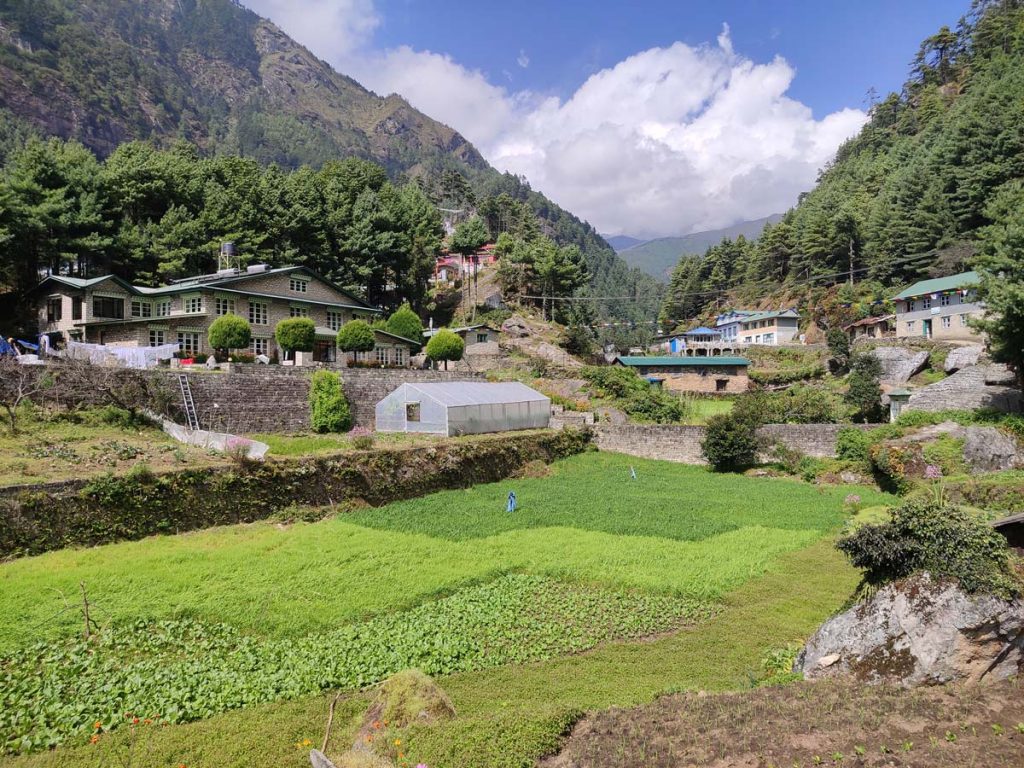
From Bengkar, the trail descends bringing trekkers to Jorsale while the trail identically fluctuates until the Hillary Bridge, named after Sir Edmund Hillary himself, also the last suspension bridge of the day.
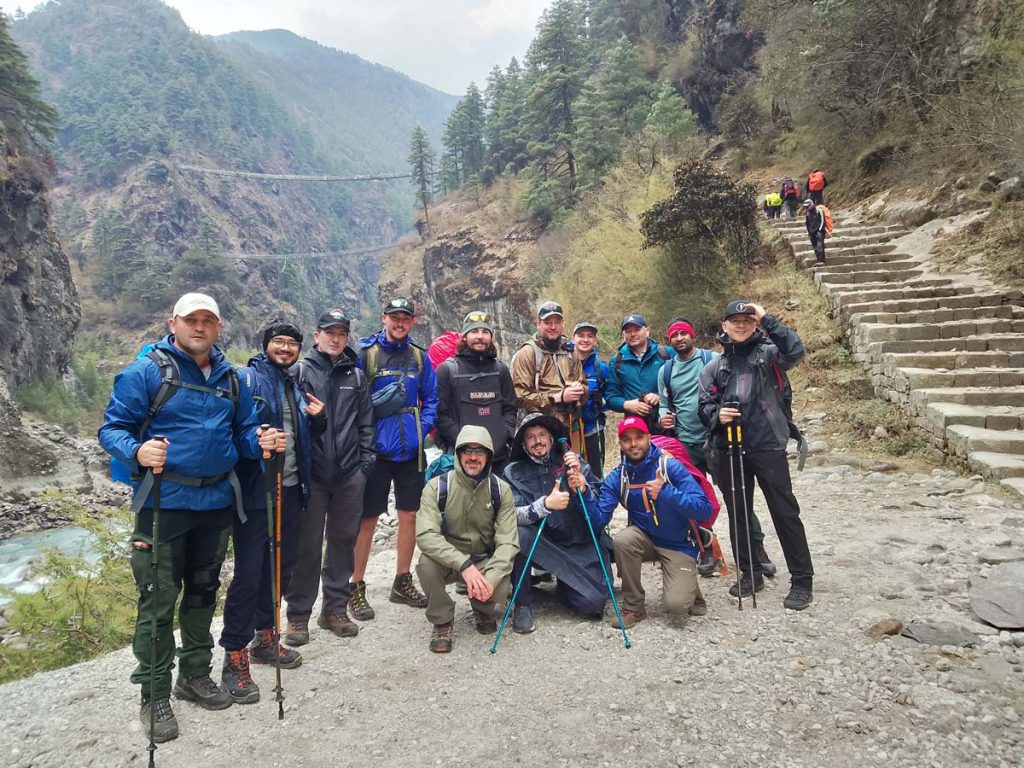
The 12-kilometer trek concludes after a steady 2.5-hour ascension to reach the bustling Sherpa town Namche Bazaar .
Day 4: Namche Bazaar acclimatization (4 to 5 hours, 5.4 Km)
The acclimatization trek begins with an ascension to Everest Viewpoint followed by the picturesque village of Syangboche, renowned among trekkers for its captivating views.
Further, trekkers navigate a dominantly flat trail to get to Hotel Everest View (3,880m).
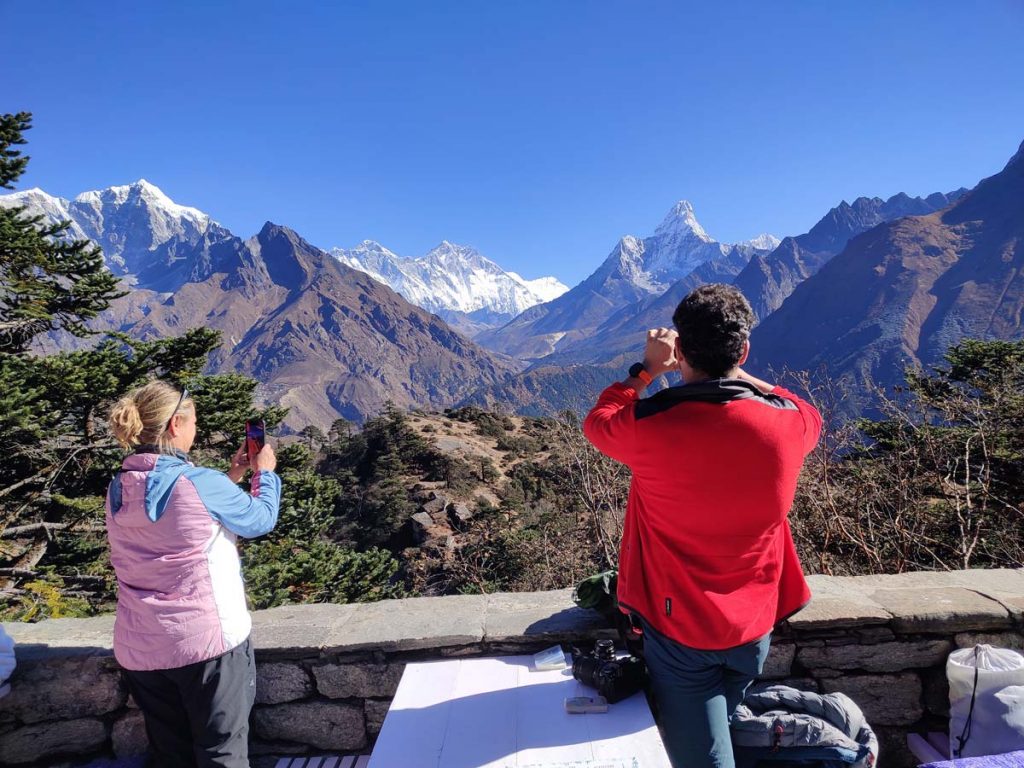
Boasting awe-inspiring vistas of peaks like Mount Everest (8,849m) , Lhotse (8,516m) , Nuptse (7,861m), and Ama Dablam (6,812m), Hotel Everest View is another popular viewpoint in the Khumbu region.
Ending with a descent from Hotel Everest View back to Namche Bazaar, the journey accumulates to roughly 4 hours and covers 5.4 kilometers.
Day 5: Namche Bazaar to Tengboche (5 to 6 hours, 10.5 Km)
The journey from Namche Bazaar to Tengboche commences with a trek to Kenjoma along its well-made, leveled yet undulating path.
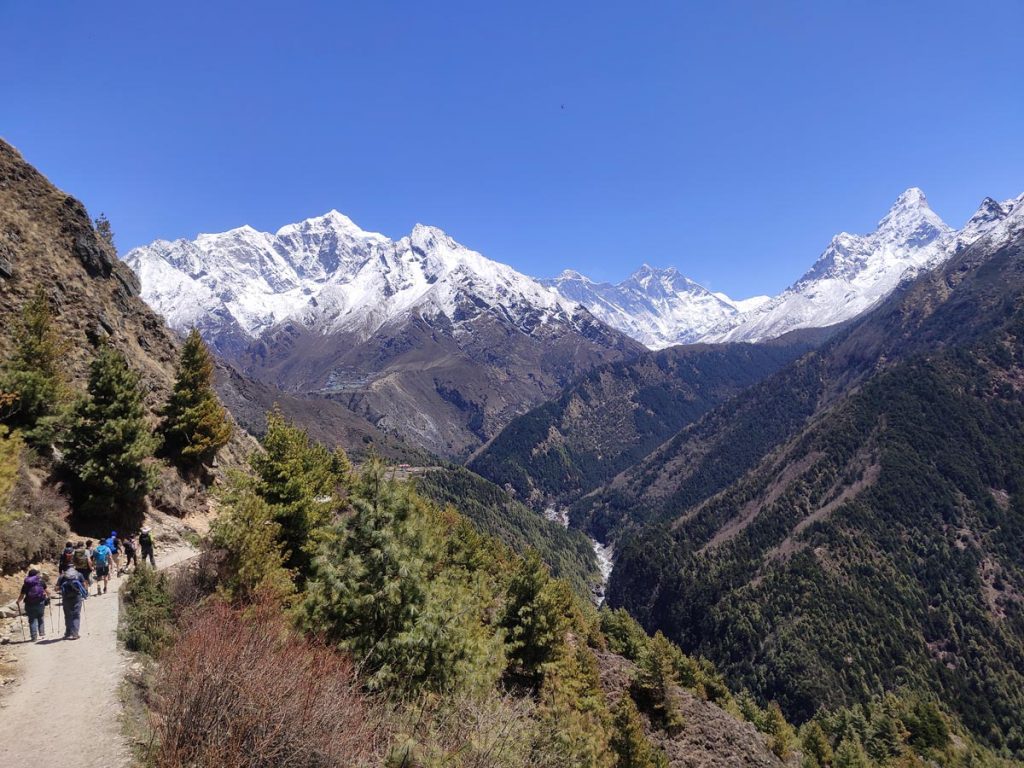
Following a gentle descent from Kenjoma trekkers reach Phunke Tenga where the breathtaking sights of majestic mountains like Kangtega (6,782m) and Thamserku (6,608m) unfold before them.
It is upon arrival at Tengboche that trekkers are rewarded with an even more intimate perspective of the surrounding mountains, enhancing the surreal beauty of the landscape.
Day 6: Tengboche to Dingboche (6 to 7 hours 11.5 Km)
On the 6th day of the trek, the journey from Tengboche (3,860m) to Dingboche (4,410m) spans 11.5 kilometers and takes approximately six hours to complete.
The trail beginning from Tengboche to Deboche is a gentle descent leading to Pangboche where trekkers are required to navigate a few suspension bridges.
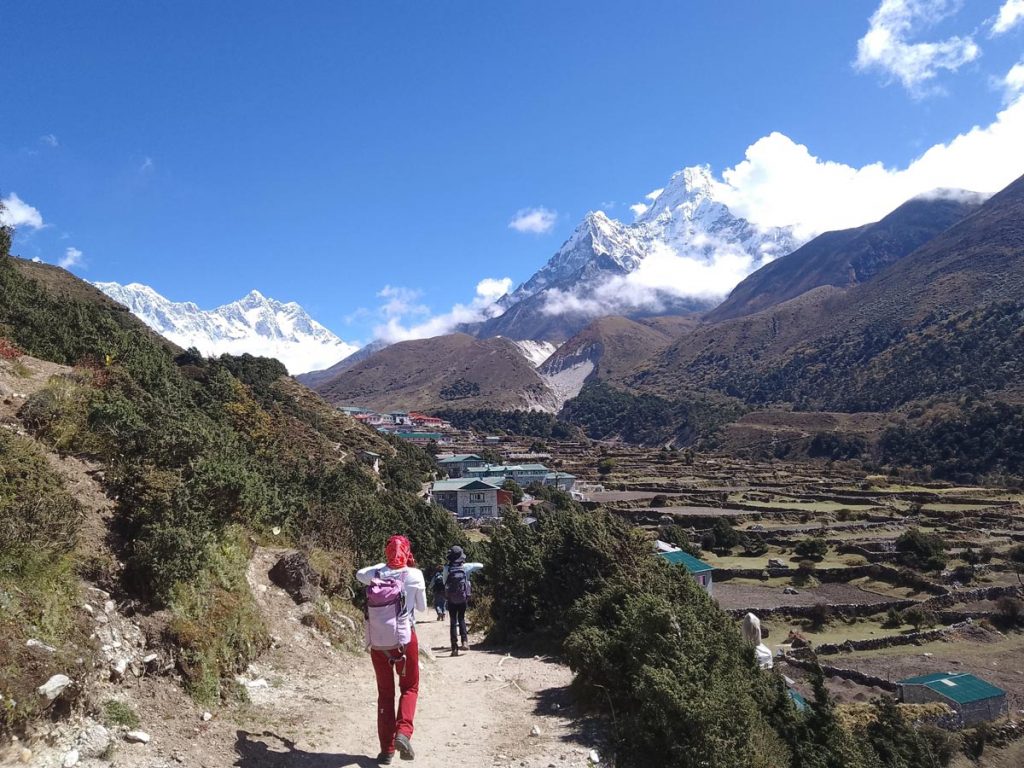
Pangboche a typical farm village, is renowned for cultivation in the area. Here, trekkers can also spot various massive mountains up-close.
Following a mild ascent while crossing the tree line, the final stretch where trees are still visible, trekkers reach Somare.
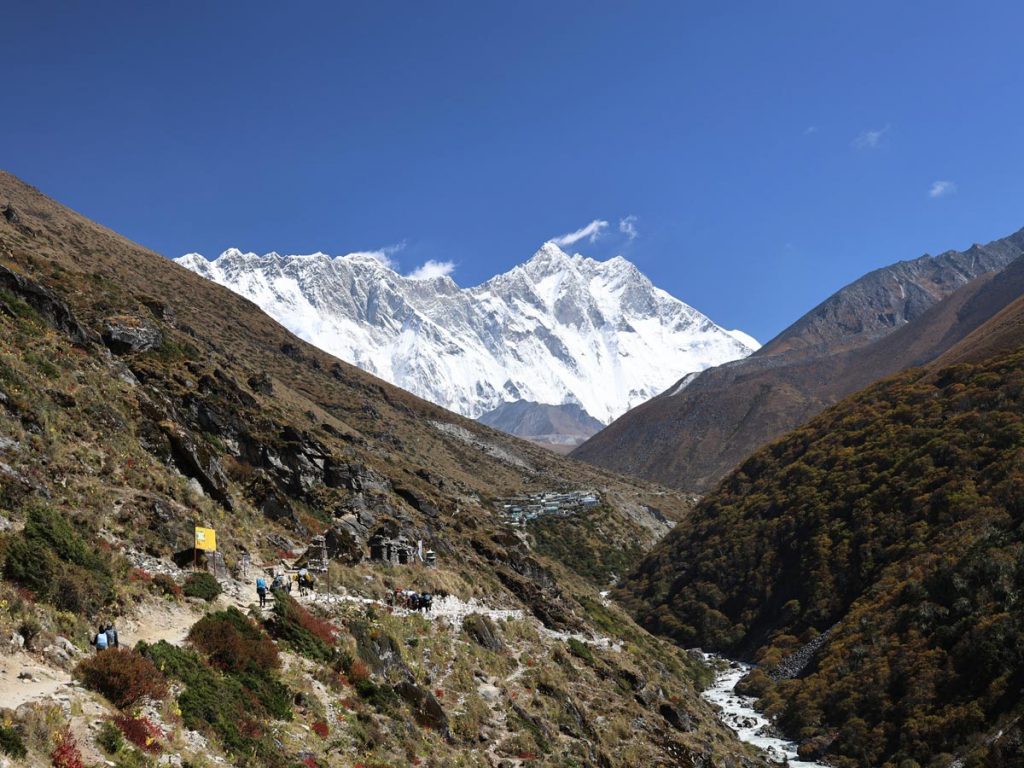
The final walk from Somare to Dingboche rewards trekkers with a closer view of mountains like Ama Dablam (6,812m), Nuptse (7,861m) and Lhotse (8,516m).
Further at Dingboche, you can also see mountains like Peak 38 (7,590m), Island Peak, Mount Chiumo (6,890m), and Ama Lapcha.
Day 7: Dingboche Acclimatization (5 to 6 hours, 5.1 Km)
Dingboche serves a pivotal role as an acclimatization point following Namche Bazaar. The trek begins with a demanding uphill ascent to reach the summit of Nangkartshang Peak (5,083m) .
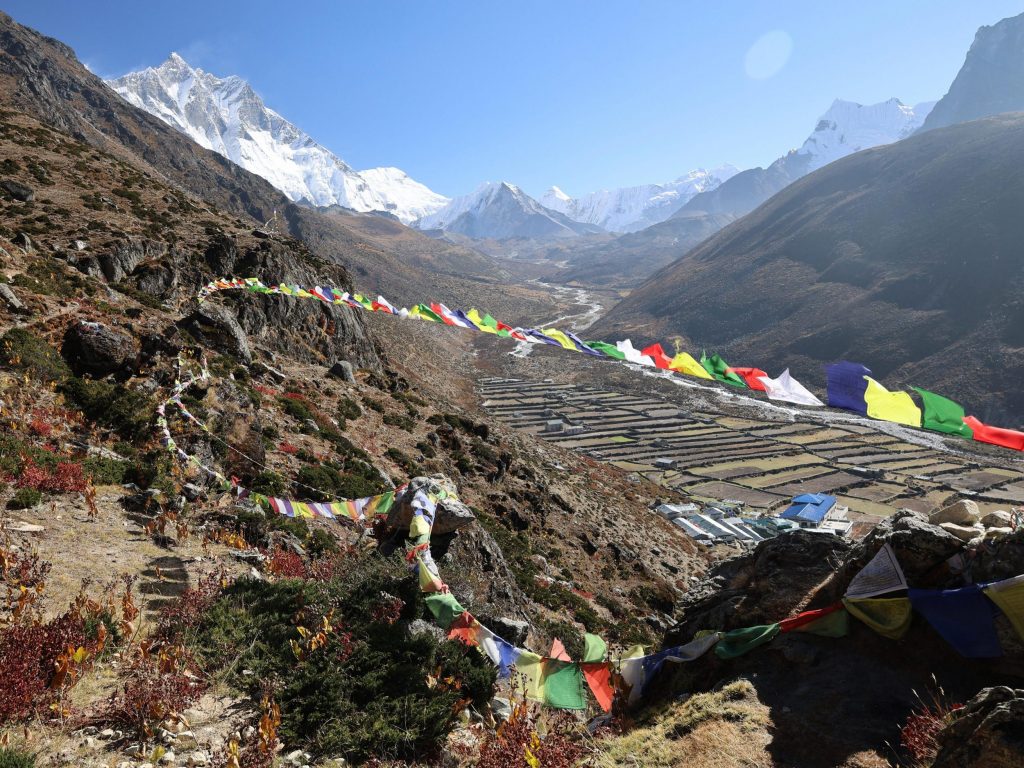
From the peak, trekkers can catch a panoramic view of mountains like Lhotse (8,516m), Nuptse (7,861m), Cho Oyu (8,188m), Ama Dablam (6,812m), Peak 38 (7,590m), Makalu (8,481m), Kusum Kanguru (6,367), and Baruntse (7,163m) gracefully surrounding the peak.
The acclimatization journey concludes as trekkers make their way back to Dingboche after having covered a total distance of 5.1 kilometers.
Day 8: Dingboche to Lobuche (5 to 6 hours, 8 Km)
On the 8th day, trekkers set out for Lobuche (4,910m), embarking on a roughly 5-hour long journey covering approximately 8 kilometers.
The path from Dingboche to Thukla involves a gentle ascent, offering trekkers glimpses of several mountains including the flanks of Cho La, Taboche (6,495m), and Cholatse (6,440m).
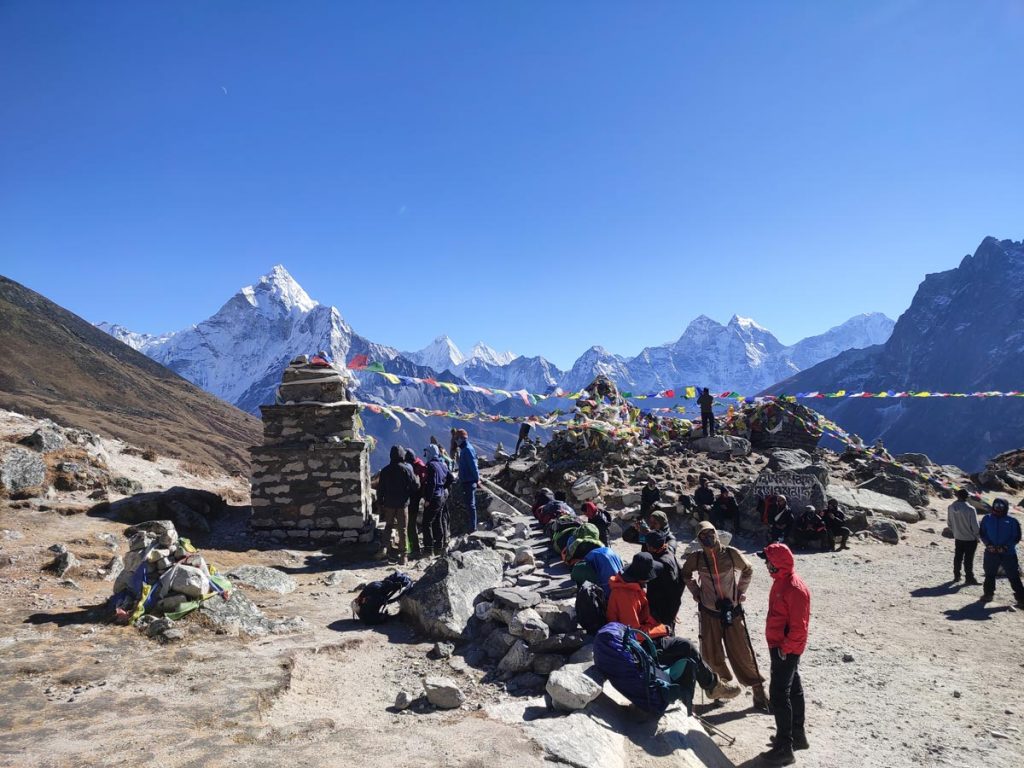
Ascending through the Khumbu Khola valley, the trail gradually leads to Thukla and continues upward until Thukla Pass.
Beyond the Thukla pass, the terrain transforms into a more rugged and barren landscape as trekkers approach Lobuche.
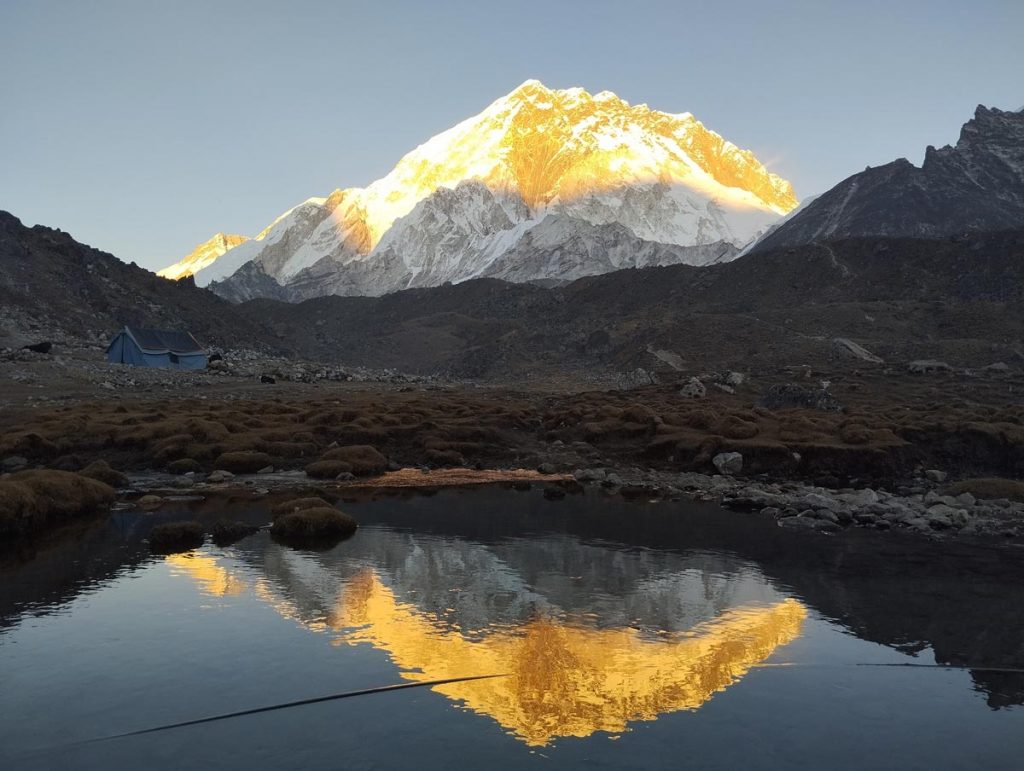
Lobuche further welcomes trekkers with captivating views of various mountains like Nuptse (7,861m) Changri (6,027m), Pumori (7,161m), and Lho La (6,006m).
Day 9: Lobuche to Everest Base Camp and back to Gorakshep (8 to 9 hours, 11.7 Km)
On the 9 th day trekkers journey towards Gorakshep (5,190m), beginning with a smooth ascent the concluding section of the trek is fluctuating and rocky.
The trek from Gorakshep to the Everest Base Camp is also a similarly undulating terrain, with frequent ascents and descents.
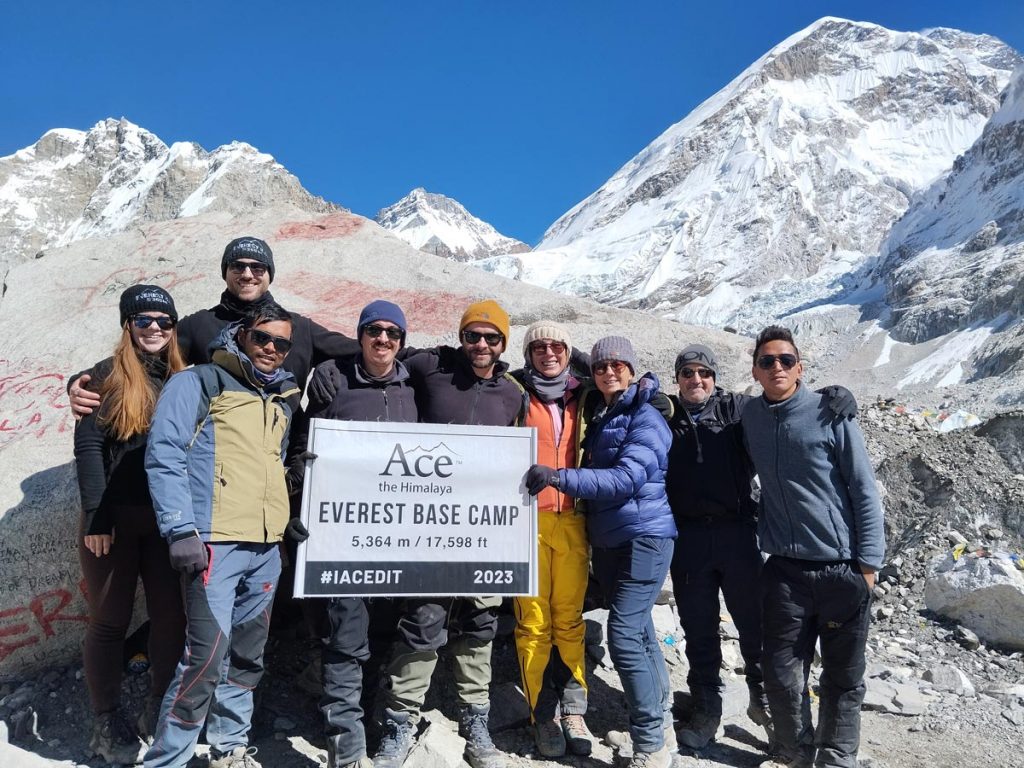
Upon reaching Everest base Camp, trekkers are rewarded with intimate views of the majestic Himalayan peaks.
Day 10: Hike to Kala Pathhar and descent to Pheriche (8 to 9 hours, 15.2 Km)
The ascent to Kala Pathhar (5,555m) from Gorakshep is an entirely uphill trek through steep, challenging terrain.
Upon reaching Kala Pathhar trekkers are rewarded with breathtaking 360-degree views of prominent mountains like Pumori, Lingtren (6,749m), Lho La, Mount Everest (8,849m), Lhotse (8,516m), Nuptse (7,861m), Ama Dablam, Kangtega (6,782m), Thamserku, Taboche, and Changri.
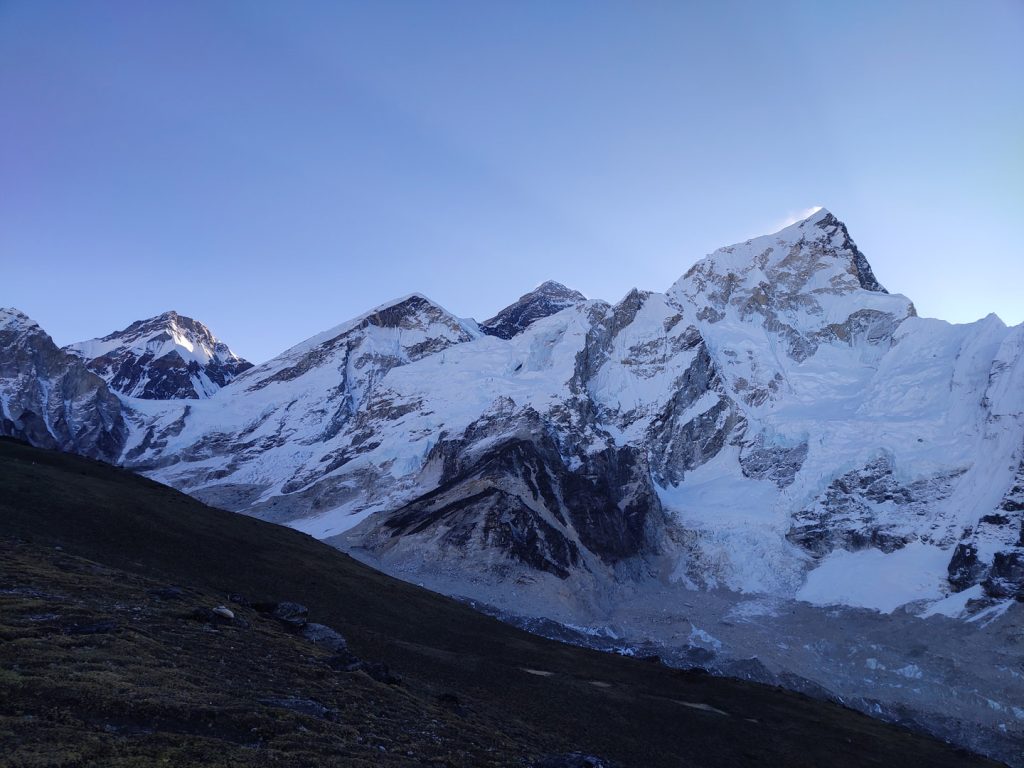
Descending back to Pheriche, trekkers retrace their steps through the same route used at the time of ascension, passing through Lobuche and Thukla Pass.
It is after Thukla Pass that trekkers diverge towards Periche, concluding their trek for the day.
Day 11: Periche to Namche Bazaar (7 to 8 hours, 19.5 Km)
The descent from Periche to Namche Bazaar constitutes the longest trek of the journey, encompassing a total distance of roughly 19.5 kilometers to be covered in approximately seven hours.
Trekkers retrace their steps through familiar landmarks with a beginning descent from Somare and gradually progress through Pangboche, Deboche, and Tengboche.
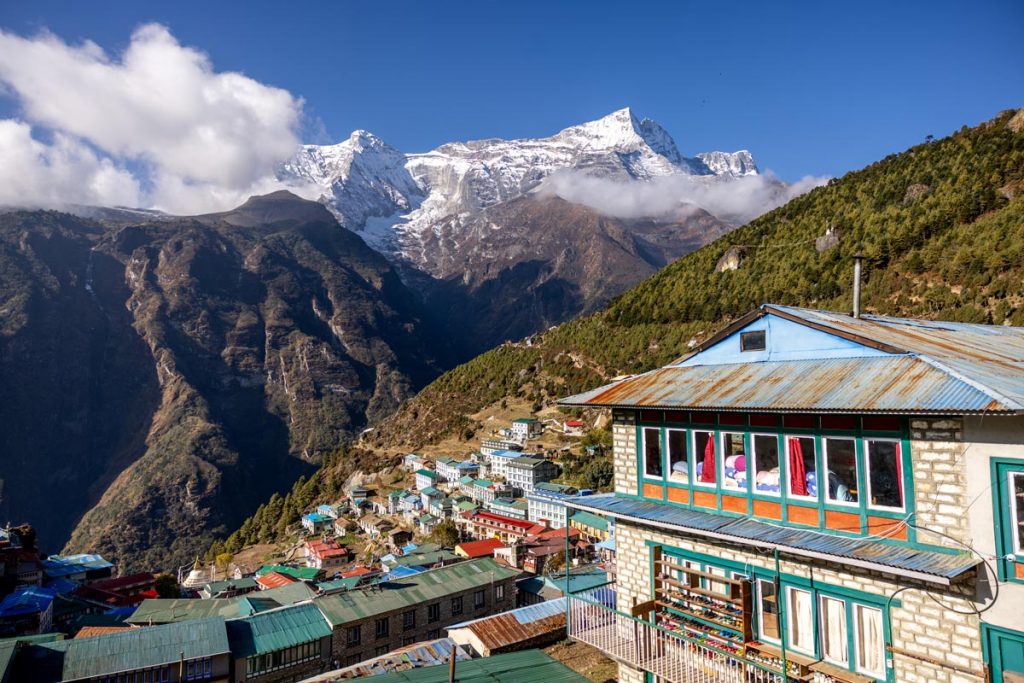
Only experiencing a significant descent at Phunke Tenga, trekkers ascend to Kenjoma and finally reach Namche Bazaar following a flat steady terrain.
Day 12: Namche Bazaar to Lukla (8 to 9 hours, 20 Km)
Namche Bazaar to Lukla marks the official conclusion of the Everest Base Camp trek.
Offering trekkers another opportunity to revisit familiar paths, this trek too retraces the trail taken at ascension.
Beginning from the descent to the Hillary Bridge, trekkers follow a fluctuating but steady trail through Jorsale, Monjo, Phakding and Chheplung.
Upon reaching Chheplung trekkers make a gentle ascent for a few meters to arrive at Lukla, the very destination where the trek concludes.
Related Blogs & Articles
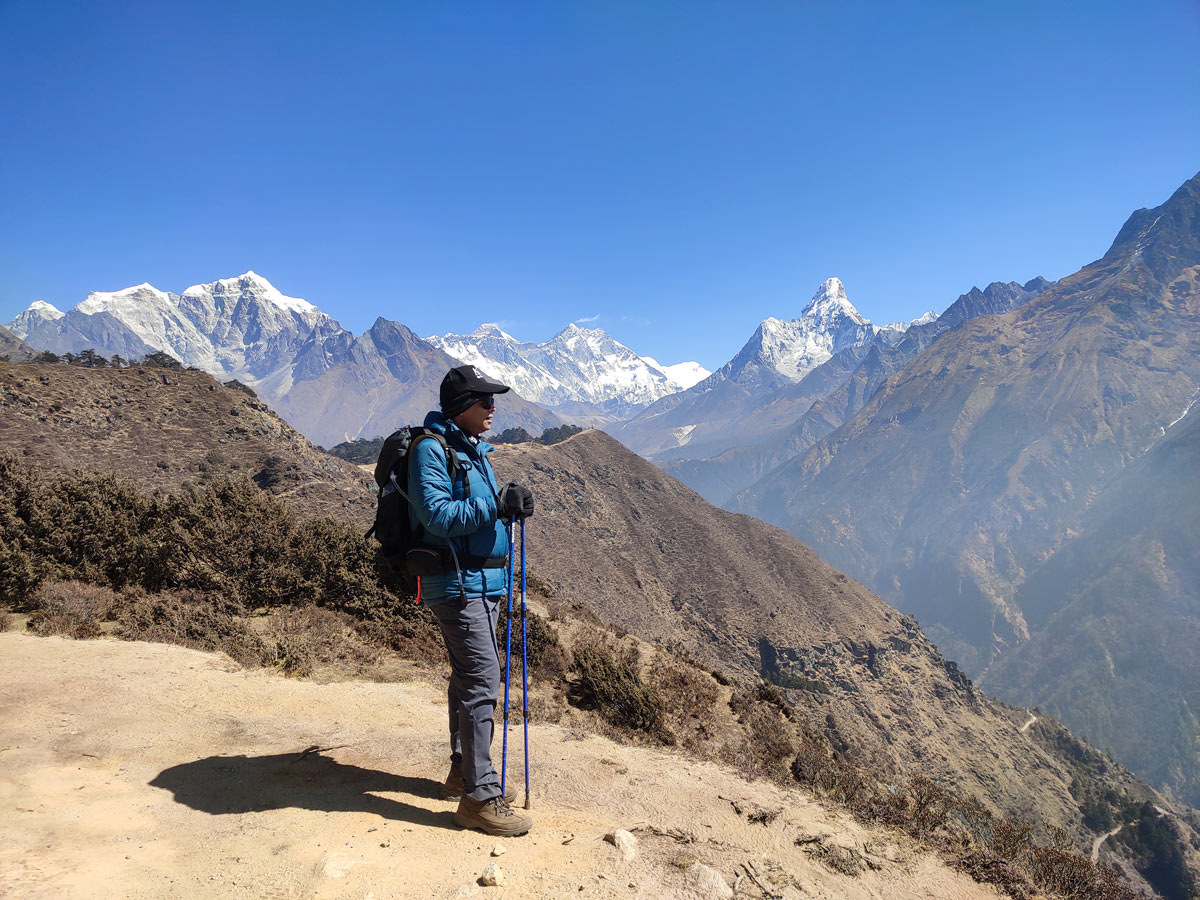
How physically fit should you be for Everest Base Camp Trek?
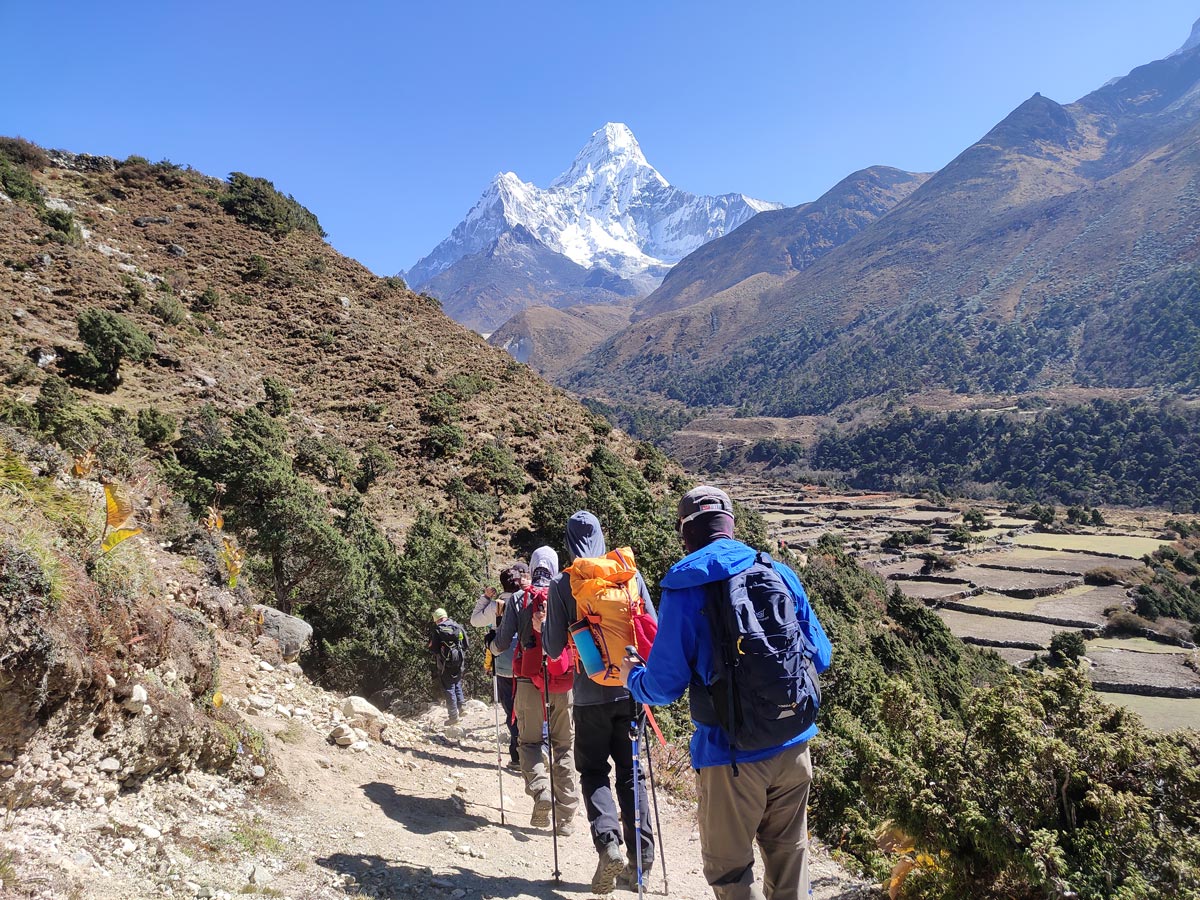
Shower and Laundry Services During Everest Base Camp Trek
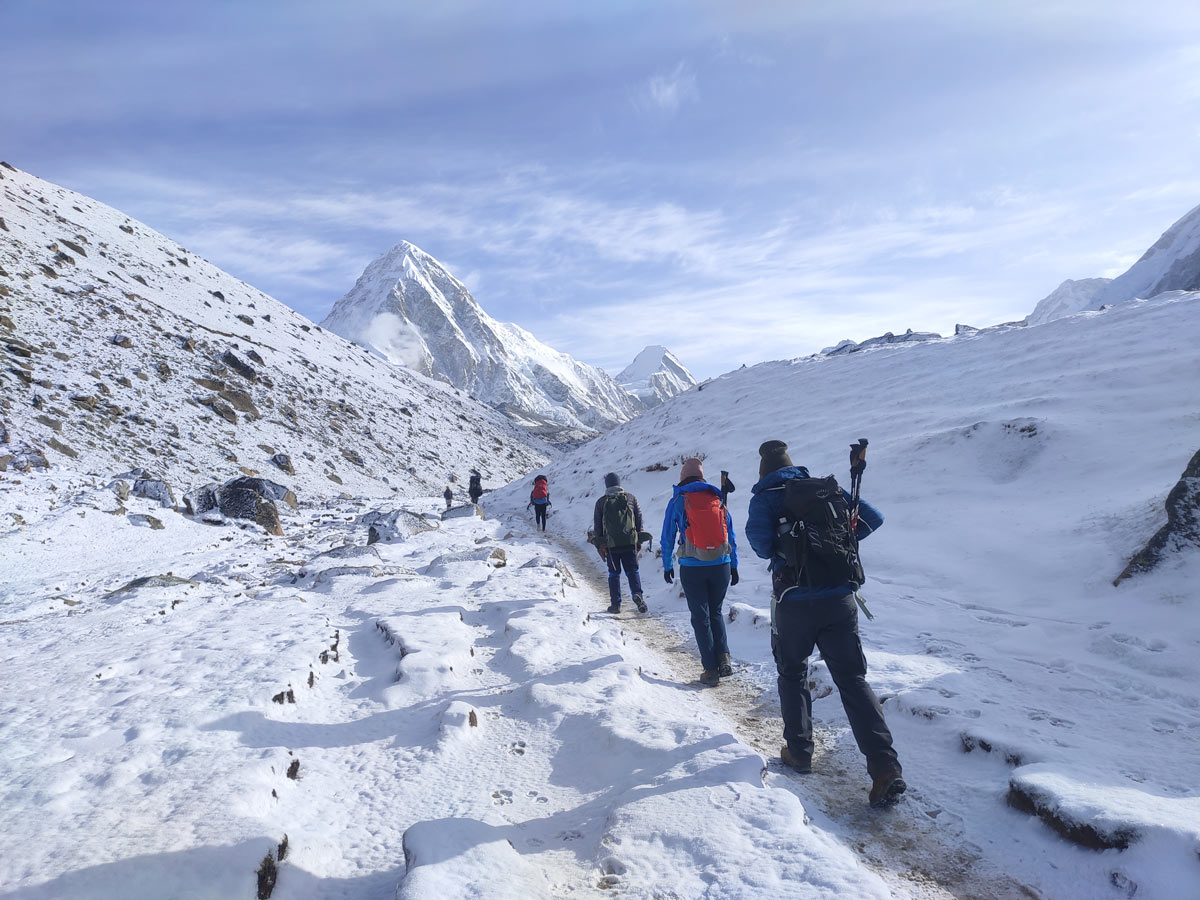
Demystifying Everest Base Camp Trek Difficulty: What You Need to Know

- Comments This field is for validation purposes and should be left unchanged.
Trekking in Nepal
Climbing and expedition, cultural tour and sightseeing, cycling and mountain biking, luxury treks, luxury tours, multi country tours, voluntourism trips, extend your trip.
- Everest Panorama Trek – 9 Days
- EBC Trek with Helicopter Return – 12 Days
- Everest Base Camp Trek – 14 Days
- Gokyo Lake Trek – 13 Days
- Gokyo and Renjo La Pass Trek – 14 Days
- Everest Base Camp Trek without Lukla Flight – 17 Days
- Gokyo to Everest Base Camp Trek – 17 Days
- Everest Base Camp with Island Peak – 19 Days
- Everest Three Passes Trek – 20 Days
- Everest High Passes and Island Peak – 23 Days
- Classical Everest Base Camp Trek – 21 Days
- Langtang Valley Trek – 10 Days
- Langtang Valley Ganja La Pass Trek – 14 Days
- Langtang Helambu Trek – 17 Days
- Ghorepani Poon Hill Trek – 9 Days
- Mardi Himal Trek – 10 Days
- Annapurna Base Camp Trek – 13 Days
- Himalayan Highlights – 13 Days
- Nar Phu Valley Trek with Annapurna Circuit – 18 Days
- Annapurna Circuit Trek – 19 Days
- Tilicho Lake Trek With Thorong La Pass – 19 Days
- Khopra Danda Trek – 11 Days
- Shivapuri-Chisapani Trek – 4 Days
- Upper Mustang Trek (Drive & Trek) – 16 Days
- Tsum Valley Trek – 16 Days
- Manaslu Circuit Trek – 15 Days
- Dhaulagiri Circuit Trek – 21 Days
- Upper Dolpo Trek – 25 Days
- Kanchenjunga Base Camp Trek – 29 Days
- Yala Peak Climbing – 13 Days
- Island Peak Climbing – 15 Days
- Mera Peak Climbing – 19 Days
- Everest Base Camp and Lobuche East – 18 Days
- Tent Peak Climbing with Annapurna Base Camp – 18 Days
- Pisang Peak and Thorung La Pass – 21 Days
- Ama Dablam Expedition – 29 Days
- Kathmandu Cultural Heritage Tour – 3 Days
- Kathmandu Heritage – 3 Days
- Inheritances of Kathmandu – 4 Days
- Glimpses of Kathmandu & Nagarkot – 5 Days
- Kathmandu and Pokhara Unveiled – 5 Days
- Explore Kathmandu – 6 Days
- Glimpse of Nepal – 8 Days
- Nepal Heritage Tour – 10 Days
- Nepal Adventure Tour – 11 Days
- Nepal Multi Sports Adventure – 11 Days
- Nepal Vista – 10 Days
- Nepal Highlights – 14 Days
- Experience Nepal – 15 Days
- One Day Biking Trip – Kathmandu – 1 Day
- Annapurna Circuit Biking – 14 Days
- Upper Mustang Biking – 16 Days
- Kathmandu Valley Rim Biking – 8 Days
- Annapurna in Luxury – 9 Days
- VVIP Everest Base Camp Trek – 10 Days
- Everest View Luxury Trek – 11 Days
- Everest Base Camp Luxury Trek – 14 Days
- Everest Base Camp Deluxe Trek – 16 Days
- Mt Everest Base Camp to Gokyo Trek – 19 Days
- Kathmandu Luxury Tour – 3 Days
- Kathmandu and Pokhara Luxury Tour – 5 Days
- Nepal Multi Sport Luxury Adventure – 11 Days
- Best of Nepal – 14 Days
- Trishuli River Rafting – 1 Day
- Everest Base Camp Helicopter Tour – 1 Day
- Everest Base Camp Heli Tour with Gokyo Extension – 1 Day
- Langtang Heli Sightseeing – 1 Day
- Pokhara and Annapurna Heli Sightseeing – 1 Day
- Paragliding in Nepal (Pokhara) – 1 Day
- Scenic Mountain Flight (Everest Flight) – 1 Day
- Ultra Light Flight – 1 Day
- Jamacho Day Hike-One day hiking trip – 1 Day
- Kathmandu Uncovered with Nagarkot – 1 Day
- Day Tour to UNESCO Heritage Sites – 1 Day
- Nepal and Tibet – 15 Days
- Nepal and Bhutan – 15 Days
- India, Nepal and Bhutan – 19 Days
- Nepal, Tibet and Bhutan – 20 Days
- Arupokhari School Volunteer Program – 14 Days
- Rebuild Home Volunteer Program – 9 Days
- Bardiya Jungle Safari – 4 Days
- Chitwan Jungle Safari – 3 Days
Trekking in Bhutan
Festival tours, motorcycling.
- Druk Path Trek – 8 Days
- Chomalhari Trek – 12 Days
- Laya Ghasa Trek – 18 Days
- Bhutan Vistas Tour – 5 Days
- Cultural Heartland Tour – 10 Days
- Hidden Valley – 11 Days
- Bhutan Multi Sports Tour – 11 Days
- Paro Tshechu Festival – 8 Days
- Punakha Tsechu – 9 Days
- Trongsa Lhuntse Tshechu – 9 Days
- Bumthang Tangbi – 11 Days
- Bhutan Ura Yakchoe – 12 Days
- Tamshingphala Choepa – 12 Days
- Mongar and Trashigang – 16 Days
- Bhutan Biking – 8 Days
- Bhutan Motorcycle Tour – 12 Days
Trekking in Tibet
- Tibet Advance Everest Base Camp – 21 Days
- Cho Oyu Expedition – 45 Days
- Shishapangma Expedition – 47 Days
- Everest Expedition via North Side – 63 Days
- Kathmandu and Lhasa Tour – 7 Days
- Tibet Heritage Tour – 8 Days
- Overland Tour to Everest Base Camp – 10 Days
- Mount Kailash Mansarovar Lake Tour – 15 Days
- Everest Base Camp Biking Tour – 21 Days
How to trek to Everest Base Camp

Jun 20, 2023 • 10 min read
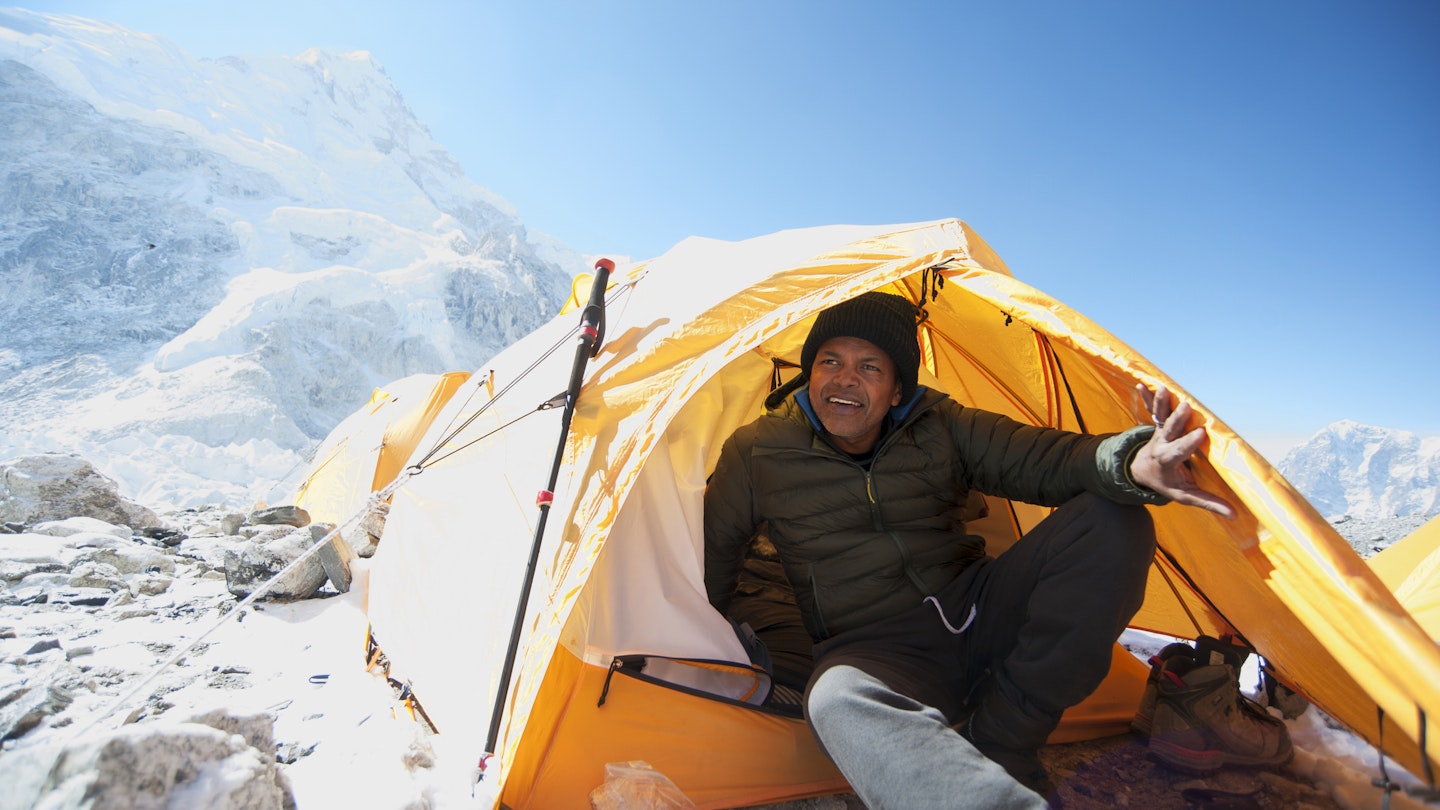
From permits to teahouses, here's everything you need to know about trekking to Everest Base Camp © Mint Images / Getty Images
Top of many people's travel bucket lists, the trek to Everest Base Camp is often the first thing people think about when they start dreaming of a trip to Nepal .
The walk takes trekkers past Sherpa villages and Tibetan-style monasteries, right up into the heart of the high Himalaya, into a breathtaking world (literally) of iconic glaciers, lakes and the tallest peaks on earth. It's probably the world's most famous trek.
But what is it actually like to trek to Base Camp? Is it something within your capabilities or budget? What should you bring? And, most importantly, can you get a proper coffee en route?
I just returned from trekking to Everest Base Camp for Lonely Planet's Nepal guide . Here’s what I think you need to know.
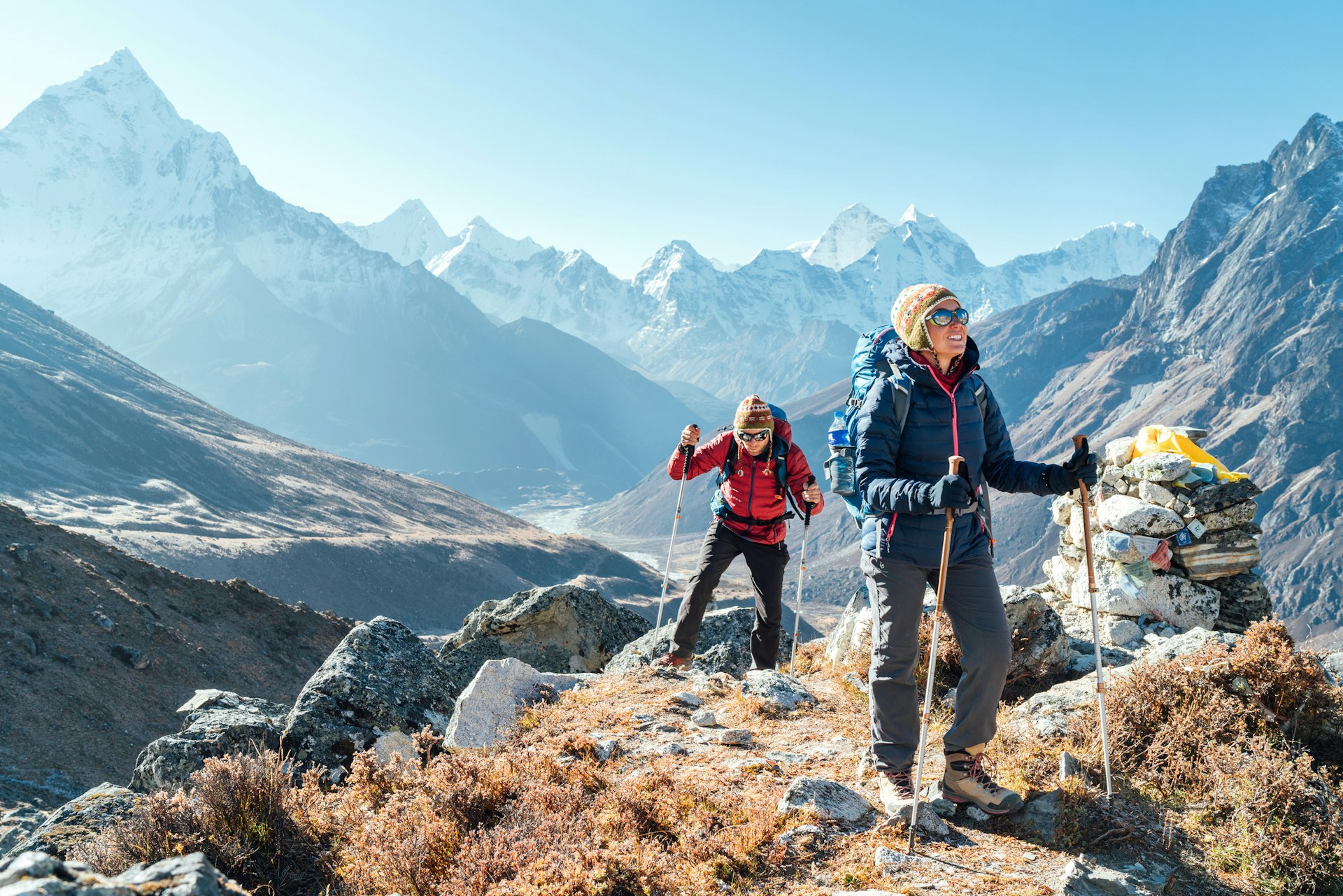
What's so great about the Everest Base Camp (EBC) trek anyway?
Firstly, the mountain scenery surrounding the world's highest peak is truly spectacular. The sublime views of Ama Dablam, Pumori, Nuptse and Thamserku peaks are unbeatable and constantly change as you progress along the walk. The Sherpa villages and monasteries are fascinating places to visit and the lodges (called teahouses) are the best in the world.
The knowledge that you are walking in the expedition footsteps of Hillary, Tenzing, Messner and others is a thrill. Anyone who has read Into Thin Air will be moved by the memorial stupas of Rob Hall, Scott Fischer and others who have lost their lives on the mountain. And then there's the fact that you will have reached the base of the world's highest peak; whether you call it Chomolongma (Tibetan), Sagarmatha (Nepali) or Everest, it’s a rush all the same.
And what’s not so great about the Everest Base Camp trek?
Well, if you force us to play devil's advocate… EBC is one of the busiest trails in Nepal. In the high season months of October and November you'll be walking with thousands of other trekkers, competing with them to get a bed, a lunch order or an airplane seat. There will be lines at checkpoints and even at moments on the trail itself. In bad weather you might be stranded at Lukla airport with hundreds of other trekkers, all trying to get on the first flight out. It's not quite the Zen-like wilderness experience you may have been imagining.
Bear in mind also that even after a solid week of walking, your view of Everest will be partial at best (for infinitely more dramatic Everest views visit the northern Everest Base Camp in Tibet ). If you trek outside of May's expedition weather window you won’t actually find much to see at Base Camp beyond a boulder hastily spray-painted with "Everest Base Camp".
If this has put you off, don’t worry; there are dozens of other fantastic treks in Nepal .
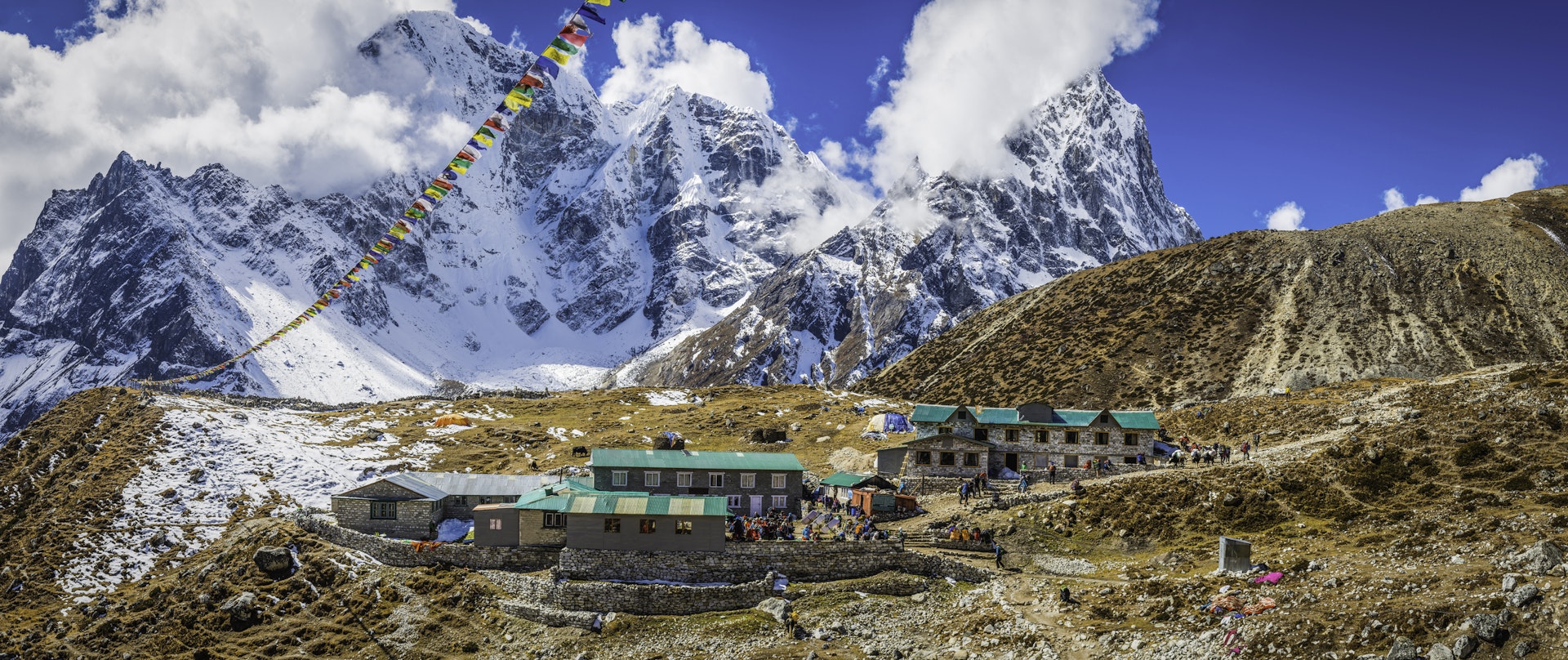
How long does it take to trek to Everest Base Camp?
The walk from the airport at Lukla to Everest Base Camp and back takes a minimum of 15 days. Several of the days are surprisingly short, but this is because you have to figure in time to acclimatize to the high altitudes.
If you can, it's definitely worth adding on a couple of extra days to this basic itinerary. Some of the most dramatic (and least visited) views are from detours off the main trail. I always add two days to visit Thame, two days to visit Chhukung and, if possible, three or four days to visit the lakes of the Gokyo Valley – probably the most beautiful scenery in the Everest region.
Be sure to also budget an extra day or two as a transport buffer. Weather-related flight delays in and out of Lukla are not uncommon (I had to wait six days for a flight to Lukla on my recent trip) so you need some buffer time if heading back for an international flight home.
How challenging is the trek to EBC?
In terms of physical effort, the EBC trek itself is not especially tough. There are only a couple of steep climbs, lasting about an hour each, and most days involve less than four hours of walking.
The thing that makes the EBC trek tough is the altitude. Base Camp is at 5600m (18,373ft) and you will need to spend one or two nights above 5000m (16,404ft). Above 4000m (13,123ft) you are going to feel increasingly lethargic and out of breath as the amount of oxygen in the air decreases. Combine this with the cold, the discomfort of being at altitude and the compounded tiredness from walking for two weeks straight, and you can see why the whole trek experience is definitely a physical challenge.
While you don't need to be an athlete to walk to EBC it is still a good idea to start a fitness regime in the weeks leading up to your trek. You'll enjoy the walk so much more if you are in decent shape.
When is the best time to trek to Everest Base Camp?
October and November bring the best weather and the clearest skies but these are also the most popular months. The second most popular season is April to early May, when spring blooms and expedition traffic bring extra interest to the trail. To avoid the crowds but still enjoy clear views, pack an extra thermal layer and come in December or March.
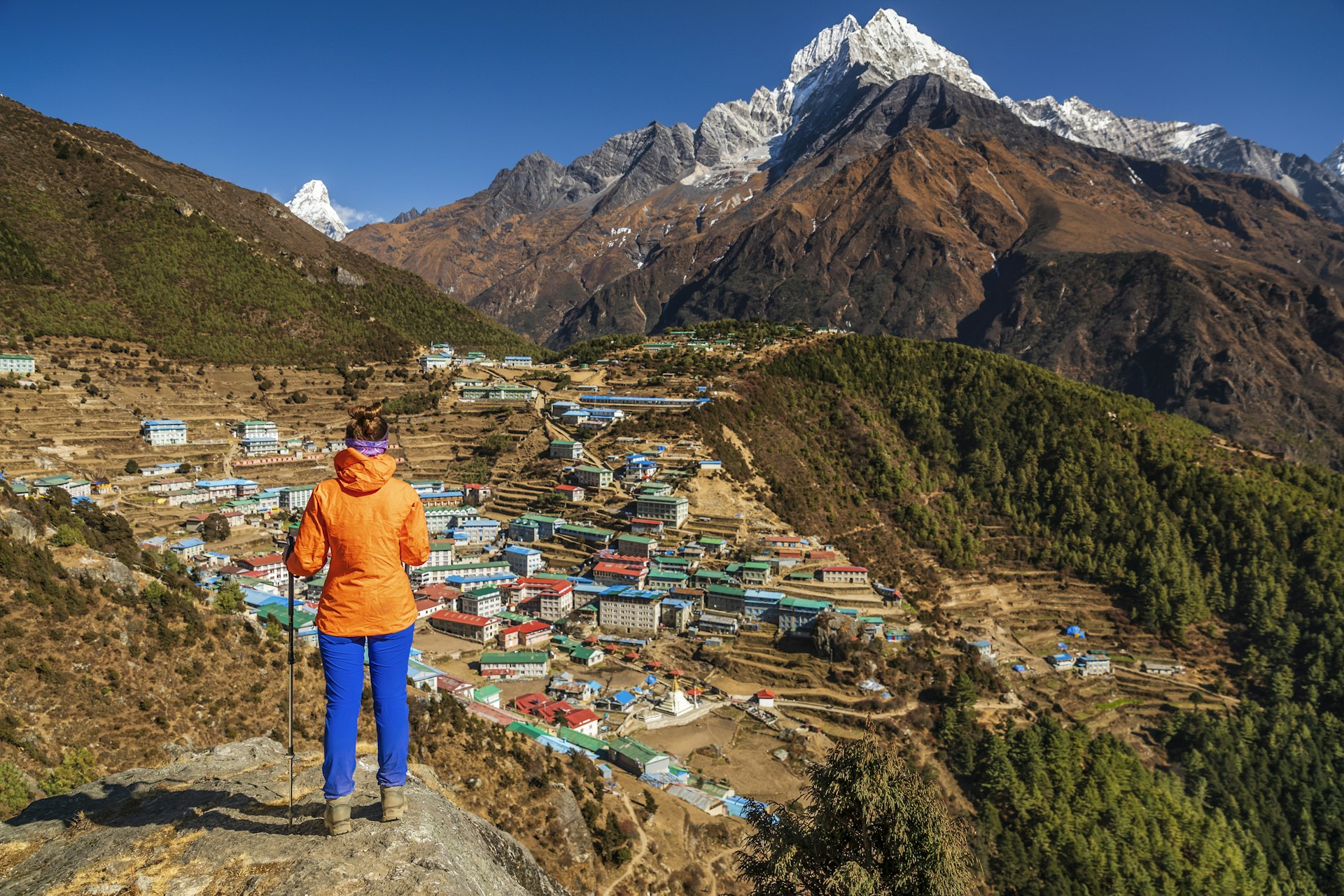
What can I do to avoid altitude sickness?
The majority of people who fail to reach Base Camp do so because they failed to acclimatize properly to the altitude. It's essential not to gain altitude too quickly by following the recommended overnight stops and limiting your daily altitude gain to a maximum of 400m (1312ft) when above 3000m (9843ft).
Be sure to add in acclimatization days at both Namche Bazaar and Dingboche, during which it's a good idea to hike to higher altitudes during the day, returning to sleep lower at night.
What are the teahouses like?
At lower altitudes the Everest lodges are the most comfortable in Nepal. Private rooms are the norm, many of which have private bathrooms. Showers are available at most places, though the hot water supply can be patchy. All have cozy dining rooms with tables arranged around a central dung-fueled stove. There are even a few luxury lodges along the trail.
In budget lodges, or when you get above Dingboche, things get simpler, with rooms offering little more than a collection of plywood walls, a solar light and a foam mattress. Toilets are a mixture of seats and squatters; sometimes outdoors, always freezing. A blanket is normally supplied but be sure to bring a four-season sleeping bag rated to well below 0°C (32°F).
What's the food like?
Menus in teahouses range from pasta and pizza to spring rolls, fried potatoes and soups, though the most popular meal is a daal bhaat , a set Nepali meal of rice, lentil soup and fried vegetables, normally served with a papad and pickle, and with a refill included. It's the most filling and environmentally sustainable meal you can order.
In villages such as Namche Bazaar and Dingboche you will also find bakery-cafes serving espresso and slices of delicious apple pie, plus shops selling everything from Snickers bars to bottles of beer. This is one trek where you might actually gain weight!
Can I get wi-fi or phone coverage?
Most lodges offer wi-fi, either free of charge or for a few dollars per day (at higher elevations). Above Namche Bazaar you will likely have to buy a scratch card, giving you unlimited data for twelve hours (AirCell) or a specific amount of data over a month (Everestlink). Depending on your network provider you'll likely get data and a phone signal at lower elevations, and possibly even at Everest Base Camp, but not at other high altitudes. So yes, in theory, you can Skype all your friends from Base Camp!
What should I bring?
Warm clothes are a must, and you should pack thermal underwear, a down jacket and fleece hat. Comfortable hiking boots and good, padded socks are also essential. Sun block, a sun hat with a brim and good sunglasses are important against the strong high-altitude light.
Morale-boosting snacks like chocolate and salami are always helpful, as is a book and smartphone with mapping software like Maps.me. Bring water purification of some sort. If you forget something, don’t worry, you can buy almost anything you might want in Namche Bazaar these days (from ice axes to cans of Pringles), though at prices higher than in Kathmandu .
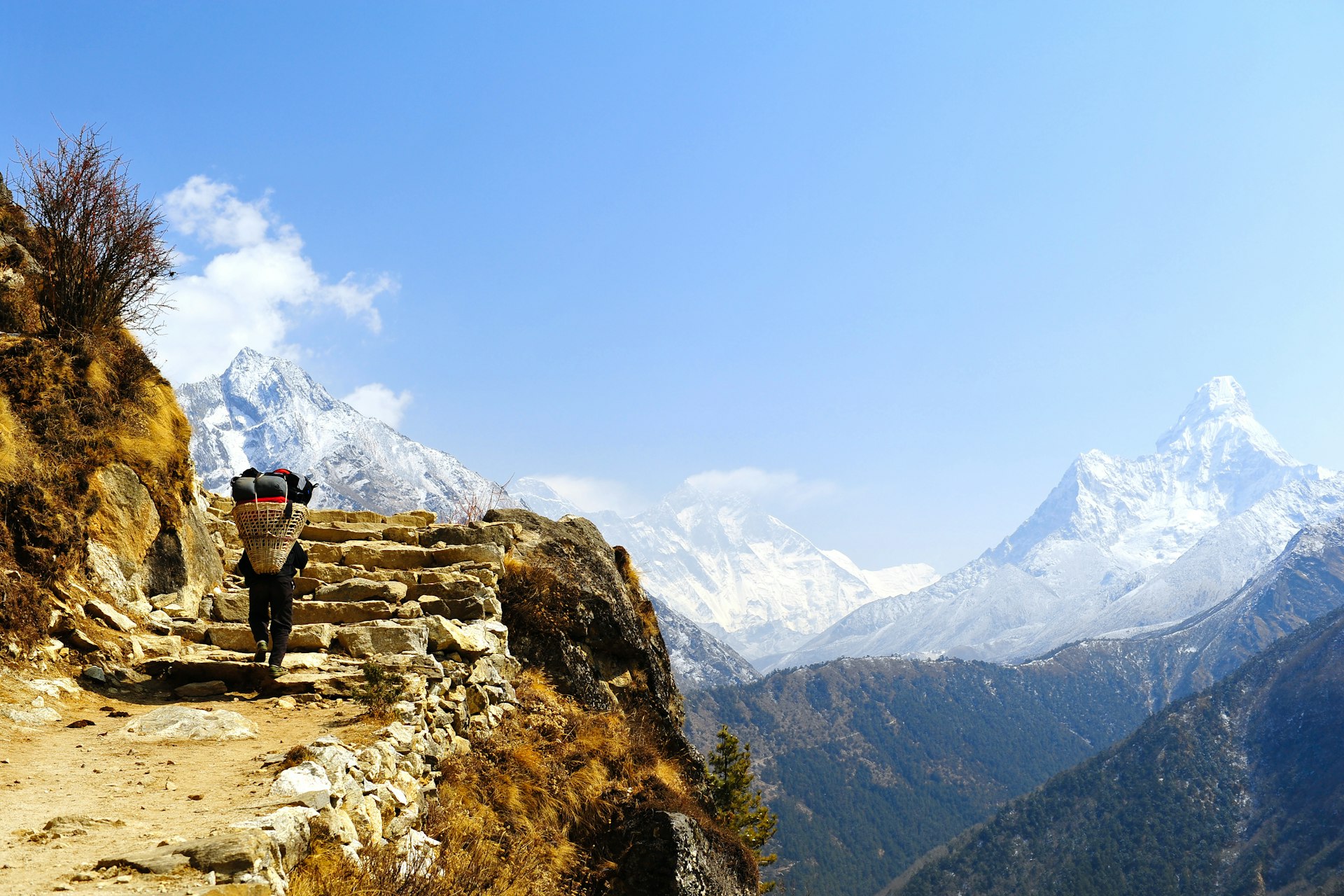
Do I need a porter and guide?
In terms of finding your way you don't need a guide if you are an experienced walker, as the route is clearly marked and well-trod. A guide can be useful for smoothing your way at teahouses, making sure you get your food on time and helping you pay your bill. It's important not to trek alone, so solo trekkers should find a companion or take a guide or porter.
A porter will carry a bag of around 15kg, freeing you up to pack a few extra chocolate bars and enjoy the walk with little more than a day pack. Not having the strain of carrying a full pack is worth its weight in gold for anyone over the age of 50. Trust me.
How much does the Everest Base Camp trek cost?
For a room in a lodge and three meals a day, figure on US$20–25 per person per day, a bit more if you want a room with a private bathroom and the occasional slice of apple pie. Add on another US$5 every time you want a shower. Figure on an additional US$20 per day for a porter, and US$25–30 for a guide, and budget 10–15% of that fee for an end-of-trip tip.
You'll pay a bit more to have a Kathmandu-based trekking company arrange your entire trek, and a lot more for the convenience and backup of an international trekking tour.
Do I need any permits?
You will need to buy an Everest region permit (US$20) at Lukla, as well as a Sagarmatha National Park entry ticket (US$30) at Monjo. Currently that's all you need.
How can I trek more sustainably?
With 60,000 trekkers and guides headed to the Everest region, it’s important to minimize your impact on the region. Firstly, don't buy bottled water on the trek, as the bottles are nonrecyclable and are a huge problem throughout the region. Bring a system of water purification, like a Lifestraw or Sawyer filter, a Steripen or chemical purification.
Secondly, carry all your trash out (especially batteries), and sign up for the Carry Me Back program, whereby you carry a 1kg bag of trash from Namche Bazaar to Lukla, for it to be recycled in Kathmandu.
Finally, be polite to the Sherpas and porters you meet en route, as well as your fellow trekkers. Walk clockwise around stupas and be respectful at monasteries and shrines.
How do I get to Lukla to start the trek?
Flights run multiple times daily between Kathmandu and Lukla, taking around 30 minutes. During high season however you may have to drive five hours from Kathmandu to Ramechhap airport to catch your Lukla flight there.
It's also possible to fly or drive to Phaplu and walk two days to Lukla from there, or walk from Shivalaya to Lukla in seven days as an excellent pre-trek warm-up.
This article was first published January 2013 and updated June 2023
Explore related stories
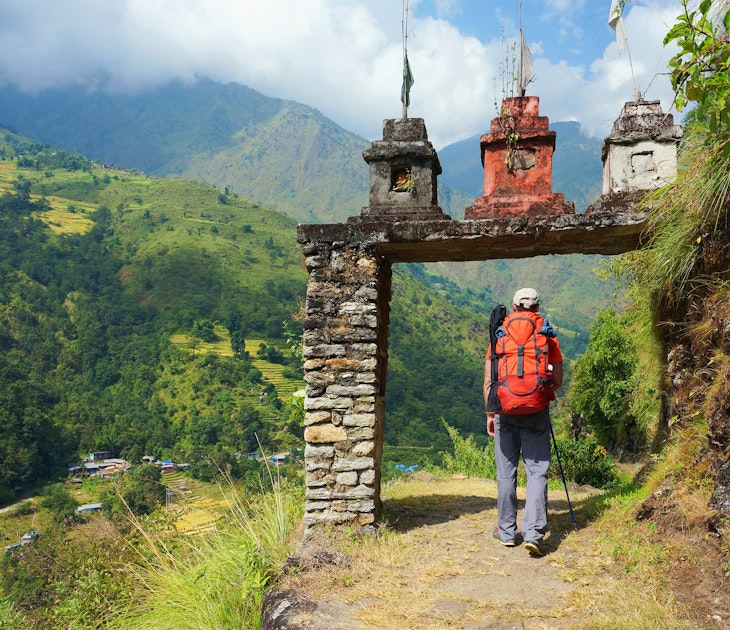
Mar 14, 2023 • 4 min read
To reduce accidents and promote jobs, Nepalese authorities recently announced a ban on solo trekking in national parks and conservation areas.

Jul 13, 2022 • 8 min read

Jan 31, 2022 • 6 min read
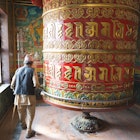
Jan 9, 2022 • 8 min read

Sep 14, 2021 • 11 min read

Jan 28, 2021 • 5 min read
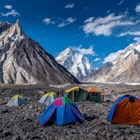
Jan 12, 2021 • 7 min read
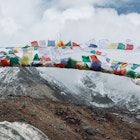
Dec 10, 2020 • 6 min read
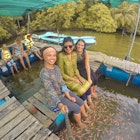
Jan 7, 2020 • 6 min read
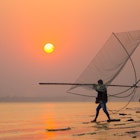
Oct 10, 2019 • 9 min read
Main Navigation
Annapurna region.
- Mardi Himal Trek
- Annapurna Base Camp Trek
- Annapurna Circuit Trek
- Annapurna Panorama Trek
- Poon Hill Sunrise Trek
- Annapurna Sanctuary Trek
- Nar Phu Valley Trek
- Poon Hill Trek
- Annapurna Sunrise Trek
- Ghorepani Poon Hill Trek
- Ghorepani Ghandruk Loop Trek
- 4 Days Poon Hill Trek
- Annapurna Short Trek
- Poon Hill Annapurna Base Camp Trek
- Poon Hill Trekking package
- Short Mardi Himal Trek
- 5 days Annapurna Base Camp Trek
- 6 Days Annapurna Base Camp Trek
- 10 Days Poon Hill Annapurna Base Camp Trek
Everest Region Trek
- EBC Helicopter Tour with Landing - 1 Day
- Luxury EBC Trek with Helicopter Return - 5 Days
- EBC Trek with Helicopter Return - 10 Days
- Short Everest Base Camp Trek - 11 Days
- Short Classic Everest Base Camp Trek - 12 Days
- Classic Everest Base Camp Trek - 14 Days
- Everest Base Camp Luxury Trek - 14 Days
- Gokyo Lakes Trek -14 Days
- Short Comfort EBC Trek -13 Days
- Comfort Everest Base Camp Trek - 15 Days
- Gokyo Renjo La Pass Trek - 15 Days
- Gokyo Cho La Pass EBC Trek - 18 Days
- Everest Three High Pass Trek - 19 days
Manaslu Region Trek
- Short Manaslu Circuit Trek
- Tsum Valley Trekking
- Rupina La Manaslu Circuit Trek
- Manaslu Tsum Valley Trek
- Manaslu Trek
Langtang Region Trek
- Langtang Helambu Trek
- Tamang Heritage Trek
- Langtang Easy Trek
- Langtang Trekking
- Langtang Ganja La Pass Trek
- Langtang Gosainkunda Circuit Trek
- Gosainkunda Helambu Trek
Dolpo Region Trek
- Beni - Lower Dolpo Trek
- Upper Dolpo Trek
- Lower Dolpo Trek
Eastern Region
- Complete Everest Base Camp Trek Package
- Rolwaling Trek
- Makalu Base Camp Trekking
Newly Open Trekking
Kanchenjunga region trekking.
- Kanchenjunga Base Camp Trek
- Kanchenjunga Circuit Trek
- Everest Base Camp Helicopter Flight Tour with Landing
- Kathmandu - Pokhara Tour
- Nepal Overland Tour
- Nepal Trekking Tour
- Nepal Trekking with Jungle Safari Tour
- Nepal Cultural Tour
- Nepal Tour with Kids
- Kathmandu-Pokhara-Chitwan-Nagarkot Hiking Tour
Peak Climbing
- Island Peak Climbing
- Mera Peak Climbing
- Lobuche Peak Climbing
- Yala Peak Climbing
- Chulu West Peak Climbing
- Naya Kanga Peak Climbing
- Pisang Peak Climbing
- Shivapuri Nagarkot Trek
- Nagarkot Dhulikhel Namobuddha Trek
- Pokhara Sarangkot Trek
- Hiking and Meditation trip in Nepal
- Annapurna Skyline Trek
- Kathmandu City Sightseeing Tour
- Namo Buddha Day Hiking Tour
- Bhaktapur Half Day Tour
- Nagarkot Sunrise Day Tour
- Nagarkot Sunset Day Tour
- Nagarkot Day Hiking Tour
- Chandragiri Hill Half Day Tour .
- Boudha-Pashupati-Bhaktapur Full Day Tour
- Bhutan Spiritual Tour
- Bhutan Cultural Tour
- Bhutan Short Spiritual Tour
- Tibet Overland Tour
- Kailash Manasarovar Yatra
- Tibet Shangrila Tour
- Tibet Special Tour
- Tibet Introductory Tour
- Lhasa Everest Base Camp Tour
- Simikot Kailash Lhasa Tour
- Simikot Kailash Zhangmu Tour
- +9779851082484

How long is the trek from Lukla to Everest Base Camp?
As Everest Base Camp Trek is getting popular day by day, MMT has customized numerous EBC Packages to satisfy the appetite of the keen trekkers. The itinerary of the Everest Base Camp trek depends upon the package you prefer; so we can’t tell exactly how long is the trek from Lukla to Everest Base Camp or how many days does it take to complete the EBC Trek. Normally, EBC Trek is of 11 – 22 days trek from/to Kathmandu – Lukla – EBC – Lukla – Kathmandu .
Table of Contents
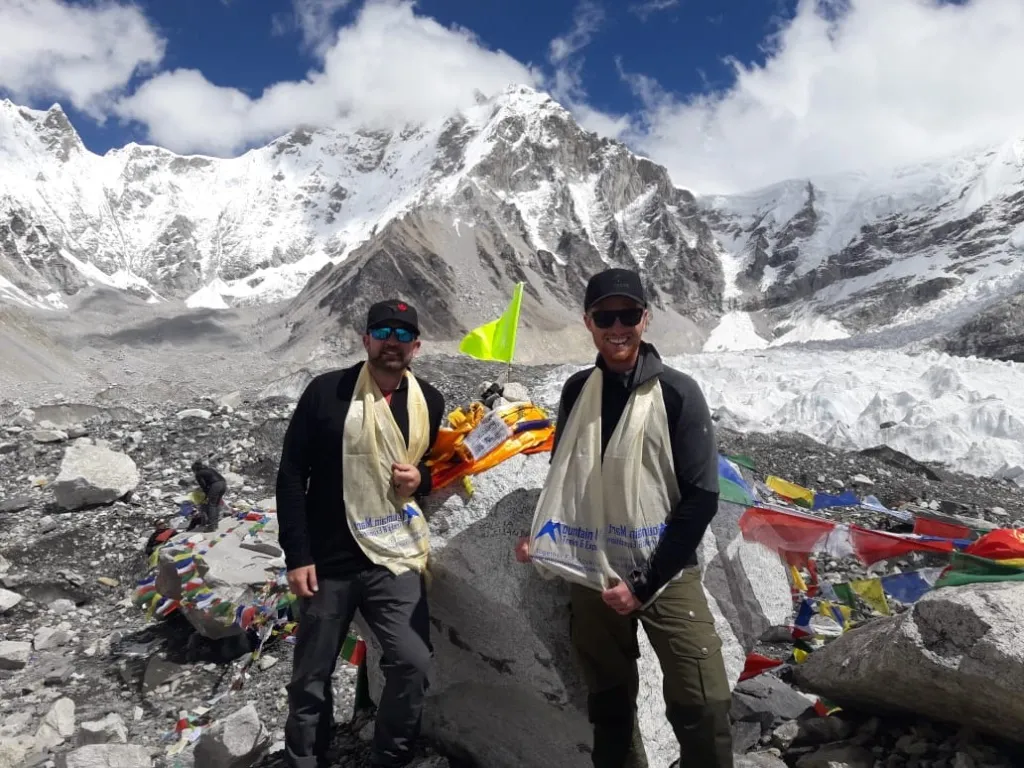
The most preferred Classic Everest Base Camp Trek is 15 days trek in which the 1 st day is arrival plus trek briefing day, and the second day is Kathmandu city excursion day. Our trek from Lukla usually commences on the 3 rd day after landing at Lukla from scenic mountain flight from Kathmandu.
The approximate one-way distance from Lukla to Everest Base Camp is 60 – 65 km. With an average walk of 8-9 hours a day, physically fit trekkers can accomplish the single way distance in 7-8 days including 2 days of acclimatization. The duration of the trek may vary from one trek to another depending upon the inclusion of acclimatization days in itinerary or not.
The Short Everest Base Camp Trek has only one day of acclimatization so we can reach at EBC in 6-7 days with an average walk of 9-10 hours a day. In total 11 days of the trek, we reach at EBC on day 7 and return back to Kathmandu on day 10.
The distance from Lukla to Everest Base Camp can be easily covered by any physically fit trekkers with proper acclimatization and healthy habits.
Classic Everest Base Camp Trek itinerary: Lukla to Everest Base Camp
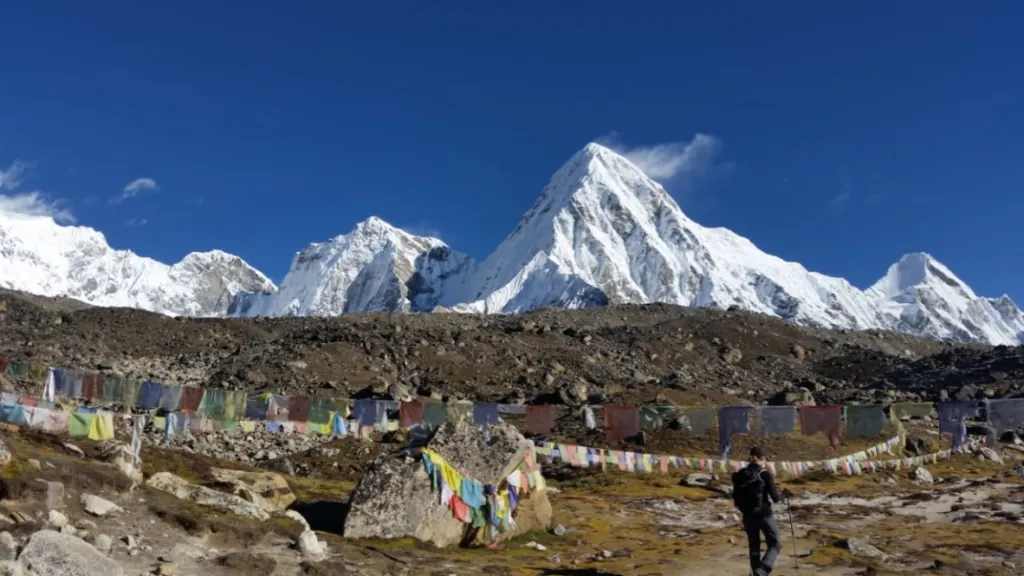
- Day 1: Arrival in Kathmandu:
- Day 2: City Excursion and Trek Preparation:
- Day 3: Kathmandu to Lukla (30-40 min) and trek to Phakding (3-4hrs):
- Day 4: Phakding to Namche: 10-12 km (6-7 hours):
- Day 5: Acclimatization and exploration day at Namche:
- Day 6: Namche to Tengboche:8-9 km (5-6 hours)
- Day 7: Tengboche to Dingboche: 10 km (6-7 hours)
- Day 8: Acclimatization day at Dingboche:
- Day 9: Dingboche to Lobuche: 7km (5-6 hours)
- Day 10: Lobuche to Gorakshep to EBC to Gorakshep: 15km (8-10 hours)
- Day 11: Gorakshep to Kala Patthar to Gorakshep to Pheriche: 15km (8-10 hours)
- Day 12: Pheriche to Namche: 14-15km (7-8 hours)
- Day 13: Namche to Lukla: 15-16km (7-8 hours)
- Day 14: Lukla to Kathmandu on flight: (30-40 minutes)
- Day 15: Departure day:
Is the trail from Lukla to EBC difficult?
There are numerous trails from Lukla to Everest Base Camp; so the difficulty level of the trail depends upon which trail we prefer. From Lukla to Everest Base Camp, the trails are uphill-downhill and straight; we also need to cross the suspension bridges, icy glaciers; walk through the ridges, narrow cliffs, and moraine boulder to reach at EBC.
The Everest Base Camp Trek is moderate to strenuous in which trekkers have to walk for 8-9 hours per day on an average. To adjust the thin air and to make the trek even easier, agencies add few days of acclimatization in their itinerary. With proper precautions and guides’ guidance, the trails can be easily traced by the trekkers with average physical fitness. Especially, we suggest the trekkers follow the main trekking trail as marked in the map or preferred by the guides.
Is there any alternative route to EBC than Lukla?
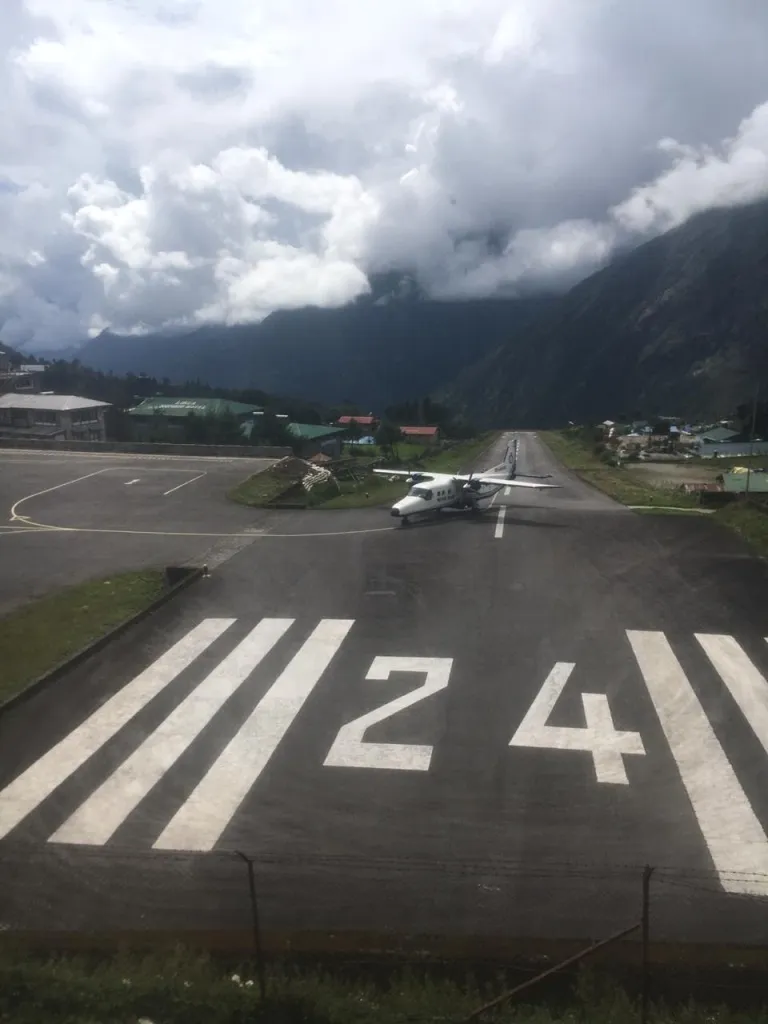
One of the easiest, fastest and widely used routes is flying to lukla from Kathmandu and then trek to EBC. The Kathmandu to Lukla flight expensive as well as thrilling; therefore few trekkers prefer the alternative route to reach at EBC.
Jiri – Everest Base Camp Trek is the only alternative route to avoid expensive and turbulent mountain flights. In this trek, we drive for 6-7 hours from Kathmandu to Jiri/Phaplu from where the normal trek begins. In this trek also, we have to walk through Lukla to trek in Khumjung Valley.
Lukla is the gateway to Everest. Almost every trekking trail of Everest Base Camp including Gokyo Lake Trek traces through Lukla; therefore Lukla is the transit point from where every EBC Trek.
How easy or difficult is EBC Trek?
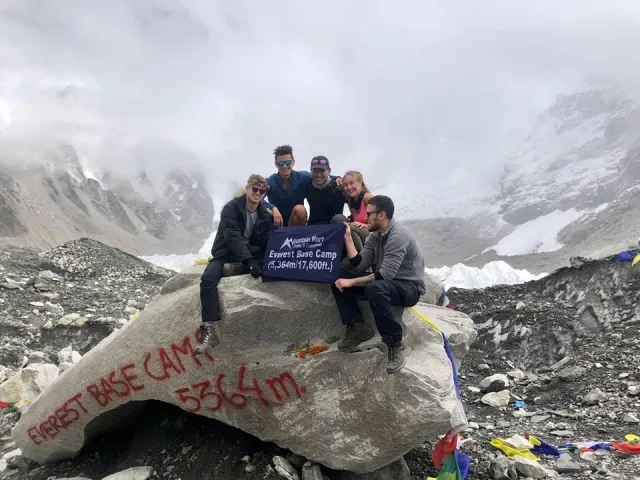
Everest Base Camp Trek is well managed and well inspected by TAAN and NTB. Trekking in the Everest Region is always awe-inspiring, easy and safe; but due to negligence of the trekkers, AMS can be the major threat in EBC Trek.
In Everest Three Pass Trek , the trekkers need to cross the three highest passes of the Everest region which can make the trek risky and tough. The trekkers need to be more careful while ascending or descending through the rocky path, icy glacier, cliff, and ridges.
The weather in the higher elevation is unpredictable; even the best trekking seasons like autumn and spring couldn’t be reliable. In the off seasons like summer and winter, the continuous heavy rainfall and snowfall make the trail slippery which makes the trek difficult.
The misty weather condition can sometimes delay or cancel the flight; if trekkers have a tight schedule then there will be a problem to accomplish the trek and to return back home on departure date.
.webp)
Almost every EBC Trek commences from Lukla after short and scenic mountain flight from Kathmandu. The distance of 120-130 km from Lukla – EBC – Lukla can easily be trekked by the trekkers of average physical stamina. While trekking in the higher altitude, trekkers must walk in pace and stay in lower region to avoid any risk of AMS.
The trail from Lukla to EBC is also moderate to strenuous. Except for some trek, most of the treks have moderate trails which can be traced without any use of gears. In Gokyo – Cho La – Everest Base Camp Trek trekkers need to cross high pass as well as icy boulder trail; therefore some alertness is required throughout the trek.
The Everest Region Trek is an amalgamation of pain and pleasure which remains in the memory of every trekker. Trail from Lukla to EBC is short, easy and comfy yet some preventive measures must be taken on time; otherwise, the awful experience always haunts you in life.
Please, feel free and contact us for any queries and confusions regarding trekking and touring in Nepal, Tibet, and Bhutan . MMT is always at your service. We wish you have a happy life!
Other Categories
- Travel Information
Recent Posts
- Manaslu Circuit vs Annapurna Circuit Trek - Which is Best?
- Tips For Annapurna Trekking Packages
- Everest Base Camp Trek vs. Annapurna Base Camp Trek: A Comprehensive Comparison
- Luxury Lodge vs Normal Lodge Trek
- Langtang Valley Trekking
- How Much Does the Langtang Valley Trek Cost?
- Know Before Hiking Poon Hill: The Ultimate Poon Hill Trek Guide
- Everest Trekking Package for 2024/2025
- Top 7 Reasons: Why Everest Base Camp Trek is Popular Today?
- Where is Nepal located on the World Map? - Nepal Facts
- Where is Mount Everest Located?
- Where is Location of Mount Everest in the World Map?
- What is the death rate on Everest? [2022/23 Updated]
- What is Everest Base Camp Trek? - Our Top Tips for your EBC Trek 2022/23/24
- Trekking in Nepal in September - Is September a Good time to visit Nepal 2022/23/24?
Recommended - Boutique Hotel in Thamel, Kathmandu
Charming Newari Heritage Hotel in central Kathmandu, with a rooftop restaurant for stunning valley views.

We are associated with
Acceptable payments.
Find & Follow Us on
© 2011 - 2024 All rights reserved. Mountain Mart Treks & Expedition. Developed By: Xenatech Nepal .
Notice. This site uses cookies to optimize your user experience. By using this site, you are consenting to our use of these cookies. Check out our Privacy Policy and our Cookies Policy.

Base Camp Adventure

- Email: [email protected]
Everest Base Camp Trek Map

Everest Base Camp Trek is one of the major attractions of Nepal. Visiting the highest peak of the world at an altitude of 8848 meters so up close is on everyone’s bucket list. But only a few adventurous brave people can commit to embark on the adventure.
Embarking on any journey requires detailed information about the place. For any journey, the main requirement is always a map. Getting lost in a strange place is a nightmare. To avoid such a nightmare from becoming reality, you should always carry a map with you.
With the Everest Base Camp Trek map , the chances of you getting lost are reduced. The age of technology does make it seem like maps are pretty useless. But with the trekking being in a remote area, a physical Everest Base Camp Trek map would seem like the most useful and important item.
With a challenging adventure as the Everest Base Camp Trek , you can never be too careful. You will always need an Everest Base Camp Trek map with you in case of any uncertainties. Also, wherever you go, it’s a smart move to do a little research about where you will be reaching or what you will be doing there.

With the map of Everest Base Camp Trek, you will not only be able to find the routes easily, but you will also know where you are at the moment and what the main attraction of the place is. For example, with a map, you will know that a certain monastery or religious landmark is nearing and prepare yourself accordingly.
Trek Route Summary
Standard everest base camp route.
The 15 days Everest Base Camp Trek is the most popular route taken by trekkers. The trek starts with a flight from Kathmandu to Lukla. From Lukla, you will trek most of the day with around 5-6 hours of trekking every day. Passing through Namche bazaar on Day 4th for acclimatization , you will travel through religious monuments like Tengboche. Another acclimatization point at Dingboche is used during the trip.
You will reach the base camp on the ninth day of the trek. Taking the same way back, retracing your steps, you will return to Kathmandu on a flight from Lukla. This will mark the end of your Everest Base camp trek. This route is marked In blue in the map provided above.
Helicopter return (optional)

Another route for Everest Base Camp Trek is returning by helicopter. This allows you to have a clear view of the mountains from a higher altitude. The Everest Base Camp Trek with helicopter return includes all the same routes and stops as the base camp trek of 15 days. You will catch a flight from Kathmandu to Lukla and travel through Namche bazaar to the Everest Base Camp. The only difference is that you will be returning from Kala Patthar to Kathmandu by helicopter . Here you will enjoy the superb view of the mountains, the valleys, and the trails.
Three pass trek (optional)
The path in grey in the Everest Base Camp Trek map is the one that takes us through the three passes to reach our final destination i.e, the Everest Base Camp. This route takes us for a challenging adventure through the Valley of death. The three pass route takes us to the Gokyo village and Gokyo Ri to witness the glorious mountains standing tall in their full beauty.
This route takes you to a mystical journey through the three passes: Kongma-la Pass, Cho La Pass, and Renjo La Pass . This place provides the best view of the Everest Base Camp. The three pass trek provides the trekkers with a solidarity trek on the way back. This trek route takes a total of 18 days , unlike the classical trekking route.
Related Articles
- 15 Days Everest Base Camp Trek
- Everest Base Camp Trek with Helicopter Return
Everest Three Pass Trek
- Full Name *
- Contact Number
- Your Message/Inquiry *
Details as per the Everest Base Camp Trek Map
As per the Everest Base Camp Trek Map, the route for the classic Everest Base Camp trek follows the following routes making the stops below:
Kathmandu to Phakding
Lukla – Phakding Distance: 6.2 km | Max altitude: 2,610 m | Estimated Trek hours: 4 – 5 hrs
The main route shown as per the Everest Base Camp Trek Map is the classical Everest Base Camp Trek route. The trek starts from a flight from Kathmandu to Lukla and ends the day at Phakding.
Phakding to Namche: Rest one day for acclimatizing
Distance: 7.4 km | Max altitude: 3440 m | Estimated Trek hours: 6-7 hours
From Phakding, this route leads us to Namche Bazaar through Manjoo. This stop is an acclimatization point where you will rest for the day to help better adapt to the altitude.
Namche to Tengboche
Distance: 5.9 km | Max altitude: 3867 m | Estimated Trek hours: 5-6 hours
The next stop on this route is Tengboche. This is a Buddhist monastery worshipped by the sherpas. The map clearly shows how to reach the monastery from Namche Bazaar.
Tengboche to Dingboche – rest one day for acclimatizing
Distance: 9.1 km| Max altitude: 4260 m | Estimated Trek hours: 5-6 hours
From the monastery in Tengboche, the route leads you to Dingboche. This is a small village on the way. You will rest at this spot for the day acclimatizing and head to the next stop the next day.
Dingboche to Lobuche
Distance: 6.6 km | Max altitude: 4930 m | Estimated Trek hours: 5-6 hours
Lobuche is the next stop from Dingboche. There are two routes to reaching Lobuche. On the map, we can clearly see the routes we can take.
Lobuche to Everest Base Camp – Gorakshep
Distance: 12.1 km to Everest Base camp 1.7 km to Gorakshep: | Max altitude: 5364 m| Estimated Trek hours: 3-4 hours
From Lobuche, we can reach Everest Base Camp. At an altitude of 5364 meters, we will reach Everest Base Camp and enjoy the view of the breathtaking mountains. After the achievement of a lifetime, you will descend to Gorakshep.
Gorak Shep to Kala Patthar to Periche
Distance: 1.2 km to Kalapatthar 10 km to Pheriche | Max altitude: 5545 m | Estimated Trek hours: 6-7 hours
The way back is now all descents. Only today, you will hike up to Kalapatthar in the morning. The view of the mountains in the early sunrise is to die for. This is one of the main attractions of the entire trek. Then you can descend to Pheriche.
Pheriche to Namche Bazaar
Distance: 14.2 km| Max altitude: 4243 m | Estimated Trek hours: 7-8 hours
The return route is the same as the one you took to get up to the base camp. You will follow the same route you took from Pheriche to Namche Bazaar.
Namche Bazaar to Lukla
Distance: 13.5 km | Max altitude: 3440 m | Estimated Trek hours: 6-8 hours
From Namche, you will return to Lukla through Manjoo and Phakding through the same trails as before. The only difference is that the way will no long be uphill.
Flight from Lukla to Kathmandu
Distance: 138 km | Max altitude: 2886 m| Estimated hours: 40 minutes
Your journey finally ends with the almost-cinematic view of the mountains and the valley. All this from your comfortable flight from Lukla to Kathmandu.
This trek takes only 15 days to take the daring journey and come back.
Alternative Route Map from Base Camp

This route is similar to the classic Everest Base Camp Trek. The way up is the same. However, the way back has a lot in store for you. After reaching Diboche from Namche Bazaar, you will reach the first pass of the three- Kongma-la pass . This provides spectacular views of the Khumbu glaciers.
You will reach Everest Base Camp from the pass soon. On the way back you will trek to Gokyo lakes via Cho La Pass . Here, you will see awestruck views of the religious Dudh Koshi river and the valleys around it. the pass lets you see the majestic view of the highest peaks like Cho-Oyu, Chola, Lhotse, etc.
Unlike the classic Everest Base Camp Trek route, this route is remote and of a higher difficulty level so be careful on the descent. On the way back from Gokyo to Namche, you will pass through the last pass i.e, Renjo La Pass at an altitude of 5360 meters.
The rest of the trek is the same as before. You will follow the trail back from Namche to Lukla and fly to Kathmandu. This trek takes you 18 days to reach the base camp and return back to your flight.
Return by Helicopter
Apart from the strenuous treks to and back from the base camp, there is an alternative route for your convenience. If you aren’t really good with descents or don’t want to walk back the same route, the same way you came up, you can always opt to choose the return by helicopter choice. There are many reasons to choose Everest Base Camp Helicopter Tour .
This route takes you through the classic Everest Base Camp trek route letting you experience all the trekking adventure while giving you the opportunity to end the trek with a unique Helicopter return to Kathmandu. This reduces your travel time and provides you a great opportunity to enjoy the view of the mountains from a helicopter without straining yourself more.
This route allows you to reach the base camp and enjoy the majestic view from Kalapattar. The helicopter return route picks you up from Kalapatthar and takes you t o Kathmandu straight through the mind blowing view of the mountains, valleys, and the glaciers and rivers.
The difficulty of the routes
15 days classic everest base camp trek.
The venturesome trek to the Everest Base Camp is one of the most popular and daring treks in Nepal. The trekkers do face some difficulties to overcome this daring journey.
The uncertainty of the Lukla flight is one of the major difficulties faced by trekkers here. The Lukla flight is one of the main attractions of the flight with the tempting view of the valley and the mountains. But his flight is heavily affected by the weather. Unexpected changes in weather have known to cause many cancellations so make sure to check the weather carefully.
Being at an altitude of 5364 meters , you will have to hike up a lot. Altitude sickness is probable in the high mountains. So take your time to acclimatize in the stops as per the maps guidance and enjoy the trek without any problems.
Three Pass Trek Difficulty

Among the three routes mentioned above and shown in the map, the Three Passes Trek Route is the most challenging one. There are many things to consider before embarking on this journey. This route is often chosen by people to avoid human traffic on the way. The difficulty of this trek is higher than the classic route due to the sudden uphill on the way to EBC.
You can take this route to go to the base camp which will help you in reaching the base camp fast instead of taking this route on the way back. The alternative route is filled with glorious views but the trail is kind of steep and the altitude suddenly increases.
The difficulty almost everyone faces in this route to go to Everest Base Camp is the difficulty to acclimatize in the Gokyo valley . The route seems to take only a few hours of walking so the trekkers usually rush in without proper acclimatization leading to altitude sickness.
Als, you should be careful to choose the best season to travel through this road.
Seasons are important for both ascending and descending the route. If you travel during the rainy season, there are many chances of landslides or you sliding down the slippery roads. So keep in mind to check the season and the climate before booking your trip.
Helicopter Return
The trek to Everest Base camp with helicopter return is a deal stealer as the package provides you with so many different routes and a spectacular view of the mountains and the valleys. The only difficulty that can arise on this magnificent trip is the unpredictable weather changes .
Helicopter rides are fun and exquisite, especially in the mountain range. But they aren’t advisable in bad weather conditions. The safety is in question in bad weather. So before you decide to plan a helicopter ride home from Everest Base Camp, please keep in mind that weather affects your ride a lot.
Best Time to go to Everest Base Camp Trek
Everest Base Camp Trek is a challenging trek that takes you through uphills and rocky roads. The best time to go to Everest Base Camp in the spring season during the months of February to May. The routes to reach the base camp are dry during these months.
The winter season through December to February can also be a good time but the temperature is obviously low.
The rainy season, however, is not a good time. You should avoid embarking on the Everest Base Camp Trek during the rainy season. Especially during the Gokyo route, the roads are very steep and unsafe in the rainy seasons. So best keep yourself out of the route during the rainy season to avoid any mishaps.
Before setting on an adventurous trek to Everest Base Camp, you should research the best time to go trekking to get the most out of your journey.
Why Do You Need Everest Base Camp Trek Map?
Stay on track.
Traveling through the steep snowy roads of Everest Base Camp trek, it’s easy to lose your way. Awestruck with the beauty of the place, you can get distracted from the route sometimes. These are the time maps come in handy. In the remote villages, charging your phones may be difficult. Also, wifi at such an altitude is rare. At such a time, carrying a map will be very handy.
Discover New Routes
With the Everest Base Camp Trek map, you can find out new routes to reach your destination. Discussing with your guide or your group, you can decide to take new routes to your destination. The map contains all the possible routes you can take to reach your destination and different attractions and stops on that particular stop. With the map, your Everest Base Camp Trek can be a surprising adventure with different attractions with you in control.
A Basic Necessity For A Solo Trek
Many adventurous trekkers embark on a solo trek for Everest Base Camp Trek. These trekkers are passionate about reaching the destination with their own efforts. If you are one of these passionate adventurous daredevils, you should get yourself an Everest Base Camp Trek map and initiate the adventure.
Other essentials for the Trek
Apart from the map of the Everest Base Camp Trek to guide you through the different routes of the Trek, there are other essentials for the trek like:
- Trekking boots and hiking poles
- Warm clothes like down jacket and fleece trousers
- Personal medical kit
- Portable chargers
- Toiletries and water bottles
Similar Treks
- Gokyo Valley Trek
- Mustang Trek
- Annapurna Base Camp Trek with Helicopter Return
- 4+3=? * Solve above and submit button will appear!!!
You may also like...

Kathmandu World Heritage Sites Tour

Trekking in Nepal in October

How to Trek Solo in Nepal
All the Villages on The Way Towards Everest Base Camp Trek
Nepal trekking planner.
- Last Updated on Dec 23, 2023
Let’s discuss and know about the name of the town and small villages that we encounter on the way from Lukla to Gorakshep in a consecutive manner till the Everest base Camp from Lukla .

Table of Contents
Lukla to phakding..
- Altitude: Approximately 2,650 meters.
- Distance from Lukla: Approximately 2 kilometers.
- Cheplung is a small village located just a short distance from Lukla. It offers a glimpse into the local Sherpa culture and provides basic amenities for trekkers, including tea houses and lodges.
Thado Koshi.
- Altitude: Approximately 2,600 meters.
- Distance from Cheplung: Approximately 1 kilometer.
- Thado Koshi is a tiny settlement situated near the Dudh Koshi River . It serves as a resting point for trekkers and offers a few tea houses and lodges for accommodation.
- Altitude: Approximately 2,540 meters.
- Distance from Thado Koshi: Approximately 2 kilometers.
- Ghat is a small village known for its beautiful landscapes and traditional Sherpa culture. Trekkers can find tea houses, shops, and lodges for their convenience.
- Altitude: 2,610 meters.
- Distance from Ghat: Approximately 2 kilometers.
- Phakding, as mentioned earlier, is the first major town you encounter on the Everest Base Camp Trail . It is situated on the banks of the Dudh Koshi River and offers a range of amenities such as tea houses, lodges, restaurants, and shops. Phakding is a popular resting point for trekkers and serves as a gateway to further exploration of the Everest Region .
These small villages and towns along the Lukla to Phakding trail provide trekkers with essential facilities, accommodation, and a glimpse into the local culture, making their journey more comfortable and enjoyable.
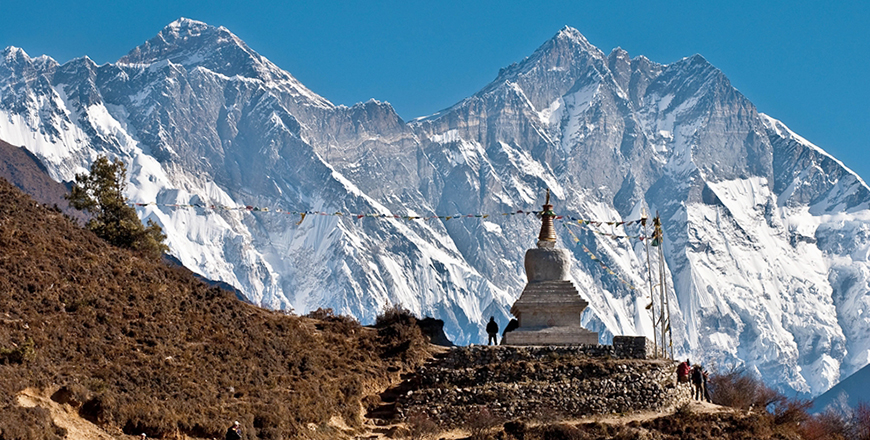
Phakding to Namche Bazaar.
- Altitude: Approximately 2,760 meters.
- Distance from Phakding: Approximately 1 kilometer.
- Toktok is a small village located close to Phakding. It offers a serene environment and stunning views of the surrounding mountains. Trekkers can find basic accommodation options and teahouses in Toktok.
- Altitude: Approximately 2,840 meters.
- Distance from Toktok: Approximately 3 kilometers.
- Monjo is a charming village situated on the banks of the Dudh Koshi River . It is the gateway to the Sagarmatha National Park , where trekkers need to register their permits. Monjo offers a few teahouses, lodges, and shops for trekkers.
- Altitude: Approximately 2,830 meters.
- Distance from Monjo: Approximately 2 kilometers.
- Jorsale is a small settlement known for its suspension bridge that crosses the Dudh Koshi River . It serves as a stopping point for trekkers before entering the higher altitudes. Jorsale offers accommodation options, teahouses, and some shops.
Namche Bazaar.
- Altitude: 3,440 meters.
- Distance from Jorsale: Approximately 8-9 kilometers.
- Namche Bazaar is the largest town in the Everest Region and a major trading center. It serves as the primary hub for trekkers and climbers. Namche Bazaar offers a wide range of amenities including hotels, guesthouses, restaurants, bakeries, shops, internet cafes, and a vibrant local market. It is an excellent place for acclimatization, rest, and stocking up on supplies before heading further into the Everest Region .
These small villages and towns along the Phakding to Namche Bazaar trail provide trekkers with necessary facilities, accommodations, and glimpses into the local culture, making their journey to the heart of the Everest Region more comfortable and enriching.
Namche to Tengboche.
- Altitude: Approximately 3,550 meters.
- Distance from Namche Bazaar: Approximately 1.5 kilometers.
- Kenjoma is a small settlement located just a short distance from Namche Bazaar . It offers picturesque views of the surrounding mountains and serves as a resting point for trekkers. Tea houses and lodges can be found in Kenjoma.
- Altitude: Approximately 3,600 meters.
- Distance from Kenjoma: Approximately 1.5 kilometers.
- Sanasa is a small village along the trekking trail known for its stunning mountain vistas. It is situated at the junction where the trail splits towards Tengboche and Khumjung . Trekkers can find tea houses and small shops in Sanasa.
Phungitanga.
- Altitude: Approximately 3,250 meters.
- Distance from Sanasa: Approximately 3 kilometers.
- Phungitanga is a small village situated near a river with the same name, which means "water buffalo". It is a popular stop for trekkers to rest and have refreshments before beginning the uphill climb to Tengboche. Tea houses and lodges are available in Phungitanga.
- Altitude: Approximately 3,867 meters.
- Distance from Phungitanga: Approximately 3 kilometers.
- Tengboche is a significant town along the trail, famous for its Buddhist monastery, Tengboche Monastery . It is one of the most sacred monasteries in the Khumbu Region and offers breathtaking views of Mount Everest , Ama Dablam, and other peaks. Tengboche provides accommodations, tea houses, a bakery, and a cultural center, making it a significant cultural and spiritual stop on the Everest Base Camp Trek .
These small villages and towns along the Namche to Tengboche trail offer trekkers necessary facilities, accommodations, and stunning natural beauty, enhancing their trekking experience in the Everest Region .
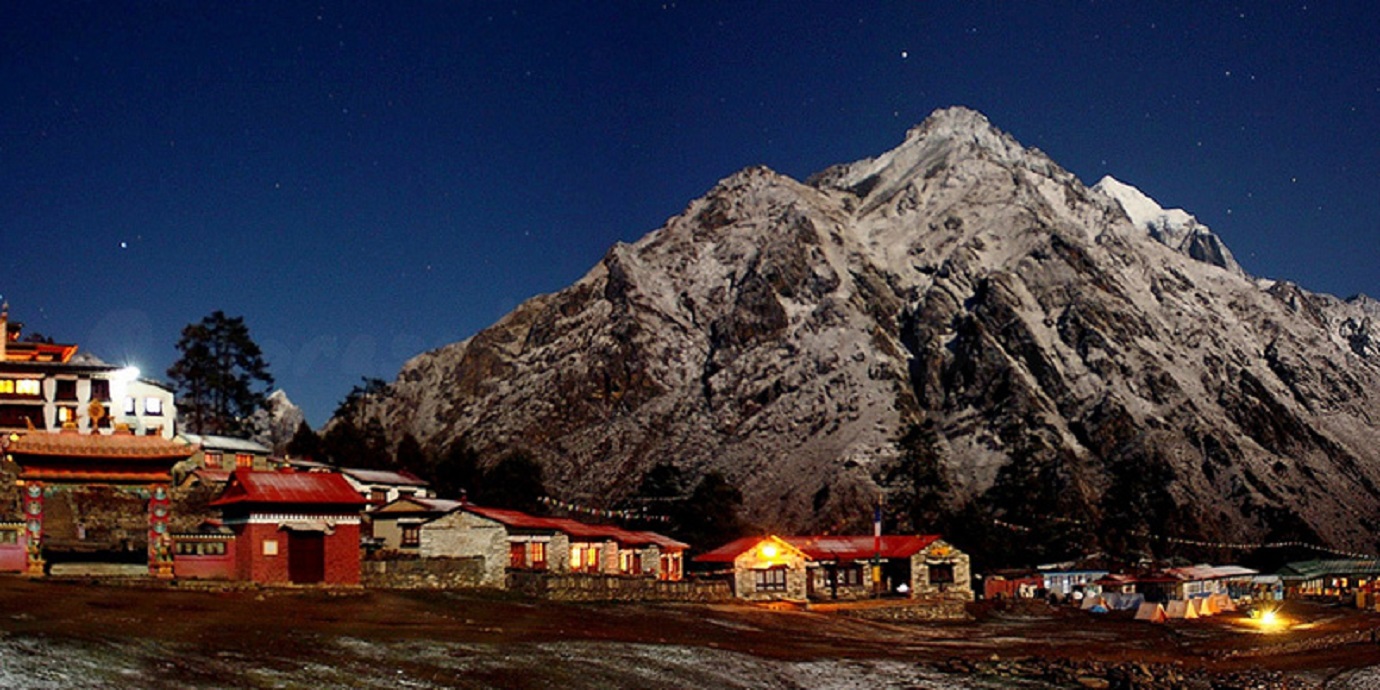
Tengboche to Dingboche.
- Altitude: Approximately 3,820 meters.
- Distance from Tengboche: Approximately 1.5 kilometers.
- Debouche is a small village located in a serene and picturesque setting. It is known for its scenic beauty and the presence of a few lodges and tea houses, providing accommodation and refreshments for trekkers.
- Altitude: Approximately 3,930 meters.
- Distance from Debouche: Approximately 1.5 kilometers.
- Pangboche is a traditional Sherpa village and one of the oldest settlements in the Everest Region . It boasts the oldest monastery in the region, Pangboche Monastery . The village offers several teahouses, lodges, and shops, making it a convenient resting point for trekkers.
- Altitude: Approximately 4,010 meters.
- Distance from Pangboche: Approximately 3 kilometers.
- Shomare is a small village located at a higher altitude, offering stunning views of the surrounding mountains. It provides basic accommodation options, teahouses, and facilities for trekkers to rest and acclimatize.
- Altitude: Approximately 4,410 meters.
- Distance from Shomare: Approximately 4 kilometers.
- Dingboche is a popular village situated in the Chhukung Valley . It is known for its breathtaking views of the mountains, including Ama Dablam and Lhotse . Dingboche serves as an acclimatization point for trekkers before ascending to higher altitudes. It offers a range of teahouses, lodges, bakeries, and shops catering to the needs of trekkers.
These small villages and towns along the Tengboche to Dingboche trail provide trekkers with necessary facilities, accommodations, and stunning natural beauty, enhancing their trekking experience in the Everest Region .
Dingboche to Lobuche.
Dughla (thukla)..
- Altitude: Approximately 4,620 meters.
- Distance from Dingboche: Approximately 4 kilometers.
- Dughla, also known as Thukla, is a small village located at the foot of the Thukla Pass. It serves as a common stop for trekkers for a rest and acclimatization. The village offers a few teahouses and lodges to provide basic accommodation facilities.
Lobuche (Small Settlement).
- Altitude: Approximately 4,930 meters.
- Distance from Dughla: Approximately 2.5 kilometers.
- Lobuche is a small settlement situated at a higher altitude, closer to the Everest Base Camp . It serves as a significant resting point for trekkers before reaching the Base Camp. Lobuche offers several teahouses and lodges, providing accommodation and dining options for trekkers. The settlement provides panoramic views of the surrounding snow-capped mountains.
Lobuche to Gorakshep.
Thangma riju..
- Altitude: Approximately 4,720 meters.
- Distance from Lobuche: Approximately 1.5 kilometers.
- Thangma Riju is a viewpoint located just above Lobuche. It offers stunning panoramic views of the surrounding mountains, including Mount Everest . Trekkers often stop here to enjoy the scenery and take photographs before continuing their journey.
- Altitude: Approximately 5,164 meters.
- Distance from Thangma Riju: Approximately 4 kilometers.
- Gorakshep is the last settlement before reaching Everest Base Camp . It is a small village located at a high altitude and is often used as a base for trekkers to explore the base camp and climb Kala Patthar. Gorakshep offers a few tea houses and lodges for accommodation, and it serves as a resting point for trekkers on their way to Everest Base Camp .
Please Note that Gorakshep does not have permanent residents, and the facilities are relatively basic due to its remote location at high altitude. It is advisable to carry enough supplies and be prepared for the challenging conditions in this area.

Drop a message
Latest posts.

Is the iconic rock at Everest base camp getting replaced by a banner?

Why is Manaslu a Restricted Area in Nepal?

Activities in and around Thamel
Save up to 10% above US$1000 trip booking, applicable only on cart payment.
We use cookies to ensure that we give you the best experience on our website.
Check Our Risk-Free Booking Policy View Details
No recent searches!
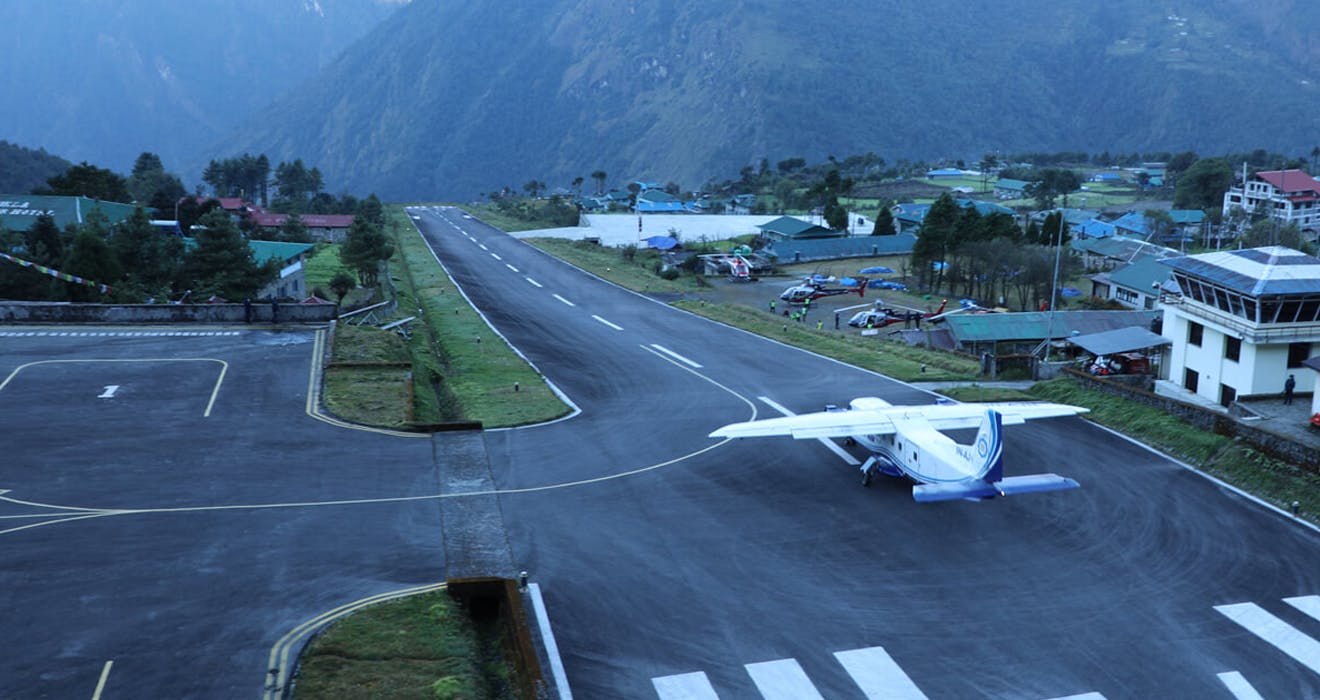
How to get Lukla for The Everest Treks

The small town of Lukla is typically the starting point for all the treks in the Everest region , including the famous Everest Base Camp Trek . This small Sherpa town is located in the northeastern part of Nepal at an elevation of 2,846 meters.
Since no motorized roads connect to Lukla from Kathmandu, you only have two ways of getting there — by air or on foot. Either way, traveling to Lukla itself is an adventure of a lifetime.
While flying to the Tenzing-Hillary Airport is the most popular way to reach Lukla, there are a few other options to get there.
Getting To Lukla for Everest Base Camp Trek
There are three possible options to get to the small town of Lukla from Kathmandu.
Via Flight to Lukla
Duration - 30 minutes
The most popular option to reach Lukla from Kathmandu is via regular flight. It is also the quickest option as it only takes 30 minutes to reach Lukla by plane.
The Tenzing-Hillary Airport in Lukla is notorious for having one of the world’s shortest runways, extending a mere 527 meters (1,729 feet) long. Besides that, this airport is often considered the world’s most extreme due to the mountain-side runway, high winds, low visibility, and cloud cover. That said, most aircraft arrive and leave this tiny airstrip almost daily without incident.
But delays and cancellations are common due to bad weather in Lukla or en-route. Hence, adding a couple of buffer days into your itinerary while trekking in the Everest region is highly recommended. This offers you more flexibility and reduces the risk of missing your international connection even if Lukla flights get grounded for a few days.
For this, you’ll have to wake up around 5 AM and drive to the domestic terminal of the Tribhuvan International Airport (TIA) in Kathmandu. After that, you’ll have to catch an early morning flight to Lukla. However, the direct flights from Kathmandu to Lukla only operate during the off-seasons, i.e., December to February and June to August.
Note: In the last few years, flights to Lukla have started operating from Manthali Airport in Ramechhap during the peak trekking seasons (March to May and September to November). This is due to the high air traffic congestion at Tribhuvan International Airport (TIA) in Kathmandu.
How to Get to Lukla via Manthali Flight?
Since the regular flights to and from Lukla are infamous for delays and cancellations, Manthali Airport in Ramechhap has become a popular alternative for operating Lukla flights.
Manthali Airport is situated at an altitude of 474 meters in the Tamakoshi River Valley in Manthali. It is located around 132 kilometers from Kathmandu and takes four and half hours to get there by road.
Apart from trekkers willing to fly to Lukla, this small town does not see many visitors regularly. You can either drive to Manthali village the day before your scheduled flight, or you can catch a ride around midnight on the same day.
If you’re planning to drive a day ahead and spend a night in Manthali, note that this small town offers limited accommodation facilities with basic services.
However, if you’re planning to get to Manthali on the same day, you’ll have to wake up around 2 in the morning and catch a ride to this small town. You’ll be reaching Manthali at around 6:30 AM. From here, you’ll have to take a 20-minutes flight to the Tenzing Hillary Airport in Lukla.
Via Helicopter to Lukla
Duration - 40 to 60 minutes
Another alternative to get to Lukla from Kathmandu is by chartering a helicopter. This is ideal for travelers who are short on time but not on a tight budget. Although expensive, flying by a chartered helicopter is the most reliable option to get to Lukla.
For this option, you’ll have to drive to the domestic terminal of Kathmandu’s Tribhuvan International Airport (TIA) and take your Heli ride to Tenzing Hillary Airport. Depending on the weather, the helicopter ride might take 40 minutes to an hour to reach Lukla.
Since chartering a helicopter to Lukla can cost you between USD 2,200 to 3,000, getting more people to tag along is more affordable. The helicopter accommodates up to 5 passengers and allows 400 KGs of baggage. Some carriers that provide helicopter services to Lukla are Air Dynasty, Summit Helicopters, Kailash Heli, and Simrik Air.
Upon landing at Lukla, you can either start your trek to the Everest region or continue your Heli ride to the mighty Everest Base Camp for a sightseeing flight and return to Kathmandu the same day.
Via Road and On Foot to Lukla
Duration - 2 to 8 days
Although traveling to Lukla on foot is much less common, it is still a reliable alternative. This is an excellent option to avoid the uncertainties of Lukla flights if you’re willing to spare a few extra days.
Here are a few options you can choose while traveling to Lukla on foot:
Drive to Phaplu
If you strictly want to avoid the hassle of the Lukla flight, you can take a jeep and drive to Phaplu. After spending a night in the village, you can start your trek to Lukla.
Phaplu is located nearly 270 kilometers away from the capital. It’ll take approximately 9 hours to reach this remote village from Kathmandu. On average, the trek from the village of Phaplu to Lukla takes 3 to 4 days.
Since the roads are extremely slippery during monsoon, we recommend you avoid this route in June and July.
Drive to Jiri
Getting to Lukla via Jiri is often considered the “Pioneer’s Route.” It is because this route was used by the early day explorers to reach Lukla before the airport was constructed.
This route is much longer and comparatively less popular in recent years. However, it is considered the best option for avid trekkers who prefer authentic experiences. This route offers beautiful mountain views, monasteries, terrace farms, forested trails, and remote villages.
Jiri is located 190 kilometers from Kathmandu, which takes about 9-10 hours to drive. Likewise, the trek from Jiri to Lukla takes around 7 to 8 days.
Drive to Thamedanda
In the last few years, the roads of the Solu region have been extended. Now, you can find private and shared jeeps from Kathmandu that take you up to the small village of Thamedanda.
First, you must catch a jeep from Kathmandu and set off on a 9-hour-drive to Phaplu. Upon arrival, you’ll continue the ride for the next six hours from Phaplu to reach Thamedanda. You can reach Lukla in just two days of trekking from this remote village.
Hence, this is the fastest route to get to Lukla by road and on foot.
Lukla Flight Delays and Cancellations
Delays and cancellations are pretty common when flying to and from Lukla airport. This can ruin your travel plans and itinerary if not handled well. Besides, if the Lukla flights get grounded for a day or two, you might miss your international connection.
Here are a few factors that play their part in delays and cancellations of Lukla flights:
- Bad and unpredicted weather conditions in or en route to Lukla.
- High air traffic congestion during the peak trekking seasons.
- Adverse climatic factors like high winds, low visibility, and cloud cover — especially during winter and monsoon.
- The narrow runway and positioning of the airstrip make the approach relatively challenging.
Regardless of which option you choose, traveling to Lukla is a once-in-a-lifetime opportunity. If you have a few extra days to spare, the best and most reliable option to get to Lukla is on foot.
But if you’re opting for a regular flight, we advise adding a few buffer days into your itinerary and some extra cash while trekking in the Everest region.
Pin this post

Post a Comment
Subscribe our e-newsletter.
Sign up for Deals and Discount. Get News, Notifications and Updates about the recent Events and Offers.
Bhopal Girl, 2, Becomes Youngest In Her Age Group To Reach Everest Base Camp
The toddler and her parents set out on the expedition on March 12 via Lukla in Nepal and completed the EBC trek after ten days, said Nabin Trital, managing director of the expedition company.

Everest Base Camp (EBC) is situated 5,364 metres above sea level.
Siddhi Mishra, aged two-and-a-half-years who hails from Bhopal, has become the youngest girl in her age category to complete the Mt Everest Base Camp trek, as per a statement issued on Tuesday.
Siddhi, along with her parents Bhavna Dehariya and Mahim Mishra, completed the Everest Base Camp (EBC) trek on March 22, as per a certificate issued by Expedition Himalaya.Com Pvt. Ltd.
Notably, Siddhi's mother had scaled the world's highest mountain peak on May 22, 2019.
"Siddhi became the first child aged two-and-a-half years to complete the Everest Base Camp Trek with Expedition Himalaya," the statement said.
Bhavna Dehariya said reaching EBC is not an easy task.
Bhavna, who hails from Chhindwara district in Madhya Pradesh, started scaling hills around her village Tamia since childhood and developed a passion for scaling peaks all over the globe.
"The Everest Base Camp is not as easy as it seems but Ginni (Siddhi) managed it really well and showcased complete passion for reaching the destination despite adverse weather conditions," Bhavna told PTI over the phone after reaching Kathmandu from EBC.
She said one of the most surprising elements at the base camp is the new landmark--a signboard welcoming visitors which featured the images of Edmund Hillary and Tenzing Norgay. It is a graffiti-covered boulder that for years symbolised the official arrival at the base camp.
Standing against the backdrop of the landmark, Bhavna held the banner of Madhya Pradesh Government's "Beti Bachao, Beti Padhao" campaign, while Siddhi displayed the National flag.
Promoted Listen to the latest songs, only on JioSaavn.com
"Earlier, there was only a big rock with red letters mentioning "Everest Base Camp 5364 M," Bhavna added.
(Except for the headline, this story has not been edited by NDTV staff and is published from a syndicated feed.)

Track Budget 2023 and get Latest News Live on NDTV.com.
Track Latest News Live on NDTV.com and get news updates from India and around the world .
Track Latest News and Election Results Coverage Live on NDTV.com and get news updates from India and around the world.
Watch Live News:

- LIVE DISCOURSE
- BLOG / OPINION
- SUBMIT PRESS RELEASE
- Advertisement
- Knowledge Partnership
- Media Partnership
Toddler girl from Bhopal reaches Mt Everest Base Camp

Siddhi Mishra, a two-and-a-half-year-old girl from Bhopal, has become one of the youngest children to conquer the Mt Everest Base Camp Trek at a towering 17,598 feet above sea level.
The news was confirmed by a statement released by a private trekking company on Tuesday.
Accompanied by her mother Bhavna Dehariya, who successfully scaled Mount Everest in 2019, and her father Mahim Mishra, Siddhi completed the challenging Everest Base Camp (EBC) journey on March 22.
The family embarked on the trek on March 12 from Lukla and accomplished their goal ten days later, Nabin Trital, the managing director of the Expedition Himalaya, said. The journey from Lukla, located on the Northeastern side of the Eeverst, is around 53 km.
Describing the feat, the statement highlighted Siddhi as the youngest child to conquer the Everest Base Camp Trek with Expedition Himalaya.
Bhavna, originally from the Chhindwara district, expressed her immense joy at her daughter's accomplishment, emphasising the challenges they faced due to adverse weather conditions during the trek.
During their journey, the family encountered a new landmark at the base camp, a signboard featuring the images of Hillary and Tenzing, which has become a symbol of welcome for visitors by the Khumbu Pasang Lhamu Rural Municipality.
Bhavna proudly associated Siddhi's achievement with the ''Beti Bachao, Beti Padhao'' campaign initiated by the Madhya Pradesh Government, while Siddhi herself held the National Flag before the EBC landmark.
While Siddhi's accomplishment is exceptional, instances of young children reaching the Everest Base Camp are not unprecedented.
Earlier this year, a two-year-old from Scotland also reached the base camp, with the toddler being carried on his father's back during the climb.
This extraordinary achievement by Siddhi Mishra has not only brought pride to her family but has also captured the attention of many, showcasing the spirit of determination and perseverance at such a tender age.

Reuters Health News Summary

BRIEF-China's BYD to launch Yuan Up compact electric SUV

IPQ 6.0 reveals South Zone leads in Financial Security with 8 in 10 urban re...

PHD Chamber of Commerce and Industry (PHDCCI) organised the JK Tyre Presents...
Latest news, indonesia election unjust, fraught with interference, candidate anies tells court, forex-dollar steadies, yen teeters ahead of key us inflation data, six workers presumed dead after crippled cargo ship knocks down baltimore bridge, feature-social media influencers are india's new election campaigners.

OPINION / BLOG / INTERVIEW
How online advertising is revolutionizing business growth, navigating the digital underworld: the impact of cybercrime on businesses, bridging time: the art of preserving urban heritage, the impact of climate change on renewable energy production and reliability, connect us on.
- ADVERTISEMENT
- KNOWLEDGE PARTNERSHIP
- MEDIA PARTNERSHIP
- Agro-Forestry
- Art & Culture
- Economy & Business
- Energy & Extractives
- Law & Governance
- Science & Environment
- Social & Gender
- Urban Development
- East and South East Asia
- Europe and Central Asia
- Central Africa
- East Africa
- Southern Africa
- West Africa
- Middle East and North Africa
- North America
- Latin America and Caribbean
OTHER LINKS
- Write for us
- Submit Press Release
- Opinion / Blog / Analysis
- Business News
- Entertainment News
- Technology News
- Law-order News
- Lifestyle News
- National News
- International News
OTHER PRODUCTS
Email: [email protected] Phone: +91-720-6444012, +91-7027739813, 14, 15
© Copyright 2024

Bhopal: Toddler Becomes Youngest Girl In Her Age Group To Complete Mt Everest Base Camp Trek
Bhopal (Madhya Pradesh): Siddhi Mishra, a two-and-a-half-year-old girl from Bhopal, has become one of the youngest children to conquer the Mt Everest Base Camp Trek at a towering 17,598 feet above sea level.
The news was confirmed by a statement released by a private trekking company on Tuesday.
Accompanied by her mother Bhavna Dehariya, who successfully scaled Mount Everest in 2019, and her father Mahim Mishra, Siddhi completed the challenging Everest Base Camp (EBC) journey on March 22.
The family embarked on the trek on March 12 from Lukla and accomplished their goal ten days later, Nabin Trital, the managing director of the Expedition Himalaya, said. The journey from Lukla, located on the Northeastern side of the Eeverst, is around 53 km.
Describing the feat, the statement highlighted Siddhi as the youngest child to conquer the Everest Base Camp Trek with Expedition Himalaya.
Bhavna, originally from the Chhindwara district, expressed her immense joy at her daughter's accomplishment, emphasising the challenges they faced due to adverse weather conditions during the trek.
During their journey, the family encountered a new landmark at the base camp, a signboard featuring the images of Hillary and Tenzing, which has become a symbol of welcome for visitors by the Khumbu Pasang Lhamu Rural Municipality.
Bhavna proudly associated Siddhi's achievement with the "Beti Bachao, Beti Padhao" campaign initiated by the Madhya Pradesh Government, while Siddhi herself held the National Flag before the EBC landmark.
While Siddhi's accomplishment is exceptional, instances of young children reaching the Everest Base Camp are not unprecedented.
Earlier this year, a two-year-old from Scotland also reached the base camp, with the toddler being carried on his father's back during the climb.
This extraordinary achievement by Siddhi Mishra has not only brought pride to her family but has also captured the attention of many, showcasing the spirit of determination and perseverance at such a tender age.
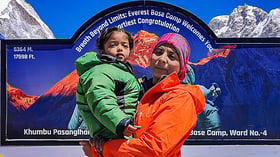

IMAGES
VIDEO
COMMENTS
What is the Lukla to Everest Base Camp Trek distance and day to day hiking length This is the question of many hikers who are going to EBC. Day 1: from Lukla to Phakding is 8 km/ 4.9 miles. Day 2: from Phakding to Namche is 11 km/ 6.8 miles. From Louche to Everest Base Camp to Gorakshep is 12 km/ 7.4 miles.
Lukla to Everest Base Camp Distance. The trek from Lukla to EBC covers approximately 65 kilometres (40 miles) and is an important factor for trekkers planning their Himalayan adventure. This trek offers an immersive experience of the rugged beauty of the Khumbu region, showcasing stunning landscapes, local culture, and high-altitude challenges.
Tumlingtar to Everest Base Camp (21-23 days trekking) Gokyo Over Cho La Pass (17-18 days trekking) Lukla to Tengboche (around 7 days trekking). The trek from Lukla to Everest Base Camp is 38.5 miles each way, totaling 77 miles for hikers. Therefore, to finish this trek in 11-14 days, hikers must spend 8-9 hours daily on the move.
Everest Base Camp Trek in 8 Days. Furthermore, our 8-day Lukla to Everest Base Camp trek itinerary includes the Kalapatthar at 5545m/18,192ft. The mind-blowing views of Mount Everest, Lhotse, Nuptse, and Makalu leave you awestruck. Added to this is a spectacular sunrise with maroon-pink sunrays that seep through the giant mountains.
The entire trek is 130 km (80 miles) round trip. This is the distance from Lukla to Everest Base Camp and then back to Lukla. However, there are several acclimatization days added to the itinerary. On these days, you will walk roughly 3 - 8 km, depending on the schedule. The bigger story is the elevation gain.
12 Day Everest Base Camp Trek Itinerary. Day 1: Fly to Lukla, Hike to Phakding. Day 2: Phakding to Namche Bazaar. Day 3: Acclimatization Day. Day 4: Namche Bazaar to Tengboche. Day 5: Tengoche to Dingboche. Day 6: Acclimatization Day. Day 7: Dingboche to Lobuche. Day 8: Lobuche to Gorak Shep to EBC to Gorak Shep.
Day 1 Kathmandu to Lukla by flight then trek to Phakding. To access the Everest Base Camp Trek it takes around 40 minutes to fly from Kathmandu to Lukla, then another 3 or 4 hours to trek to Phakding, the first overnight stop. Please note, there have been some changes to regulations and so it is probable you will fly from Manthali Airport ...
The optimal time to trek from Lukla to Everest Base Camp is spring (from the end of March to mid-May) and autumn (from October to the end of November). The average daytime temperature during these seasons ranges around 25 degrees, with a nighttime temperature of 10 degrees. The track is impossible in summer (end of June and July) due to ...
Day 1: Fly from Kathmandu to Lukla (2,860m) and trek to Phakding (2,610m) Day 8: Trek from Lobuche to Gorak Shep (5,140m) and visit Everest Base Camp (5,364m) and back to Gorakshep. ...
The Everest Base Camp Trek is considered a moderately difficult to challenging trek due to its high altitude and the stamina required for long daily hikes. The trek covers a total distance of approximately 130 kilometers (80 miles). ... The trek from Lukla to Everest Base Camp is a popular route, and as a result, it has become somewhat ...
Lukla to Everest Base Camp Trekking Route Map for the Year 2023 & 2024 with 15 days Guided Trek Itinerary at Inclusive price US dollar 1499 per person . ... Here we present Mount Everest Base Camp Trek Route Map, Cost, and Tips for going on a trek to the Everest region. This also presents a different situation in which one has to be well prepared.
Distance. The classic Everest Base Camp trek from Lukla to EBC and back is 130km long - 65km each way - which may sound like a lot of trekking! Fear not, because the typical round trip to Everest Base Camp takes around 12 days, the actual distance you will be covering each day will be about 15km - a much more reasonable and achievable number.
The distance between Lukla and EBC is 38.58 miles (62.08 kilometers), which takes 7 to 8 days to hike and 3 to 4 days to descend. The overall distance traveled round way from Lukla to Everest base camp is 130 kilometers, although the trek takes 11 to 12 days. You hike 10 to 11 kilometers each day, which is a pleasant amount to walk between ...
Below are some quick stats about the Lukla to Phakding trekking experience: Everest Base Camp Trek Day 1: Lukla to Phakding. Starting Point: Lukla. Lukla Elevation: 9,318 feet / 2,840 meters. Ending Point: Phakding. Phakding Elevation: 8,563 feet / 2,610 meters. Distance: 5.1 miles / 8.2 kilometers.
Altitude: Kathmandu (1 400m) - Lukla (2 860m) - Phakding (2 610m). Trekking time: 3-4 hours | 7,4 km. Difficulty: Easy with only a few uphill sections. Highlight: Flight into Lukla. Overview: The first day of your Everest Base Camp trek itinerary will start bright and early with a flight out of Kathmandu to the infamous Tenzing Hillary Airport in Lukla.
For a complete cent-by-cent cost breakdown of our trek to Everest Base Camp in 2020. Cost of trekking to EBC in different ways in a nutshell: Package tour EBC trek with international agency $1700. Package tour EBC trek with local agency $1600. Independent EBC trek with a guide and porter $1370.
Below is a tabulated outline of the distances between various locations along the Everest Base Camp trail, alongside the corresponding duration required to reach each destination: Day. Location. Distance (km) Duration (hours) 2. Lukla - Phakding. 8.2 km. 3 to 4 hrs.
The thing that makes the EBC trek tough is the altitude. Base Camp is at 5600m (18,373ft) and you will need to spend one or two nights above 5000m (16,404ft). Above 4000m (13,123ft) you are going to feel increasingly lethargic and out of breath as the amount of oxygen in the air decreases.
Max Elevation : 3340m. This is the last day of long-distance walking. It is usually the hardest day of the trek as your body will tire itself from the continuous trek to Everest base camp. You will descend to Lukla from Namche Bazaar. The total distance you have to travel is about 21km and can take up to 8 hours.
The most preferred Classic Everest Base Camp Trek is 15 days trek in which the 1 st day is arrival plus trek briefing day, and the second day is Kathmandu city excursion day. Our trek from Lukla usually commences on the 3 rd day after landing at Lukla from scenic mountain flight from Kathmandu.. The approximate one-way distance from Lukla to Everest Base Camp is 60 - 65 km.
The trek starts with a flight from Kathmandu to Lukla. From Lukla, you will trek most of the day with around 5-6 hours of trekking every day. ... This route takes you through the classic Everest Base Camp trek route letting you experience all the trekking adventure while giving you the opportunity to end the trek with a unique Helicopter return ...
Altitude: 2,610 meters. Distance from Ghat: Approximately 2 kilometers. Phakding, as mentioned earlier, is the first major town you encounter on the Everest Base Camp Trail. It is situated on the banks of the Dudh Koshi River and offers a range of amenities such as tea houses, lodges, restaurants, and shops. Phakding is a popular resting point ...
Upon landing at Lukla, you can either start your trek to the Everest region or continue your Heli ride to the mighty Everest Base Camp for a sightseeing flight and return to Kathmandu the same day. Via Road and On Foot to Lukla. Duration - 2 to 8 days. Although traveling to Lukla on foot is much less common, it is still a reliable alternative.
South Base Camp in Nepal. The Everest Base Camp trek on the south side, at an elevation of 5,364 m (17,598 ft), is one of the most popular trekking routes in the Himalayas and about 40,000 people per year make the trek there from Lukla Airport (2,846 m (9,337 ft)). Trekkers usually fly from Kathmandu to Lukla to save time and energy before beginning the trek to the base camp.
Siddhi Mishra, aged two-and-a-half-years who hails from Bhopal, has become the youngest girl in her age category to complete the Mt Everest Base Camp trek, as per a statement issued on Tuesday.
104 likes, 0 comments - outdoorsbeckon on March 21, 2024: "Lukla airport. Gateway to the Everest region. . . . . . Everest, Lukla airport, mountains, Everest Base ...
Accompanied by her mother Bhavna Dehariya, who successfully scaled Mount Everest in 2019, and her father Mahim Mishra, Siddhi completed the challenging Everest Base Camp (EBC) journey on March 22. The family embarked on the trek on March 12 from Lukla and accomplished their goal ten days later, Nabin Trital, the managing director of the ...
Bhopal, Mar 26 (PTI) Siddhi Mishra, aged two-and-a-half-years who hails from Bhopal, has become the youngest girl in her age category to complete the Mt Everest Base Camp trek, as per a statement ...
Bhopal (Madhya Pradesh): Siddhi Mishra, a two-and-a-half-year-old girl from Bhopal, has become one of the youngest children to conquer the Mt Everest Base Camp Trek at a towering 17,598 feet above ...
BHOPAL, Mar 26: Siddhi Mishra, a two-and-a-half-year-old girl from Bhopal, has become one of the youngest children to conquer the Mt Everest Base Camp Trek at a towering 17,598 feet above sea level. The news was confirmed by a statement released by a private trekking company on Tuesday. Accompanied by her mother Bhavna Dehariya, who successfully scaled Mount Everest in 2019, and her father ...